Novatel Wireless NRM-EU860D Dual Band Licensed Modular Transmitter User Manual book
Novatel Wireless, Inc. Dual Band Licensed Modular Transmitter book
Contents
- 1. Part 1
- 2. Part 2
- 3. Manual 1
- 4. Manual 2
- 5. Manual 3
- 6. Manual 4
- 7. User Manual 1
- 8. User Manual 2
- 9. User Manual M1210
- 10. User Manual D430
- 11. User Manual D420
- 12. User Manual Corsica
- 13. User Manual Sapporo
- 14. User Manual Vostro 1
- 15. User Manual Vostro 2
- 16. Users Manual Vostro 3
- 17. Users Manual Vostro 4
- 18. User Manual 3
- 19. User Manual 4
- 20. User Manual Gilligan
User Manual Sapporo

FILE LOCATION: S:\systems\Sapporo_Yebisu\Sapporo\OM\A00\EN\title.fm
DELL CONFIDENTIAL – PRELIMINARY 2/14/07 – FOR PROOF ONLY
www.dell.com | support.dell.com
Template Last Updated - 2/7/2007
Dell™ Inspiron™ 1521 Owner’s Manual
Model PP22L

Notes, Notices, and Cautions
NOTE: A NOTE indicates important information that helps you make better use of
your computer.
NOTICE: A NOTICE indicates either potential damage to hardware or loss of data
and tells you how to avoid the problem.
CAUTION: A CAUTION indicates a potential for property damage, personal injury,
or death.
____________________
Information in this document is subject to change without notice.
© 2007 Dell Inc. All rights reserved.
Reproduction in any manner whatsoever without the written permission of Dell Inc. is strictly
forbidden.
Trademarks used in this text: Dell, the DELL logo, Inspiron, Wi-Fi Catcher, and Dell MediaDirect are
trademarks of Dell Inc.; AMD, AMD Turion, ATI Radeon and combinations thereof are trademarks of
Advanced Micro Devices, Inc.; Microsoft and Windows are registered trademarks and Windows Vista
is a trademark of Microsoft Corporation; EMC is a registered trademark of EMC Corporation;
Bluetooth is a registered trademark owned by Bluetooth SIG, Inc. and is used by Dell under license;
ENERGY STAR is a registered trademark of the U.S. Environmental Protection Agency. As an
ENERGY STAR partner, Dell Inc. has determined that this product meets the ENERGY STAR
guidelines for energy efficiency.
Other trademarks and trade names may be used in this document to refer to either the entities claiming
the marks and names or their products. Dell Inc. disclaims any proprietary interest in trademarks and
trade names other than its own.
Model PP22L
March 2007 P/N RT722 Rev. A00

FILE LOCATION: S:\systems\Sapporo_Yebisu\Sapporo\OM\A00\EN\bookTOC.fm
Template Last Updated - 1/7/2007 Contents 3
Contents
Finding Information . . . . . . . . . . . . . . . . . . . 13
1 About Your Computer . . . . . . . . . . . . . . . 19
Determining Your Computer’s Configuration . . . . . . 19
Front View . . . . . . . . . . . . . . . . . . . . . . . . 20
Left Side View . . . . . . . . . . . . . . . . . . . . . . 25
Right Side View . . . . . . . . . . . . . . . . . . . . . 27
Back View . . . . . . . . . . . . . . . . . . . . . . . . 28
Bottom View . . . . . . . . . . . . . . . . . . . . . . . 31
2 Setting Up Your Computer . . . . . . . . . . . . 33
Connecting to the Internet . . . . . . . . . . . . . . . 33
Setting Up Your Internet Connection . . . . . . . . 33
Transferring Information to a New Computer . . . . . 34
Windows Easy Transfer . . . . . . . . . . . . . . 35
Setting Up a Printer . . . . . . . . . . . . . . . . . . . 35
Printer Cable . . . . . . . . . . . . . . . . . . . . 35
Connecting a USB Printer . . . . . . . . . . . . . 35
Power Protection Devices . . . . . . . . . . . . . . . 37
Surge Protectors . . . . . . . . . . . . . . . . . . 37

FILE LOCATION: S:\systems\Sapporo_Yebisu\Sapporo\OM\A00\EN\bookTOC.fm
4Contents
Line Conditioners . . . . . . . . . . . . . . . . . . 37
Uninterruptible Power Supplies . . . . . . . . . . 37
3 Using the Display . . . . . . . . . . . . . . . . . . 39
Adjusting Brightness . . . . . . . . . . . . . . . . . . 39
Switching the Video Image From Your Computer Display To a
Projector . . . . . . . . . . . . . . . . . . . . . . . . . 39
Setting Display Resolution and Refresh Rate . . . . . . 39
4 Using the Keyboard and Touchpad . . . . . 41
Numeric Keypad . . . . . . . . . . . . . . . . . . . . . 41
Key Combinations . . . . . . . . . . . . . . . . . . . . 42
System Functions . . . . . . . . . . . . . . . . . . 42
Display Functions . . . . . . . . . . . . . . . . . . 42
Battery . . . . . . . . . . . . . . . . . . . . . . . 42
Power Management . . . . . . . . . . . . . . . . 42
Microsoft® Windows® Logo Key Functions . . . 42
Dell™ QuickSet Key Combinations . . . . . . . . . 43
Adjusting Keyboard Settings . . . . . . . . . . . . 43
Touch Pad . . . . . . . . . . . . . . . . . . . . . . . . 43
Customizing the Touch Pad . . . . . . . . . . . . . 44
5 Using a Battery . . . . . . . . . . . . . . . . . . . . 47
Battery Performance . . . . . . . . . . . . . . . . . . 47
Checking the Battery Charge . . . . . . . . . . . . . . 48
Dell QuickSet Battery Meter . . . . . . . . . . . . 48

FILE LOCATION: S:\systems\Sapporo_Yebisu\Sapporo\OM\A00\EN\bookTOC.fm
Template Last Updated - 1/7/2007 Contents 5
Microsoft® Windows® Battery Meter . . . . . . . 49
Charge Gauge . . . . . . . . . . . . . . . . . . . 49
Low-Battery Warning . . . . . . . . . . . . . . . 50
Conserving Battery Power . . . . . . . . . . . . . . . 50
Configuring Power Management Settings . . . . . 50
Using the Sleep Power State . . . . . . . . . . . 51
Charging the Battery . . . . . . . . . . . . . . . . . . 51
Replacing the Battery . . . . . . . . . . . . . . . . . . 52
Storing a Battery . . . . . . . . . . . . . . . . . . . . 53
6 Using Multimedia . . . . . . . . . . . . . . . . . . 55
Playing Media . . . . . . . . . . . . . . . . . . . . . . 55
Copying CD and DVD Media . . . . . . . . . . . . . . 57
How to Copy a CD or DVD . . . . . . . . . . . . . 57
Using Blank CD and DVD Media . . . . . . . . . . 57
Helpful Tips . . . . . . . . . . . . . . . . . . . . . 58
Adjusting the Volume . . . . . . . . . . . . . . . . . . 59
Adjusting the Picture . . . . . . . . . . . . . . . . . . 59
Using Dell MediaDirect™ . . . . . . . . . . . . . . . . 60
Connecting Your Computer to a TV or Audio Device . . 61
S-Video and Standard Audio . . . . . . . . . . . . 63
S-Video and S/PDIF Digital Audio . . . . . . . . . 64
Composite Video and Standard Audio . . . . . . . 66
Composite Video and S/PDIF Digital Audio . . . . 68
Component Video and Standard Audio . . . . . . 70
Component Video and S/PDIF Digital Audio . . . . 72
Enabling the Display Settings for a TV . . . . . . . 75

FILE LOCATION: S:\systems\Sapporo_Yebisu\Sapporo\OM\A00\EN\bookTOC.fm
6Contents
7 Using ExpressCards . . . . . . . . . . . . . . . . 79
ExpressCard Blanks . . . . . . . . . . . . . . . . . . . 79
Installing an ExpressCard . . . . . . . . . . . . . . . . 80
Removing an ExpressCard or Blank . . . . . . . . . . . 81
8 Using the Memory Card Reader . . . . . . . 83
Memory Card Blanks . . . . . . . . . . . . . . . . . . 83
Installing a Memory Card . . . . . . . . . . . . . . . . 83
Removing a Memory Card or Blank . . . . . . . . . . . 84
9 Setting Up and Using Networks . . . . . . . 87
Connecting a Network or Broadband Modem Cable . . 87
Setting Up a Network . . . . . . . . . . . . . . . . . . 88
Wireless Local Area Network . . . . . . . . . . . . . 88
What You Need to Establish a WLAN Connection . 88
Checking Your Wireless Network Card . . . . . . 89
Setting Up a New WLAN Using a Wireless Router and a
Broadband Modem . . . . . . . . . . . . . . . . . 89
Connecting to a WLAN . . . . . . . . . . . . . . . 91
Mobile Broadband (or Wireless Wide Area Network) . 93
What You Need to Establish a Mobile Broadband Network
Connection . . . . . . . . . . . . . . . . . . . . . 93
Checking Your Dell Mobile Broadband Card . . . . 94
Connecting to a Mobile Broadband Network . . . 94
Enabling/Disabling the Dell Mobile Broadband Card 95

FILE LOCATION: S:\systems\Sapporo_Yebisu\Sapporo\OM\A00\EN\bookTOC.fm
Template Last Updated - 1/7/2007 Contents 7
Dell Wi-Fi Catcher™ Network Locator . . . . . . . . . 95
10 Securing Your Computer . . . . . . . . . . . . . 97
Security Cable Lock . . . . . . . . . . . . . . . . . . . 97
Passwords . . . . . . . . . . . . . . . . . . . . . . . . 97
If Your Computer Is Lost or Stolen . . . . . . . . . . . 98
11 Troubleshooting . . . . . . . . . . . . . . . . . . 101
Dell Technical Update Service . . . . . . . . . . . . . 101
Dell Diagnostics . . . . . . . . . . . . . . . . . . . . . 101
Dell Support Utility . . . . . . . . . . . . . . . . . . . 105
Drive Problems . . . . . . . . . . . . . . . . . . . . . 106
Optical drive problems . . . . . . . . . . . . . . . 106
Hard drive problems . . . . . . . . . . . . . . . . 107
E-Mail, Modem, and Internet Problems . . . . . . . . 108
Error Messages . . . . . . . . . . . . . . . . . . . . . 109
ExpressCard Problems . . . . . . . . . . . . . . . . . 114
IEEE 1394 Device Problems . . . . . . . . . . . . . . . 115
Keyboard Problems . . . . . . . . . . . . . . . . . . . 115
External Keyboard problems . . . . . . . . . . . . 115
Unexpected characters . . . . . . . . . . . . . . 116
Lockups and Software Problems . . . . . . . . . . . . 116
The computer does not start . . . . . . . . . . . . 117
The computer stops responding . . . . . . . . . . 117

FILE LOCATION: S:\systems\Sapporo_Yebisu\Sapporo\OM\A00\EN\bookTOC.fm
8Contents
A program stops responding or crashes repeatedly 117
A program is designed for an earlier Microsoft® Windows®
operating system . . . . . . . . . . . . . . . . . . 117
A solid blue screen appears . . . . . . . . . . . . 118
Dell MediaDirect problems . . . . . . . . . . . . . 118
Other software problems . . . . . . . . . . . . . . 118
Memory Problems . . . . . . . . . . . . . . . . . . . . 119
Network Problems . . . . . . . . . . . . . . . . . . . . 120
Mobile Broadband (Wireless Wide Area Network [WWAN]) 120
Power Problems . . . . . . . . . . . . . . . . . . . . . 121
Printer Problems . . . . . . . . . . . . . . . . . . . . . 122
Scanner Problems . . . . . . . . . . . . . . . . . . . . 123
Sound and Speaker Problems . . . . . . . . . . . . . . 123
No sound from integrated speakers . . . . . . . . 124
No sound from external speakers . . . . . . . . . 124
No sound from headphones . . . . . . . . . . . . 124
Touch Pad or Mouse Problems . . . . . . . . . . . . . 125
Video and Display Problems . . . . . . . . . . . . . . 125
If the display is blank . . . . . . . . . . . . . . . . 126
If the display is difficult to read . . . . . . . . . . 126
If only part of the display is readable . . . . . . . 127
Drivers . . . . . . . . . . . . . . . . . . . . . . . . . . 127
What Is a Driver? . . . . . . . . . . . . . . . . . . 127
Identifying Drivers . . . . . . . . . . . . . . . . . 128
Reinstalling Drivers and Utilities . . . . . . . . . . 128
Troubleshooting Software and Hardware Problems . . 130
Restoring Your Operating System . . . . . . . . . . . . 131

FILE LOCATION: S:\systems\Sapporo_Yebisu\Sapporo\OM\A00\EN\bookTOC.fm
Template Last Updated - 1/7/2007 Contents 9
Using Microsoft Windows System Restore . . . . 131
Using Dell PC Restore by Symantec . . . . . . . . 132
Using the Operating System Media . . . . . . . . 134
12 Adding and Replacing Parts . . . . . . . . . 137
Before You Begin . . . . . . . . . . . . . . . . . . . . 137
Recommended Tools . . . . . . . . . . . . . . . . 137
Turning Off Your Computer . . . . . . . . . . . . . 137
Before Working Inside Your Computer . . . . . . . 138
Hard Drive . . . . . . . . . . . . . . . . . . . . . . . . 139
Removing the Hard Drive . . . . . . . . . . . . . 140
Replacing the Hard Drive . . . . . . . . . . . . . 141
Returning a Hard Drive to Dell . . . . . . . . . . . 141
Optical Drive . . . . . . . . . . . . . . . . . . . . . . 142
Removing the Optical Drive . . . . . . . . . . . . 142
Replacing the Optical Drive . . . . . . . . . . . . 143
Hinge Cover . . . . . . . . . . . . . . . . . . . . . . . 143
Removing the Hinge Cover . . . . . . . . . . . . . 143
Replacing the Hinge Cover . . . . . . . . . . . . . 144
Keyboard . . . . . . . . . . . . . . . . . . . . . . . . . 144
Removing the Keyboard . . . . . . . . . . . . . . 145
Replacing the Keyboard . . . . . . . . . . . . . . 146
Memory . . . . . . . . . . . . . . . . . . . . . . . . . 146
Removing the DIMM A Memory Module . . . . . 147
Replacing the DIMM A Memory Module . . . . . 148
Removing the DIMM B Memory Module . . . . . 149
Replacing the DIMM B Memory Module . . . . . 151
Subscriber Identity Module . . . . . . . . . . . . . . . 152

FILE LOCATION: S:\systems\Sapporo_Yebisu\Sapporo\OM\A00\EN\bookTOC.fm
10 Contents
Wireless Mini Cards . . . . . . . . . . . . . . . . . . . 153
Removing a WLAN Card . . . . . . . . . . . . . . 154
Replacing a WLAN Card . . . . . . . . . . . . . . 156
Removing a Mobile Broadband or WWAN Card . . 157
Replacing a WWAN Card . . . . . . . . . . . . . 160
Removing a WPAN Card . . . . . . . . . . . . . . 161
Replacing a WPAN Card . . . . . . . . . . . . . . 162
Flash Cache Module . . . . . . . . . . . . . . . . . . . 162
Removing the FCM . . . . . . . . . . . . . . . . . 162
Replacing the FCM . . . . . . . . . . . . . . . . . 163
Internal Card With Bluetooth® Wireless Technology . 164
Removing the Card . . . . . . . . . . . . . . . . . 164
Replacing the Card . . . . . . . . . . . . . . . . . 165
Coin-Cell Battery . . . . . . . . . . . . . . . . . . . . 165
Removing the Coin-Cell Battery . . . . . . . . . . 165
Replacing the Coin-Cell Battery . . . . . . . . . . 166
13 Dell™ QuickSet Features . . . . . . . . . . . 167
14 Traveling With Your Computer . . . . . . . . 169
Identifying Your Computer . . . . . . . . . . . . . . . . 169
Packing the Computer . . . . . . . . . . . . . . . . . . 169
Travel Tips . . . . . . . . . . . . . . . . . . . . . . . . 170
Traveling by Air . . . . . . . . . . . . . . . . . . . 170
15 Getting Help . . . . . . . . . . . . . . . . . . . . . . 171
Obtaining Assistance . . . . . . . . . . . . . . . . . . 171

FILE LOCATION: S:\systems\Sapporo_Yebisu\Sapporo\OM\A00\EN\bookTOC.fm
Template Last Updated - 1/7/2007 Contents 11
Technical Support and Customer Service . . . . . 172
DellConnect . . . . . . . . . . . . . . . . . . . . 172
Online Services . . . . . . . . . . . . . . . . . . 172
AutoTech Service . . . . . . . . . . . . . . . . . 173
Automated Order-Status Service . . . . . . . . . 173
Problems With Your Order . . . . . . . . . . . . . . . 173
Product Information . . . . . . . . . . . . . . . . . . . 174
Returning Items for Warranty Repair or Credit . . . . . 174
Before You Call . . . . . . . . . . . . . . . . . . . . . 174
Contacting Dell . . . . . . . . . . . . . . . . . . . . . 177
16 Specifications . . . . . . . . . . . . . . . . . . . . 179
17 Appendix . . . . . . . . . . . . . . . . . . . . . . . . 187
Using the System Setup Program . . . . . . . . . . . . 187
Viewing the System Setup Screen . . . . . . . . . 187
System Setup Screen . . . . . . . . . . . . . . . 188
Commonly Used Options . . . . . . . . . . . . . . 188
Cleaning Your Computer . . . . . . . . . . . . . . . . 189
Computer, Keyboard, and Display . . . . . . . . . 190
Touch Pad . . . . . . . . . . . . . . . . . . . . . 190
Mouse . . . . . . . . . . . . . . . . . . . . . . . 191
Media . . . . . . . . . . . . . . . . . . . . . . . . 191
Dell Technical Support Policy (U.S. Only) . . . . . . . 192
Definition of "Dell-Installed" Software and Peripherals 193
Definition of "Third-Party" Software and Peripherals 193
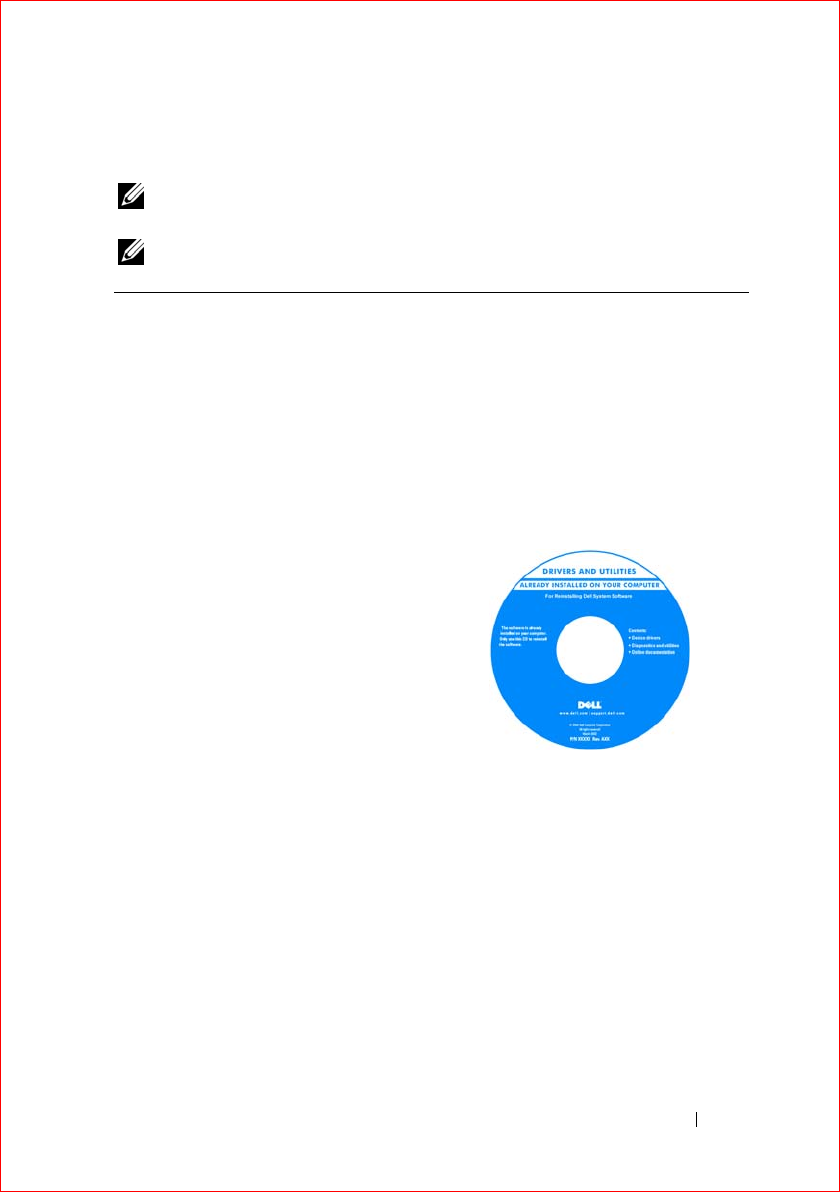
13
FILE LOCATION: S:\systems\Sapporo_Yebisu\Sapporo\OM\A00\EN\findinfo.fm
DELL CONFIDENTIAL – PRELIMINARY 2/14/07 - FOR PROOF ONLY
Finding Information
NOTE: Some features may be optional and may not ship with your computer. Some
features may not be available in certain countries.
NOTE: Additional information may ship with your computer.
What Are You Looking For? Find It Here
• A diagnostic program for my computer
• Drivers for my computer
• Device documentation
• Notebook System Software (NSS)
Drivers and Utilities Media
Documentation and drivers are already
installed on your computer. You can use
the Drivers and Utilities media to reinstall
drivers (see "Reinstalling Drivers and
Utilities" on page 128) or run the Dell
Diagnostics (see "Dell Diagnostics" on
page 101).
Readme files may be included on your
Drivers and Utilities media to provide last-
minute updates about technical changes to
your computer or advanced technical-
reference material for technicians or
experienced users.
NOTE: Drivers and documentation updates
can be found at support.dell.com.
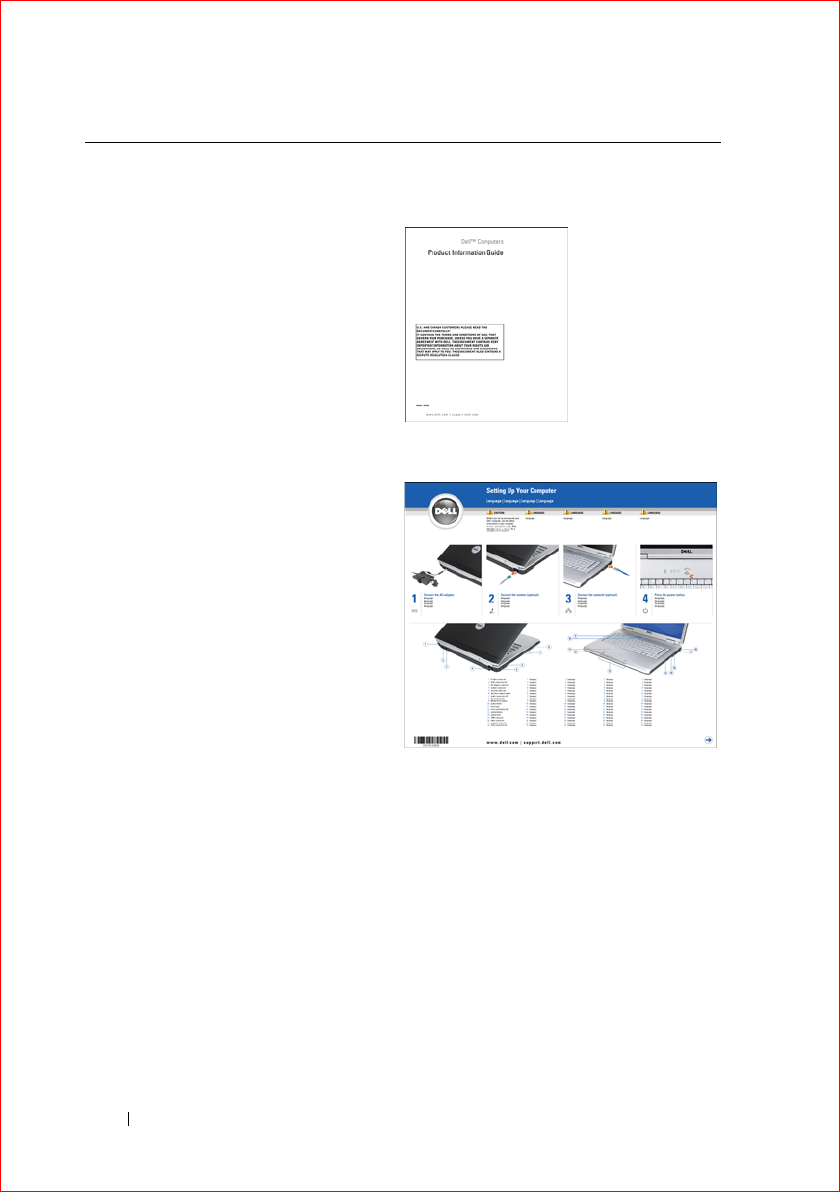
14
FILE LOCATION: S:\systems\Sapporo_Yebisu\Sapporo\OM\A00\EN\findinfo.fm
DELL CONFIDENTIAL – PRELIMINARY 2/14/07 - FOR PROOF ONLY
• Warranty information
• Terms and Conditions (U.S. only)
• Safety instructions
• Regulatory information
• Ergonomics information
• End User License Agreement
Dell™ Product Information Guide
• How to set up my computer
Setup Diagram
What Are You Looking For? Find It Here

15
FILE LOCATION: S:\systems\Sapporo_Yebisu\Sapporo\OM\A00\EN\findinfo.fm
DELL CONFIDENTIAL – PRELIMINARY 2/14/07 - FOR PROOF ONLY
• Service Tag and Express Service Code
• Microsoft
®
Windows
®
Product Key
Service Tag and Microsoft Windows
Product Key
These labels are located on your computer.
• Use the Service Tag to identify your
computer when you use
support.dell.com
or contact support.
• Enter the Express Service Code to direct
your call when contacting support.
NOTE: As an increased security measure,
the newly designed Microsoft Windows
license label incorporates a "security
portal," which looks like a missing portion
of the label, to discourage removal of the
label.
What Are You Looking For? Find It Here

16
FILE LOCATION: S:\systems\Sapporo_Yebisu\Sapporo\OM\A00\EN\findinfo.fm
DELL CONFIDENTIAL – PRELIMINARY 2/14/07 - FOR PROOF ONLY
• Solutions — Troubleshooting hints and
tips, articles from technicians, online
courses, and frequently asked questions
• Community — Online discussion with
other Dell customers
• Upgrades — Upgrade information for
components, such as the memory, hard
drive, and operating system
• Customer Care — Contact information,
service call and order status, and
warranty and repair information
• Service and support — Service call
status, support history, service contract,
and online discussions with support
• Dell Technical Update Service —
Proactive e-mail notification of software
and hardware updates for your computer
• Reference — Computer documentation,
details on my computer configuration,
product specifications, and white papers
• Downloads — Certified drivers, patches,
and software updates
• Notebook System Software (NSS) — If
you reinstall the operating system on
your computer, you should also reinstall
the NSS utility. NSS automatically
detects your computer and operating
system, and installs the updates
appropriate for your configuration,
providing critical updates for your
operating system and support for Dell
3.5-inch USB floppy drives, Intel
®
processors, optical drives, and USB
devices. NSS is necessary for correct
operation of your Dell computer.
Dell Support Website — support.dell.com
NOTE: Select your region or business
segment to view the appropriate support
site.
To download Notebook System Software:
1
Go to
support.dell.com
, select your
country/region, and then click
Drivers &
Downloads
.
2
Enter your Service Tag or product model,
and then click
Go
.
3
Select your operating system and
language, and then click
Find
Downloads
, or under
Downloads
Search
, search for the keyword
Notebook System Software
.
NOTE: The support.dell.com user interface
may vary depending on your selections.
What Are You Looking For? Find It Here

17
FILE LOCATION: S:\systems\Sapporo_Yebisu\Sapporo\OM\A00\EN\findinfo.fm
DELL CONFIDENTIAL – PRELIMINARY 2/14/07 - FOR PROOF ONLY
• Software upgrades and troubleshooting
hints — Frequently asked questions, hot
topics, and general health of your
computing environment
Dell Support Utility
The Dell Support Utility is an automated
upgrade and notification system installed
on your computer. This support provides
real-time health scans of your computing
environment, software updates, and
relevant self-support information. Access
the Dell Support Utility from the
icon
on the taskbar. For more information, see
"Dell Support Utility
" on page 105
.
• How to use Microsoft Windows Vista™
• How to work with programs and files
• How to personalize my desktop
Windows Help and Support
1
Click the Windows Vista Start button
, and then click
Help and Support
.
2
In
Search Help
, type a word or phrase
that describes your problem, and then
press <Enter> or click the magnifying
glass.
3
Click the topic that describes your
problem.
4
Follow the instructions on the screen.
• Information on network activity, the
Power Management Wizard, hotkeys,
and other items controlled by Dell
QuickSet
Dell QuickSet Help
To view
Dell QuickSet Help
,
right-click the
Dell QuickSet icon in the Windows
notification area.
For more information on Dell QuickSet,
see "Dell™ QuickSet Features" on
page 167.
What Are You Looking For? Find It Here

18
FILE LOCATION: S:\systems\Sapporo_Yebisu\Sapporo\OM\A00\EN\findinfo.fm
DELL CONFIDENTIAL – PRELIMINARY 2/14/07 - FOR PROOF ONLY
• How to reinstall my operating system
Operating System Media
The operating system is already installed
on your computer. To reinstall your
operating system, use one of the following
methods:
• Microsoft Windows System Restore
—
Microsoft Windows System Restore
returns your computer to an earlier
operating state without affecting data
files.
• Dell PC Restore — Dell PC Restore
returns your computer to its original
operating state. Dell PC Restore may not
ship with your computer.
• Operating System Installation Media —
If you received operating system media
with your computer, you can use it to
restore your operating system.
For more information, see "Restoring Your
Operating System" on page 131.
After you reinstall your operating system,
use the Drivers and Utilities media to
reinstall drivers for the devices that came
with your computer.
Your operating system product key label is
located on your computer.
NOTE: The color of your operating system
installation media varies according to the
operating system you ordered.
What Are You Looking For? Find It Here

Template Last Updated - 2/7/2007 About Your Computer 19
DELL CONFIDENTIAL – PRELIMINARY 2/14/07 - FOR PROOF ONLY
About Your Computer
Determining Your Computer’s Configuration
Based on selections that you made when purchasing your computer, your
computer has one of several different video controller configurations. To
determine your computer’s video controller configuration:
1Click
Start
, and then click
Help and Support
.
2
Under
Pick a Task
, click
Use Tools to view your computer information
and diagnose problems.
3
Under
My Computer Information
, select
Hardware
.
From the My Computer Information - Hardware screen, you can view the
type of video controller installed in your computer, as well as the other hardware
components.
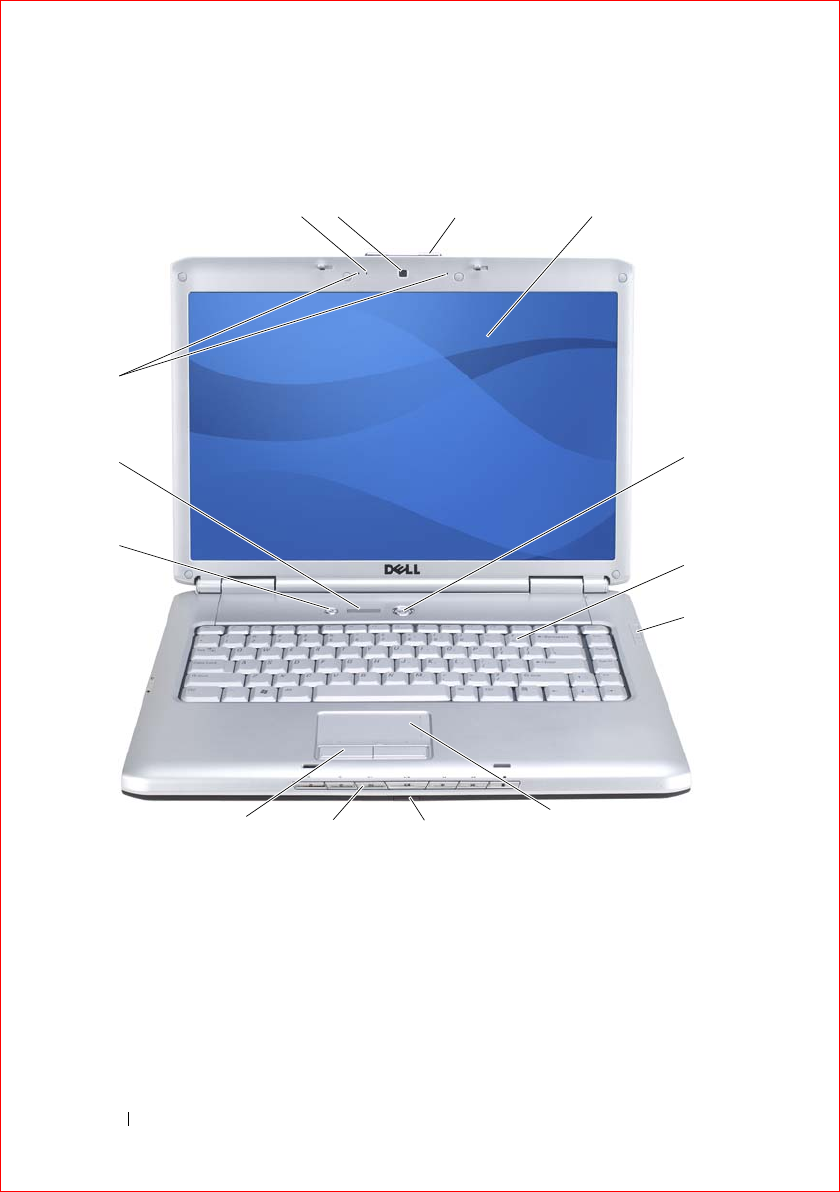
20 About Your Computer
FILE LOCATION: S:\systems\Sapporo_Yebisu\Sapporo\OM\A00\EN\about.fm
DELL CONFIDENTIAL – PRELIMINARY 2/14/07 - FOR PROOF ONLY
Front View
1 camera indicator (optional) 2 camera (optional)
3 display latch 4 display
5 power button 6 keyboard
7 device status lights 8 touch pad
9 consumer IR 10 media control buttons
11 touch pad buttons 12 Dell™ MediaDirect™ button
13 keyboard status lights 14 digital array microphones
4
5
13
3
6
12
8
7
14
2
1
11 9
10

About Your Computer 21
FILE LOCATION: S:\systems\Sapporo_Yebisu\Sapporo\OM\A00\EN\about.fm
DELL CONFIDENTIAL – PRELIMINARY 2/14/07 - FOR PROOF ONLY
CAMERA INDICATOR —Indicates that the camera is on. Based on configuration
selections you made when ordering your computer, your computer may not include a
camera.
CAMERA —Built-in camera for video capture, conferencing, and chat. Based on
configuration selections you made when ordering your computer, your computer may not
include a camera.
DISPLAY LATCH —Keeps the display closed.
DISPLAY —For more information about your display, see "Using the Display" on
page 39.
POWER BUTTON —Press the power button to turn on the computer or exit a power
management mode (see "Configuring Power Management Settings" on page 50).
NOTICE: To avoid losing data, turn off your computer by performing a Microsoft®
Windows® operating system shutdown rather than by pressing the power button.
If the computer stops responding, press and hold the power button until the
computer turns off completely (may take several seconds).
KEYBOARD —For more information about the keyboard, see "Using the Keyboard and
Touchpad" on page 41.
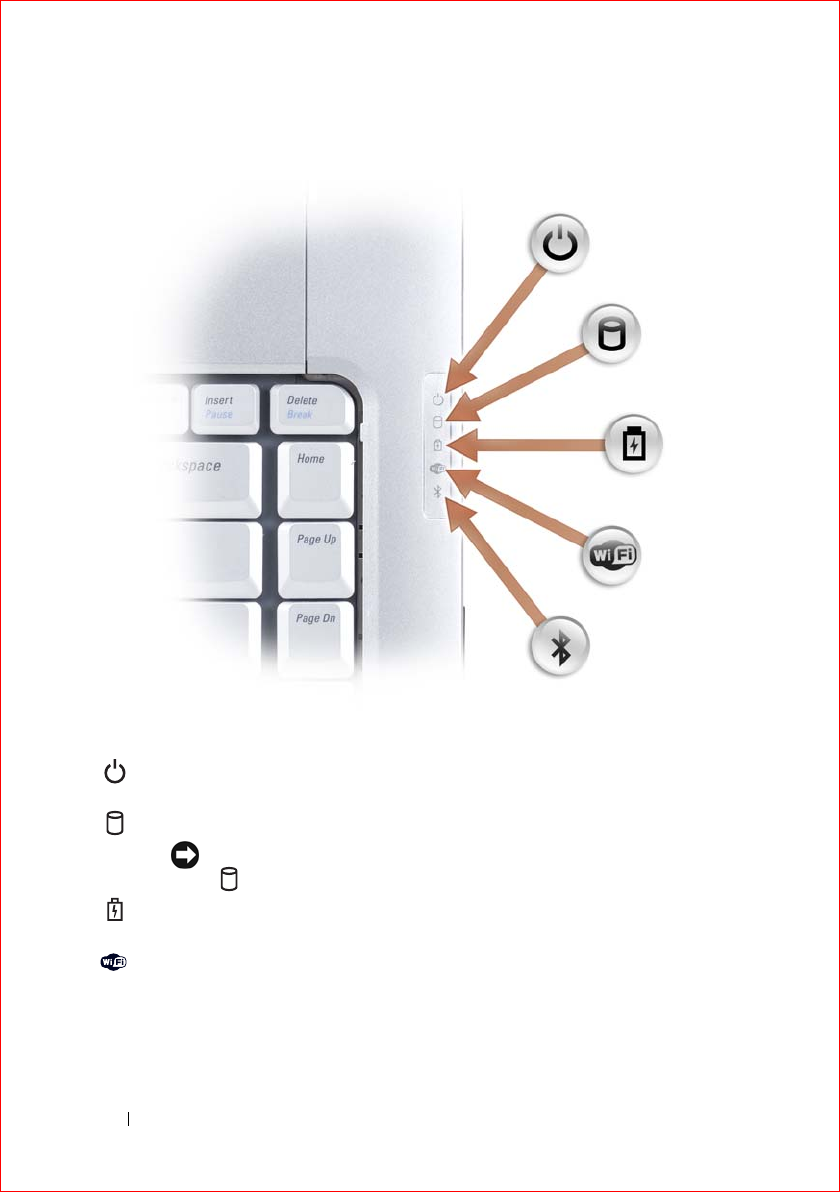
22 About Your Computer
FILE LOCATION: S:\systems\Sapporo_Yebisu\Sapporo\OM\A00\EN\about.fm
DELL CONFIDENTIAL – PRELIMINARY 2/14/07 - FOR PROOF ONLY
DEVICE STATUS LIGHTS
The blue lights located to the right of the keyboard indicate the following:
Power light – Turns on when you turn on the computer, and blinks when the
computer is in a power management mode.
Hard drive activity light – Turns on when the computer reads or writes data.
NOTICE: To avoid loss of data, never turn off the computer while the
light is flashing.
Battery status light – Turns on steadily or blinks to indicate battery charge
status.
WiFi status light – Turns on when wireless networking is enabled. To enable
or disable wireless networking, use the wireless switch (see "wireless switch"
on page 25).
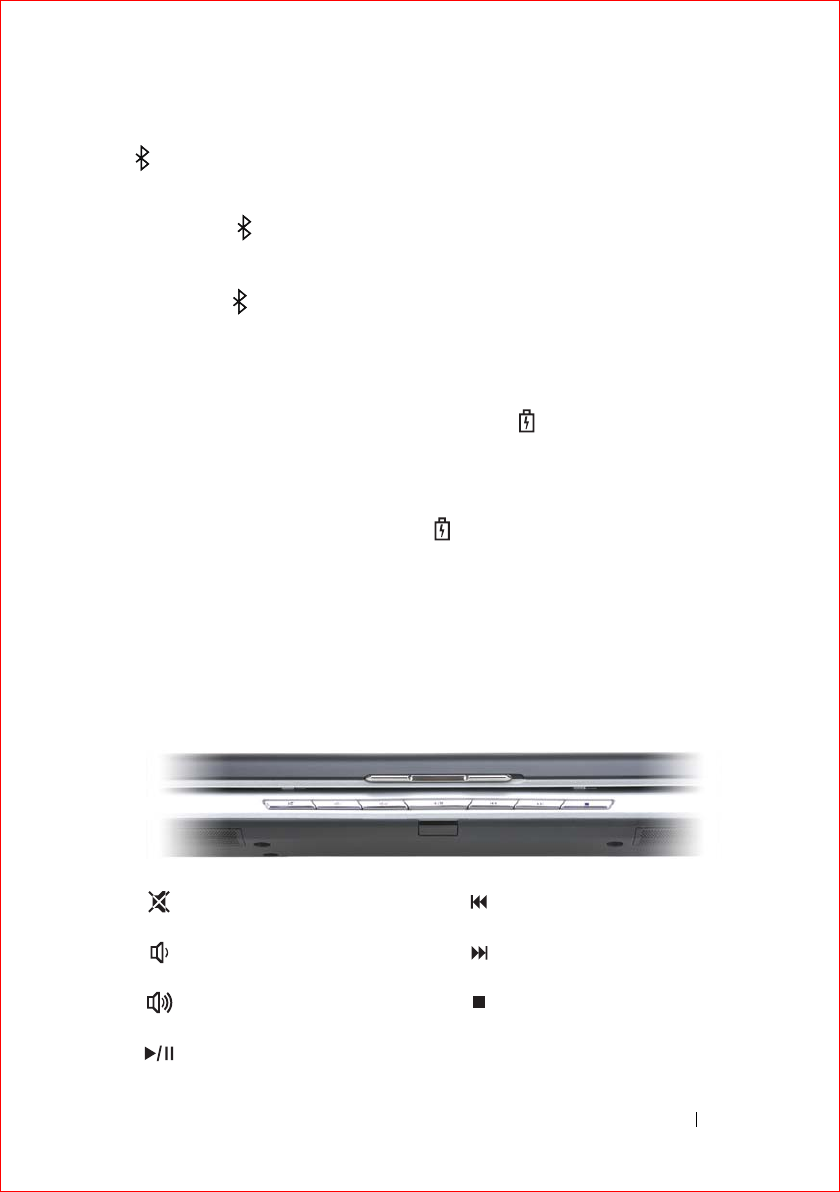
About Your Computer 23
FILE LOCATION: S:\systems\Sapporo_Yebisu\Sapporo\OM\A00\EN\about.fm
DELL CONFIDENTIAL – PRELIMINARY 2/14/07 - FOR PROOF ONLY
If the computer is connected to an electrical outlet, the light operates as follows:
– Solid blue: The battery is charging.
– Flashing blue: The battery is almost fully charged.
– Off: The battery is adequately charged.
If the computer is running on a battery, the light operates as follows:
– Off: The battery is adequately charged (or the computer is turned off).
– Flashing amber: The battery charge is low.
–Solid
amber
: The battery charge is critically low.
TOUCH PAD —Provides the functionality of a mouse (see "Touch Pad" on page 43).
TOUCH PAD BUTTONS —Use these buttons much like the buttons on a mouse when you
use the touch pad to move the cursor on the display (see "Touch Pad" on page 43).
MEDIA CONTROL BUTTONS —Control CD, DVD, and Media Player playback.
Bluetooth® status light – Turns on when a card with Bluetooth wireless
technology is enabled.
NOTE: The card with Bluetooth wireless technology is an optional feature.
The light turns on only if you ordered the card with your computer. For
more information, see the documentation that came with your card.
To turn off only the Bluetooth wireless technology functionality, right-click
the icon in the notification area, and then click Disable Bluetooth
Radio.
To quickly enable or disable all wireless devices, use the wireless switch (see
"wireless switch" on page 25).
Mute the sound. Play the previous track.
Turn the volume down. Play the next track.
Turn the volume up. Stop.
Play or pause.
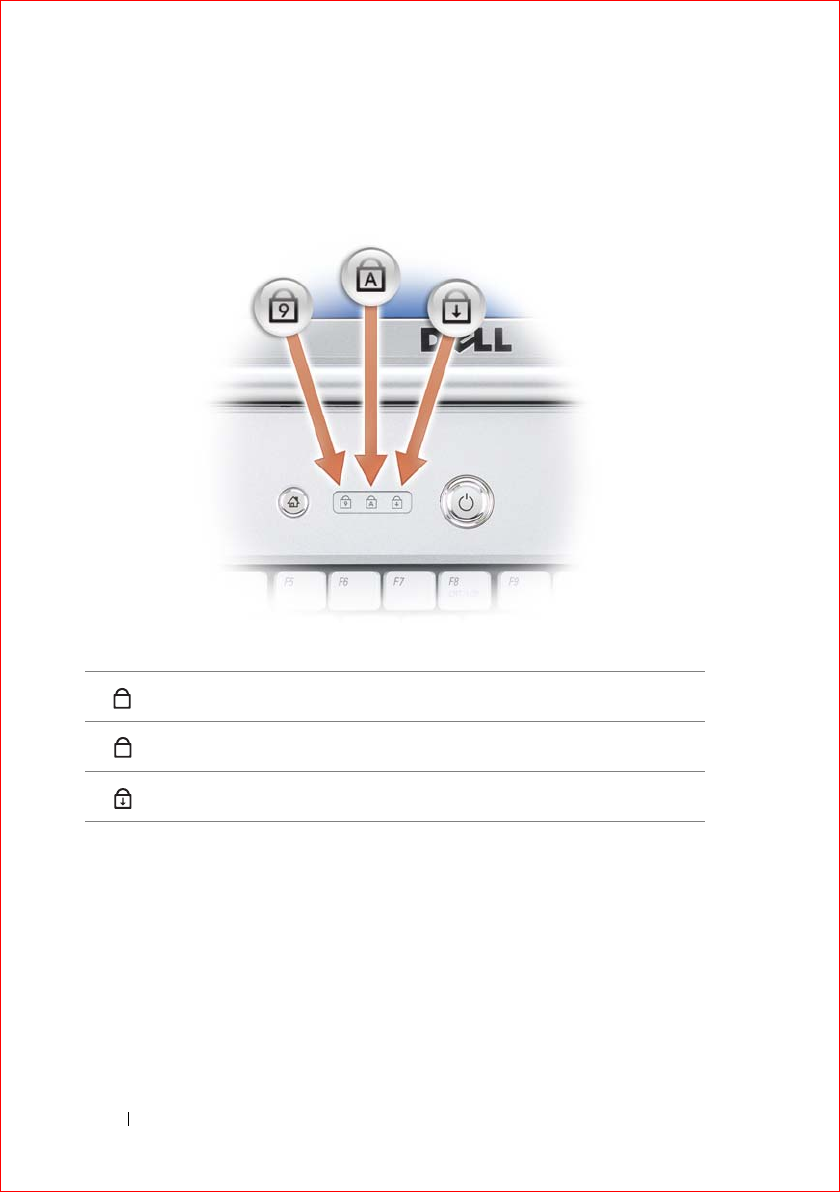
24 About Your Computer
FILE LOCATION: S:\systems\Sapporo_Yebisu\Sapporo\OM\A00\EN\about.fm
DELL CONFIDENTIAL – PRELIMINARY 2/14/07 - FOR PROOF ONLY
DELL™ MEDIADIRECT™ BUTTON —Press the Dell MediaDirect button to launch Dell
MediaDirect (see "Using Dell MediaDirect™" on page 60).
KEYBOARD STATUS LIGHTS
The blue lights located above the keyboard indicate the following:
DIGITAL ARRAY MICROPHONES —Built-in microphone for conferencing and chat.
Turns on when the numeric keypad is enabled.
Turns on when the uppercase letter (caps lock) function is enabled.
Turns on when the scroll lock function is enabled.
9
A
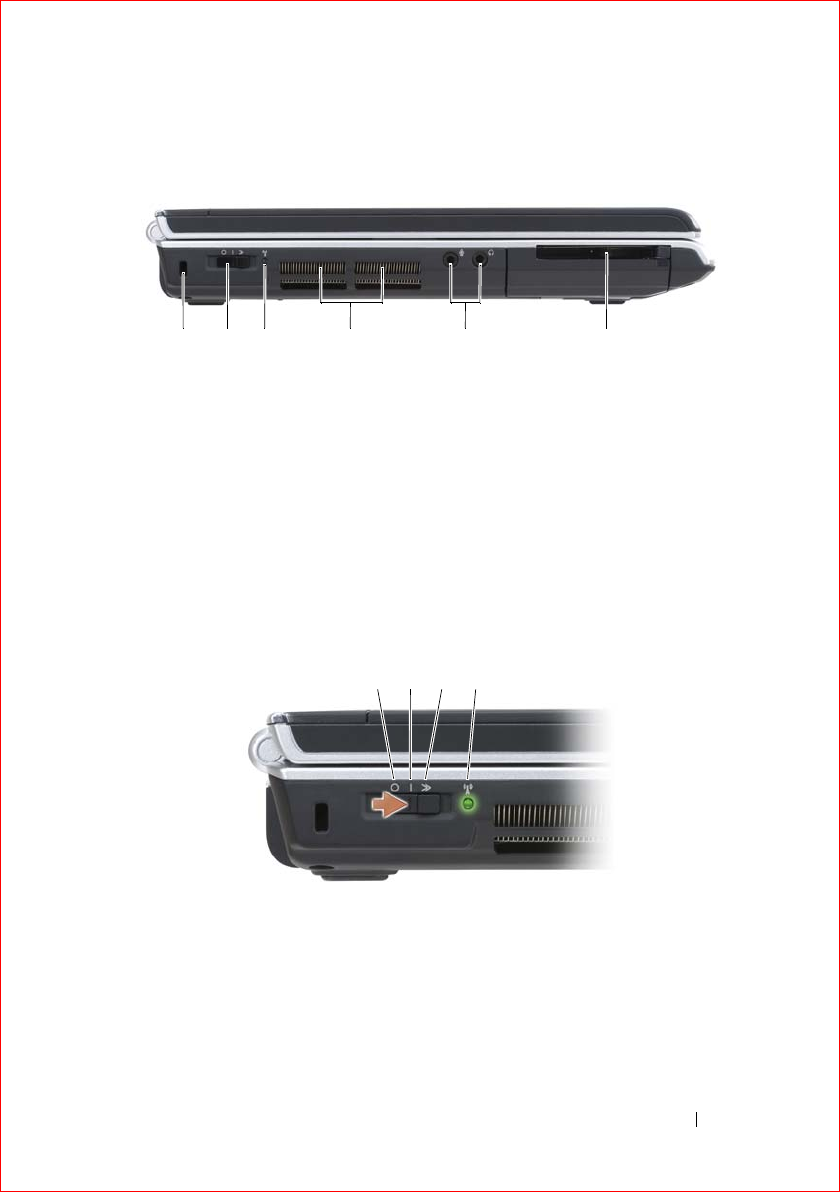
About Your Computer 25
FILE LOCATION: S:\systems\Sapporo_Yebisu\Sapporo\OM\A00\EN\about.fm
DELL CONFIDENTIAL – PRELIMINARY 2/14/07 - FOR PROOF ONLY
Left Side View
SECURITY CABLE SLOT —Lets you attach a commercially available antitheft device to
the computer (see "Security Cable Lock" on page 97).
WIRELESS SWITCH —When enabled through Dell QuickSet, this switch can scan for a
wireless local area network (WLAN) in your vicinity. You can also use it to rapidly turn
off or on any wireless devices such as WLAN cards and internal cards with Bluetooth
wireless technology (see "Dell Wi-Fi Catcher™ Network Locator" on page 95).
1 security cable slot 2 wireless switch
3 Wi-Fi Catcher light 4 air vents
5 audio connectors 6 ExpressCard slot
12563 4
1 2 3 4
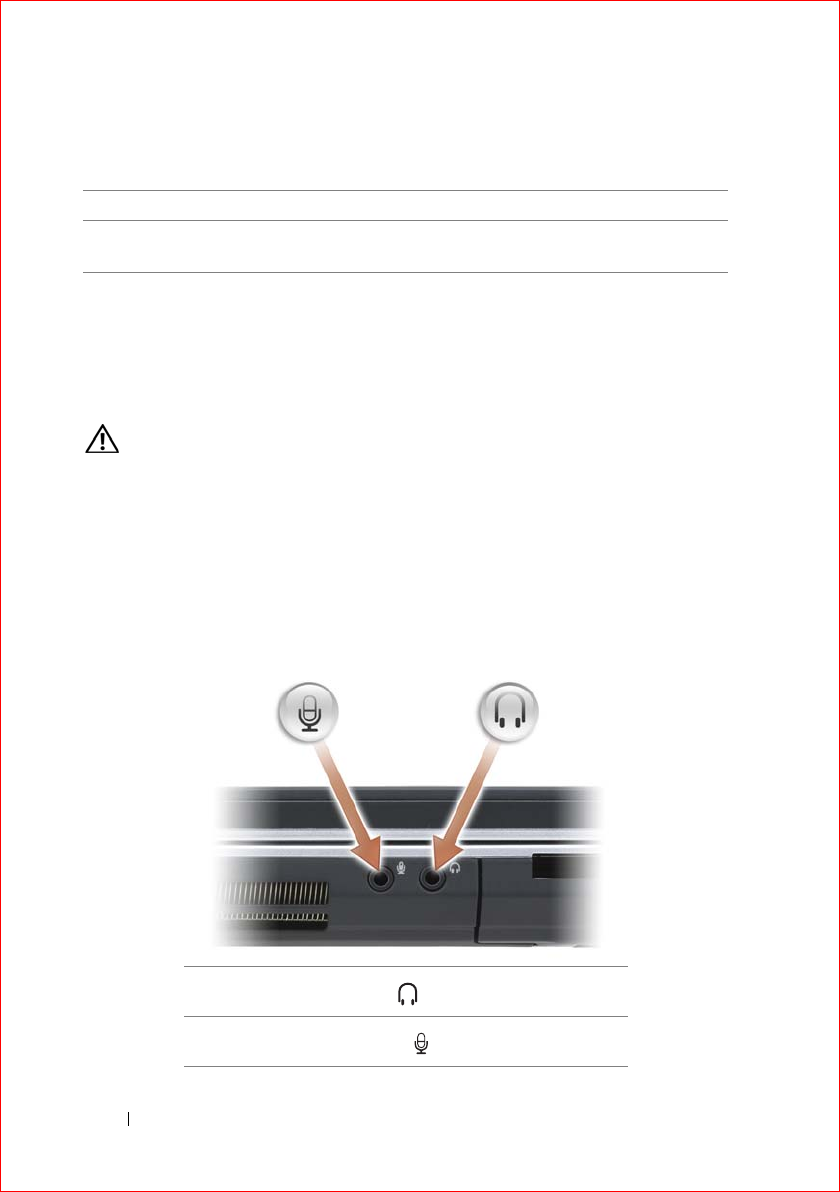
26 About Your Computer
FILE LOCATION: S:\systems\Sapporo_Yebisu\Sapporo\OM\A00\EN\about.fm
DELL CONFIDENTIAL – PRELIMINARY 2/14/07 - FOR PROOF ONLY
CAUTION: Do not block, push objects into, or allow dust to accumulate in the air
vents. Do not store your computer in a low-airflow environment, such as a closed
briefcase, while it is running. Restricting the airflow can damage the computer or
cause a fire.
AIR VENTS —The computer uses an internal fan to create airflow through the vents,
which prevents the computer from overheating. The computer turns the fan on when the
computer gets hot. Fan noise is normal and does not indicate a problem with the fan or
the computer.
AUDIO CONNECTORS
1off Disables wireless devices.
2on Enables wireless devices.
3momentary Scans for WLAN networks (see "Dell Wi-Fi
Catcher™ Network Locator" on page 95).
4Wi-Fi Catcher light
• Flashing green: Searching for networks
• Solid green: Strong network found
• Solid yellow: Weak network found
• Flashing yellow: Error
• Off: No signal found
Attach headphones to the connector.
Attach a microphone to the connector.
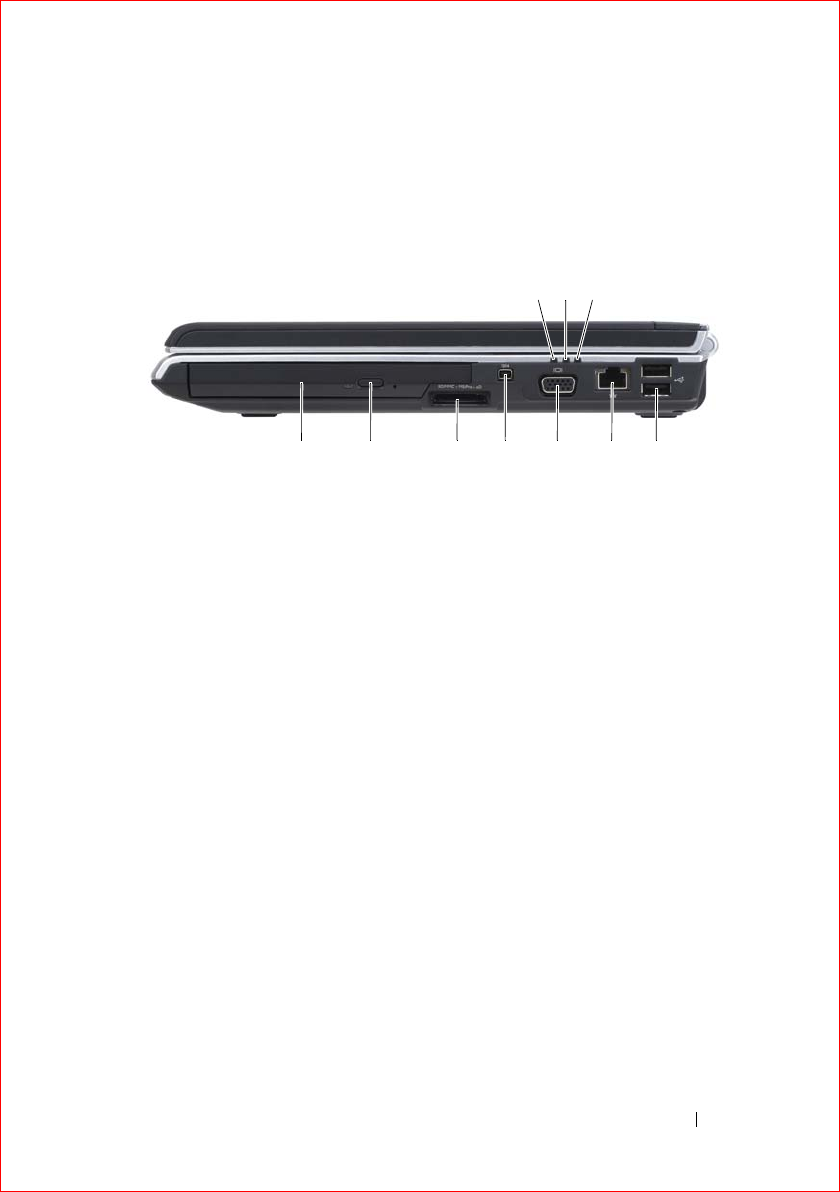
About Your Computer 27
FILE LOCATION: S:\systems\Sapporo_Yebisu\Sapporo\OM\A00\EN\about.fm
DELL CONFIDENTIAL – PRELIMINARY 2/14/07 - FOR PROOF ONLY
EXPRESSCARD SLOT —Supports one ExpressCard. The computer ships with a plastic
blank installed in the slot. For more information, see "Using ExpressCards" on page 79.
Right Side View
OPTICAL DRIVE —For more information about the optical drive, see "Using
Multimedia" on page 55.
EJECT BUTTON —Press the eject button to open the optical drive.
8-IN-1 MEMORY CARD READER —Provides a fast and convenient way to view and
share digital photos, music, and videos stored on a media memory card. The computer
ships with a plastic blank installed in the slot. The 8-in-1 memory card reader reads the
following digital media memory cards:
• Secure Digital (SD) memory card
• SDIO card
• MultiMediaCard (MMC)
• Memory Stick
• Memory Stick PRO
• xD-Picture Card
• Hi Speed-SD
• Hi Density-SD
IEEE 1394 CONNECTOR —Connects devices supporting IEEE 1394 high-speed
1 battery status light 2 hard drive activity light
3 power light 4 optical drive
5 eject button 6 8-in-1 memory card reader
7 IEEE 1394 connector 8 video connector (VGA)
9 network connector (RJ-45) 10 USB connectors (2)
4 6 7 910
85
123
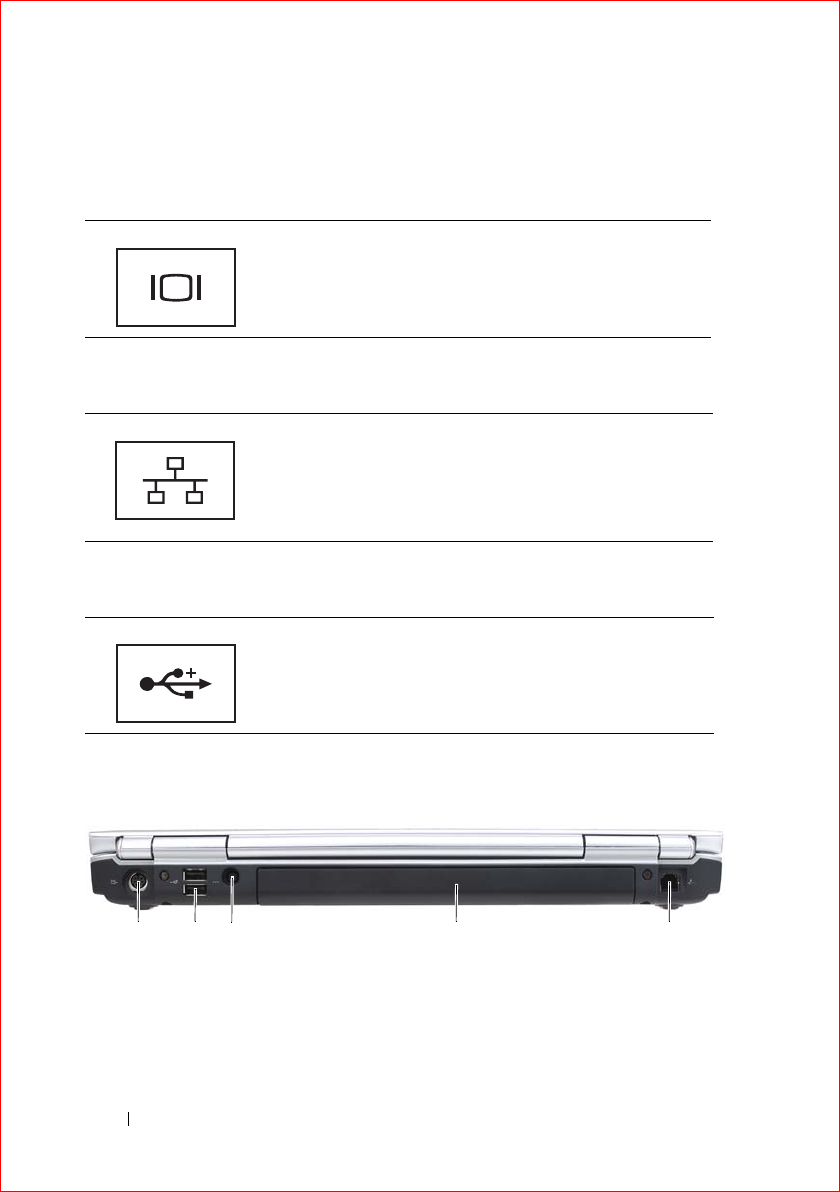
28 About Your Computer
FILE LOCATION: S:\systems\Sapporo_Yebisu\Sapporo\OM\A00\EN\about.fm
DELL CONFIDENTIAL – PRELIMINARY 2/14/07 - FOR PROOF ONLY
transfer rates, such as some digital video cameras.
VIDEO CONNECTOR
NETWORK CONNECTOR (RJ-45)
USB CONNECTORS
Back View
Connects video devices, such as a monitor.
Connects the computer to a network. The two lights next to
the connector indicate status and activity for wired network
connections.
For information on using the network adapter, see the device
user’s guide supplied with your computer.
Connect USB devices, such as a mouse, keyboard, or printer.
1 S-video TV-out connector 2 USB connectors (2)
3 AC adapter connector 4 battery
5 modem connector (RJ-11)
1 2 354
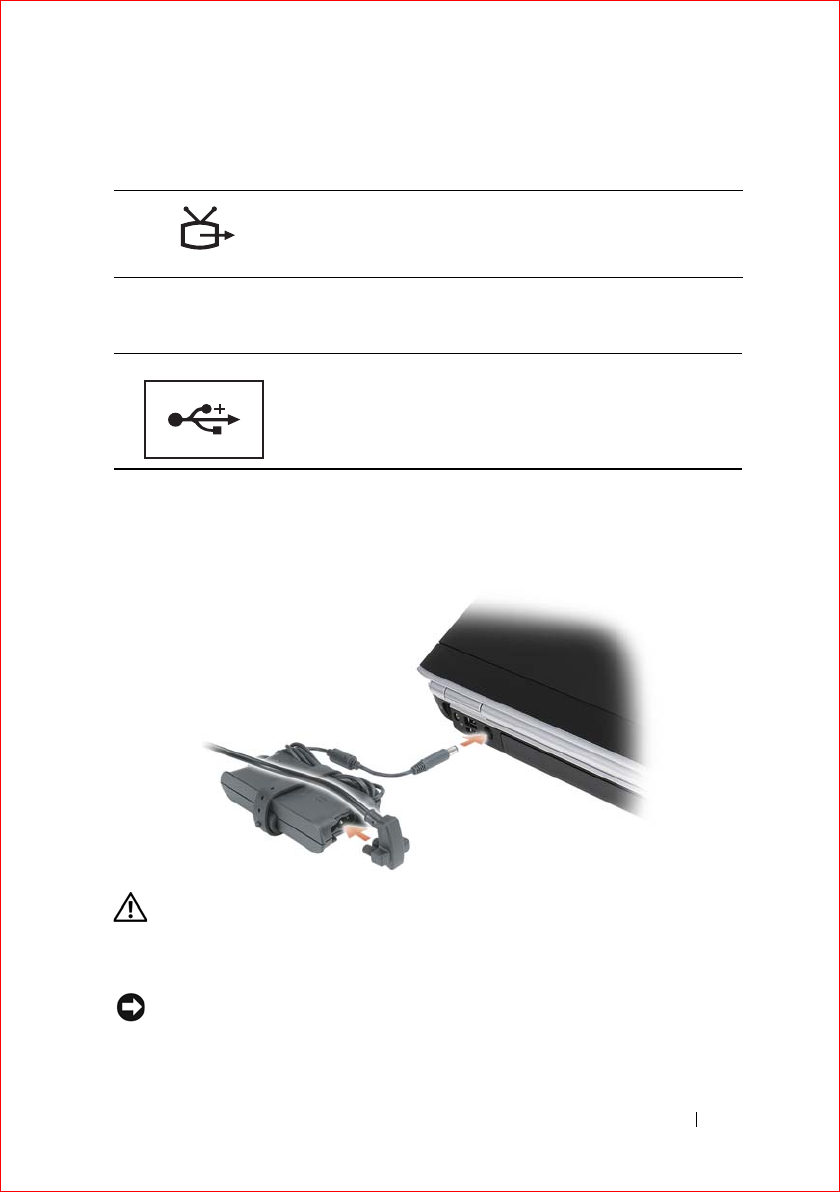
About Your Computer 29
FILE LOCATION: S:\systems\Sapporo_Yebisu\Sapporo\OM\A00\EN\about.fm
DELL CONFIDENTIAL – PRELIMINARY 2/14/07 - FOR PROOF ONLY
S-VIDEO TV-OUT CONNECTOR
USB CONNECTORS
AC ADAPTER CONNECTOR —Attaches an AC adapter to the computer. The AC adapter
converts AC power to the DC power required by the computer. You can connect the
AC adapter with your computer turned on or off.
CAUTION: The AC adapter works with electrical outlets worldwide. However,
power connectors and power strips vary among countries. Using an incompatible
cable or improperly connecting the cable to the power strip or electrical outlet
may cause fire or equipment damage.
NOTICE: When you disconnect the AC adapter cable from the computer, grasp the
connector, not the cable itself, and pull firmly, but gently to help prevent damage to
the cable.
Connects your computer to a TV. Also connects digital
audio-capable devices using the TV/digital audio
adapter cable.
Connect USB devices, such as a mouse, keyboard, or printer.
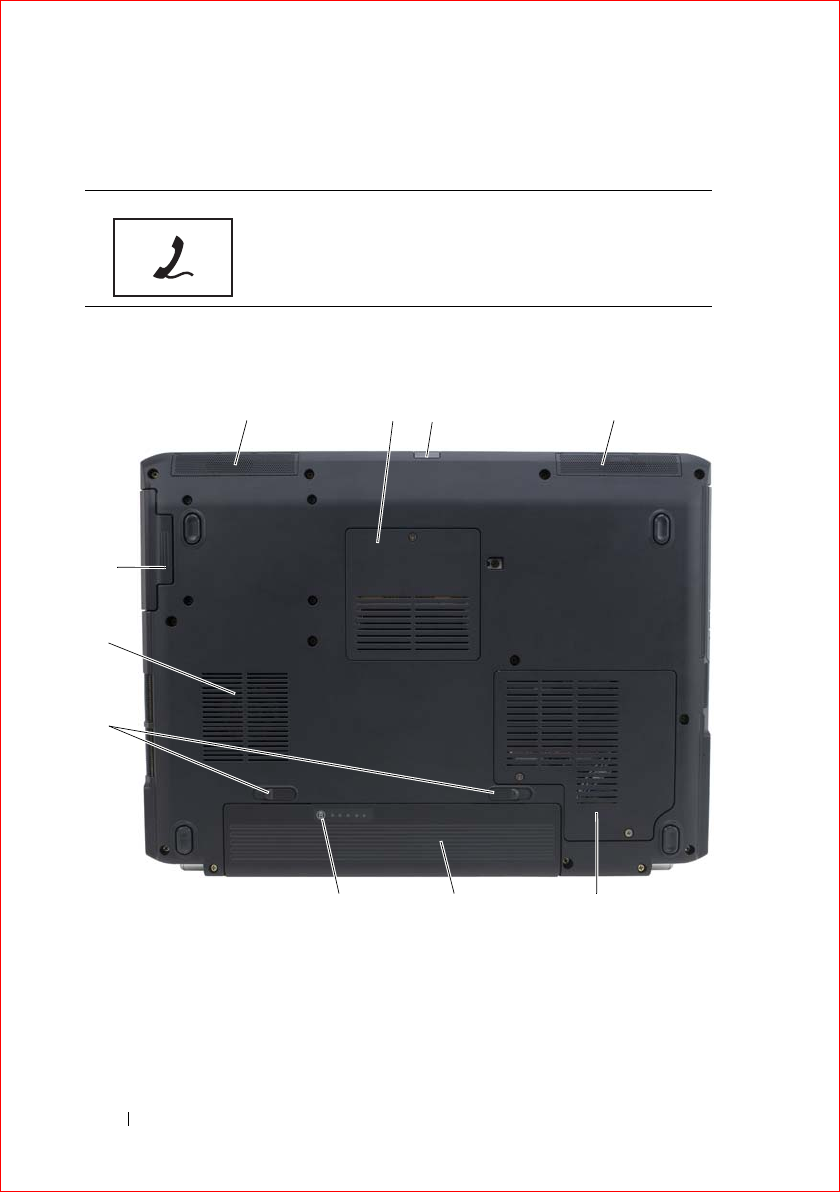
30 About Your Computer
FILE LOCATION: S:\systems\Sapporo_Yebisu\Sapporo\OM\A00\EN\about.fm
DELL CONFIDENTIAL – PRELIMINARY 2/14/07 - FOR PROOF ONLY
MODEM CONNECTOR (RJ-11)
Bottom View
Connect the telephone line to the modem connector.
For information on using the modem, see the online modem
documentation supplied with your computer.
234
10
7
1
6
8
9
5

About Your Computer 31
FILE LOCATION: S:\systems\Sapporo_Yebisu\Sapporo\OM\A00\EN\about.fm
DELL CONFIDENTIAL – PRELIMINARY 2/14/07 - FOR PROOF ONLY
LEFT SPEAKER —To adjust the volume of the integrated speaker, press the volume
control buttons or the mute button.
MEMORY MODULE/COIN-CELL BATTERY COMPARTMENT —Compartment that
contains the DIMM B memory module and the coin-cell battery. For additional
information, see "Adding and Replacing Parts" on page 137.
CONSUMER IR — Lets you transfer files from your computer to another infrared-
compatible device without using cable connections. When you receive your computer,
the sensor is disabled. You can use the system setup program (see "Using the System
Setup Program" on page 187) to enable the sensor. For information on transferring data,
see Windows Help and Support (click Start , and then click Help and Support) or
the documentation that came with your infrared-compatible device.
RIGHT SPEAKER —To adjust the volume of the integrated speaker, press the volume
control buttons or the mute button.
WIRELESS MINI CARD COMPARTMENT —Compartment for WLAN, WWAN, or
WPAN Mini Cards (see "Wireless Mini Cards" on page 153).
BATTERY —When a battery is installed, you can use the computer without connecting
the computer to an electrical outlet (see "Using a Battery" on page 47).
BATTERY CHARGE/HEALTH GAUGE —Provides information on the battery charge (see
"Checking the Battery Charge" on page 48).
BATTERY-BAY LATCH RELEASES —Releases the battery (see "Replacing the Battery"
on page 52 for instructions).
FAN —The computer uses a fan to create airflow through the vents, which prevents the
computer from overheating. The computer turns the fan on when the computer gets hot.
Fan noise is normal and does not indicate a problem with the fan or the computer.
HARD DRIVE —Stores software and data.
1 left speaker 2 memory module/coin-cell battery
compartment
3 consumer IR 4 right speaker
5 wireless mini card compartment 6 battery
7 battery charge/health gauge 8 battery-bay latch releases (2)
9 fan 10 hard drive

32 About Your Computer
FILE LOCATION: S:\systems\Sapporo_Yebisu\Sapporo\OM\A00\EN\about.fm
DELL CONFIDENTIAL – PRELIMINARY 2/14/07 - FOR PROOF ONLY

Template Last Updated - 2/7/2007 Setting Up Your Computer 33
DELL CONFIDENTIAL – PRELIMINARY 2/14/07 - FOR PROOF ONLY
Setting Up Your Computer
Connecting to the Internet
NOTE: ISPs and ISP offerings vary by country.
To connect to the Internet, you need a modem or network connection and an
Internet service provider (ISP). Your ISP will offer one or more of the following
Internet connection options:
• DSL connections that provide high-speed Internet access through your
existing telephone line or cellular telephone service. With a DSL connection,
you can access the Internet and use your telephone on the same line
simultaneously.
• Cable modem connections that provide high-speed Internet access through
your local cable TV line.
• Satellite modem connections that provide high-speed Internet access through
a satellite television system.
• Dial-up connections that provide Internet access through a telephone line.
Dial-up connections are considerably slower than DSL, cable, and satellite
modem connections.
• Wireless local area network (WLAN) connections that provide Internet
access.
• Wireless personal area network (WPAN) connections using Bluetooth
®
wireless technology.
If you are using a dial-up connection, connect a telephone line to the modem
connector on your computer and to the telephone wall jack before you set up
your Internet connection. If you are using a DSL, cable, or satellite modem
connection, contact your ISP or cellular telephone service for setup instructions.
Setting Up Your Internet Connection
To set up an Internet connection with a provided ISP desktop shortcut:
1
Save and close any open files, and exit any open programs.
2
Double-click the ISP
icon on the Microsoft
®
Windows
®
desktop.

34 Setting Up Your Computer
FILE LOCATION: S:\systems\Sapporo_Yebisu\Sapporo\OM\A00\EN\setting.fm
DELL CONFIDENTIAL – PRELIMINARY 2/14/07 - FOR PROOF ONLY
3
Follow the instructions on the screen to complete the setup.
NOTE: If you are having problems connecting to the Internet, see "E-Mail, Modem,
and Internet Problems" on page 108. If you cannot connect to the Internet, but have
successfully connected in the past, the ISP may have a service outage. Contact
your ISP to check the service status, or try connecting again later.
NOTE: Have your ISP information ready. If you do not have an ISP, the Connect to
the Internet wizard can help you obtain one.
If you do not have an ISP icon on your desktop or if you want to set up an
Internet connection with a different ISP:
1
Save and close any open files, and exit any open programs.
2
Click
Start
, and then click
Control Panel
.
3
Under
Network and Internet
, click
Connect to the Internet
.
The
Connect to the Internet
window appears.
4
Click either
Broadband (PPPoE)
or
Dial-up
, depending on how you want to
connect:
• Choose
Broadband
if you will use a DSL modem, cable TV modem,
satellite modem, or Bluetooth wireless technology connection.
• Choose
Dial-up
if you will use a dial-up modem or ISDN.
NOTE: If you do not know which type of connection to select, click Help me
choose or contact your ISP.
5
Follow the instructions on the screen and use the setup information provided
by your ISP to complete the setup.
Transferring Information to a New Computer
You can transfer the following types of data from one computer to another:
• E-mail messages
• Toolbar settings
• Window sizes
• Internet bookmarks
Use one of the following methods for transferring data:
• Windows Easy Transfer wizard, an Easy Transfer Cable, and a USB port

Setting Up Your Computer 35
FILE LOCATION: S:\systems\Sapporo_Yebisu\Sapporo\OM\A00\EN\setting.fm
DELL CONFIDENTIAL – PRELIMINARY 2/14/07 - FOR PROOF ONLY
• Over a network
• Removable media, such as a writable CD
Windows Easy Transfer
1
Click
Start
→
All Programs
→
Accessories
→
System Tools
→
Windows Easy Transfer
.
2
In the
User Account Control
dialog box, click
Continue
.
3
Click
Next
.
4
Click
Start a new transfer
or
Continue a transfer in progress
.
5
Follow the instructions in the Windows Easy Transfer wizard.
Setting Up a Printer
NOTICE: Complete the operating system setup before you connect a printer to the
computer.
See the documentation that came with the printer for setup information,
including how to:
• Obtain and install updated drivers.
• Connect the printer to the computer.
• Load paper and install the toner or ink cartridge.
For technical assistance, refer to the printer owner's manual or contact the
printer manufacturer.
Printer Cable
Your printer connects to your computer with a USB cable. Your printer may not
come with a printer cable, so if you purchase a cable separately, ensure that it is
compatible with your printer and computer. If you purchased a printer cable at
the same time you purchased your computer, the cable may arrive in the
computer’s shipping box.
Connecting a USB Printer
NOTE: You can connect USB devices while the computer is turned on.
1
Complete the operating system setup if you have not already done so.
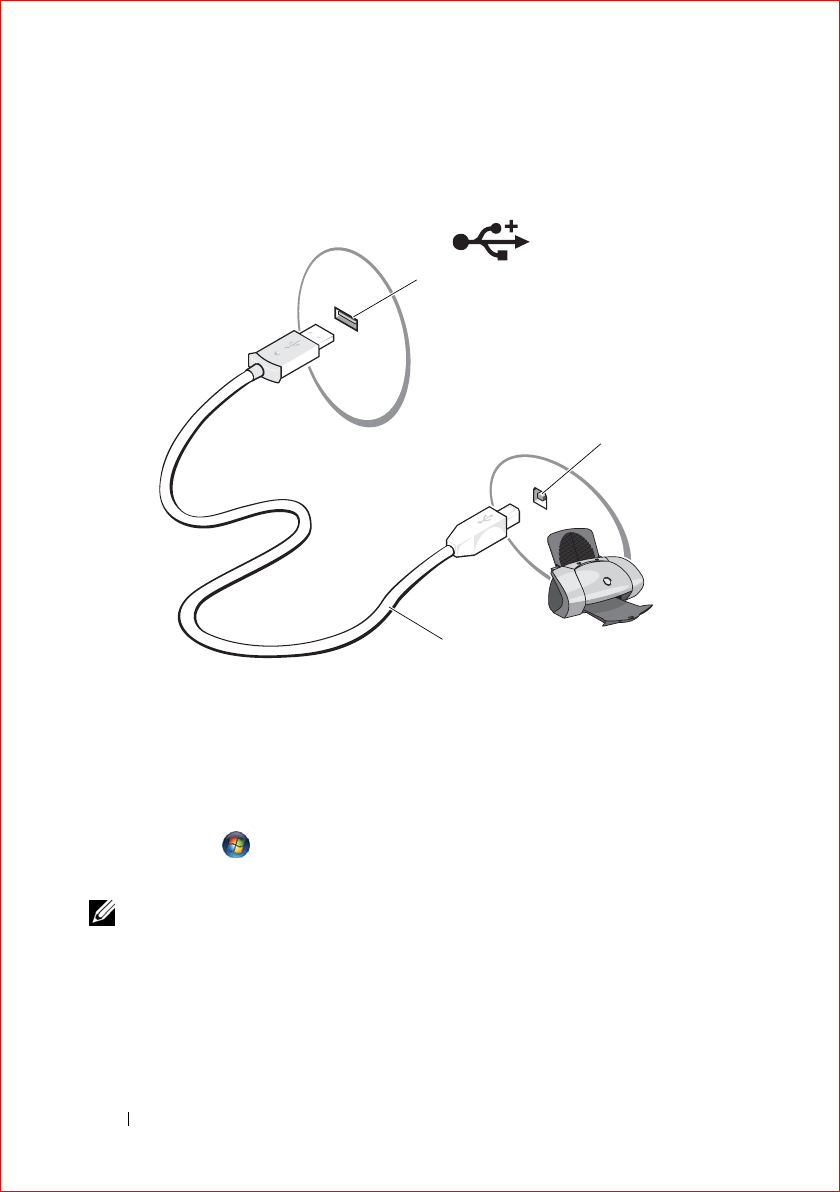
36 Setting Up Your Computer
FILE LOCATION: S:\systems\Sapporo_Yebisu\Sapporo\OM\A00\EN\setting.fm
DELL CONFIDENTIAL – PRELIMINARY 2/14/07 - FOR PROOF ONLY
2
Attach the USB printer cable to the USB connectors on the computer and the
printer. The USB connectors fit only one way.
3
Turn on the printer, and then turn on the computer.
If the
Add New Hardware Wizard
window appears, click
Cancel
.
4
Click
Start
, and then click
Network
.
5
Click
Add a printer
to start the Add Printer Wizard.
NOTE: To install the printer driver, see "Reinstalling Drivers and Utilities" on
page 128 and the documentation that came with your printer.
6
Click
Add a local printer
or
Add a network, wireless, or Bluetooth
printer
.
7
Follow the instructions in the Add Printer Wizard.
1 USB connector on computer 2 USB connector on printer
3 USB printer cable
3
2
1

Setting Up Your Computer 37
FILE LOCATION: S:\systems\Sapporo_Yebisu\Sapporo\OM\A00\EN\setting.fm
DELL CONFIDENTIAL – PRELIMINARY 2/14/07 - FOR PROOF ONLY
Power Protection Devices
Several devices are available to protect against power fluctuations and failures:
• Surge protectors
• Line conditioners
• Uninterruptible power supplies (UPS)
Surge Protectors
Surge protectors and power strips equipped with surge protection help prevent
damage to your computer from voltage spikes that can occur during electrical
storms or after power interruptions. Some surge protector manufacturers include
warranty coverage for certain types of damage. Carefully read the device
warranty when choosing a surge protector. A device with a higher joule rating
offers more protection. Compare joule ratings to determine the relative
effectiveness of different devices.
NOTICE: Most surge protectors do not protect against power fluctuations or
power interruptions caused by nearby lightning strikes. When lightning occurs in
your area, disconnect the telephone line from the telephone wall jack and
disconnect your computer from the electrical outlet.
Many surge protectors have a telephone jack for modem protection. See the
surge protector documentation for modem connection instructions.
NOTICE: Not all surge protectors offer network adapter protection. Disconnect the
network cable from the network wall jack during electrical storms.
Line Conditioners
NOTICE: Line conditioners do not protect against power interruptions.
Line conditioners are designed to maintain AC voltage at a fairly constant level.
Uninterruptible Power Supplies
NOTICE: Loss of power while data is being saved to the hard drive may result in
data loss or file damage.
NOTE: To ensure maximum battery operating time, connect only your computer to
a UPS. Connect other devices, such as a printer, to a separate power strip that
provides surge protection.

38 Setting Up Your Computer
FILE LOCATION: S:\systems\Sapporo_Yebisu\Sapporo\OM\A00\EN\setting.fm
DELL CONFIDENTIAL – PRELIMINARY 2/14/07 - FOR PROOF ONLY
A UPS protects against power fluctuations and interruptions. UPS devices
contain a battery that provides temporary power to connected devices when AC
power is interrupted. The battery charges while AC power is available. See the
UPS manufacturer documentation for information on battery operating time and
to ensure that the device is approved by Underwriters Laboratories (UL).

Template Last Updated - 2/7/2007 Using the Display 39
DELL CONFIDENTIAL – PRELIMINARY 2/14/07 - FOR PROOF ONLY
Using the Display
Adjusting Brightness
When a Dell™ computer is running on battery power, you can conserve power
by setting the display brightness to the lowest comfortable level.
• Press <Fn> and the up-arrow key to increase brightness on the integrated
display only (not on an external monitor).
• Press <Fn> and the down-arrow key to decrease brightness on the integrated
display only (not on an external monitor).
NOTE: Brightness key combinations only affect the display on your portable
computer, not monitors or projectors that you attach to your portable computer or
docking device. If your computer is connected to an external monitor and you try to
change the brightness level, the Brightness Meter may appear, but the brightness
level on the external device does not change.
Switching the Video Image From Your Computer
Display To a Projector
When you start the computer with an external device attached (such as an
external monitor or projector) and turned on, the image may appear on either the
computer display or the external device.
Press <Fn><F8> to switch the video image between the display only, the
external device only, or the display and the external device simultaneously.
Setting Display Resolution and Refresh Rate
NOTE: If you change the display resolution from the current settings, the image
may appear blurry or text may be hard to read if you change the resolution to one
not supported by your computer and display. Before you change any of the display
settings, make a note of the current settings so you can change back to the
previous settings if needed.

40 Using the Display
FILE LOCATION: S:\systems\Sapporo_Yebisu\Sapporo\OM\A00\EN\display.fm
DELL CONFIDENTIAL – PRELIMINARY 2/14/07 - FOR PROOF ONLY
You can enhance the legibility of text and change the appearance of images on
the screen by adjusting display resolution. As you increase resolution, items
appear smaller on the screen. In contrast, lower resolution causes text and
images to appear larger and can benefit people with vision impairments. To
display a program at a specific resolution, both the video card and the display
must support the program, and the necessary video drivers must be installed.
NOTE: Use only the Dell-installed video drivers, which are designed to offer the
best performance with your Dell-installed operating system.
If you choose a resolution or color palette that is higher than the display
supports, the settings adjust automatically to the closest supported values.
To set the display resolution and refresh rate for your display:
1
Click
Start
→
Control Panel
.
2
Under
Appearance and Personalization
, click
Adjust screen resolution
.
3
In the
Display Settings
window, under
Resolution
, move the slide bar to the
left or right to decrease/increase the screen resolution.
NOTE: For additional instructions, click How do I get the best display?
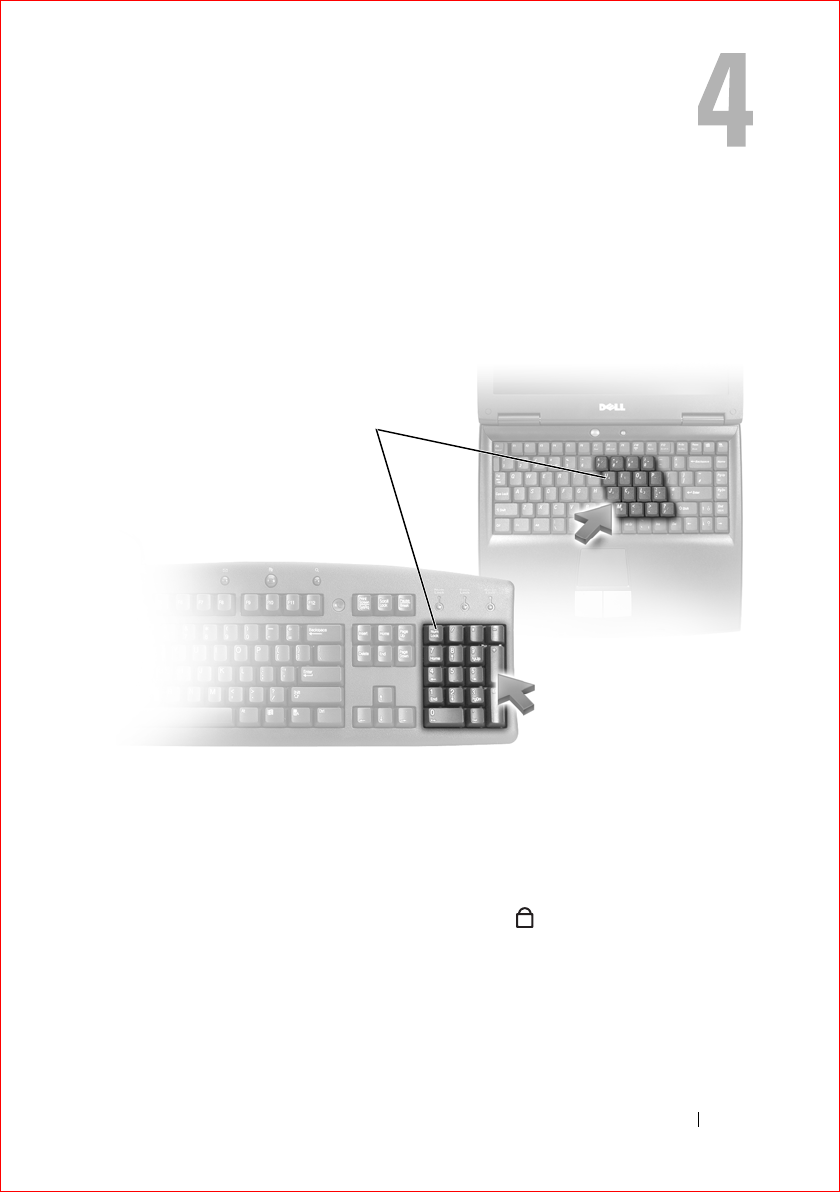
Template Last Updated - 2/7/2007 Using the Keyboard and Touchpad 41
DELL CONFIDENTIAL – PRELIMINARY 2/14/07 - FOR PROOF ONLY
Using the Keyboard and Touchpad
Numeric Keypad
The numeric keypad functions like the numeric keypad on an external keyboard.
Each key on the keypad has multiple functions. The keypad numbers and
symbols are marked in blue on the right of the keypad keys. To type a number or
symbol, hold down <Fn> and press the desired key.
• To enable the keypad, press <Num Lk>. The light indicates that the
keypad is active.
• To disable the keypad, press <Num Lk> again.
numeric keypad
9

42 Using the Keyboard and Touchpad
FILE LOCATION: S:\systems\Sapporo_Yebisu\Sapporo\OM\A00\EN\keyboard.fm
DELL CONFIDENTIAL – PRELIMINARY 2/14/07 - FOR PROOF ONLY
Key Combinations
System Functions
Display Functions
Battery
Power Management
Microsoft® Windows® Logo Key Functions
<Ctrl><Shift><Esc> Opens the Task Manager window.
<Fn><F8> Displays icons representing all currently
available display options (display only, external
monitor or projector only, both display and
projector, etc). Highlight the desired icon to
switch the display to that option.
<Fn> and up-arrow key Increases brightness on the integrated display
only (not on an external monitor).
<Fn> and down-arrow key Decreases brightness on the integrated display
only (not on an external monitor).
<Fn><F3> Displays the Dell™ QuickSet Battery Meter
(see "Dell QuickSet Battery Meter" on
page 48).
<Fn><Esc> Activates a power management mode. You can
reprogram this keyboard shortcut to activate a
different power management mode using the
Advanced tab in the Power Options
Properties window (see "Configuring Power
Management Settings" on page 50).
Windows logo key and <m> Minimizes all open windows.

Using the Keyboard and Touchpad 43
FILE LOCATION: S:\systems\Sapporo_Yebisu\Sapporo\OM\A00\EN\keyboard.fm
DELL CONFIDENTIAL – PRELIMINARY 2/14/07 - FOR PROOF ONLY
Dell™ QuickSet Key Combinations
If Dell QuickSet is installed, you can use other shortcut keys for functions such
as the Battery Meter or activating power management modes. For more
information about Dell QuickSet key combinations, right-click the QuickSet
icon in the notification area, and then click Help.
Adjusting Keyboard Settings
To adjust keyboard operation, such as the character repeat rate:
1
Click
Start
,
and then click
Control
Panel
.
2
Click
Hardware and Sound
.
3
Click
Keyboard
.
Touch Pad
The touch pad detects the pressure and movement of your finger to allow you to
move the cursor on the display. Use the touch pad and touch pad buttons as you
would use a mouse.
Windows logo key and
<Shift><m>
Restores all minimized windows. This key
combination functions as a toggle to restore
minimized windows following the use of the
Windows logo key and <m> combination.
Windows logo key and <e> Starts Windows Explorer.
Windows logo key and <r> Opens the Run dialog box.
Windows logo key and <f> Opens the Search Results dialog box.
Windows logo key and <Ctrl><f> Opens the Search Results-Computer dialog box (if
the computer is connected to a network).
Windows logo key and <Pause> Opens the System Properties dialog box.
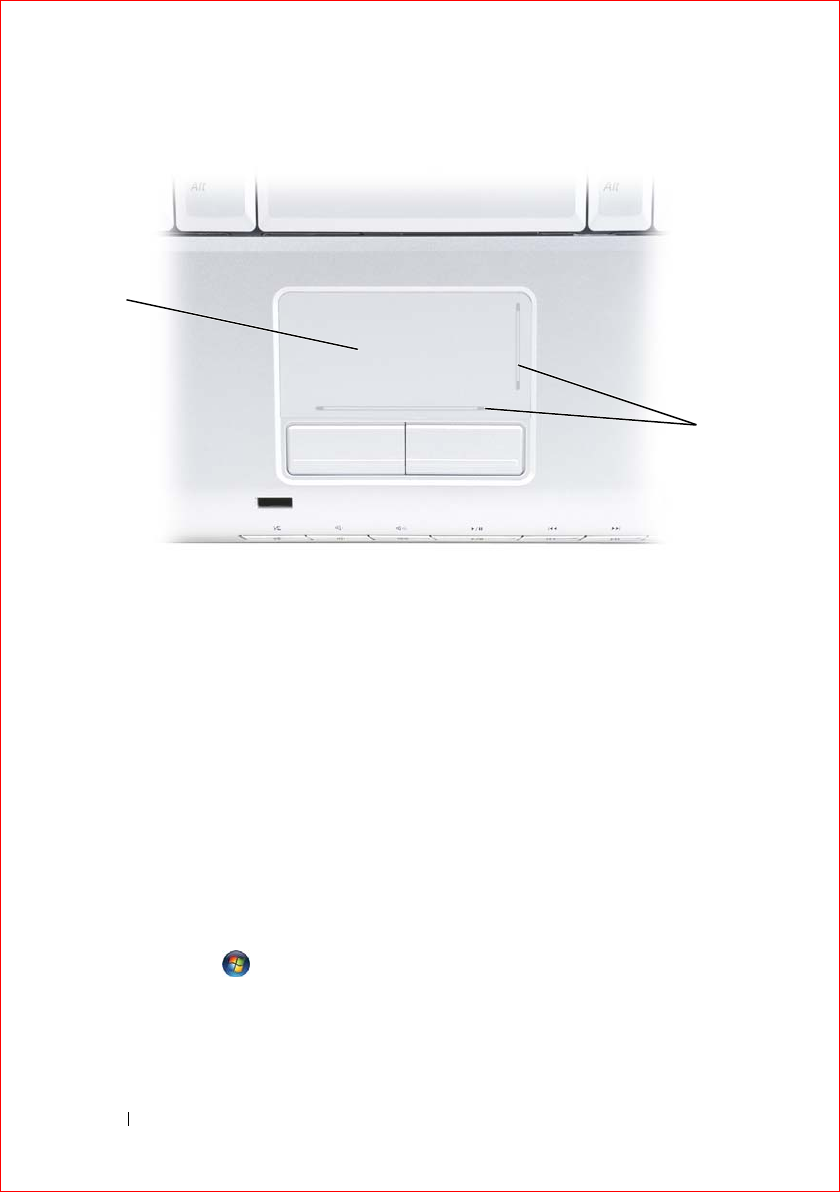
44 Using the Keyboard and Touchpad
FILE LOCATION: S:\systems\Sapporo_Yebisu\Sapporo\OM\A00\EN\keyboard.fm
DELL CONFIDENTIAL – PRELIMINARY 2/14/07 - FOR PROOF ONLY
• To move the cursor, lightly slide your finger over the touch pad.
• To select an object, lightly tap once on the surface of the touch pad or use
your thumb to press the left touch pad button.
• To select and move (or drag) an object, position the cursor on the object and
tap twice on the touch pad. On the second tap, leave your finger on the touch
pad and move the selected object by sliding your finger over the surface.
• To double-click an object, position the cursor on the object and tap twice on
the touch pad or use your thumb to press the left touch pad button twice.
Customizing the Touch Pad
You can use the Mouse Properties window to disable the touch pad or adjust the
touch pad settings.
1
Click
Start
,
and then click
Control
Panel
.
2
Click
Hardware and Sound
.
3
Click
Keyboard
.
4
In the
Mouse Properties
window:
1 touch pad 2 silk screen depicting scrolling capabilities
1
2

Using the Keyboard and Touchpad 45
FILE LOCATION: S:\systems\Sapporo_Yebisu\Sapporo\OM\A00\EN\keyboard.fm
DELL CONFIDENTIAL – PRELIMINARY 2/14/07 - FOR PROOF ONLY
• Click the
Device Select
tab to disable the touch pad.
• Click the
Touch Pad
tab to adjust touch pad settings.
5
Click
OK
to save the settings and close the window.

46 Using the Keyboard and Touchpad
FILE LOCATION: S:\systems\Sapporo_Yebisu\Sapporo\OM\A00\EN\keyboard.fm
DELL CONFIDENTIAL – PRELIMINARY 2/14/07 - FOR PROOF ONLY

Template Last Updated - 2/7/2007 Using a Battery 47
DELL CONFIDENTIAL – PRELIMINARY 2/14/07 - FOR PROOF ONLY
Using a Battery
Battery Performance
NOTE: For information about the Dell warranty for your computer, see the Product
Information Guide or separate paper warranty document that shipped with your
computer.
For optimal computer performance and to help preserve BIOS settings, operate
your Dell™ portable computer with the main battery installed at all times. One
battery is supplied as standard equipment in the battery bay.
NOTE: Because the battery may not be fully charged, use the AC adapter to
connect your new computer to an electrical outlet the first time you use the
computer. For best results, operate the computer with the AC adapter until the
battery is fully charged. To view battery charge status, place the mouse cursor over
the battery icon in the Windows notification area.
NOTE: Battery operating time (the time the battery can hold a charge) decreases
over time. Depending on how often the battery is used and the conditions under
which it is used, you may need to purchase a new battery during the life of your
computer.
NOTE: It is recommended that you connect your computer to an electrical outlet
when writing to media.
Battery operating time varies depending on operating conditions. Operating time
is significantly reduced when you perform operations including, but not limited
to, the following:
• Using optical drives.
• Using wireless communications devices, ExpressCards, media memory
cards, or USB devices.
• Using high-brightness display settings, 3D screen savers, or other power-
intensive programs such as complex 3D graphics applications.
• Running the computer in maximum performance mode (see "Configuring
Power Management Settings" on page 50 for information about accessing
Windows Power Options Properties or Dell QuickSet, which you can use to
configure power management settings).
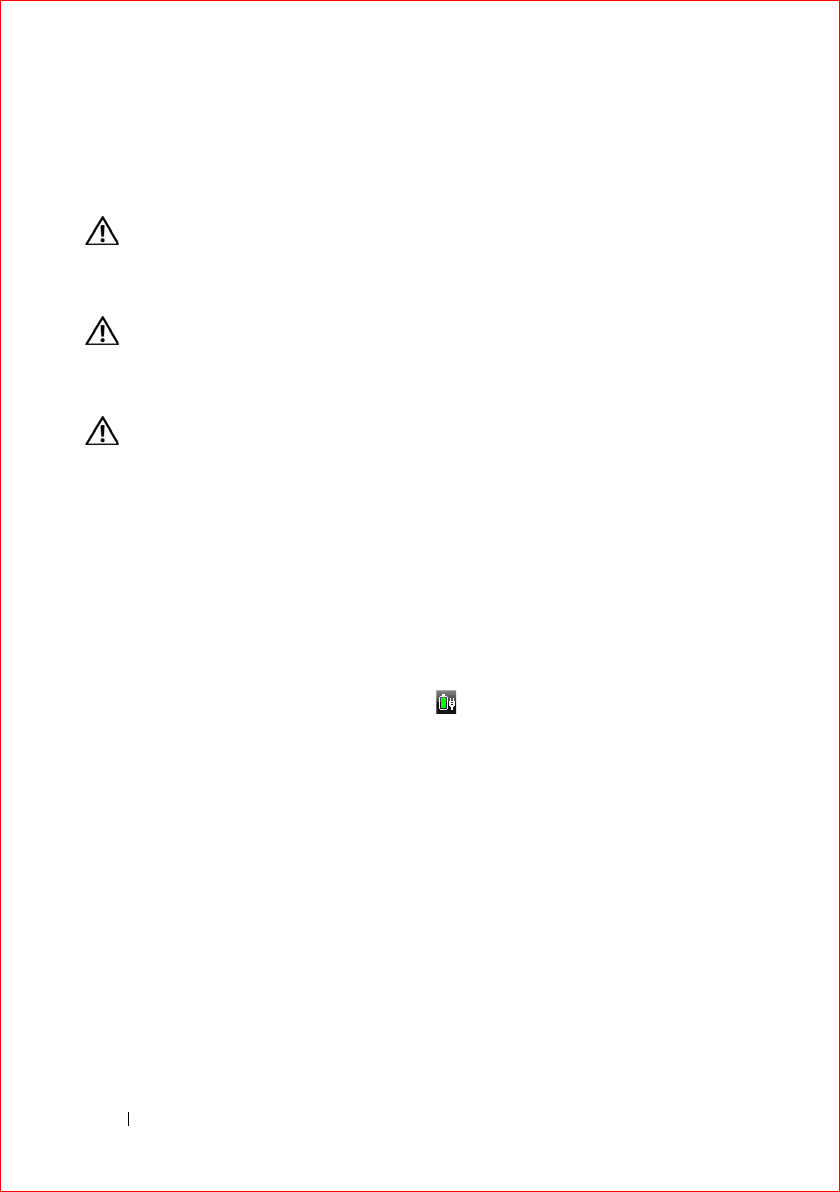
48 Using a Battery
FILE LOCATION: S:\systems\Sapporo_Yebisu\Sapporo\OM\A00\EN\battery.fm
DELL CONFIDENTIAL – PRELIMINARY 2/14/07 - FOR PROOF ONLY
You can check the battery charge before you insert the battery into the computer.
You can also set power management options to alert you when the battery
charge is low.
CAUTION: Using an incompatible battery may increase the risk of fire or
explosion. Replace the battery only with a compatible battery purchased from
Dell. The battery is designed to work with your Dell computer. Do not use batteries
from other computers with your computer.
CAUTION: Do not dispose of batteries with household waste. When your battery
no longer holds a charge, call your local waste disposal or environmental agency
for advice on disposing of a lithium-ion battery (see "Battery Disposal" in the
Product Information Guide).
CAUTION: Misuse of the battery may increase the risk of fire or chemical burn.
Do not puncture, incinerate, disassemble, or expose the battery to temperatures
above 65°C (149°F). Keep the battery away from children. Handle damaged or
leaking batteries with extreme care. Damaged batteries may leak and cause
personal injury or equipment damage.
Checking the Battery Charge
You can check the battery charge on your computer using any one of the
following methods:
• Dell QuickSet Battery Meter
• Microsoft Windows battery meter icon located in the notification area
• Battery charge/health gauge located on the battery
• Low-battery warning pop-up window
Dell QuickSet Battery Meter
To view the
Dell QuickSet Battery Meter:
• Double-click the Dell QuickSet icon in the taskbar, and then click
Battery
Meter
or
• Press <Fn><F3>
The Battery Meter displays the status, battery health, charge level, and charge
completion time for the battery in your computer.

Using a Battery 49
FILE LOCATION: S:\systems\Sapporo_Yebisu\Sapporo\OM\A00\EN\battery.fm
DELL CONFIDENTIAL – PRELIMINARY 2/14/07 - FOR PROOF ONLY
For more information about QuickSet, right-click the QuickSet icon, and then
click Help.
Microsoft® Windows® Battery Meter
The battery meter indicates the remaining battery charge. To check the battery
meter, double-click the icon in the notification area.
Charge Gauge
By either pressing once or pressing and holding the status button on the battery
charge gauge, you can check:
• Battery charge (check by
pressing
and
releasing
the status button)
• Battery health (check by
pressing
and
holding
the status button)
The battery operating time is largely determined by the number of times it is
charged. After hundreds of charge and discharge cycles, batteries lose some
charge capacity—or battery health. Therefore, a battery can show a status of
charged, but maintain a reduced charge capacity (health).
Check the Battery Charge
To check the battery charge, press and release the status button on the battery
charge gauge to illuminate the charge indicator lights. Each light represents
approximately 20 percent of the total battery charge. For example, if the battery
has 80 percent of its charge remaining, four of the lights are on. If no lights are
on, the battery has no charge.
Check the Battery Health
NOTE: You can check battery health in one of two ways: by using the charge gauge
on the battery, as described below, and by using the Battery Meter in Dell QuickSet.
For information about QuickSet, right-click the QuickSet icon in the notification
area, and then click Help.
To check the battery health using the charge gauge, press and hold the status
button on the battery charge gauge for at least 3 seconds to illuminate the health
indicator lights. Each light represents incremental degradation. If no lights
appear, the battery is in good condition, and more than 80 percent of its original
charge capacity remains. If five lights appear, less than 60 percent of the charge
capacity remains, and you should consider replacing the battery (see "Battery"
on page 183 for more information about the battery operating time).

50 Using a Battery
FILE LOCATION: S:\systems\Sapporo_Yebisu\Sapporo\OM\A00\EN\battery.fm
DELL CONFIDENTIAL – PRELIMINARY 2/14/07 - FOR PROOF ONLY
Low-Battery Warning
NOTICE: To avoid losing or corrupting data, save your work immediately after a
low-battery warning, then connect the computer to an electrical outlet. If the
battery runs completely out of power, Sleep state begins automatically.
A pop-up window warns you when the battery charge is approximately 90
percent depleted. The computer enters Sleep state when the battery charge is at a
critically low level.
You can change the settings for the battery alarms in Dell QuickSet or the
Power Options window (see "Configuring Power Management Settings" on
page 50).
Conserving Battery Power
To conserve battery power on your portable computer, do any of the following:
• Connect the computer to an electrical outlet when possible; battery life is
largely determined by the number of times the battery is used and recharged.
• Configure the power management settings using either Dell QuickSet or
Microsoft Windows Power Options to optimize your computer’s power
usage (see "Configuring Power Management Settings" on page 50).
• Use the Sleep power state when you leave the computer unattended for long
periods of time (see "Using the Sleep Power State" on page 51).
Configuring Power Management Settings
You can use Dell QuickSet or Windows Power Options to configure the power
management settings on your computer.
• For information on how to use the Dell QuickSet Power Management
wizard, right-click the QuickSet icon in the notification area, click
Help
, and
then select
Power Management
.
• To use Windows Power Options, do one of the following:
• Click
Start
→
Control Panel
→
Hardware and Sound
→
Power
Options
, and then select a power plan in the
Select a power plan
window.
or
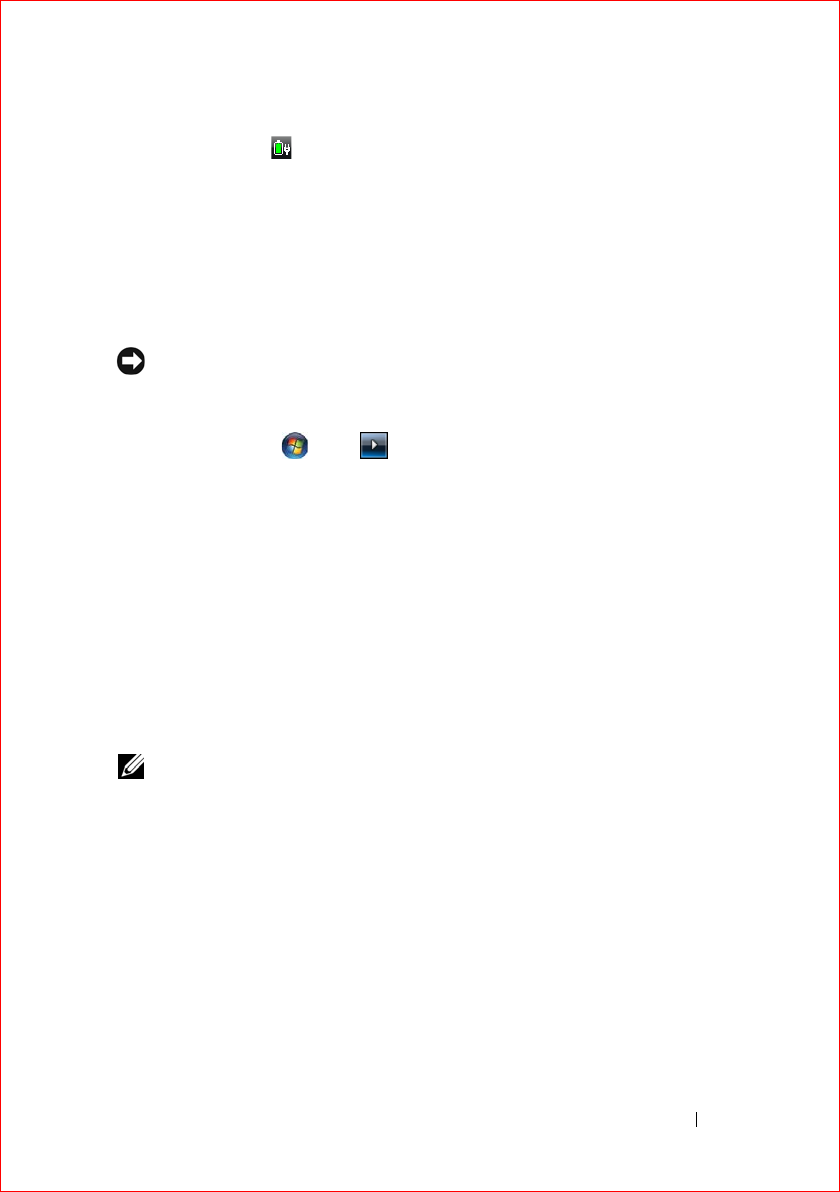
Using a Battery 51
FILE LOCATION: S:\systems\Sapporo_Yebisu\Sapporo\OM\A00\EN\battery.fm
DELL CONFIDENTIAL – PRELIMINARY 2/14/07 - FOR PROOF ONLY
•
Click the icon in the notification area
, click
Power Options
, and
then select a plan in the
Select a power plan
window.
Using the Sleep Power State
Rather than shutting down your portable computer, use the Sleep power state to
conserve power. Sleep automatically saves your work to your hard drive, and
then returns you to your previous work session without restarting your
computer.
NOTICE: If your computer loses AC and battery power while in Sleep state, it may
lose data.
To enter Sleep state:
•
Click the
Start
, click
,
and then click
Sleep
.
or
• Depending on how you set the power management options in the Windows
Power Options or Dell QuickSet, use one of the following methods:
• Press the power button.
• Close the display.
• Press <Fn><Esc>.
To exit Sleep state, press the power button.
Charging the Battery
NOTE: Charge time is longer with the computer turned on. You can leave the
battery in the computer for as long as you like. The battery’s internal circuitry
prevents the battery from overcharging.
When you connect the computer to an electrical outlet or install a battery while
the computer is connected to an electrical outlet, the computer checks the
battery charge and temperature. If necessary, the AC adapter then charges the
battery and maintains the battery charge.
If the battery is hot from being used in your computer or being in a hot
environment, the battery may not charge when you connect the computer to an
electrical outlet.

52 Using a Battery
FILE LOCATION: S:\systems\Sapporo_Yebisu\Sapporo\OM\A00\EN\battery.fm
DELL CONFIDENTIAL – PRELIMINARY 2/14/07 - FOR PROOF ONLY
The battery is too hot to start charging if the battery light flashes alternately
blue and amber. Disconnect the computer from the electrical outlet and allow
the computer and the battery to cool to room temperature, then connect the
computer to an electrical outlet to continue charging the battery.
For more information about resolving problems with a battery, see "Power
Problems" on page 121.
Replacing the Battery
CAUTION: Using an incompatible battery may increase the risk of fire or
explosion. Replace the battery only with a compatible battery purchased from
Dell. The battery is designed to work with your Dell computer. Do not use batteries
from other computers with your computer.
CAUTION: Before performing these procedures, turn off the computer, disconnect
the AC adapter from the electrical outlet and the computer, disconnect the modem
from the wall connector and the computer, and remove any other external cables
from the computer.
NOTICE: You must remove all external cables from the computer to avoid possible
connector damage.
NOTICE: If you choose to replace the battery with the computer in Sleep state, you
have up to 1 minute to complete the battery replacement before the computer shuts
down and loses any unsaved data.
To remove the battery:
1
If the computer is connected to a docking device (docked), undock it. See the
documentation that came with your docking device for instructions.
2
Ensure that the computer is turned off.
3
Turn the computer over.
4
Slide and click the battery release latches to keep them open.
5
Slide the battery out of the bay.
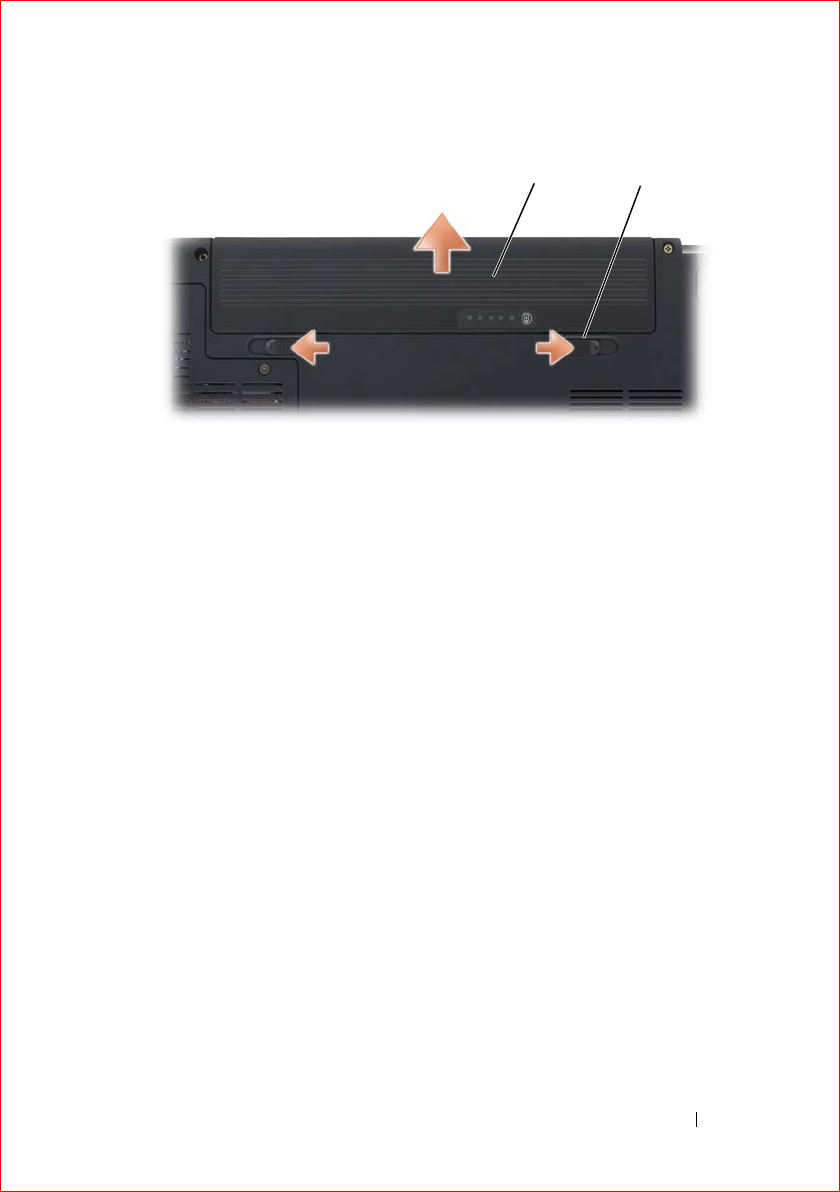
Using a Battery 53
FILE LOCATION: S:\systems\Sapporo_Yebisu\Sapporo\OM\A00\EN\battery.fm
DELL CONFIDENTIAL – PRELIMINARY 2/14/07 - FOR PROOF ONLY
To replace the battery, follow the removal procedure in reverse order.
Storing a Battery
Remove the battery when you store your computer for an extended period of
time. A battery discharges during prolonged storage. After a long storage period,
recharge the battery fully (see "Charging the Battery" on page 51) before you
use it.
1 battery 2 battery release latches (2)
2
1

54 Using a Battery
FILE LOCATION: S:\systems\Sapporo_Yebisu\Sapporo\OM\A00\EN\battery.fm
DELL CONFIDENTIAL – PRELIMINARY 2/14/07 - FOR PROOF ONLY
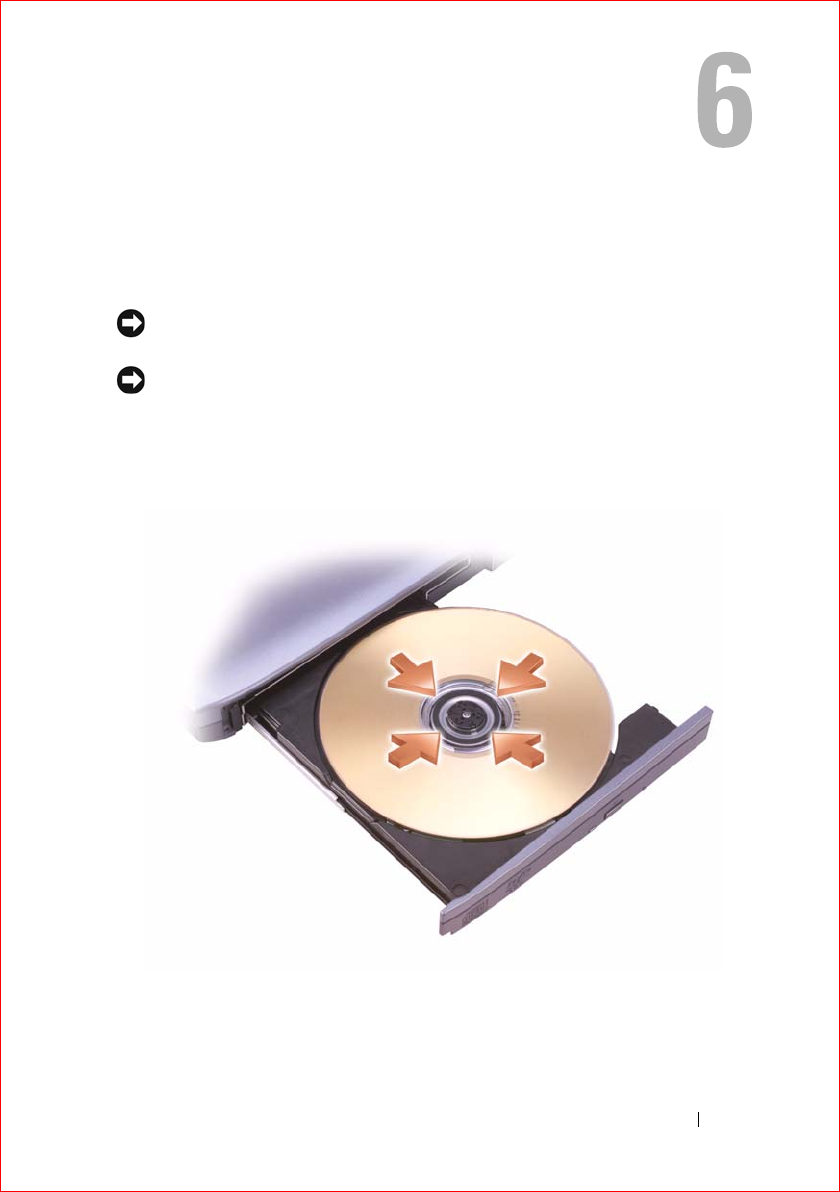
Template Last Updated - 2/7/2007 Using Multimedia 55
DELL CONFIDENTIAL – PRELIMINARY 2/14/07 - FOR PROOF ONLY
Using Multimedia
Playing Media
NOTICE: Do not press down on the optical drive tray when you open or close it.
Keep the tray closed when you are not using the drive.
NOTICE: Do not move the computer while playing media.
1
Press the eject button on the front of the drive.
2
Place the disc, label side up, in the center of the tray and snap the disc onto
the spindle.
3
Push the tray back into the drive.

56 Using Multimedia
FILE LOCATION: S:\systems\Sapporo_Yebisu\Sapporo\OM\A00\EN\media.fm
DELL CONFIDENTIAL – PRELIMINARY 2/14/07 - FOR PROOF ONLY
To format media for storing or copying data, see the media software that came
with your computer.
NOTE: Ensure that you follow all copyright laws when copying media.
A CD player includes the following basic buttons:
A DVD player includes the following basic buttons:
For more information on playing media, click Help on the media player (if
available).
Play.
Move backward within the current track.
Pause.
Move forward within the current track.
Stop.
Go to the previous track.
Eject.
Go to the next track.
Stop.
Restart the current chapter.
Play.
Fast forward.
Pause.
Fast reverse.
Advance a single frame while in pause mode.
Go to the next title or chapter.
Continuously play the current title or chapter.
Go to the previous title or chapter.
Eject.
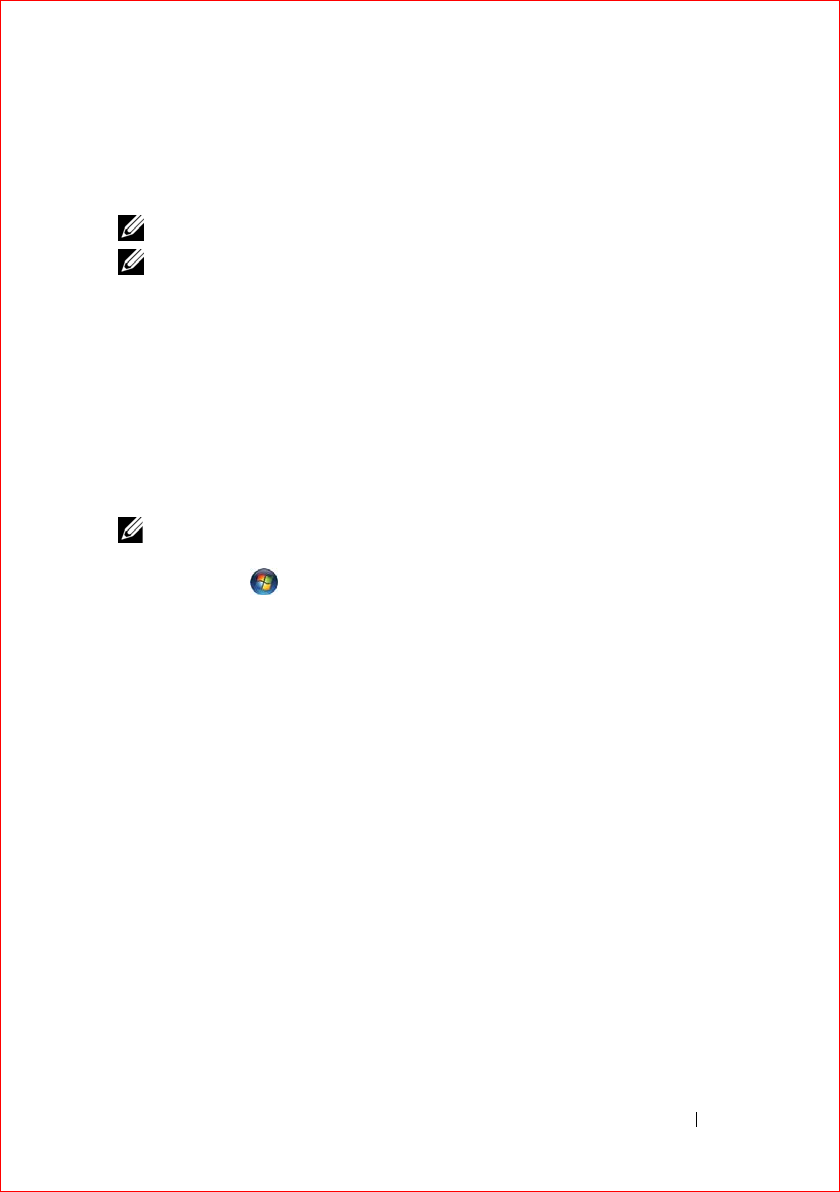
Using Multimedia 57
FILE LOCATION: S:\systems\Sapporo_Yebisu\Sapporo\OM\A00\EN\media.fm
DELL CONFIDENTIAL – PRELIMINARY 2/14/07 - FOR PROOF ONLY
Copying CD and DVD Media
This section applies only to computers that have a DVD+/-RW drive.
NOTE: Ensure that you observe all copyright laws when copying media.
NOTE: The types of optical drives offered by Dell may vary by country.
The following instructions explain how to make an exact copy of a CD or DVD
using Roxio Creator. You can also use Roxio Creator for other purposes, such as
creating music CDs from audio files stored on your computer or backing up
important data. For help, open Roxio Creator, and then press <F1>.
The DVD drives installed in Dell computers do not support HD-DVD media.
For a list of supported media formats, see "Using Blank CD and DVD Media"
on page 57.
How to Copy a CD or DVD
NOTE: Most commercial DVDs have copyright protection and cannot be copied
using Roxio Creator Plus.
1
Click
Start
→
All Programs
→
Roxio
Creator DE
→
Projects
→
Copy
.
2
Under the
Copy
tab, click
Copy Disc
.
3
To copy the CD or DVD:
•
If you have one optical drive
, insert the source disc into the drive, ensure
that the settings are correct, and then click the
Copy Disc
button to
continue. The computer reads your source disc and copies the data to a
temporary folder on your computer hard drive.
When prompted, insert a blank disc into the drive and click
OK
.
•
If you have two optical drives
, select the drive into which you have
inserted your source disc and click the
Copy Disc
button to continue.
The computer copies the data from the source disc to the blank disc.
Once you have finished copying the source disc, the disc that you have
created automatically ejects.
Using Blank CD and DVD Media
DVD-writable drives can write to both CD and DVD recording media.

58 Using Multimedia
FILE LOCATION: S:\systems\Sapporo_Yebisu\Sapporo\OM\A00\EN\media.fm
DELL CONFIDENTIAL – PRELIMINARY 2/14/07 - FOR PROOF ONLY
Use blank CD-Rs to record music or permanently store data files. After creating
a CD-R, you cannot write to that CD-R again (see the Sonic documentation for
more information). Use a blank CD-RW if you plan to erase, rewrite, or update
information on that disc later.
Blank DVD+/-R media can be used to permanently store large amounts of
information. After you create a DVD+/-R, you may not be able to write to that
disc again if the disc is finalized or closed during the final stage of the disc
creation process. Use blank DVD+/-RW media if you plan to erase, rewrite, or
update information on that disc later.
CD-Writable Drives
DVD-Writable Drives
Helpful Tips
• Use Microsoft
®
Windows
®
Explorer to drag and drop files to a CD-R or CD-
RW only after you start
Roxio Creator
and open a Creator project.
• Do not burn a blank CD-R or CD-RW to its maximum capacity; for example,
do not copy a 650-MB file to a blank 650-MB CD. The CD-RW drive needs
1–2 MB of the blank space to finalize the recording.
Media Type Read Write Rewritable
CD-R Yes Yes No
CD-RW Yes Yes Yes
Media Type Read Write Rewritable
CD-R Yes Yes No
CD-RW Yes Yes Yes
DVD+R Yes Yes No
DVD-R Yes Yes No
DVD+RW Yes Yes Yes
DVD-RW Yes Yes Yes
DVD+R DL Yes Yes No
DVD-R DL Yes No No

Using Multimedia 59
FILE LOCATION: S:\systems\Sapporo_Yebisu\Sapporo\OM\A00\EN\media.fm
DELL CONFIDENTIAL – PRELIMINARY 2/14/07 - FOR PROOF ONLY
• Use CD-Rs to burn music CDs that you want to play in regular stereos. CD-
RWs do not play in most home or car stereos.
• Music MP3 files can be played only on MP3 players or on computers that
have MP3 software installed.
• Use a blank CD-RW to practice CD recording until you are familiar with CD
recording techniques. If you make a mistake, you can erase the data on the
CD-RW and try again. You can also use blank CD-RWs to test music file
projects before you record the project permanently to a blank CD-R.
• You cannot create audio DVDs with
Roxio Creator
.
• Commercially available DVD players used in home theater systems may not
support all available DVD formats. For a list of formats supported by your
DVD player, see the documentation provided with your DVD player or
contact the manufacturer.
• See the Roxio website at
www.sonic.com
.
Adjusting the Volume
NOTE: When the speakers are muted, you do not hear the media playing.
1
Right-click the volume icon in the notification area.
2
Click
Open Volume Mixer
.
3
Click and drag the bar to slide it up or down to increase or decrease the
volume.
For more information on volume control options, click Help in the Volume
Mixer window.
The Volume Meter displays the current volume level, including mute, on your
computer. Either click the QuickSet icon in the notification area and select or
deselect Disable On Screen Volume Meter, or press the volume control buttons
to enable or disable the Volume Meter on the screen.
Adjusting the Picture
If an error message notifies you that the current resolution and color depth are
using too much memory and preventing media playback, adjust the display
properties:
1
Click
Start
→
Control Panel
→
Appearance and Personalization
.
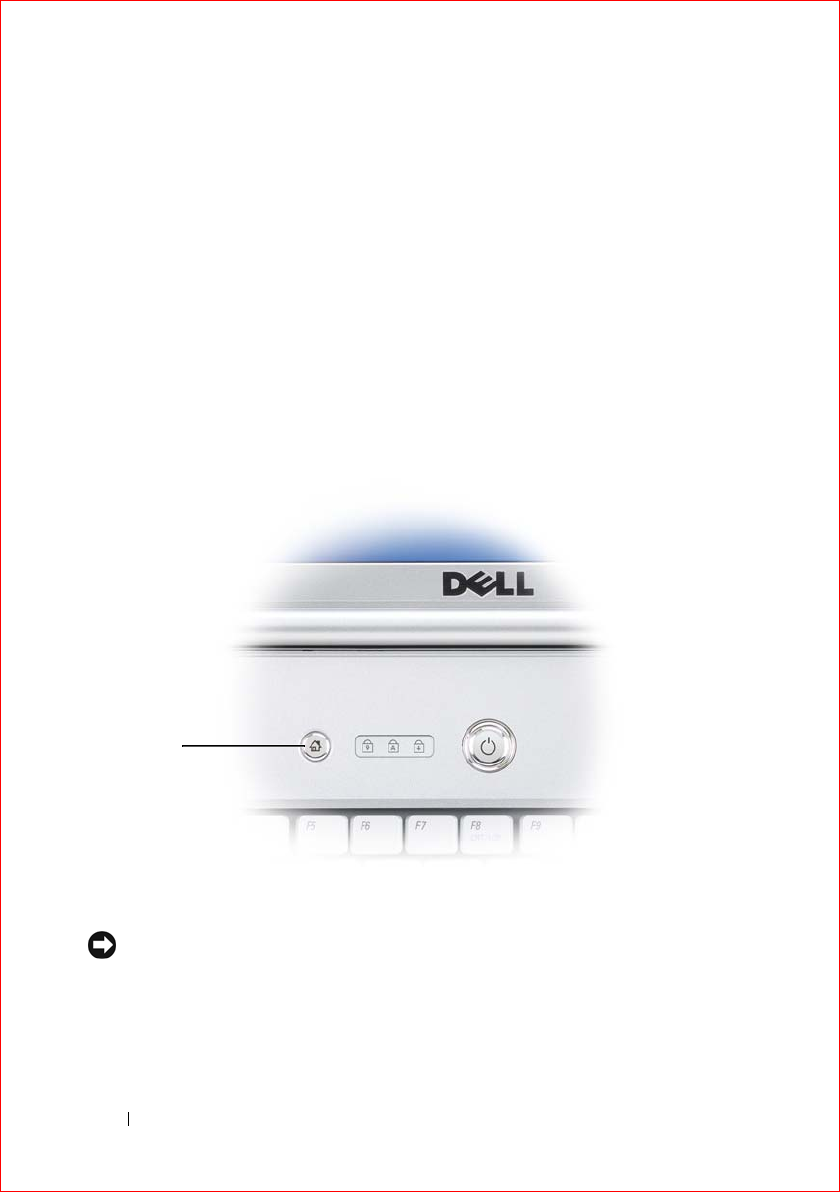
60 Using Multimedia
FILE LOCATION: S:\systems\Sapporo_Yebisu\Sapporo\OM\A00\EN\media.fm
DELL CONFIDENTIAL – PRELIMINARY 2/14/07 - FOR PROOF ONLY
2
Under
Personalization
, click
Adjust screen resolution
.
3
On
Display Settings
, click and drag the bar to reduce the resolution setting.
4
In the drop-down menu under
Color quality
, click
Medium (16 bit)
.
5
Click
OK
.
Using Dell MediaDirect™
Dell MediaDirect is an instant-on multimedia playback mode for digital media.
Press the Dell MediaDirect button, located on the hinge cover, to launch Dell
MediaDirect. When your computer is turned off or in Sleep state, you can press
the Dell MediaDirect button to start the computer and automatically launch the
Dell MediaDirect application.
NOTE: You cannot reinstall Dell MediaDirect if you voluntarily reformat the hard
drive. You need the installation software to reinstall Dell MediaDirect. Contact Dell
for assistance (see "Contacting Dell" on page 177).
For more information on using Dell MediaDirect, use the Help menu in the Dell
MediaDirect application.
1 Dell MediaDirect button
1
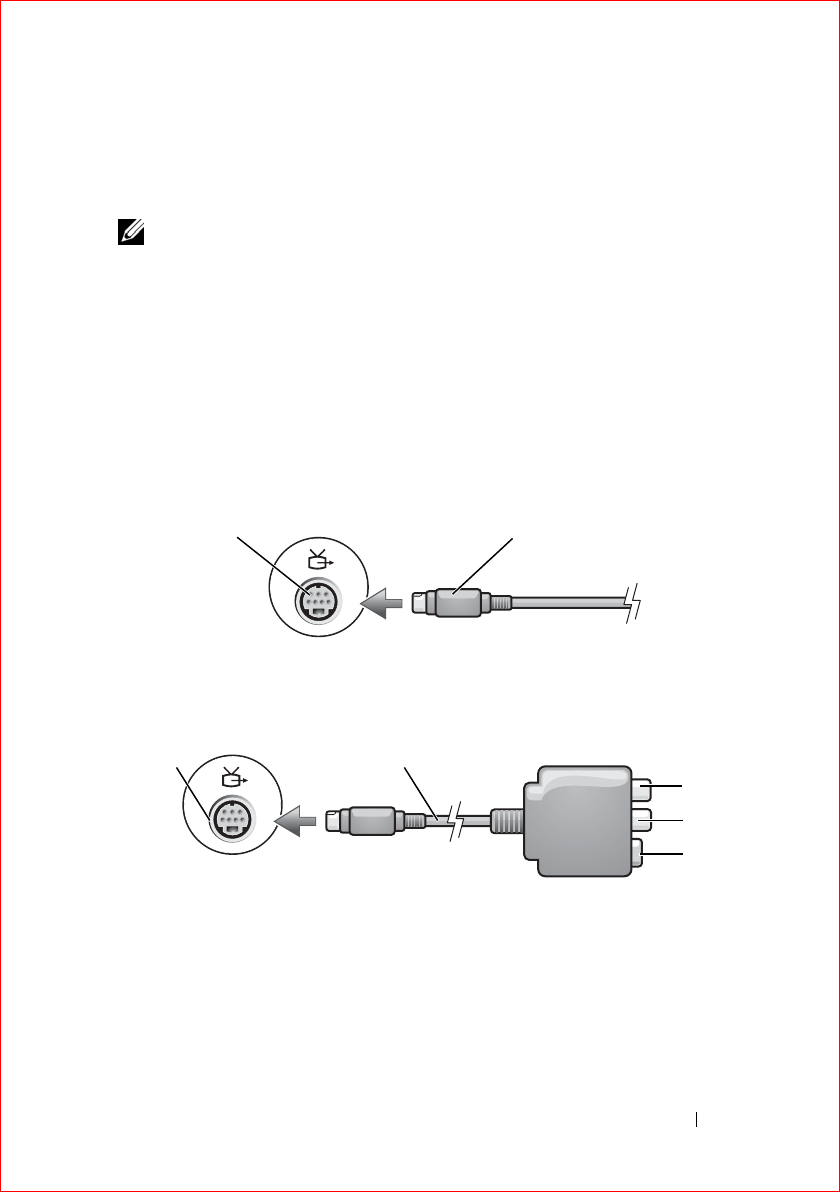
Using Multimedia 61
FILE LOCATION: S:\systems\Sapporo_Yebisu\Sapporo\OM\A00\EN\media.fm
DELL CONFIDENTIAL – PRELIMINARY 2/14/07 - FOR PROOF ONLY
Connecting Your Computer to a TV or Audio
Device
NOTE: Video and audio cables for connecting your computer to a TV or other audio
device may not be included with your computer. Cables and TV/digital audio
adapter cables are available for purchase from Dell.
Your computer has an S-video TV-out connector that, together with a standard
S-video cable, a composite video adapter cable, or a component video adapter
cable (available from Dell), enable you to connect the computer to a TV.
Your TV has either an S-video input connector, a composite video-input
connector, or a component video-input connector. Depending on what type of
connector is available on your TV, you can use a commercially available
S-video cable, composite video cable, or component video cable to connect your
computer to your TV.
1 S-video TV-out connector 2 S-video connector
1 S-video TV-out connector 2 composite video adapter
3 S/PDIF digital audio connector 4 composite video-output connector
5 S-video connector
12
5
4
3
2
1
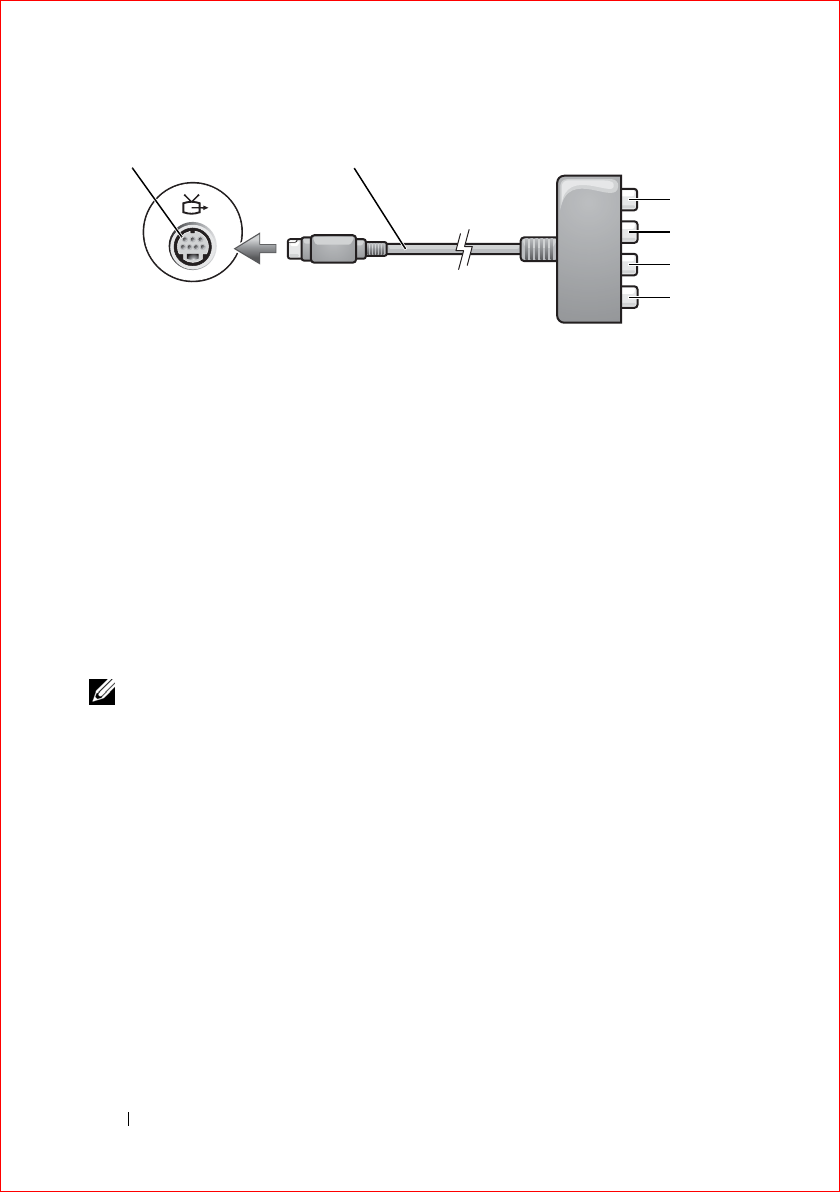
62 Using Multimedia
FILE LOCATION: S:\systems\Sapporo_Yebisu\Sapporo\OM\A00\EN\media.fm
DELL CONFIDENTIAL – PRELIMINARY 2/14/07 - FOR PROOF ONLY
If you want to connect your computer to a TV or audio device, it is
recommended that you connect video and audio cables to your computer in one
of the following combinations:
• S-video and standard audio
• Composite video and standard audio
• Component-out video and standard audio
NOTE: See the diagrams at the beginning of each subsection to help you determine
which method of connection you should use.
When you finish connecting the video and audio cables between your computer
and your TV, you must enable your computer to work with the TV. See
"Enabling the Display Settings for a TV" on page 75 to ensure that the computer
recognizes and works properly with the TV. Additionally, if you are using
S/PDIF digital audio, see "Enabling S/PDIF Digital Audio" on page 74.
1 S-video TV-out connector 2 component video adapter
3 S/PDIF digital audio connector 4 Pr (red) component video-output
connector
5 Pb (blue) component video-output
connector
6 Y (green) component video-output
connector
5
4
3
12
6
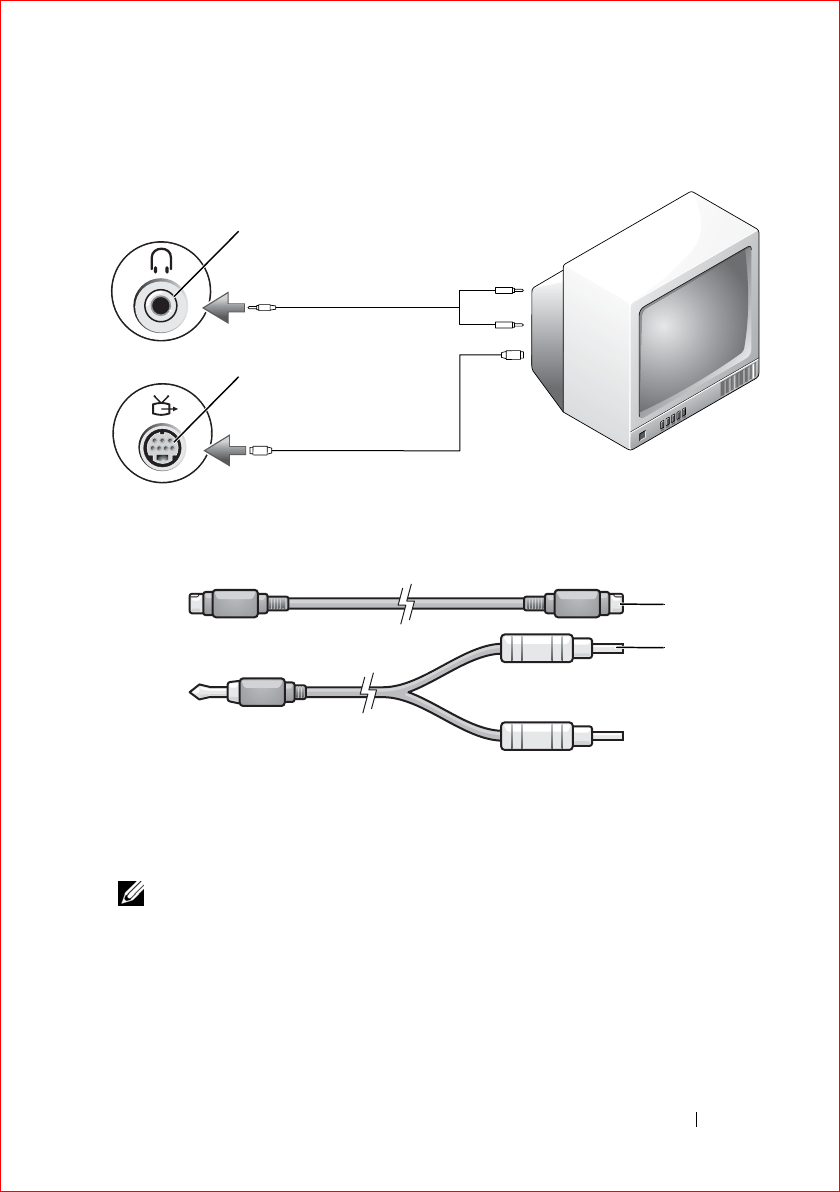
Using Multimedia 63
FILE LOCATION: S:\systems\Sapporo_Yebisu\Sapporo\OM\A00\EN\media.fm
DELL CONFIDENTIAL – PRELIMINARY 2/14/07 - FOR PROOF ONLY
S-Video and Standard Audio
1
Turn off the computer and the TV and/or audio device that you want to
connect.
NOTE: If your TV or audio device supports S-video but not S/PDIF digital audio, you
can connect an S-video cable directly to the S-video TV-out connector on the
computer (without the TV/digital audio adapter cable).
2
Plug one end of the S-video cable into the S-video output connector on the
computer.
3
Plug the other end of the S-video cable into the S-video input connector on
your TV.
1 audio connector 2 S-video TV-out connector
1 standard S-video cable 2 standard audio cable
1
2
1
2
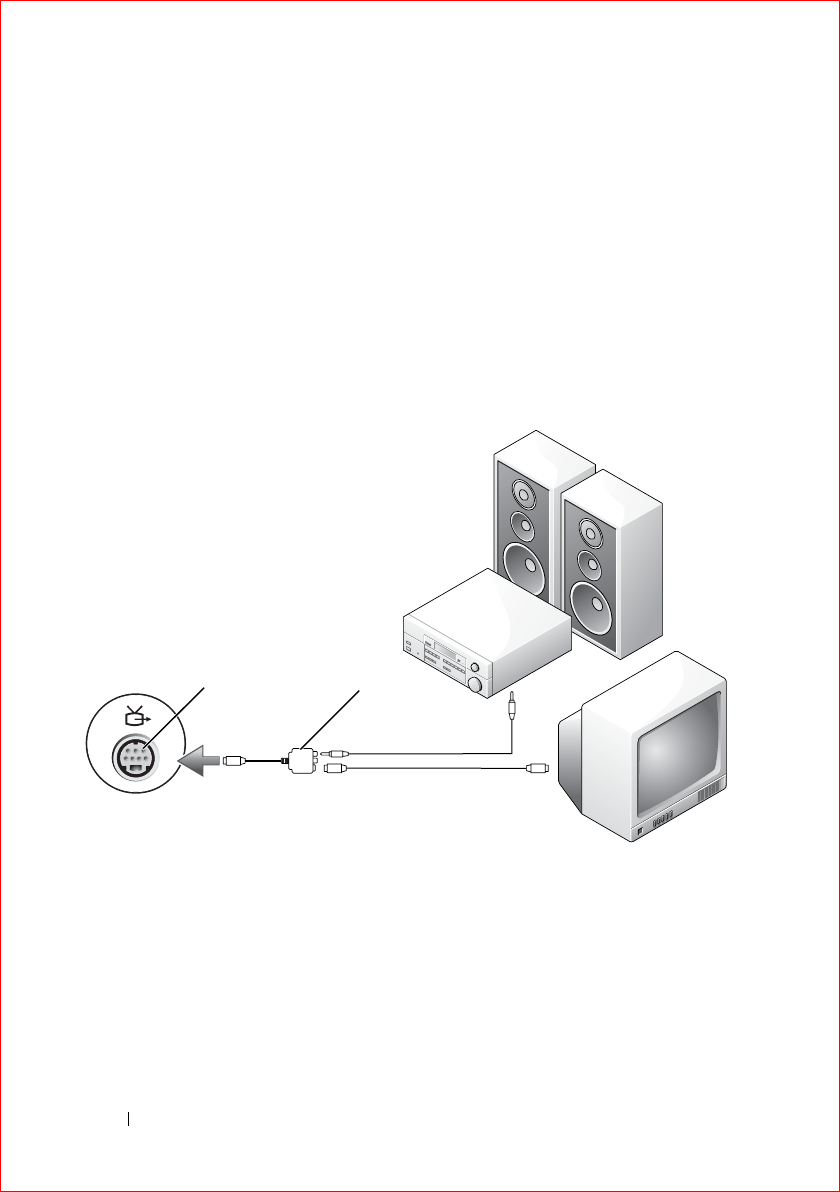
64 Using Multimedia
FILE LOCATION: S:\systems\Sapporo_Yebisu\Sapporo\OM\A00\EN\media.fm
DELL CONFIDENTIAL – PRELIMINARY 2/14/07 - FOR PROOF ONLY
4
Plug the single-connector end of the audio cable into the headphone
connector on your computer.
5
Plug the two RCA connectors on the other end of the audio cable into the
audio input connectors on your TV or other audio device.
6
Turn on the TV and any audio device that you connected (if applicable), and
then turn on the computer.
7
See "Enabling the Display Settings for a TV" on page 75 to ensure that the
computer recognizes and works properly with the TV.
S-Video and S/PDIF Digital Audio
1 S-video TV-out connector 2 composite video adapter
1 2
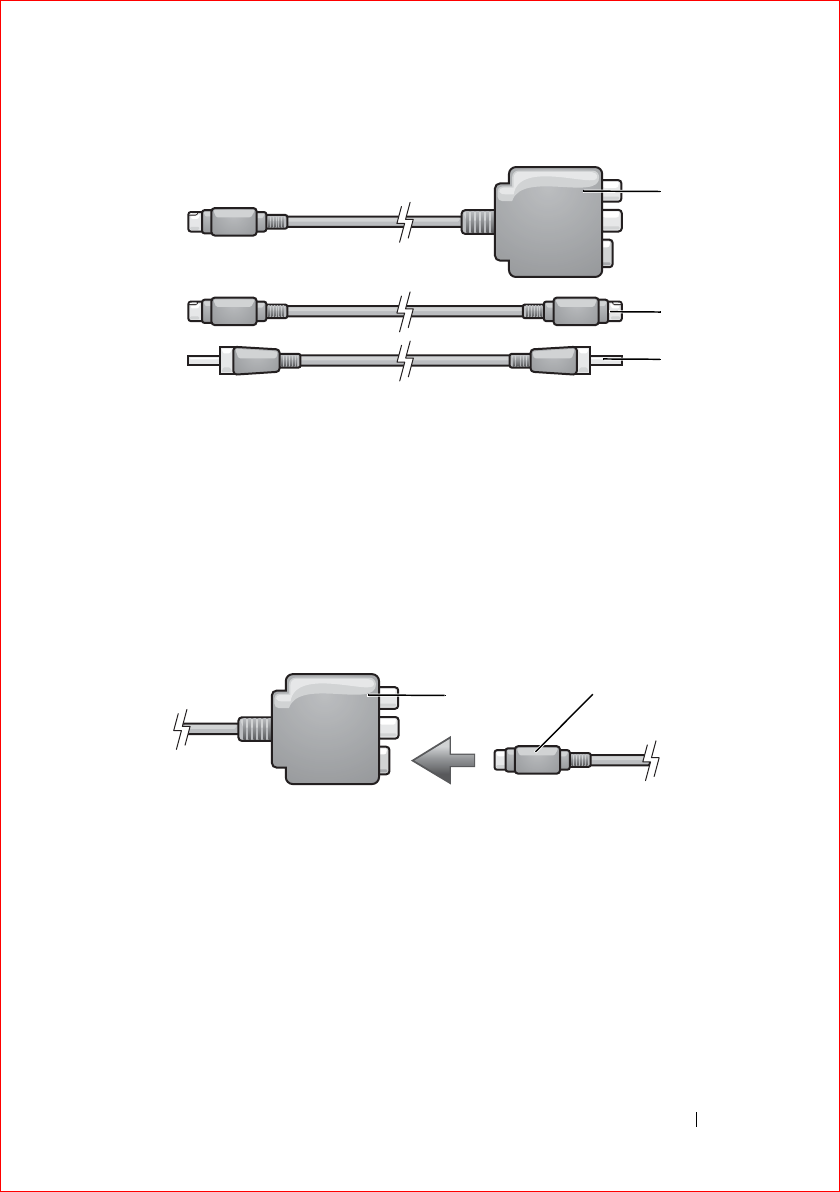
Using Multimedia 65
FILE LOCATION: S:\systems\Sapporo_Yebisu\Sapporo\OM\A00\EN\media.fm
DELL CONFIDENTIAL – PRELIMINARY 2/14/07 - FOR PROOF ONLY
1
Turn off the computer and the TV and/or the audio device that you want to
connect.
2
Connect the composite video adapter to the S-video TV-out connector on
your computer.
3
Plug one end of the S-video cable into the S-video output connector on the
composite video adapter.
4
Plug the other end of the S-video cable into the S-video input connector on
the TV.
5
Plug one end of the S/PDIF digital audio cable into the digital audio
connector on the composite video adapter cable.
1 composite video adapter 2 S-video cable
3 S/PDIF digital audio cable
1 composite video adapter 2 S-video cable
1
2
3
12
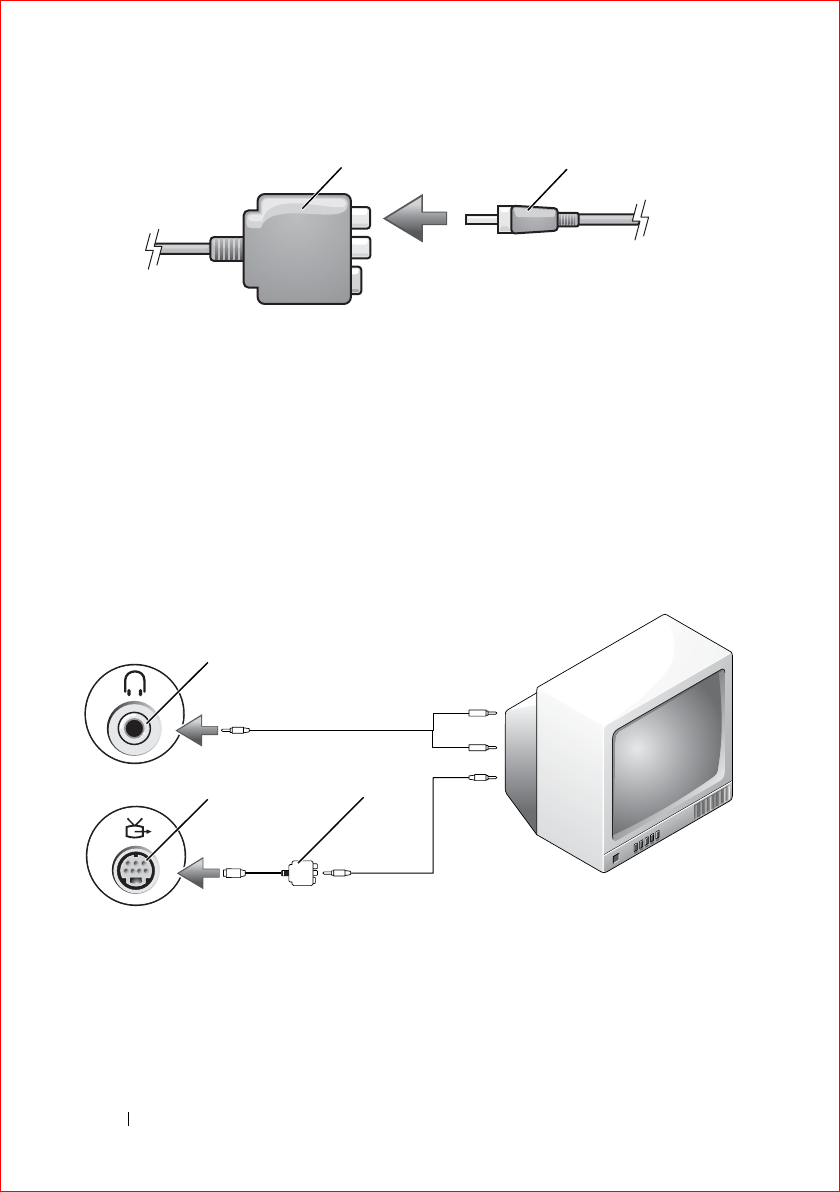
66 Using Multimedia
FILE LOCATION: S:\systems\Sapporo_Yebisu\Sapporo\OM\A00\EN\media.fm
DELL CONFIDENTIAL – PRELIMINARY 2/14/07 - FOR PROOF ONLY
6
Plug the other end of the S/PDIF digital audio cable into the audio input
connector on your TV or audio device.
7
Turn on the TV, turn on any audio device that you connected (if applicable),
and then turn on the computer.
8
See "Enabling the Display Settings for a TV" on page 75 to ensure that the
computer recognizes and works properly with the TV.
Composite Video and Standard Audio
1 composite video adapter 2 S/PDIF digital audio cable
1 audio input connector 2 S-video TV-out connector
3 composite video adapter
1 2
2
1
3
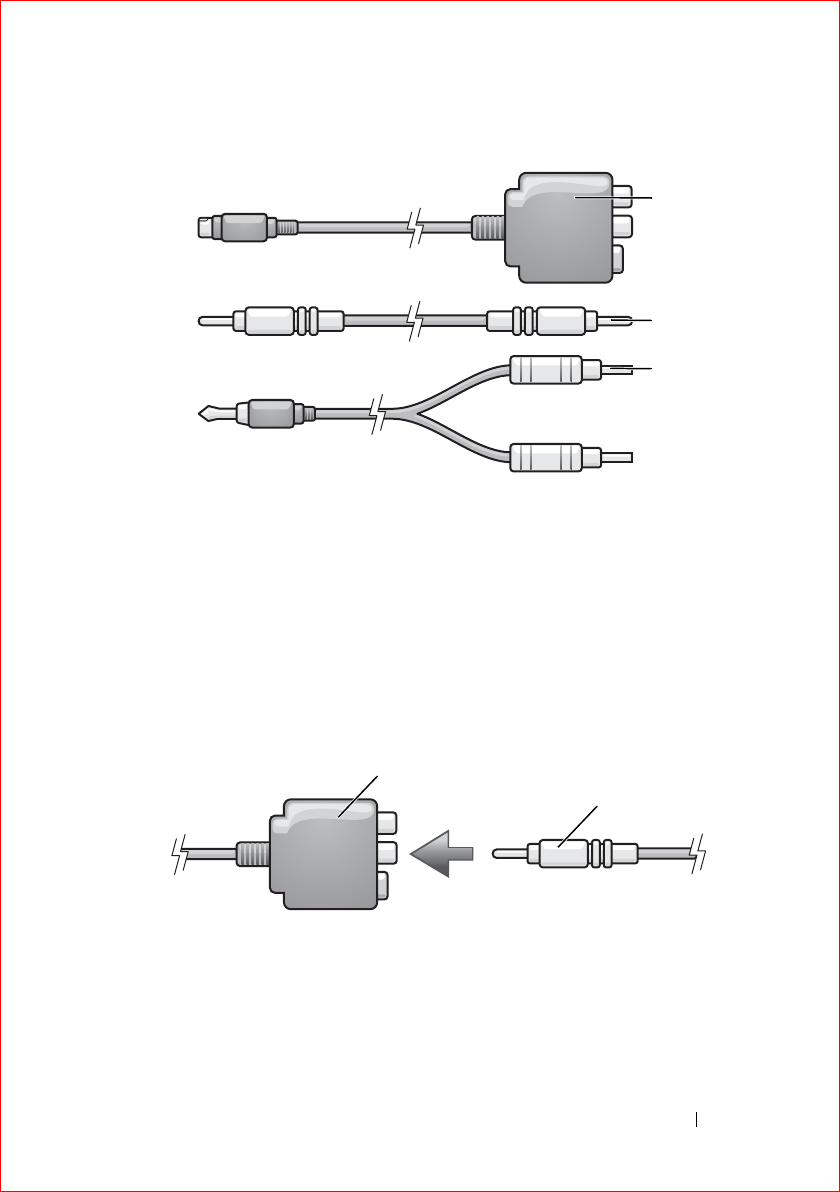
Using Multimedia 67
FILE LOCATION: S:\systems\Sapporo_Yebisu\Sapporo\OM\A00\EN\media.fm
DELL CONFIDENTIAL – PRELIMINARY 2/14/07 - FOR PROOF ONLY
1
Turn off the computer and the TV and/or audio device that you want to
connect.
2
Connect the composite video adapter to the S-video TV-out connector on
your computer.
3
Plug one end of the composite video cable into the composite video-output
connector on the composite video adapter.
4
Plug the other end of the composite video cable into the composite video-
input connector on the TV.
1 composite video adapter 2 composite video cable
3 standard audio cable
1 composite video adapter 2 composite video cable
1
2
3
2
1
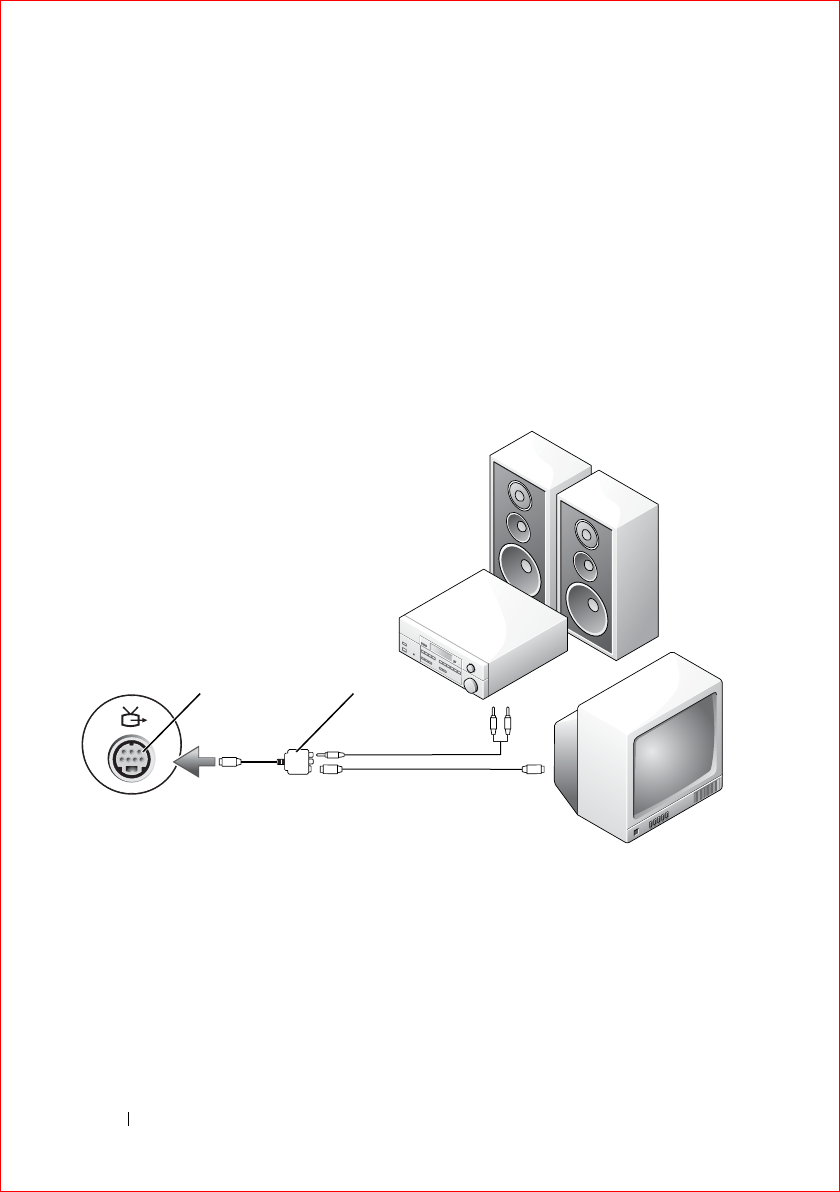
68 Using Multimedia
FILE LOCATION: S:\systems\Sapporo_Yebisu\Sapporo\OM\A00\EN\media.fm
DELL CONFIDENTIAL – PRELIMINARY 2/14/07 - FOR PROOF ONLY
5
Plug the single-connector end of the audio cable into the headphone
connector on the computer.
6
Plug the two RCA connectors on the other end of the audio cable into the
audio input connectors on your TV or other audio device.
7
Turn on the TV, turn on any audio device that you connected (if applicable),
and then turn on the computer.
8
See "Enabling the Display Settings for a TV" on page 75 to ensure that the
computer recognizes and works properly with the TV.
Composite Video and S/PDIF Digital Audio
1 S-video TV-out connector 2 composite video adapter
1 2
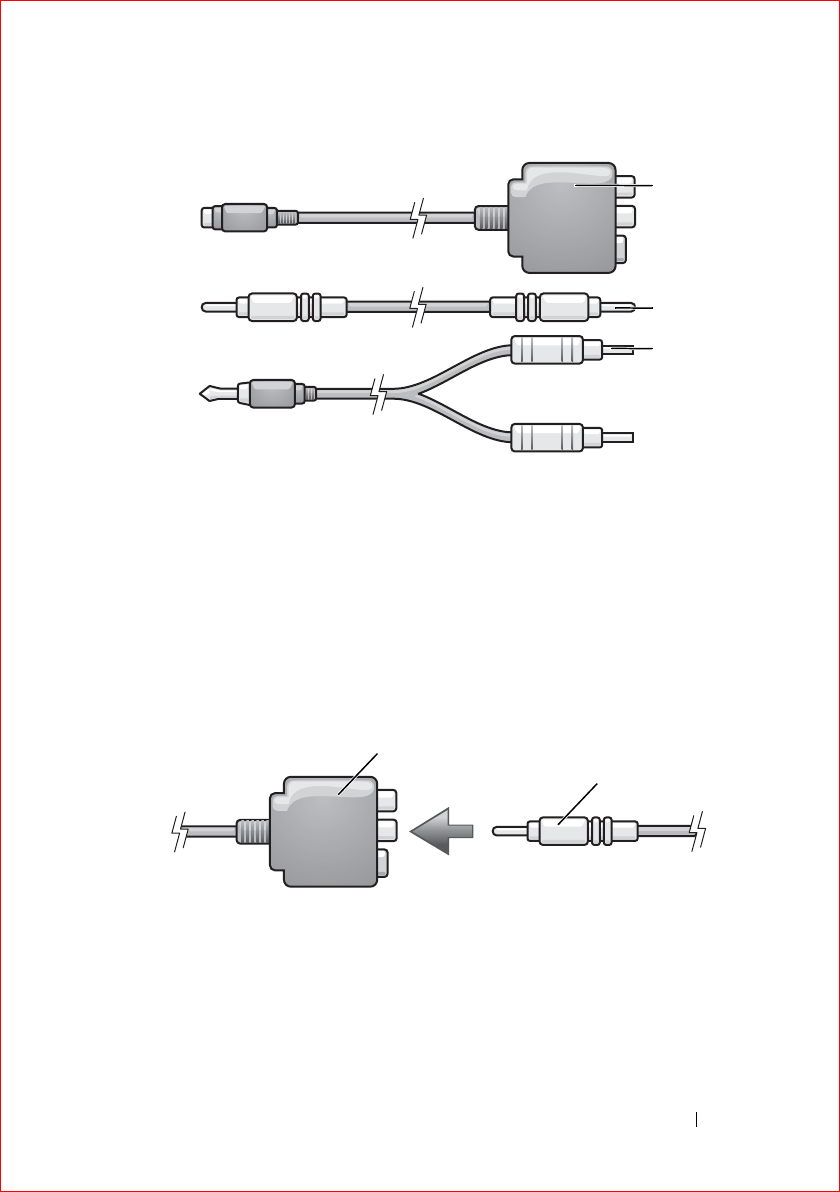
Using Multimedia 69
FILE LOCATION: S:\systems\Sapporo_Yebisu\Sapporo\OM\A00\EN\media.fm
DELL CONFIDENTIAL – PRELIMINARY 2/14/07 - FOR PROOF ONLY
1
Turn off the computer and the TV and/or audio device that you want to
connect.
2
Connect the composite video adapter to the S-video TV-out connector on the
computer.
3
Plug one end of the composite video cable into the composite video-input
connector on the composite video adapter.
4
Plug the other end of the composite video cable into the composite video-
input connector on the TV.
5
Plug one end of the S/PDIF digital audio cable into the S/PDIF audio
connector on the composite video adapter.
1 composite video adapter 2 composite video cable
3 standard audio cable
1 composite video adapter 2 composite video cable
1
2
3
2
1
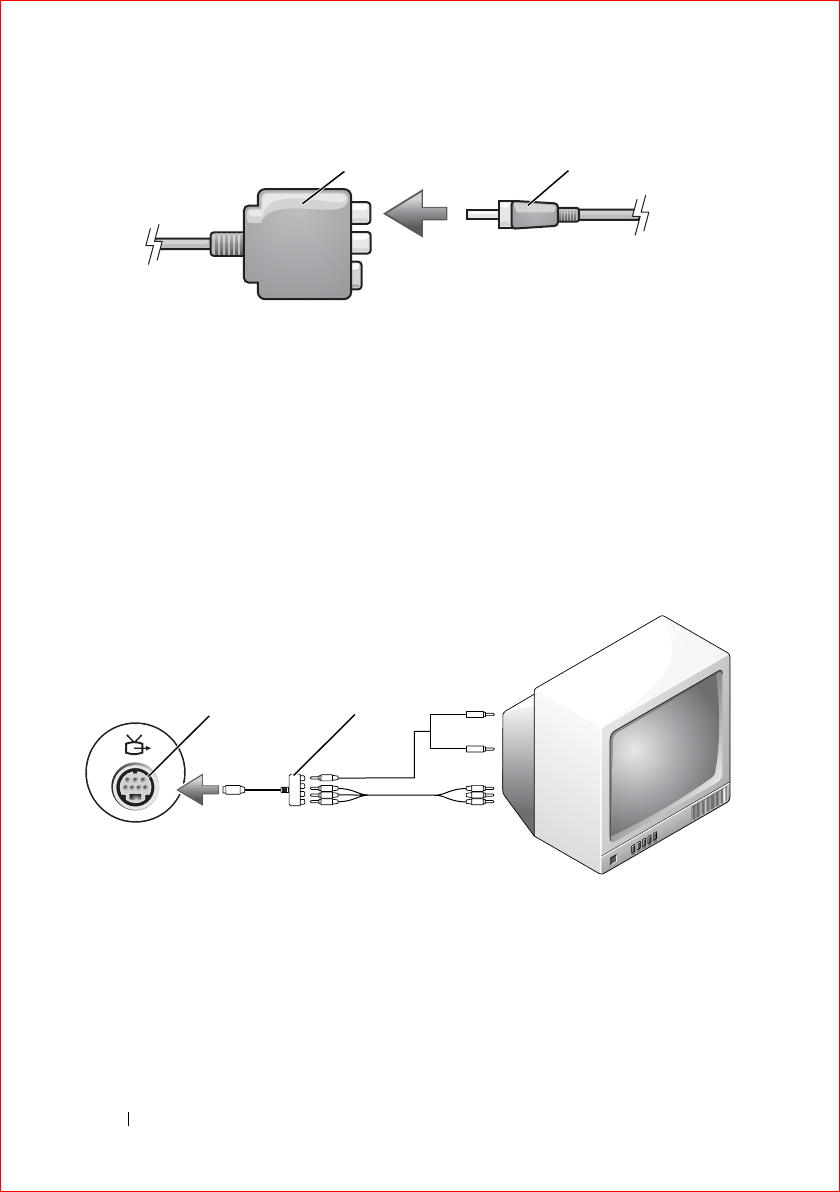
70 Using Multimedia
FILE LOCATION: S:\systems\Sapporo_Yebisu\Sapporo\OM\A00\EN\media.fm
DELL CONFIDENTIAL – PRELIMINARY 2/14/07 - FOR PROOF ONLY
6
Plug the other end of the digital audio cable into the S/PDIF input connector
on your TV or other audio device.
7
Turn on the TV, turn on any audio device that you connected (if applicable),
and then turn on the computer.
8
See "Enabling the Display Settings for a TV" on page 75 to ensure that the
computer recognizes and works properly with the TV.
Component Video and Standard Audio
1 composite video adapter 2 S/PDIF digital audio cable
1 S-video TV-out connector 2 component video adapter
1 2
2
1
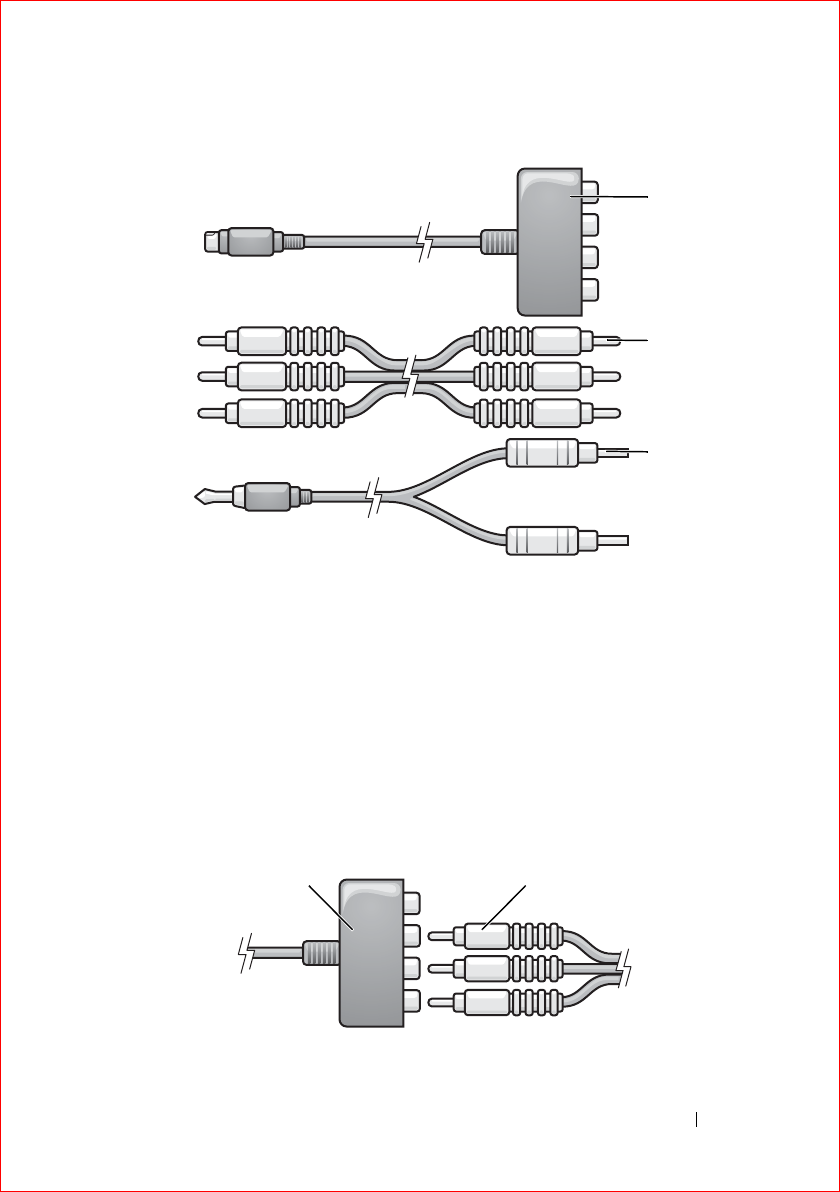
Using Multimedia 71
FILE LOCATION: S:\systems\Sapporo_Yebisu\Sapporo\OM\A00\EN\media.fm
DELL CONFIDENTIAL – PRELIMINARY 2/14/07 - FOR PROOF ONLY
1
Turn off the computer and the TV and/or audio device that you want to
connect.
2
Connect the component video adapter to the S-video TV-out connector on
your computer.
3
Plug all three ends of the component video cable into the component video-
output connectors on the component video adapter. Make sure that the red,
green, and blue colors of the cable match the corresponding adapter ports.
1 component video adapter 2 component video cable
3 standard audio cable
1
2
3
21
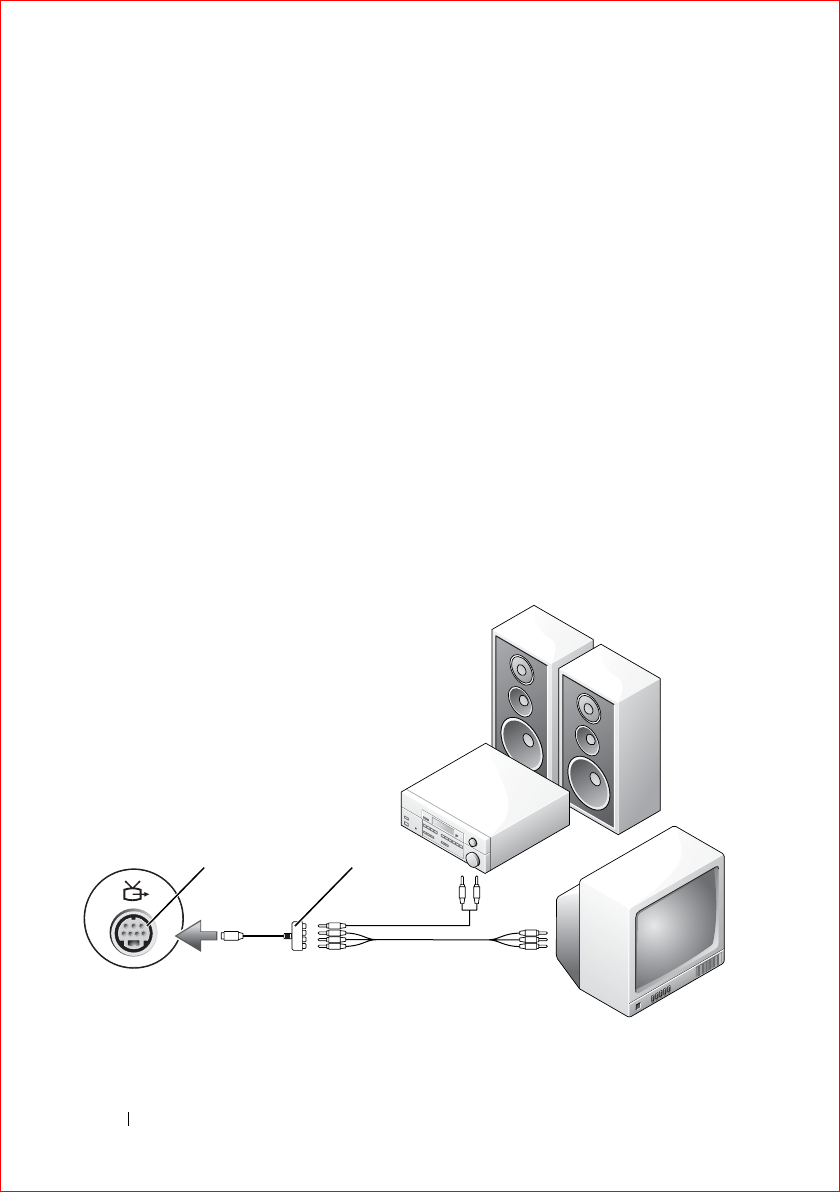
72 Using Multimedia
FILE LOCATION: S:\systems\Sapporo_Yebisu\Sapporo\OM\A00\EN\media.fm
DELL CONFIDENTIAL – PRELIMINARY 2/14/07 - FOR PROOF ONLY
4
Plug all three connectors from the other end of the component video cable
into the component video-input connectors on the TV. Make sure that the red,
green, and blue colors of the cable match the colors of the TV input
connectors.
5
Plug the single-connector end of the audio cable into the headphone
connector on the computer.
6
Plug the two RCA connectors on the other end of the audio cable into the
audio input connectors on your TV or audio device.
7
Turn on the TV, turn on any audio device that you connected (if applicable),
and then turn on the computer.
8
See "Enabling the Display Settings for a TV" on page 75 to ensure that the
computer recognizes and works properly with the TV.
Component Video and S/PDIF Digital Audio
1 component video adapter 2 component video cable
1 S-video TV-out connector 2 component video adapter
1 2
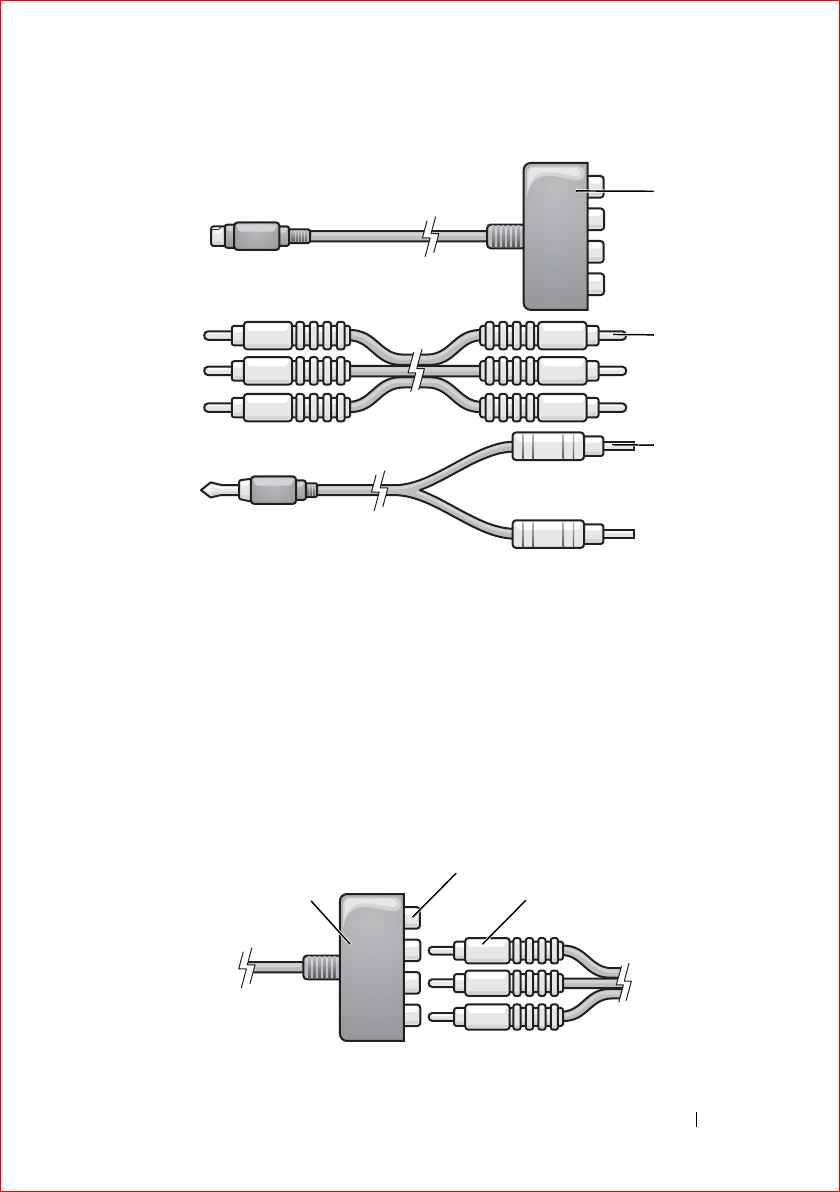
Using Multimedia 73
FILE LOCATION: S:\systems\Sapporo_Yebisu\Sapporo\OM\A00\EN\media.fm
DELL CONFIDENTIAL – PRELIMINARY 2/14/07 - FOR PROOF ONLY
1
Turn off the computer and the TV and/or audio device that you want to
connect.
2
Connect the component video adapter to the S-video TV-out connector on the
computer.
3
Plug all three ends of the component video cable into the component video-
output connectors on the component video adapter. Make sure that the red,
green, and blue colors of the cable match the corresponding adapter ports.
1 component video adapter 2 component video cable
3 standard audio cable
1
2
3
31
2
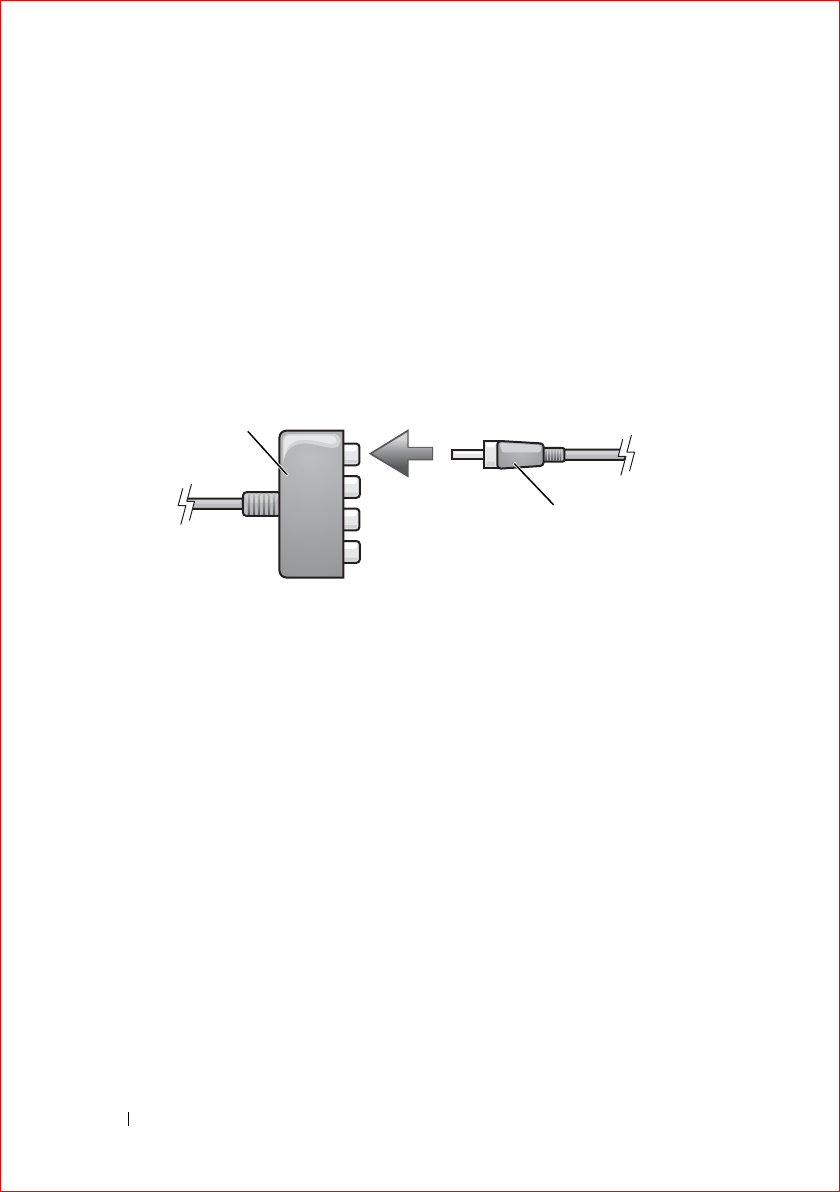
74 Using Multimedia
FILE LOCATION: S:\systems\Sapporo_Yebisu\Sapporo\OM\A00\EN\media.fm
DELL CONFIDENTIAL – PRELIMINARY 2/14/07 - FOR PROOF ONLY
4
Plug all three connectors from the other end of the component video cable
into the component video-input connectors on the TV. Make sure that the red,
green, and blue colors of the cable match the colors of the TV input
connectors.
5
Plug one end of the S/PDIF digital audio cable into the S/PDIF audio
connector on the component video adapter.
6
Plug the other end of the digital audio cable into the S/PDIF input connector
on your TV or other audio device.
7
Turn on the TV, turn on any audio device that you connected (if applicable),
and then turn on the computer.
8
See "Enabling the Display Settings for a TV" on page 75 to ensure that the
computer recognizes and works properly with the TV.
Enabling S/PDIF Digital Audio
1
Double-click the speaker icon in the Windows notification area.
2
Click the
Options
menu and then click
Advanced Controls
.
3
Click
Advanced
.
4
Click
S/PDIF Interface
.
5
Click
Close
.
6
Click
OK
.
1 component video adapter 2 component video-output connectors
3 component video cable
1 component video adapter 2 S/PDIF digital audio cable
2
1

Using Multimedia 75
FILE LOCATION: S:\systems\Sapporo_Yebisu\Sapporo\OM\A00\EN\media.fm
DELL CONFIDENTIAL – PRELIMINARY 2/14/07 - FOR PROOF ONLY
Enabling the Display Settings for a TV
NOTE: To ensure that the display options appear correctly, connect the TV to the
computer before you enable the display settings.
1
Click
Start
,
click
Control Panel
, and then click
Appearance and
Personalization
.
2
Under
Personalization
, click
Adjust Screen Resolution
.
The
Display Properties
window appears.
3
Click
Advanced
.
4
Click the tab for your video card.
NOTE: To determine the type of video card installed in your computer, see
Windows Help and Support. To access Help and Support, click Start
→
Help
and Support. Under Pick a Task, click Use Tools to view your computer information
and diagnose problems. Then, under My Computer Information, select Hardware.
5
In the display devices section, select the appropriate option for using either a
single display or multiple displays, ensuring that the display settings are
correct for your selection.

76 Using Multimedia
FILE LOCATION: S:\systems\Sapporo_Yebisu\Sapporo\OM\A00\EN\media.fm
DELL CONFIDENTIAL – PRELIMINARY 2/14/07 - FOR PROOF ONLY

Using Multimedia 77
FILE LOCATION: S:\systems\Sapporo_Yebisu\Sapporo\OM\A00\EN\media.fm
DELL CONFIDENTIAL – PRELIMINARY 2/14/07 - FOR PROOF ONLY

78 Using Multimedia
FILE LOCATION: S:\systems\Sapporo_Yebisu\Sapporo\OM\A00\EN\media.fm
DELL CONFIDENTIAL – PRELIMINARY 2/14/07 - FOR PROOF ONLY
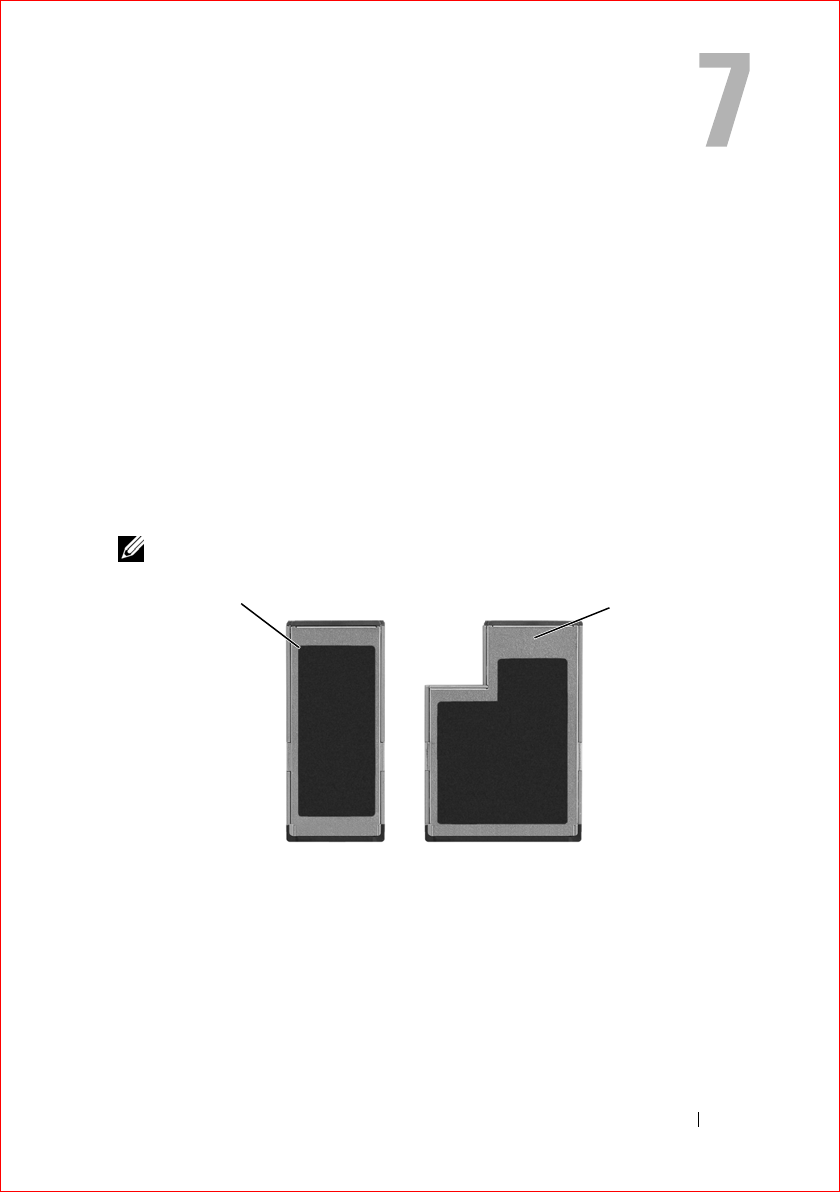
Template Last Updated - 2/7/2007 Using ExpressCards 79
DELL CONFIDENTIAL – PRELIMINARY 2/14/07 - FOR PROOF ONLY
Using ExpressCards
ExpressCards provide additional memory, wired and wireless communications,
multimedia and security features. For example, you can add an ExpressCard to
make wireless wide area network (WWAN) connectivity available on your
computer.
ExpressCards support two form factors:
• ExpressCard/34 (34 mm wide)
• ExpressCard/54 (54 mm wide in an L-shape with a 34 mm connector)
The 34 mm card fits into both the 34 mm and 54 mm card slots. The 54 mm card
only fits into a 54 mm card slot.
See "Specifications" on page 179 for information on supported ExpressCards.
NOTE: An ExpressCard is not a bootable device.
ExpressCard Blanks
Your computer shipped with a plastic blank installed in the ExpressCard slot.
Blanks protect unused slots from dust and other particles. Save the blank for use
when no ExpressCard is installed in the slot; blanks from other computers may
not fit your computer.
1 ExpressCard/34 2 ExpressCard/54
12
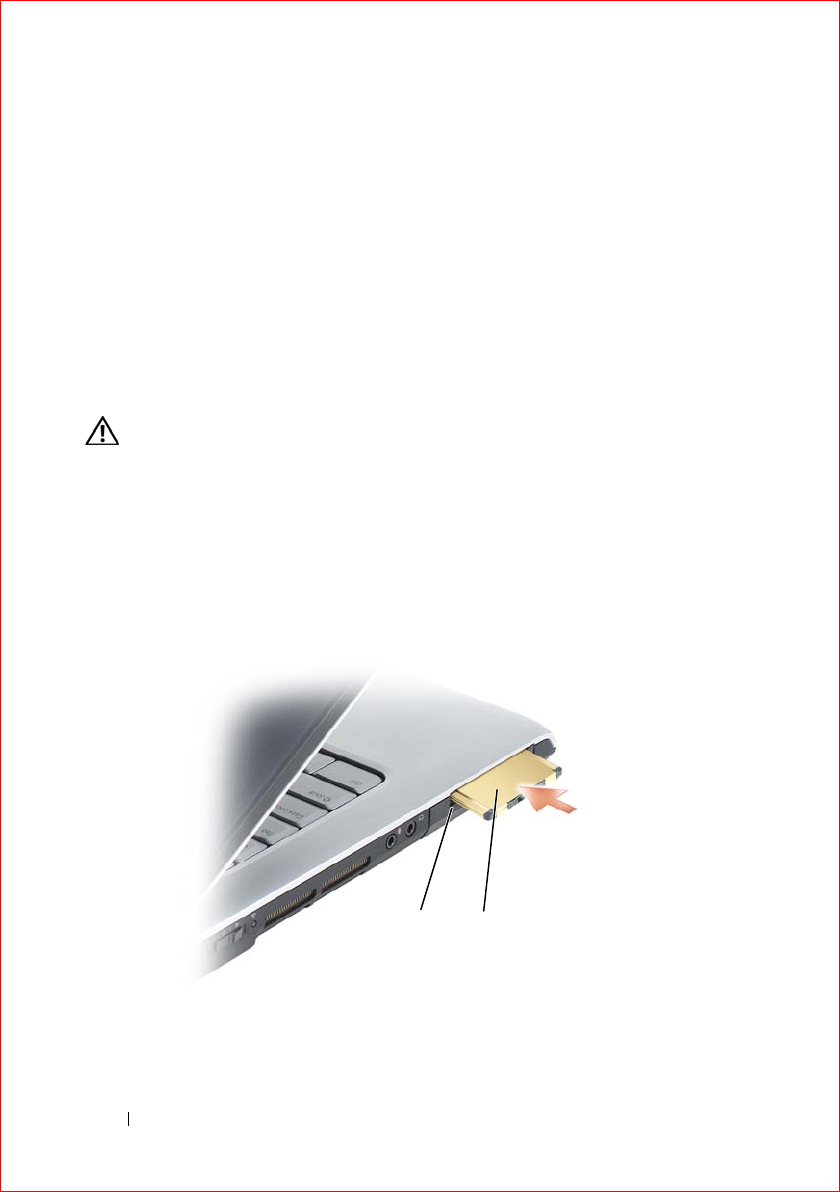
80 Using ExpressCards
FILE LOCATION: S:\systems\Sapporo_Yebisu\Sapporo\OM\A00\EN\cards.fm
DELL CONFIDENTIAL – PRELIMINARY 2/14/07 - FOR PROOF ONLY
Remove the blank before installing an ExpressCard. To remove the blank, see
"Removing an ExpressCard or Blank" on page 81.
Installing an ExpressCard
You can install an ExpressCard while the computer is running. The computer
automatically detects the card.
ExpressCards are generally marked with a symbol (such as a triangle or an
arrow) or a label to indicate which end to insert into the slot. The cards are
keyed to prevent incorrect insertion. If card orientation is not clear, see the
documentation that came with the card.
CAUTION: Before you begin any of the procedures in this section, follow the
safety instructions in the Product Information Guide.
To install an ExpressCard:
1
Hold the card with the top side of the card facing up.
2
Slide the card into the slot until the card is completely seated in its connector.
If you encounter too much resistance, do not force the card. Check the card
orientation and try again.
1 slot 2 ExpressCard
1 2
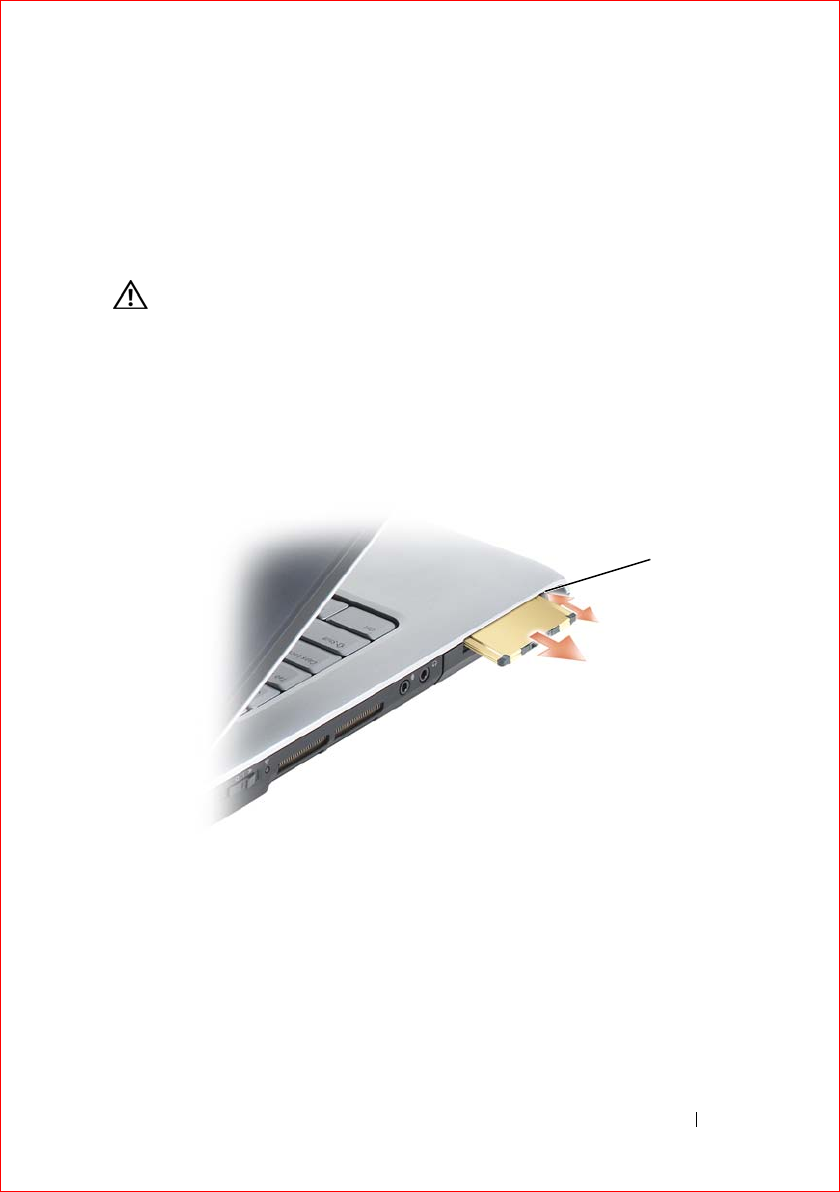
Using ExpressCards 81
FILE LOCATION: S:\systems\Sapporo_Yebisu\Sapporo\OM\A00\EN\cards.fm
DELL CONFIDENTIAL – PRELIMINARY 2/14/07 - FOR PROOF ONLY
The computer recognizes the ExpressCard and automatically loads the
appropriate device driver. If the configuration program tells you to load the
manufacturer's drivers, use the media that came with the ExpressCard.
Removing an ExpressCard or Blank
CAUTION: Before you begin any of the procedures in this section, follow the
safety instructions in the Product Information Guide.
Press the latch and remove the card or blank. For some latches, you must press
the latch twice, once to pop the latch out, and then a second time to pop the card
out.
Save a blank to use when no ExpressCard is installed in a slot. Blanks protect
unused slots from dust and other particles.
1 release button
1

82 Using ExpressCards
FILE LOCATION: S:\systems\Sapporo_Yebisu\Sapporo\OM\A00\EN\cards.fm
DELL CONFIDENTIAL – PRELIMINARY 2/14/07 - FOR PROOF ONLY

Template Last Updated - 2/7/2007 Using the Memory Card Reader 83
DELL CONFIDENTIAL – PRELIMINARY 2/14/07 - FOR PROOF ONLY
Using the Memory Card Reader
The memory card reader provides a fast and convenient way to view and share
digital photos, music, and videos stored on a memory card.
NOTE: A memory card is not a bootable device.
The 8-in-1 memory card reader reads the following memory cards:
• Secure Digital (SD)
•SDIO
• MultiMediaCard (MMC)
• Memory Stick
• Memory Stick PRO
• xD-Picture Card
• Hi Speed-SD
• Hi Density-SD
Memory Card Blanks
Your computer shipped with a plastic blank installed in the memory card reader.
Blanks protect unused slots from dust and other particles. Save the blank for use
when no media memory card is installed in the slot; blanks from other
computers may not fit your computer.
Remove the blank before installing a media memory card. To remove the blank,
see "Removing a Memory Card or Blank" on page 84.
Installing a Memory Card
You can install a media memory card in the computer while the computer is
running. The computer automatically detects the card.
Memory cards are generally marked with a symbol (such as a triangle or an
arrow) or a label to indicate which end to insert into the slot. The cards are
keyed to prevent incorrect insertion. If card orientation is not clear, see the
documentation that came with the card.
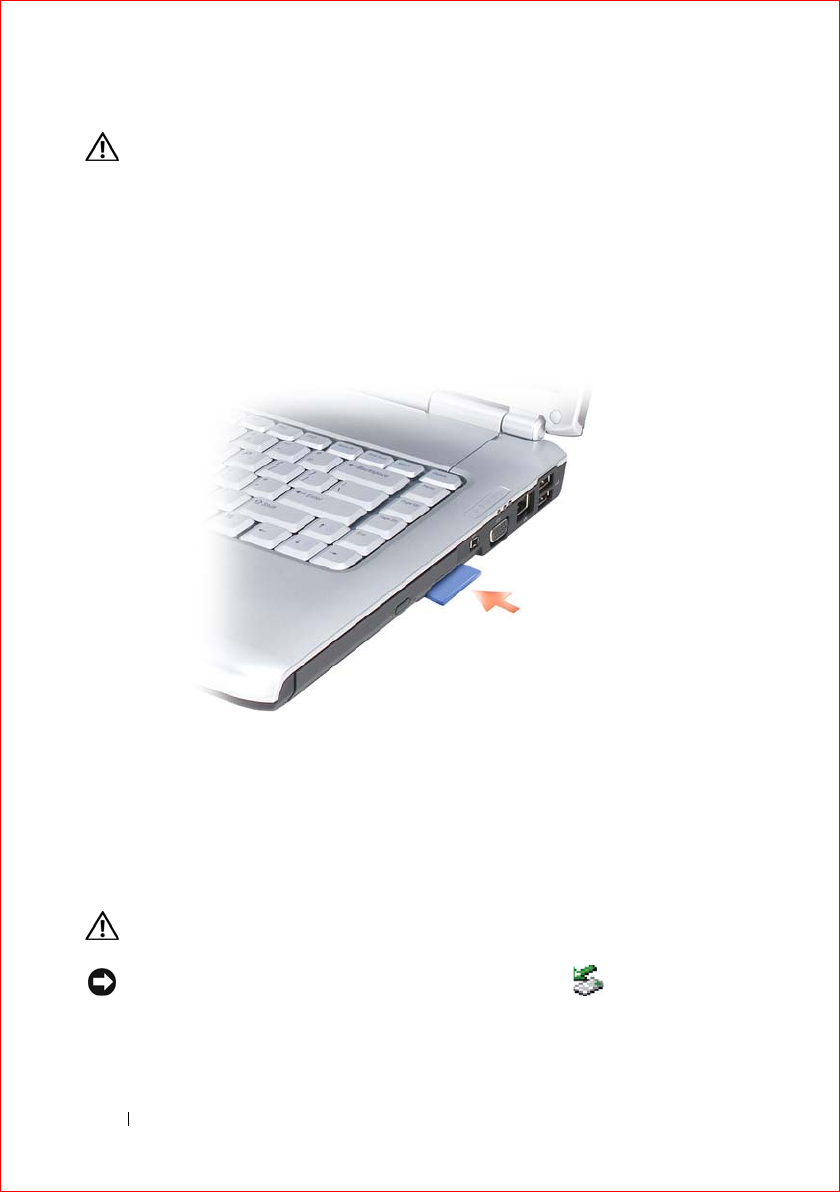
84 Using the Memory Card Reader
FILE LOCATION: S:\systems\Sapporo_Yebisu\Sapporo\OM\A00\EN\cardread.fm
DELL CONFIDENTIAL – PRELIMINARY 2/14/07 - FOR PROOF ONLY
CAUTION: Before you begin any of the procedures in this section, follow the
safety instructions in the Product Information Guide.
To install a memory card:
1
Hold the card with the top side of the card facing up.
2
Slide the card into the slot until the card is completely seated in its connector.
If you encounter too much resistance, do not force the card. Check the card
orientation and try again.
The computer recognizes the memory card and automatically loads the
appropriate device driver. If the configuration program tells you to load the
manufacturer's drivers, use the media that came with the memory card, if
applicable.
Removing a Memory Card or Blank
CAUTION: Before you begin any of the procedures in this section, follow the
safety instructions in the Product Information Guide.
NOTICE: Use the memory card configuration utility (click the icon in the
notification area) to select a card and stop it from functioning before you remove it
from the computer. If you do not stop the card in the configuration utility, you could
lose data.

Using the Memory Card Reader 85
FILE LOCATION: S:\systems\Sapporo_Yebisu\Sapporo\OM\A00\EN\cardread.fm
DELL CONFIDENTIAL – PRELIMINARY 2/14/07 - FOR PROOF ONLY
Press the card into the slot to release it from the card reader. When it is partially
ejected, remove the card.

86 Using the Memory Card Reader
FILE LOCATION: S:\systems\Sapporo_Yebisu\Sapporo\OM\A00\EN\cardread.fm
DELL CONFIDENTIAL – PRELIMINARY 2/14/07 - FOR PROOF ONLY

Template Last Updated - 2/7/2007 Setting Up and Using Networks 87
DELL CONFIDENTIAL – PRELIMINARY 2/14/07 - FOR PROOF ONLY
Setting Up and Using Networks
Setting up a computer network provides connectivity between your computer
and the Internet, another computer, or a network. For example, with a network
set up in a home or small office you can print to a shared printer, access drives
and files on another computer, browse other networks, or access the Internet.
You can set up a local area network (LAN) using a network or broadband
modem cable or set up a wireless LAN (WLAN).
The Microsoft® Windows Vista™ operating system provides a wizard to help
guide you through the process of networking computers. For more information
about Networking, access Windows Help and Support (click
Start
,
and then
click
Help and Support).
Connecting a Network or Broadband Modem
Cable
Before you connect your computer to a network, the computer must have a
network adapter installed and a network cable connected to it.
1
Connect the network cable to the network adapter connector on the back of
your computer.
NOTE: Insert the cable connector until it clicks into place, and then gently
pull on the cable to ensure that it is securely attached.
2
Connect the other end of the network cable to a network connection device or
a network wall connector.
NOTE: Do not use a network cable with a telephone wall connector.
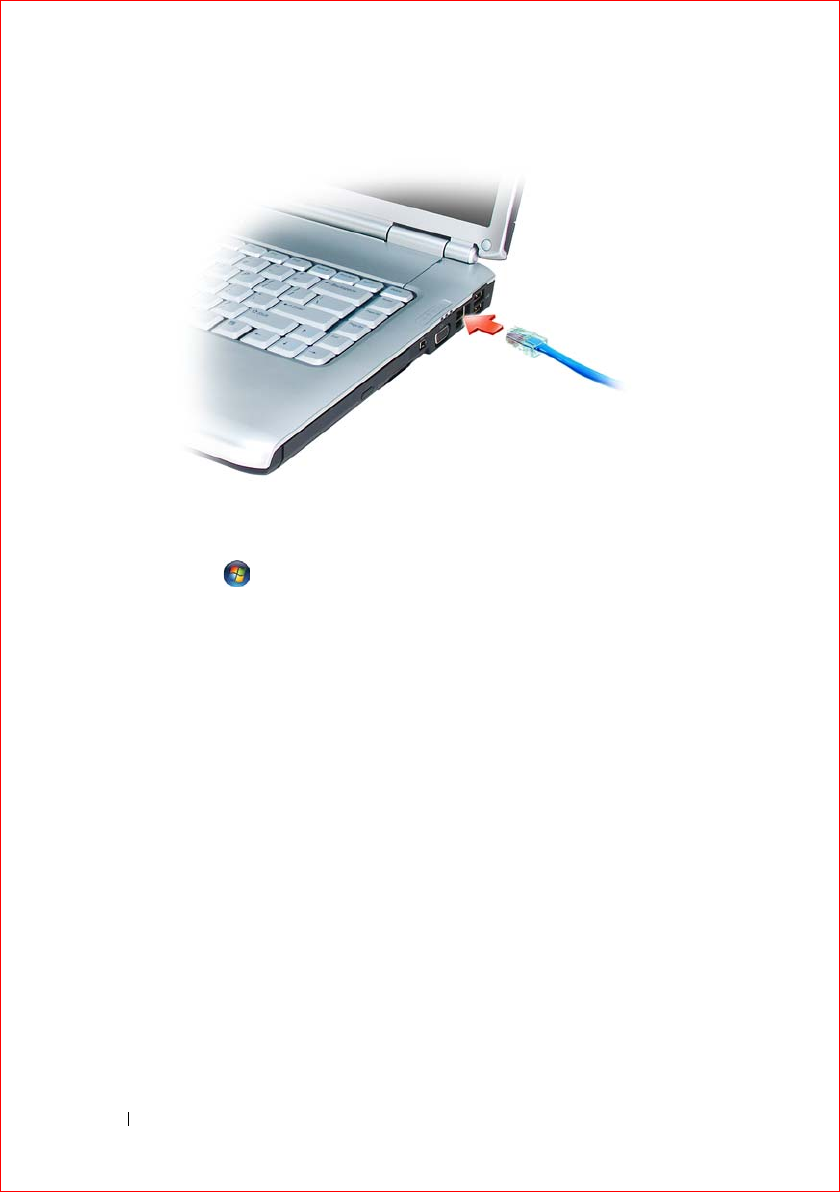
88 Setting Up and Using Networks
FILE LOCATION: S:\systems\Sapporo_Yebisu\Sapporo\OM\A00\EN\wireless.fm
DELL CONFIDENTIAL – PRELIMINARY 2/14/07 - FOR PROOF ONLY
Setting Up a Network
1
Click
Start
, and then click
Connect To
.
2
Click
Set up a connection or network
.
3
Select an option under
Choose a connection option
.
4
Click
Next
, and then follow the instructions in the wizard.
Wireless Local Area Network
A wireless local area network (WLAN) is a series of interconnected computers
that communicate with each other over the air waves rather than through a
network cable connected to each computer. In a WLAN, a radio
communications device called an access point or wireless router connects
network computers and provides Internet, or network access. The access point
or wireless router and the wireless network card in the computer communicate
by broadcasting data from their antennas over the air waves.
What You Need to Establish a WLAN Connection
Before you can set up a WLAN, you need:
• High-speed (broadband) Internet access (such as cable or DSL)
• A broadband modem that is connected and working

Setting Up and Using Networks 89
FILE LOCATION: S:\systems\Sapporo_Yebisu\Sapporo\OM\A00\EN\wireless.fm
DELL CONFIDENTIAL – PRELIMINARY 2/14/07 - FOR PROOF ONLY
• A wireless router or access point
• A wireless network card for each computer that you want to connect to your
WLAN
• A network cable with a network (RJ-45) connector
Checking Your Wireless Network Card
Depending on what you selected when you purchased your computer, the
computer has a variety of configurations. To confirm that your computer has a
wireless network card and to determine the type of card:
•Use the
Start
button and
Connect To
option
• Check the order confirmation for your computer
Start Button and Connect To Option
1
Click
Start
, and then click
Connect To
.
2
Click
Open Network and Sharing Center
.
If Wireless Network Connection does not appear, you may not have a wireless
network card.
If Wireless Network Connection appears, you have a wireless network card. To
view detailed information about the wireless network card:
1
Right-click
Wireless Network Connection
.
2
Click
Properties
.
The
Wireless Network Connection Properties
window appears. The
wireless network card’s name and model number are listed on the
General
tab.
The Order Confirmation for Your Computer
The order confirmation that you received when you ordered your computer lists
the hardware and software that shipped with your computer.
Setting Up a New WLAN Using a Wireless Router and a Broadband
Modem
1
Contact your Internet service provider (ISP) to obtain specific information
about the connection requirements for your broadband modem.

90 Setting Up and Using Networks
FILE LOCATION: S:\systems\Sapporo_Yebisu\Sapporo\OM\A00\EN\wireless.fm
DELL CONFIDENTIAL – PRELIMINARY 2/14/07 - FOR PROOF ONLY
2
Ensure that you have wired Internet access through your broadband modem
before you attempt to set up a wireless Internet connection (see "Connecting
a Network or Broadband Modem Cable" on page 87).
3
Install any software required for your wireless router. Your wireless router
may have been shipped with installation media. Installation media usually
contains installation and troubleshooting information. Install the required
software according to the instructions provided by the router manufacturer.
4
Shut down your computer and any other wireless-enabled computers in the
vicinity through the Windows Vista Start button .
5
Disconnect your broadband modem power cable from the electrical outlet.
6
Disconnect the network cable from the computer and the modem.
7
Disconnect the AC adapter cable from your wireless router to ensure that
there is no power connected to the router.
NOTE: Wait for a minimum of 5 minutes after disconnecting your broadband
modem before continuing with the network setup.
8
Insert a network cable into the network (RJ-45) connector on the unpowered
broadband modem.
9
Connect the other end of the network cable into the Internet network (RJ-45)
connector on the unpowered wireless router.
10
Ensure that no network or USB cables, other than the network cable
connecting the modem and the wireless router, are connected to the
broadband modem.
NOTE: Restart your wireless equipment in the order described below to prevent a
potential connection failure.
11
Turn on
only
your broadband modem and wait for at least 2 minutes for the
broadband modem to stabilize. After 2 minutes, proceed to step 12.
12
Turn on your wireless router and wait for at least 2 minutes for the wireless
router to stabilize. After 2 minutes, proceed to the step 13.
13
Start your computer and wait until the boot process completes.
14
See the documentation that came with your wireless router to do the
following in order to set up the wireless router:
• Establish communication between your computer and your wireless
router.

Setting Up and Using Networks 91
FILE LOCATION: S:\systems\Sapporo_Yebisu\Sapporo\OM\A00\EN\wireless.fm
DELL CONFIDENTIAL – PRELIMINARY 2/14/07 - FOR PROOF ONLY
• Configure your wireless router to communicate with your broadband
router.
• Find out your wireless router’s broadcast name. The technical term for
the name of your router’s broadcast name is Service Set Identifier
(SSID) or network name.
15
If necessary, configure your wireless network card to connect to the wireless
network (see "Connecting to a WLAN" on page 91).
Connecting to a WLAN
NOTE: Before you connect to a WLAN, ensure that you have followed the
instructions in "Wireless Local Area Network" on page 88.
NOTE: The following networking instructions do not apply to internal cards with
Bluetooth® wireless technology or cellular products.
This section provides general procedures for connecting to a network using
wireless technology. Specific network names and configuration details vary. See
"Wireless Local Area Network" on page 88 for more information about how to
prepare for connecting your computer to a WLAN.
Your wireless network card requires specific software and drivers for connecting
to a network. The software is already installed.
NOTE: If the software is removed or corrupted, follow the instructions in the user
documentation for your wireless network card. Verify the type of wireless network
card installed in your computer and then search for that name on the Dell™ Support
website at support.dell.com. For information on the type of wireless network card
that is installed in your computer, see "Checking Your Wireless Network Card" on
page 89.
Determining the Wireless Network Device Manager
Depending on the software installed on your computer, different wireless
configuration utilities may manage your network devices:
• Your wireless network card’s client utility
• The Microsoft Windows Vista operating system
To determine which wireless configuration utility is managing your wireless
network card:
1
Click
Start
, and then click
Connect To
.
2
Click
Open Network and Sharing Center
.

92 Setting Up and Using Networks
FILE LOCATION: S:\systems\Sapporo_Yebisu\Sapporo\OM\A00\EN\wireless.fm
DELL CONFIDENTIAL – PRELIMINARY 2/14/07 - FOR PROOF ONLY
3
Double-click a profile to open the wireless network properties screen.
For specific information about the wireless configuration utility installed on
your computer, see your wireless network documentation in Windows Help and
Support (click
Start
, and then click
Help and Support).
Completing the Connection to the WLAN
When you turn on your computer and a network (for which your computer is not
configured) is detected in the area, a pop-up appears near the network icon in the
Windows notification area.
Follow the instructions provided in any utility prompts that appear on your
screen.
Once you have configured your computer for the wireless network that you
selected, another pop-up notifies you that your computer is connected to that
network.
Thereafter, whenever you log on to your computer within the range of the
wireless network that you selected, the same pop-up notifies you of the wireless
network connection.
NOTE: If you select a secure network, you must enter a WEP or WPA key when
prompted. Network security settings are unique to your network. Dell cannot
provide this information.
NOTE: Your computer can take up to 1 minute to connect to the network.
Monitoring the Status of the Wireless Network Card Through Dell QuickSet
The wireless activity indicator provides you with an easy way to monitor the
status of your computer’s wireless devices. To turn the wireless activity
indicator on or off, click the QuickSet icon in the taskbar and select Hotkey
Popups. If Wireless Activity Indicator Off is not checked, the indicator is on.
If Wireless Activity Indicator Off is checked, the indicator is off.
The wireless activity indicator displays whether your computer’s integrated
wireless devices are enabled or disabled. When you turn the wireless
networking function on or off, the wireless activity indicator changes to display
the status.
For more information about the Dell QuickSet wireless activity indicator, right-
click the QuickSet icon in the taskbar, and then select Help.

Setting Up and Using Networks 93
FILE LOCATION: S:\systems\Sapporo_Yebisu\Sapporo\OM\A00\EN\wireless.fm
DELL CONFIDENTIAL – PRELIMINARY 2/14/07 - FOR PROOF ONLY
Mobile Broadband (or Wireless Wide Area
Network)
A Mobile Broadband network, also known as a Wireless Wide Area Network
(WWAN), is a high-speed digital cellular network that provides Internet access
over a much wider geographical area than a WLAN, which typically covers only
from 100 to 1000 feet. Your computer can maintain Mobile Broadband network
access as long as the computer is within a cellular-data coverage zone. Contact
your service provider for coverage of a high-speed digital cellular network.
NOTE: Even if you are able to make a call from your cellular phone in a specific
geographical location, that location may not necessarily be within a cellular-data
coverage zone.
What You Need to Establish a Mobile Broadband Network Connection
NOTE: Depending on your computer, you can use either a Mobile Broadband
ExpressCard or Mini Card, but not both, to establish a Mobile Broadband network
connection.
To set up a Mobile Broadband network connection, you need:
• A Mobile Broadband ExpressCard or Mini Card (depending on your
computer’s configuration)
NOTE: For instructions on using ExpressCards, see "Using ExpressCards" on
page 79.
• An activated Mobile Broadband ExpressCard or activated Subscriber
Identity Module (SIM) for your service provider
• The Dell Mobile Broadband Card Utility (already installed on your computer
if you purchased the card when you purchased your computer, or on the
media that accompanied your card if purchased separately from your
computer)
If the utility is corrupted or deleted from your computer, see the Dell Mobile
Broadband Card Utility user’s guide in Windows Help and Support
(click
Start
, and then click
Help and Support)
or on the media that
accompanied your card if you purchased it separately from your computer.

94 Setting Up and Using Networks
FILE LOCATION: S:\systems\Sapporo_Yebisu\Sapporo\OM\A00\EN\wireless.fm
DELL CONFIDENTIAL – PRELIMINARY 2/14/07 - FOR PROOF ONLY
Checking Your Dell Mobile Broadband Card
Depending on what you selected when you purchased your computer, the
computer has a variety of configurations. To determine your computer
configuration, see one of the following:
• Your order confirmation
• Microsoft Windows Help and Support
To check your Mobile Broadband card in Windows Help and Support:
1
Click
Start →
Help and Support
→
Use Tools to view your computer
information and diagnose problems
.
2
Under
Tools
, click
My Computer Information
→
Find information about
the hardware installed on this computer.
On the My Computer Information - Hardware screen, you can view the type
of Mobile Broadband card installed in your computer as well as other hardware
components.
NOTE: The Mobile Broadband card is listed under Modems.
Connecting to a Mobile Broadband Network
NOTE: These instructions only apply to Mobile Broadband ExpressCards or Mini-
Cards. They do not apply to internal cards with wireless technology.
NOTE: Before you connect to the Internet, you must activate Mobile Broadband
service through your cellular service provider. For instructions and for additional
information about using the Dell Mobile Broadband Card Utility, see the user's guide
available through Windows Help and Support (click Start , and then click Help
and Support). The user's guide is also available on the Dell Support website at
support.dell.com and on the media included with your Mobile Broadband card if
you purchased the card separately from your computer.
Use the Dell Mobile Broadband Card Utility to establish and manage a Mobile
Broadband network connection to the Internet:
1
Click the
Dell Mobile Broadband Card Utility icon
in the Windows
notification area to run the utility.
2
Click
Connect
.
NOTE: The Connect button changes to the Disconnect button.
3
Follow the instructions on the screen to manage the network connection with
the utility.

Setting Up and Using Networks 95
FILE LOCATION: S:\systems\Sapporo_Yebisu\Sapporo\OM\A00\EN\wireless.fm
DELL CONFIDENTIAL – PRELIMINARY 2/14/07 - FOR PROOF ONLY
or
1
Click
Start →
All Programs
→
Dell Wireless
.
2
Click
Dell Wireless Broadband
and follow the instructions on the screen.
Enabling/Disabling the Dell Mobile Broadband Card
NOTE: If you are unable to connect to a Mobile Broadband network, ensure that
you have all the components for establishing a Mobile Broadband connection (see
"What You Need to Establish a Mobile Broadband Network Connection" on page 93),
and then verify that your Mobile Broadband card is enabled by verifying the setting
of the wireless switch.
You can turn your Mobile Broadband card on and off using the wireless switch
on your computer.
You can turn your computer’s wireless devices on and off with the wireless
switch on the left side of the computer (see "Left Side View" on page 25).
If the switch is in the on position, move the switch to the off position to disable
the switch and the Mobile Broadband card. If the switch is in the off position,
move the switch to the on position to enable the switch and the Dell Mobile
Broadband card. For information about the wireless switch positions, see
"wireless switch" on page 25.
To monitor the status of your wireless device, see "Monitoring the Status of the
Wireless Network Card Through Dell QuickSet" on page 92.
Dell Wi-Fi Catcher™ Network Locator
The wireless switch on your Dell computer uses the Dell Wi-Fi Catcher
Network Locator to scan specifically for wireless networks in your vicinity.
To scan for a wireless network, slide and hold the wireless switch (see "wireless
switch" on page 25) in the momentary position for a few seconds. The Wi-Fi
Catcher Network Locator functions regardless of whether your computer is
turned on or off, or in Sleep state, as long as the switch is configured through
Dell QuickSet or the BIOS (system setup program) to control WiFi network
connections.
Because the Wi-Fi Catcher Network Locator is disabled and not configured for
use when your computer is shipped to you, you must first use Dell QuickSet to
enable and configure the switch to control WiFi network connections. For more

96 Setting Up and Using Networks
FILE LOCATION: S:\systems\Sapporo_Yebisu\Sapporo\OM\A00\EN\wireless.fm
DELL CONFIDENTIAL – PRELIMINARY 2/14/07 - FOR PROOF ONLY
information on the Wi-Fi Catcher Network Locator and to enable the feature
through Dell QuickSet, right-click the QuickSet icon in the notification area,
and then select Help.
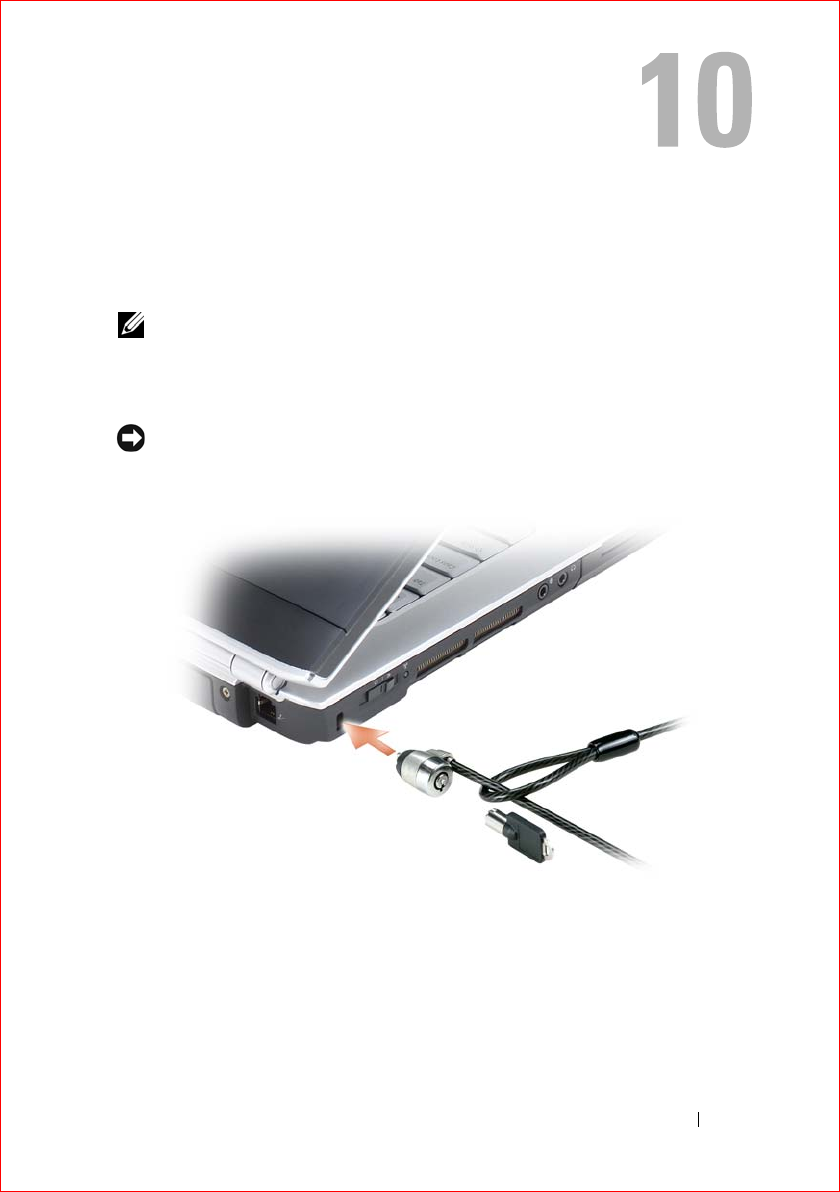
Template Last Updated - 2/7/2007 Securing Your Computer 97
DELL CONFIDENTIAL – PRELIMINARY 2/14/07 - FOR PROOF ONLY
Securing Your Computer
Security Cable Lock
NOTE: Your computer does not ship with a security cable lock.
A security cable lock is a commercially available antitheft device. To use the
lock, attach it to the security cable slot on your Dell computer. For more
information, see the instructions included with the device.
NOTICE: Before you buy an antitheft device, ensure that it will work with the
security cable slot on your computer.
Passwords
Passwords prevent unauthorized access to your computer. When you first start
your computer, you must assign a primary password at the prompt. If you do not
enter a password within 2 minutes, the computer returns to its previous
operating state.

98 Securing Your Computer
FILE LOCATION: S:\systems\Sapporo_Yebisu\Sapporo\OM\A00\EN\security.fm
DELL CONFIDENTIAL – PRELIMINARY 2/14/07 - FOR PROOF ONLY
When using passwords, observe the following guidelines:
• Choose a password that you can remember, but not one that is easy to guess.
For example, do not use the names of family members or pets for passwords.
• It is recommended that you do not write down your password. If you do write
it down, however, ensure that the password is stored in a secure location.
• Do not share your password with other people.
• Ensure that people are not watching you when you type your password.
NOTICE: Passwords provide a high level of security for data in your computer or
hard drive. However, they are not foolproof. If you require more security, obtain and
use additional forms of protection such as data encryption programs.
Use the User Accounts option in the Control Panel in the Microsoft®
Windows® operating system to create user accounts or to change passwords.
Once you create a user password, you must enter it each time you turn on or
unlock your computer. If you do not enter a password within 2 minutes, the
computer returns to its previous operating state. For more information, see your
Windows documentation.
If you forget any of your passwords, contact Dell (see "Contacting Dell" on
page 177). For your protection, Dell technical support staff will ask you for
proof of your identity to ensure that only an authorized person can use the
computer.
If Your Computer Is Lost or Stolen
• Call a law enforcement agency to report the lost or stolen computer. Include
the Service Tag in your description of the computer. Ask that a case number
be assigned and write down the number, along with the name, address, and
phone number of the law enforcement agency. If possible, obtain the name of
the investigating officer.
NOTE: If you know where the computer was lost or stolen, call a law enforcement
agency in that area. If you do not know, call a law enforcement agency where you
live.
• If the computer belongs to a company, notify the security office of the
company.

Securing Your Computer 99
FILE LOCATION: S:\systems\Sapporo_Yebisu\Sapporo\OM\A00\EN\security.fm
DELL CONFIDENTIAL – PRELIMINARY 2/14/07 - FOR PROOF ONLY
• Contact Dell customer service to report the missing computer. Provide the
computer Service Tag, the case number, and the name, address, and phone
number of the law enforcement agency to which you reported the missing
computer. If possible, give the name of the investigating officer.
The Dell customer service representative will log your report under the
computer Service Tag and record the computer as missing or stolen. If someone
calls Dell for technical assistance and gives your Service Tag, the computer is
identified automatically as missing or stolen. The representative will attempt to
get the phone number and address of the caller. Dell will then contact the law
enforcement agency to which you reported the missing computer.

100 Securing Your Computer
FILE LOCATION: S:\systems\Sapporo_Yebisu\Sapporo\OM\A00\EN\security.fm
DELL CONFIDENTIAL – PRELIMINARY 2/14/07 - FOR PROOF ONLY

Template Last Updated - 2/7/2007 Troubleshooting 101
DELL CONFIDENTIAL – PRELIMINARY 2/14/07 - FOR PROOF ONLY
Troubleshooting
Dell Technical Update Service
The Dell Technical Update service provides proactive e-mail notification of
software and hardware updates for your computer. The service is free and can be
customized for content, format, and how frequently you receive notifications.
To enroll for the Dell Technical Update service, go to
support.dell.com/technicalupdate.
Dell Diagnostics
CAUTION: Before you begin any of the procedures in this section, follow the
safety instructions in the Product Information Guide.
When to Use the Dell Diagnostics
If you experience a problem with your computer, perform the checks in
"Lockups and Software Problems" on page 116 and run the Dell Diagnostics
before you contact Dell for technical assistance.
It is recommended that you print these procedures before you begin.
NOTE: The Dell Diagnostics only operate on Dell computers.
Enter system setup, review your computer’s configuration information, and
ensure that the device you want to test displays in system setup and is active (see
"Using the System Setup Program" on page 187).
Start the Dell Diagnostics from your hard drive or from your Drivers and
Utilities media (see "Drivers and Utilities Media" on page 13).
Starting the Dell Diagnostics From Your Hard Drive
The Dell Diagnostics is located on a hidden diagnostic utility partition on your
hard drive.
NOTE: If your computer cannot display a screen image, contact Dell (see
"Contacting Dell" on page 177).

102 Troubleshooting
FILE LOCATION: S:\systems\Sapporo_Yebisu\Sapporo\OM\A00\EN\trouble.fm
DELL CONFIDENTIAL – PRELIMINARY 2/14/07 - FOR PROOF ONLY
NOTE: If the computer is connected to a docking device (docked), undock it. See
the documentation that came with your docking device for instructions.
1
Ensure that the computer is connected to an electrical outlet that is known to
be working properly.
2
Turn on (or restart) your computer.
3
Start the Dell Diagnostics in one of the following two ways:
a
When the DELL™ logo appears, press <F12> immediately. Select
Diagnostics from the boot menu, and then press <Enter>.
NOTE: If you wait too long and the operating system logo appears, continue
to wait until you see the Microsoft® Windows® desktop, then shut down your
computer and try again.
NOTE: Before attempting option B, the computer must be powered down
completely.
b
Press and hold the <Fn> key while powering the computer on.
NOTE: If you see a message stating that no diagnostics utility partition has
been found, run the Dell Diagnostics from your Drivers and Utilities media.
The computer runs the Pre-boot System Assessment, a series of initial tests
of your system board, keyboard, hard drive, and display.
• During the assessment, answer any questions that appear.
• If a failure is detected, the computer stops and beeps. To stop the
assessment and restart the computer, press <n>; to continue to the next
test, press <y>; to retest the component that failed, press <r>.
• If failures are detected during the Pre-boot System Assessment, write
down the error code(s) and contact Dell.
If the Pre-boot System Assessment completes successfully, you receive the
message
Booting Dell Diagnostic Utility Partition.
Press any key to continue
.
4
Press any key to start the Dell Diagnostics from the diagnostics utility
partition on your hard drive.
Starting the Dell Diagnostics From the Drivers and Utilities Media
1
Insert your
Drivers and Utilities
media.
2
Shut down and restart the computer.

Troubleshooting 103
FILE LOCATION: S:\systems\Sapporo_Yebisu\Sapporo\OM\A00\EN\trouble.fm
DELL CONFIDENTIAL – PRELIMINARY 2/14/07 - FOR PROOF ONLY
3
When the DELL logo appears, press <F12> immediately.
NOTE: Keyboard failure may result when a key on the keyboard is held down
for extended periods of time. To avoid possible keyboard failure, press and
release <F12> in even intervals until the boot device menu appears.
4
At the boot device menu, use the up- and down-arrow keys to highlight
CD/DVD/CD-RW
, and then press <Enter>.
NOTE: The Quickboot feature changes the boot sequence for the current
boot only. Upon restart, the computer boots according to the boot sequence
specified in system setup.
5
Select the
Boot from CD-ROM
option from the menu that appears, and then
press <Enter>.
6
Type
1
to start the
Drivers and Utilities
menu, and then press <Enter>.
7
Select
Run the 32 Bit Dell Diagnostics
from the numbered list. If multiple
versions are listed, select the version appropriate for your computer.
8
At the Dell Diagnostics
Main Menu
, select the test you want to run.
NOTE: Write down any error codes and problem descriptions exactly as they
appear and follow the instructions on the screen.
9
After all tests have completed, close the test window to return to the Dell
Diagnostics
Main
Menu
.
10
Remove your
Drivers and Utilities
media, then close the
Main Menu
window
to exit the Dell Diagnostics and restart the computer.
Dell Diagnostics Main Menu
After the Dell Diagnostics loads and the Main Menu screen appears, click the
button for the option you want.
NOTE: It is recommended that you select Test System to run a complete test
on your computer.
Option Function
Test Memory Run the stand-alone memory test
Test System Run System Diagnostics
Exit Exit the Diagnostics

104 Troubleshooting
FILE LOCATION: S:\systems\Sapporo_Yebisu\Sapporo\OM\A00\EN\trouble.fm
DELL CONFIDENTIAL – PRELIMINARY 2/14/07 - FOR PROOF ONLY
After you have selected the Test System option from the main menu, the
following menu appears.
NOTE: It is recommended that you select Extended Test from the menu
below to run a more thorough check of the devices in the computer.
For any problem encountered during a test, a message appears with an error
code and a description of the problem. Write down the error code and problem
description exactly as it appears and follow the instructions on the screen. If you
cannot resolve the problem, contact Dell (see "Contacting Dell" on page 177).
NOTE: The Service Tag for your computer is located at the top of each test screen.
When contacting Dell support, have your Service Tag ready.
The following tabs provide additional information for tests run from the
Custom Test or Symptom Tree option:
Option Function
Express Test Performs a quick test of system
devices. The test typically takes 10 to
20 minutes and requires no interaction
on your part. Run Express Test first to
increase the possibility of tracing the
problem quickly.
Extended Test Performs a thorough check of system
devices. The test typically takes an
hour or more and periodically requires
your input to answer specific
questions.
Custom Test Tests a specific device in the system
and can be used to customize the tests
you want to run.
Symptom Tree Lists a number of common symptoms and
allows you to select a test based on the
symptom of the problem you are having.
Tab Function
Results Displays the results of the test and any
error conditions encountered.

Troubleshooting 105
FILE LOCATION: S:\systems\Sapporo_Yebisu\Sapporo\OM\A00\EN\trouble.fm
DELL CONFIDENTIAL – PRELIMINARY 2/14/07 - FOR PROOF ONLY
Dell Support Utility
The Dell Support Utility is customized for your computing environment. This
utility provides self-support information, software updates, and health scans for
your computer. Use this utility to do the following:
• Check your computing environment
• View the Dell Support Utility settings
• Access the help file for the Dell Support Utility
• View frequently asked questions
• Learn more about the Dell Support Utility
• Turn the Dell Support Utility off
For more information about the Dell Support Utility, click the question mark (?)
at the top of the Dell Support window.
To access the Dell Support Utility:
Errors Displays error conditions encountered,
error codes, and the problem
description.
Help Describes the test and any requirements
for running the test.
Configuration Displays your hardware configuration
for the selected device.
The Dell Diagnostics obtains
configuration information for all
devices from system setup, memory, and
various internal tests, and it displays
the information in the device list in
the left pane of the screen. The device
list may not display the names of all
the components installed on your
computer or all devices attached to
your computer.
Parameters Allows you to customize the test by
changing the test settings.
Tab Function (continued)
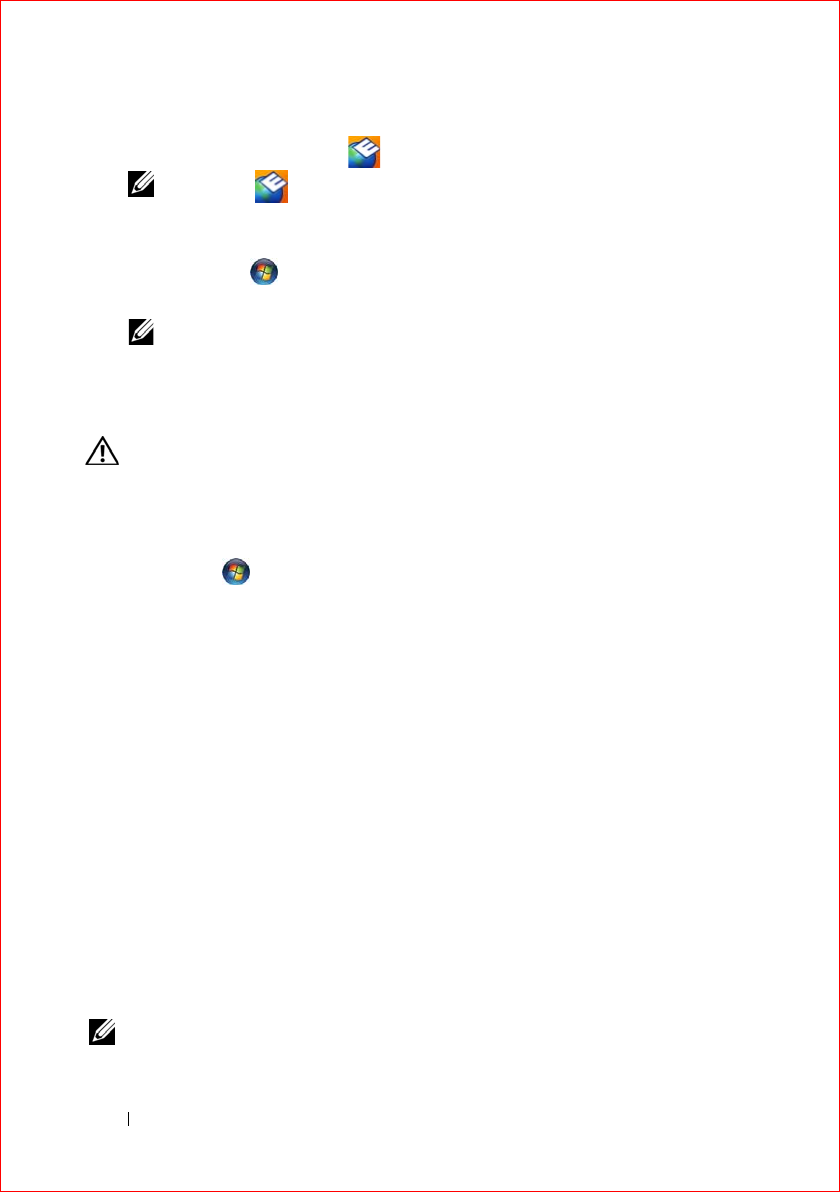
106 Troubleshooting
FILE LOCATION: S:\systems\Sapporo_Yebisu\Sapporo\OM\A00\EN\trouble.fm
DELL CONFIDENTIAL – PRELIMINARY 2/14/07 - FOR PROOF ONLY
• Click the Dell Support icon in the notification area.
NOTE: The icon functions vary when clicking, double-clicking, or right-
clicking.
Or
• Click the
Start
→
All Programs
→
Dell Support
→
Dell Support
Settings
. Ensure that the
Show icon on the taskbar
option is checked.
NOTE: If the Dell Support Utility is not available from the Start menu, go to
support.dell.com and download the software.
Drive Problems
CAUTION: Before you begin any of the procedures in this section, follow the
safety instructions in the Product Information Guide.
Fill out the "Diagnostics Checklist" on page 176 as you complete these checks.
ENSURE THAT MICROSOFT® WINDOWS® RECOGNIZES THE DRIVE —
• Click
Start
→
Computer
.
If the drive is not listed, perform a full scan with your antivirus software to
check for and remove viruses. Viruses can sometimes prevent Windows from
recognizing the drive.
TEST THE DRIVE —
• Insert another floppy disk, CD, or DVD to eliminate the possibility that the
original media is defective.
• Insert a bootable floppy disk and restart the computer.
CLEAN THE DRIVE OR DISK —See "Cleaning Your Computer" on page 189.
ENSURE THAT THE CD OR DVD MEDIA IS SNAPPED ONTO THE SPINDLE
CHECK THE CABLE CONNECTIONS
CHECK FOR HARDWARE INCOMPATIBILITIES —See "Troubleshooting Software
and Hardware Problems" on page 130.
RUN THE DELL DIAGNOSTICS —See "Dell Diagnostics" on page 101.
Optical drive problems
NOTE: High-speed optical drive vibration is normal and may cause noise, which
does not indicate a defect in the drive or the media.

Troubleshooting 107
FILE LOCATION: S:\systems\Sapporo_Yebisu\Sapporo\OM\A00\EN\trouble.fm
DELL CONFIDENTIAL – PRELIMINARY 2/14/07 - FOR PROOF ONLY
NOTE: Because of different regions worldwide and different disc formats, not all
DVD titles work in all DVD drives.
Problems writing to a CD-RW or DVD+/-RW drive
CLOSE OTHER PROGRAMS —CD-RW and DVD+/-RW drives must receive a
steady stream of data when writing. If the stream is interrupted, an error occurs.
Try closing all programs before you write to the drive.
TURN OFF SLEEP STATE IN WINDOWS BEFORE WRITING TO A CD/DVD DISC —
See "Using the Sleep Power State" on page 51 for information on Sleep state.
CHANGE THE WRITE SPEED TO A SLOWER RATE —See the help files for your CD
or DVD creation software.
The drive tray cannot eject
1
Ensure that the computer is shut down.
2
Straighten a paper clip and insert one end into the eject hole at the front of the
drive, then push firmly until the tray is partially ejected.
3
Gently pull out the tray until it stops.
The drive makes an unfamiliar scraping or grinding sound
• Ensure that the sound is not caused by the program that is running.
• Ensure that the disc is inserted properly.
Hard drive problems
ALLOW THE COMPUTER TO COOL BEFORE TURNING IT ON —A hot hard drive may
prevent the operating system from starting. Try allowing the computer to return
to room temperature before turning it on.
RUN CHECK DISK —
1
Click
Start
→
Computer
.
2
Right-click
Local Disk (C:)
.
3
Click
Properties
→
Tools
→
Check Now
.
NOTE: The User Account Control window may appear. If you are an
administrator on the computer, click Continue; otherwise, contact your
administrator to continue the desired action.

108 Troubleshooting
FILE LOCATION: S:\systems\Sapporo_Yebisu\Sapporo\OM\A00\EN\trouble.fm
DELL CONFIDENTIAL – PRELIMINARY 2/14/07 - FOR PROOF ONLY
4
Click to check
Scan for and attempt recovery of bad sectors
, and then
click
Start
.
E-Mail, Modem, and Internet Problems
CAUTION: Before you begin any of the procedures in this section, follow the
safety instructions in the Product Information Guide.
NOTE: Connect the modem to an analog telephone jack only. The modem does not
operate while it is connected to a digital telephone network.
CHECK THE MICROSOFT OUTLOOK® EXPRESS SECURITY SETTINGS —If you
cannot open your e-mail attachments:
1
In Outlook Express, click
Tools
, click
Options
, and then click
Security
.
2
Click
Do not allow attachments
to remove the checkmark.
CHECK THE TELEPHONE LINE CONNECTION
CHECK THE TELEPHONE JACK
CONNECT THE MODEM DIRECTLY TO THE TELEPHONE WALL JACK
USE A DIFFERENT TELEPHONE LINE
• Verify that the telephone line is connected to the jack on the modem (the jack
has either a green label or a connector-shaped icon next to it).
• Ensure that you hear a click when you insert the telephone line connector into
the modem.
• Disconnect the telephone line from the modem and connect it to a telephone,
then listen for a dial tone.
• If you have other telephone devices sharing the line, such as an answering
machine, fax machine, surge protector, or line splitter, then bypass them and
connect the modem directly to the telephone wall jack. If you are using a line
that is 3 m (10 ft) or more in length, try a shorter one.
RUN THE MODEM HELPER DIAGNOSTICS —Click the Start → Programs→
Modem Diagnostic Tool→ Modem Diagnostic Tool. Follow the instructions
on the screen to identify and resolve modem problems (Modem Helper is not
available on certain computers).
VERIFY THAT THE MODEM IS COMMUNICATING WITH WINDOWS —
1
Click the
Start ,
and then click
Control Panel
.
2
Click
Hardware and Sound
.

Troubleshooting 109
FILE LOCATION: S:\systems\Sapporo_Yebisu\Sapporo\OM\A00\EN\trouble.fm
DELL CONFIDENTIAL – PRELIMINARY 2/14/07 - FOR PROOF ONLY
3
Click
Phone and Modem Options
.
4
Click the
Modems
tab.
5
Click the COM port for your modem.
6
Click
Properties
, click the
Diagnostics
tab, and then click
Query Modem
to
verify that the modem is communicating with Windows.
If all commands receive responses, the modem is operating properly.
ENSURE THAT YOU ARE CONNECTED TO THE INTERNET —Ensure that you have
subscribed to an Internet service provider. With the Outlook Express e-mail
program open, click File. If Work Offline has a checkmark next to it, click the
checkmark to remove it, and then connect to the Internet. For help, contact your
Internet service provider.
SCAN THE COMPUTER FOR SPYWARE —If you are experiencing slow computer
performance, you frequently receive pop-up advertisements, or you are having
problems connecting to the Internet, your computer might be infected with
spyware. Use an anti-virus program that includes anti-spyware protection (your
program may require an upgrade) to scan the computer and remove spyware.
For more information, go to support.dell.com and search for the keyword
spyware.
Error Messages
Fill out the "Diagnostics Checklist" on page 176 as you complete these checks.
CAUTION: Before you begin any of the procedures in this section, follow the
safety instructions in the Product Information Guide.
If the message is not listed, see the documentation for the operating system or
the program that was running when the message appeared.
AUXILIARY DEVICE FAILURE —The touch pad or external mouse may be faulty.
For an external mouse, check the cable connection. Enable the Pointing Device
option in the system setup program (see "Using the System Setup Program" on
page 187). If the problem persists, contact Dell (see "Contacting Dell" on
page 177).
BAD COMMAND OR FILE NAME —Ensure that you have spelled the command
correctly, put spaces in the proper place, and used the correct pathname.
CACHE DISABLED DUE TO FAILURE —The primary cache internal to the
microprocessor has failed. Contact Dell (see "Contacting Dell" on page 177).

110 Troubleshooting
FILE LOCATION: S:\systems\Sapporo_Yebisu\Sapporo\OM\A00\EN\trouble.fm
DELL CONFIDENTIAL – PRELIMINARY 2/14/07 - FOR PROOF ONLY
CD DRIVE CONTROLLER FAILURE —The CD drive does not respond to commands
from the computer (see "Drive Problems" on page 106).
DATA ERROR —The hard drive cannot read the data (see "Drive Problems" on
page 106).
DECREASING AVAILABLE MEMORY —One or more memory modules may be
faulty or improperly seated. Reinstall the memory modules and, if necessary,
replace them (see "Memory" on page 146).
DISK C: FAILED INITIALIZATION —The hard drive failed initialization. Run the
hard drive tests in the Dell Diagnostics (see "Dell Diagnostics" on page 101).
DRIVE NOT READY —The operation requires a hard drive in the bay before it can
continue. Install a hard drive in the hard drive bay (see "Hard Drive" on
page 139).
ERROR READING PCMCIA CARD —The computer cannot identify the
ExpressCard. Reinsert the card or try another card (see "Using ExpressCards"
on page 79).
EXTENDED MEMORY SIZE HAS CHANGED —The amount of memory recorded in
NVRAM does not match the memory installed in the computer. Restart the
computer. If the error appears again, contact Dell (see "Contacting Dell" on
page 177).
THE FILE BEING COPIED IS TOO LARGE FOR THE DESTINATION DRIVE —The file
that you are trying to copy is too large to fit on the disk, or the disk is full. Try
copying the file to a different disk or use a larger capacity disk.
A FILENAME CANNOT CONTAIN ANY OF THE FOLLOWING CHARACTERS: \ / : * ? “ <
> | — Do not use these characters in filenames.
GATE A20 FAILURE —A memory module may be loose. Reinstall the memory
modules and, if necessary, replace them (see"Memory" on page 146).
GENERAL FAILURE —The operating system is unable to carry out the command.
The message is usually followed by specific information—for example,
Printer out of paper. Take the appropriate action.
HARD-DISK DRIVE CONFIGURATION ERROR —The computer cannot identify the
drive type. Shut down the computer, remove the hard drive (see "Hard Drive" on
page 139), and boot the computer from a CD. Then, shut down the computer,
reinstall the hard drive, and restart the computer. Run the Hard Disk Drive tests
in the Dell Diagnostics (see "Dell Diagnostics" on page 101).

Troubleshooting 111
FILE LOCATION: S:\systems\Sapporo_Yebisu\Sapporo\OM\A00\EN\trouble.fm
DELL CONFIDENTIAL – PRELIMINARY 2/14/07 - FOR PROOF ONLY
HARD-DISK DRIVE CONTROLLER FAILURE 0—The hard drive does not respond to
commands from the computer. Shut down the computer, remove the hard drive
(see "Hard Drive" on page 139), and boot the computer from a CD. Then, shut
down the computer, reinstall the hard drive, and restart the computer. If the
problem persists, try another drive. Run the Hard Disk Drive tests in the Dell
Diagnostics (see "Dell Diagnostics" on page 101).
HARD-DISK DRIVE FAILURE —The hard drive does not respond to commands
from the computer. Shut down the computer, remove the hard drive (see "Hard
Drive" on page 139), and boot the computer from a CD. Then, shut down the
computer, reinstall the hard drive, and restart the computer. If the problem
persists, try another drive. Run the Hard Disk Drive tests in the Dell Diagnostics
(see "Dell Diagnostics" on page 101).
HARD-DISK DRIVE READ FAILURE —The hard drive may be defective. Shut down
the computer, remove the hard drive (see "Hard Drive" on page 139), and boot
the computer from a CD. Then, shut down the computer, reinstall the hard drive,
and restart the computer. If the problem persists, try another drive. Run the Hard
Disk Drive tests in the Dell Diagnostics (see "Dell Diagnostics" on page 101).
INSERT BOOTABLE MEDIA —The operating system is trying to boot to
nonbootable media, such as a floppy disk or CD. Insert bootable media.
INVALID CONFIGURATION INFORMATION-PLEASE RUN SYSTEM SETUP
PROGRAM —The system configuration information does not match the
hardware configuration. The message is most likely to occur after a memory
module is installed. Correct the appropriate options in the system setup program
(see "Using the System Setup Program" on page 187).
KEYBOARD CLOCK LINE FAILURE —For external keyboards, check the cable
connection. Run the Keyboard Controller test in the Dell Diagnostics (see "Dell
Diagnostics" on page 101).
KEYBOARD CONTROLLER FAILURE —For external keyboards, check the cable
connection. Restart the computer, and avoid touching the keyboard or the mouse
during the boot routine. Run the Keyboard Controller test in the Dell
Diagnostics (see "Dell Diagnostics" on page 101).
KEYBOARD DATA LINE FAILURE —For external keyboards, check the cable
connection. Run the Keyboard Controller test in the Dell Diagnostics (see "Dell
Diagnostics" on page 101).

112 Troubleshooting
FILE LOCATION: S:\systems\Sapporo_Yebisu\Sapporo\OM\A00\EN\trouble.fm
DELL CONFIDENTIAL – PRELIMINARY 2/14/07 - FOR PROOF ONLY
KEYBOARD STUCK KEY FAILURE —For external keyboards or keypads, check the
cable connection. Restart the computer, and avoid touching the keyboard or keys
during the boot routine. Run the Stuck Key test in the Dell Diagnostics (see
"Dell Diagnostics" on page 101).
LICENSED CONTENT IS NOT ACCESSIBLE IN MEDIADIRECT —Dell MediaDirect™
cannot verify the Digital Rights Management (DRM) restrictions on the file, so
the file cannot be played (see "Dell MediaDirect problems" on page 118).
MEMORY ADDRESS LINE FAILURE AT ADDRESS, READ VALUE EXPECTING VALUE —
A memory module may be faulty or improperly seated. Reinstall the memory
modules and, if necessary, replace them (see "Memory" on page 146).
MEMORY ALLOCATION ERROR —The software you are attempting to run is
conflicting with the operating system, another program, or a utility. Shut down
the computer, wait 30 seconds, and then restart it. Try to run the program again.
If the error message still appears, see the software documentation.
MEMORY DATA LINE FAILURE AT ADDRESS, READ VALUE EXPECTING VALUE —A
memory module may be faulty or improperly seated. Reinstall the memory
modules and, if necessary, replace them (see "Memory" on page 146).
MEMORY DOUBLE WORD LOGIC FAILURE AT ADDRESS, READ VALUE EXPECTING
VALUE —A memory module may be faulty or improperly seated. Reinstall the
memory modules and, if necessary, replace them (see "Memory" on page 146).
MEMORY ODD/EVEN LOGIC FAILURE AT ADDRESS, READ VALUE EXPECTING
VALUE —A memory module may be faulty or improperly seated. Reinstall the
memory modules and, if necessary, replace them (see "Memory" on page 146).
MEMORY WRITE/READ FAILURE AT ADDRESS, READ VALUE EXPECTING VALUE —A
memory module may be faulty or improperly seated. Reinstall the memory
modules and, if necessary, replace them (see "Memory" on page 146).
NO BOOT DEVICE AVAILABLE —The computer cannot find the hard drive. If the
hard drive is your boot device, ensure that the drive is installed, properly seated,
and partitioned as a boot device.
NO BOOT SECTOR ON HARD DRIVE —The operating system may be corrupted.
Contact Dell (see "Contacting Dell" on page 177).
NO TIMER TICK INTERRUPT —A chip on the system board may be
malfunctioning. Run the System Set tests in the Dell Diagnostics (see "Dell
Diagnostics" on page 101).

Troubleshooting 113
FILE LOCATION: S:\systems\Sapporo_Yebisu\Sapporo\OM\A00\EN\trouble.fm
DELL CONFIDENTIAL – PRELIMINARY 2/14/07 - FOR PROOF ONLY
NOT ENOUGH MEMORY OR RESOURCES. EXIT SOME PROGRAMS AND TRY AGAIN —
You have too many programs open. Close all windows and open the program
that you want to use.
OPERATING SYSTEM NOT FOUND —Reinstall the hard drive (see "Hard Drive" on
page 139). If the problem persists, contact Dell (see "Contacting Dell" on
page 177).
OPTIONAL ROM BAD CHECKSUM —The optional ROM has failed. Contact Dell
(see "Contacting Dell" on page 177).
A REQUIRED .DLL FILE WAS NOT FOUND —The program that you are trying to
open is missing an essential file. Remove and then reinstall the program.
1
Click
Start →
Control Panel
.
2
Under
Programs
, click
Uninstall a Program
.
3
Select the program you want to remove.
4
Click
Uninstall
and follow the prompts on the screen.
5
See the program documentation for installation instructions.
SECTOR NOT FOUND —The operating system cannot locate a sector on the hard
drive. You may have a defective sector or corrupted FAT on the hard drive. Run
the Windows error-checking utility to check the file structure on the hard drive.
See Windows Help and Support for instructions (click
Start
→ Help and
Support). If a large number of sectors are defective, back up the data (if
possible), and then reformat the hard drive.
SEEK ERROR —The operating system cannot find a specific track on the hard
drive.
SHUTDOWN FAILURE —A chip on the system board may be malfunctioning. Run
the System Set tests in the Dell Diagnostics (see "Dell Diagnostics" on
page 101).
TIME-OF-DAY CLOCK LOST POWER —System configuration settings are
corrupted. Connect your computer to an electrical outlet to charge the battery. If
the problem persists, try to restore the data by entering the system setup
program, then immediately exit the program (see "Using the System Setup
Program" on page 187). If the message reappears, contact Dell (see "Contacting
Dell" on page 177).

114 Troubleshooting
FILE LOCATION: S:\systems\Sapporo_Yebisu\Sapporo\OM\A00\EN\trouble.fm
DELL CONFIDENTIAL – PRELIMINARY 2/14/07 - FOR PROOF ONLY
TIME-OF-DAY CLOCK STOPPED —The reserve battery that supports the system
configuration settings may require recharging. Connect your computer to an
electrical outlet to charge the battery. If the problem persists, contact Dell (see
"Contacting Dell" on page 177).
TIME-OF-DAY NOT SET-PLEASE RUN THE SYS TE M SETUP PROGRAM —The time or
date stored in the system setup program does not match the system clock.
Correct the settings for the Date and Time options (see "Using the System Setup
Program" on page 187).
TIMER CHIP COUNTER 2 FAILED —A chip on the system board may be
malfunctioning. Run the System Set tests in the Dell Diagnostics (see "Dell
Diagnostics" on page 101).
UNEXPECTED INTERRUPT IN PROTECTED MODE —The keyboard controller may
be malfunctioning, or a memory module may be loose. Run the System Memory
tests and the Keyboard Controller test in the Dell Diagnostics (see "Dell
Diagnostics" on page 101).
X:\ IS NOT ACCESSIBLE. THE DEVICE IS NOT READY —Insert a disk into the drive
and try again.
WARNING: BATTERY IS CRITICALLY LOW —The battery is running out of charge.
Replace the battery, or connect the computer to an electrical outlet; otherwise,
activate hibernate mode or shut down the computer.
ExpressCard Problems
CAUTION: Before you begin any of the procedures in this section, follow the
safety instructions in the Product Information Guide.
CHECK THE EXPRESSCARD —Ensure that the ExpressCard is properly inserted
into the connector.
CHECK THAT THE CARD IS RECOGNIZED BY WINDOWS —Double-click the Safely
Remove Hardware icon in the Windows taskbar. Some cards do not support
this feature. If the card supports this Windows feature, the card will be listed.
IF YOU HAVE PROBLEMS WITH A DELL-PROVIDED EXPRESSCARD —Contact Dell
(see "Contacting Dell" on page 177). Also, for Mobile Broadband (WWAN)
ExpressCards, see "Mobile Broadband (Wireless Wide Area Network
[WWAN])" on page 120.
IF YOU HAVE PROBLEMS WITH AN EXPRESSCARD NOT PROVIDED BY DELL —
Contact the ExpressCard manufacturer.

Troubleshooting 115
FILE LOCATION: S:\systems\Sapporo_Yebisu\Sapporo\OM\A00\EN\trouble.fm
DELL CONFIDENTIAL – PRELIMINARY 2/14/07 - FOR PROOF ONLY
IEEE 1394 Device Problems
CAUTION: Before you begin any of the procedures in this section, follow the
safety instructions in the Product Information Guide.
ENSURE THAT THE IEEE 1394 DEVICE IS RECOGNIZED BY WINDOWS —
1
Click
Start
→
Control Panel
→
System and Maintenance
→
Device
Manager
.
NOTE: The User Account Control window may appear. If you are an
administrator on the computer, click Continue; otherwise, contact your
administrator to continue the desired action.
If your IEEE 1394 device is listed, Windows recognizes the device.
IF YOU HAVE PROBLEMS WITH A DELL-PROVIDED IEEE 1394 DEVICE —Contact
Dell or the IEEE 1394 device manufacturer
(see "Contacting Dell" on page 177).
IF YOU HAVE PROBLEMS WITH AN IEEE 1394 DEVICE NOT PROVIDED BY DELL —
Contact Dell or the IEEE 1394 device manufacturer
(see "Contacting Dell" on page 177).
Ensure that the IEEE 1394 device is properly inserted into the connector
Keyboard Problems
CAUTION: Before you begin any of the procedures in this section, follow the
safety instructions in the Product Information Guide.
Fill out the "Diagnostics Checklist" on page 176 as you perform the various
checks.
NOTE: Use the integrated keyboard when running the Dell Diagnostics or the
system setup program. When you attach an external keyboard, the integrated
keyboard remains fully functional.
External Keyboard problems
NOTE: When you attach an external keyboard, the integrated keyboard remains
fully functional.
CHECK THE KEYBOARD CABLE —Shut down the computer, disconnect the
keyboard cable and check it for damage, then firmly reconnect the cable.
If you are using a keyboard extension cable, disconnect it and connect the
keyboard directly to the computer.
CHECK THE EXTERNAL KEYBOARD —

116 Troubleshooting
FILE LOCATION: S:\systems\Sapporo_Yebisu\Sapporo\OM\A00\EN\trouble.fm
DELL CONFIDENTIAL – PRELIMINARY 2/14/07 - FOR PROOF ONLY
1
Shut down the computer, wait 1 minute, and then turn it on again.
2
Verify that the numbers, capitals, and scroll lock lights on the keyboard blink
during the boot routine.
3
From the Windows desktop, click
Start
→
All Programs
→
Accessories
→
Notepad
.
4
Type some characters on the external keyboard and verify that they appear on
the display.
If you cannot verify these steps, you may have a defective external keyboard.
TO VERIFY THAT THE PROBLEM IS WITH THE EXTERNAL KEYBOARD, CHECK THE
INTEGRATED KEYBOARD —
1
Shut down the computer.
2
Disconnect the external keyboard.
3
Turn on the computer.
4
From the Windows desktop, click
Start
→
All Programs
→
Accessories
→
Notepad
.
5
Type some characters on the internal keyboard and verify that they appear on
the display.
If the characters appear now, but did not with the external keyboard, you may
have a defective external keyboard. Contact Dell
(see "Contacting Dell" on
page 177).
RUN THE KEYBOARD DIAGNOSTICS TESTS —Run the PC-AT Compatible
Keyboards tests in the Dell Diagnostics (see "Dell Diagnostics" on page 101). If
the tests indicate a defective external keyboard, contact Dell (see "Contacting
Dell" on page 177).
Unexpected characters
DISABLE THE NUMERIC KEYPAD —Press <Num Lk> to disable the numeric
keypad if numbers are displayed instead of letters. Verify that the numbers lock
light is not lit.
Lockups and Software Problems
CAUTION: Before you begin any of the procedures in this section, follow the
safety instructions in the Product Information Guide.

Troubleshooting 117
FILE LOCATION: S:\systems\Sapporo_Yebisu\Sapporo\OM\A00\EN\trouble.fm
DELL CONFIDENTIAL – PRELIMINARY 2/14/07 - FOR PROOF ONLY
The computer does not start
CHECK THE AC ADAPTER —Ensure that the AC adapter is firmly connected to
the computer and to the electrical outlet.
The computer stops responding
NOTICE: You might lose data if you are unable to perform an operating system
shutdown.
TURN THE COMPUTER OFF —If you are unable to get a response by pressing a
key on your keyboard or moving your mouse, press and hold the power button
for at least 8 to 10 seconds until the computer turns off, then restart your
computer.
A program stops responding or crashes repeatedly
END THE PROGRAM —
1
Press <Crtl><Shift><Esc> simultaneously.
2
Click the
Applications
tab and select the program that is no longer
responding.
3
Click
End Task
.
NOTE: The chkdsk program may run when you restart the computer. Follow the
instructions on the screen.
CHECK THE SOFTWARE DOCUMENTATION —If necessary, uninstall and then
reinstall the program. Software usually includes installation instructions in its
documentation or on a floppy disk or CD.
A program is designed for an earlier Microsoft® Windows® operating
system
RUN THE PROGRAM COMPATIBILITY WIZARD —Program compatibility is a mode
in Windows that lets you run programs written for earlier versions of Windows.
For more information, sea
rch for the keyword
program compatibility wizard
in
Windows Help and Support.

118 Troubleshooting
FILE LOCATION: S:\systems\Sapporo_Yebisu\Sapporo\OM\A00\EN\trouble.fm
DELL CONFIDENTIAL – PRELIMINARY 2/14/07 - FOR PROOF ONLY
A solid blue screen appears
TURN THE COMPUTER OFF —If you are unable to get a response by pressing a
key on your keyboard or moving your mouse, press and hold the power button
for at least 8 to 10 seconds until the computer turns off, then restart your
computer.
Dell MediaDirect problems
CHECK THE DELL MEDIADIRECT HELP FILE FOR INFORMATION —Use the Help
menu to access Dell MediaDirect Help.
TO PLAY MOVIES WITH DELL MEDIADIRECT, YOU MUST HAVE A DVD DRIVE AND
THE DELL DVD PLAYER —If you purchased a DVD drive with your computer,
this software should already be installed.
VIDEO QUALITY PROBLEMS —Turn off the Use Hardware Acceleration option.
This feature takes advantage of the special processing in some graphics cards to
reduce processor requirements when playing DVDs and certain types of video
files.
CANNOT PLAY SOME MEDIA FILES —Because Dell MediaDirect provides access
to media files outside the Windows operating system environment, access to
licensed content is restricted. Licensed content is digital content that has Digital
Rights Management (DRM) applied to it. The Dell MediaDirect environment
cannot verify the DRM restrictions, so the licensed files cannot be played.
Licensed music and video files have a lock icon next to them. You can access
licensed files in the Windows operating system environment.
ADJUSTING THE COLOR SETTINGS FOR MOVIES THAT CONTAIN SCENES THAT ARE
TOO DARK OR TOO BRIGHT —Click EagleVision to use a video enhancement
technology that detects video content and dynamically adjusts the
brightness/contrast/saturation ratios.
NOTICE: You cannot reinstall the Dell MediaDirect feature if you voluntarily
reformat the hard drive. Contact Dell for assistance (see "Contacting Dell" on
page 177).
Other software problems
CHECK THE SOFTWARE DOCUMENTATION OR CONTACT THE SOFTWARE
MANUFACTURER FOR TROUBLESHOOTING INFORMATION —
• Ensure that the program is compatible with the operating system installed on
your computer.

Troubleshooting 119
FILE LOCATION: S:\systems\Sapporo_Yebisu\Sapporo\OM\A00\EN\trouble.fm
DELL CONFIDENTIAL – PRELIMINARY 2/14/07 - FOR PROOF ONLY
• Ensure that your computer meets the minimum hardware requirements
needed to run the software. See the software documentation for information.
• Ensure that the program is installed and configured properly.
• Verify that the device drivers do not conflict with the program.
• If necessary, uninstall and then reinstall the program.
BACK UP YOUR FILES IMMEDIATELY
USE A VIRUS-SCANNING PROGRAM TO CHECK THE HARD DRIVE, FLOPPY DISKS, OR
CDS
SAVE AND CLOSE ANY OPEN FILES OR PROGRAMS AND SHUT DOWN YOUR
COMPUTER THROUGH THE START MENU
SCAN THE COMPUTER FOR SPYWARE —If you are experiencing slow computer
performance, you frequently receive pop-up advertisements, or you are having
problems connecting to the Internet, your computer might be infected with
spyware. Use an anti-virus program that includes anti-spyware protection (your
program may require an upgrade) to scan the computer and remove spyware.
For more information, go to support.dell.com and search for the keyword
spyware.
RUN THE DELL DIAGNOSTICS —If all tests run successfully, the error condition
is related to a software problem (see "Dell Diagnostics" on page 101).
Memory Problems
Fill out the "Diagnostics Checklist" on page 176 as you complete these checks.
CAUTION: Before you begin any of the procedures in this section, follow the
safety instructions in the Product Information Guide.
IF YOU RECEIVE AN INSUFFICIENT MEMORY MESSAGE —
• Save and close any open files and exit any open programs you are not using
to see if that resolves the problem.
• See the software documentation for minimum memory requirements. If
necessary, install additional memory
(see "Memory" on page 146)
.
• Reseat the memory modules to ensure that your computer is successfully
communicating with the memory
(see "Memory" on page 146)
.
• Run the Dell Diagnostics
(see "Dell Diagnostics
" on page 101
)
.
IF YOU EXPERIENCE OTHER MEMORY PROBLEMS —
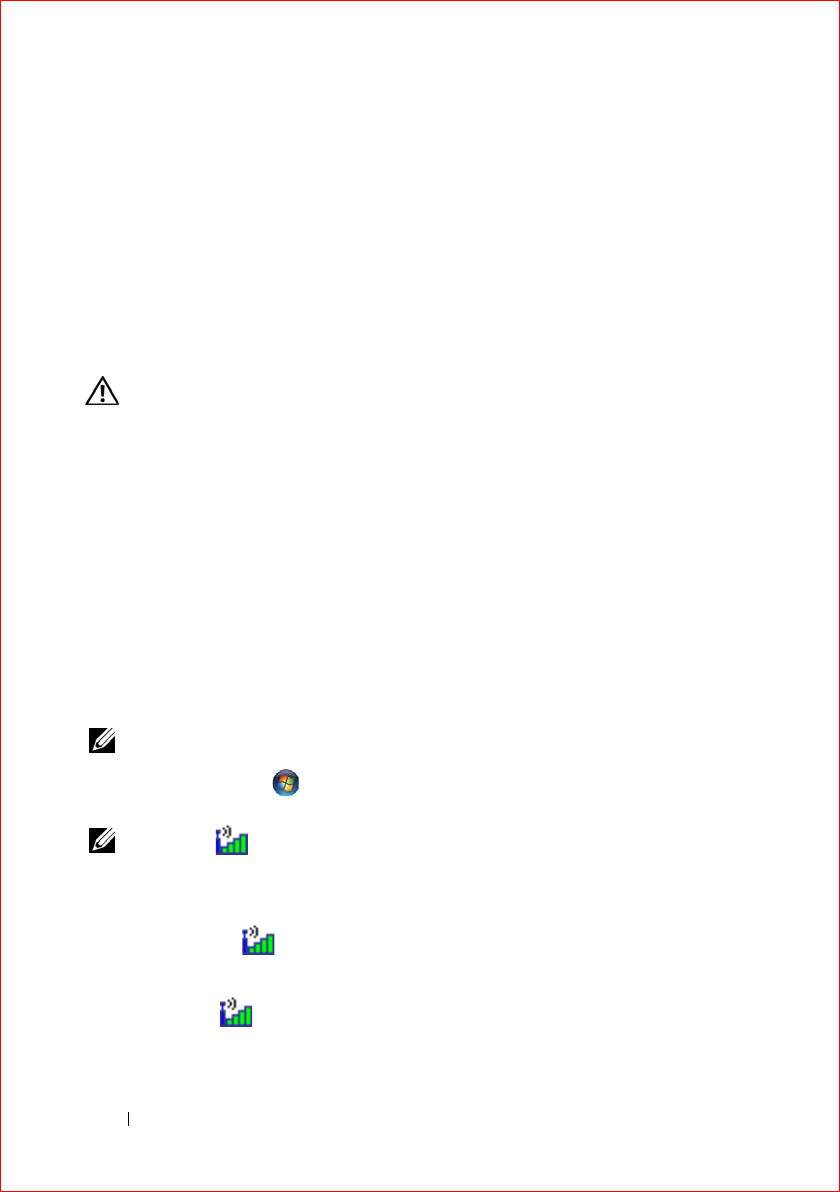
120 Troubleshooting
FILE LOCATION: S:\systems\Sapporo_Yebisu\Sapporo\OM\A00\EN\trouble.fm
DELL CONFIDENTIAL – PRELIMINARY 2/14/07 - FOR PROOF ONLY
• Reseat the memory modules to ensure that your computer is successfully
communicating with the memory
(see "Memory" on page 146)
.
• Ensure that you are following the memory installation guidelines
(see
"Memory" on page 146)
.
• Run the Dell Diagnostics
(see "Dell Diagnostics
" on page 101
)
.
Network Problems
Fill out the "Diagnostics Checklist" on page 176 as you complete these checks.
CAUTION: Before you begin any of the procedures in this section, follow the
safety instructions in the Product Information Guide.
CHECK THE NETWORK CABLE CONNECTOR —Ensure that the network cable is
firmly inserted into both the network connector on the back of the computer and
the network jack.
CHECK THE NETWORK LIGHTS ON THE NETWORK CONNECTOR —No light indicates
that no network communication exists. Replace the network cable.
RESTART THE COMPUTER AND LOG ON TO THE NETWORK AGAIN
CHECK YOUR NETWORK SETTINGS —Contact your network administrator or the
person who set up your network to verify that your network settings are correct
and that the network is functioning.
Mobile Broadband (Wireless Wide Area Network [WWAN])
NOTE: The Dell Mobile Broadband Card Utility user’s guide and the Mobile
Broadband ExpressCard user’s guide are available through Windows Help and
Support (click Start → Help and Support). You can also download the Dell
Mobile Broadband Card Utility user’s guide from support.dell.com.
NOTE: The icon appears in the notification area if the computer has a Dell
WWAN device installed. Double-click the icon to launch the utility.
ACTIVATE THE MOBILE BROADBAND EXPRESSCARD —You must activate the
Mobile Broadband ExpressCard before you can connect to the network. Position
the mouse over the icon in the notification area to verify the status of the
connection. If the card is not activated, follow the card activation instructions
located within the Dell Mobile Broadband Card Utility. To access the utility,
double-click the icon located in the taskbar, at the lower-right corner of
your screen. If your ExpressCard is not a Dell-branded card, see the
manufacturer’s instructions for your card.
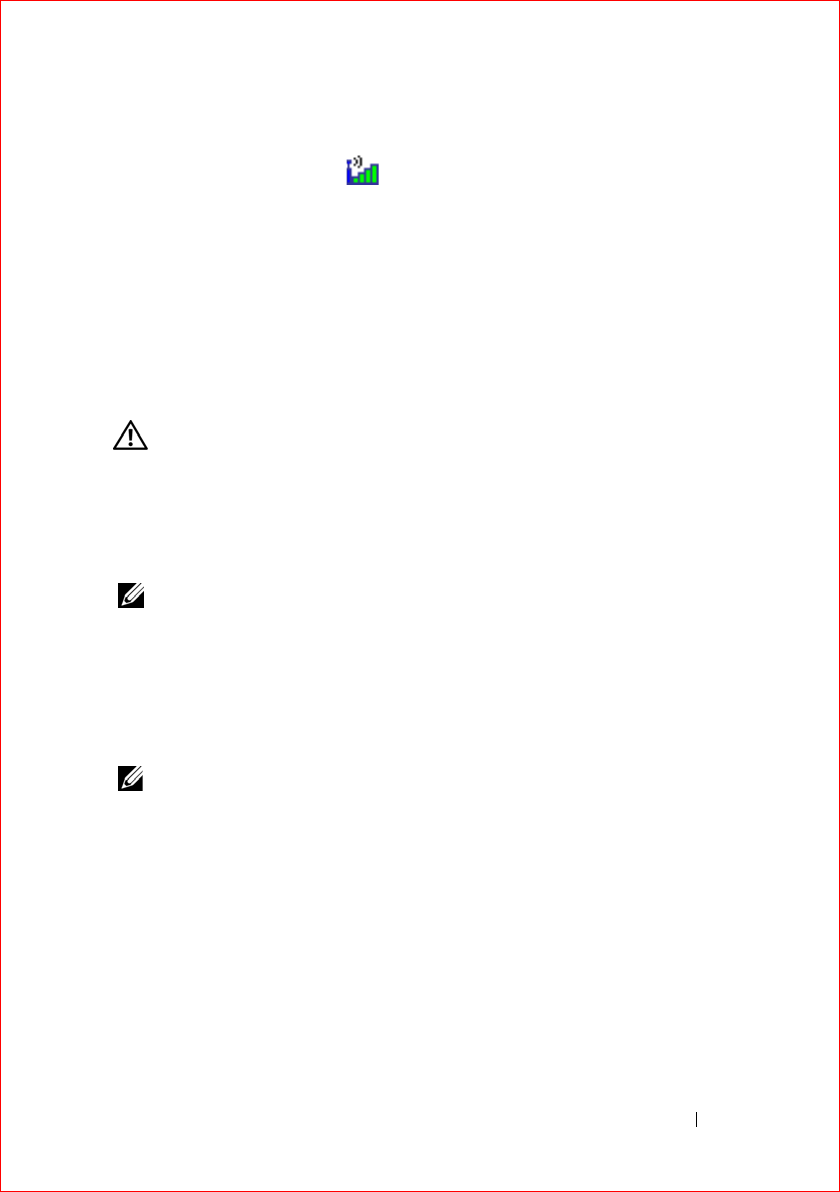
Troubleshooting 121
FILE LOCATION: S:\systems\Sapporo_Yebisu\Sapporo\OM\A00\EN\trouble.fm
DELL CONFIDENTIAL – PRELIMINARY 2/14/07 - FOR PROOF ONLY
CHECK NETWORK CONNECTION STATUS IN THE DELL MOBILE BROADBAND CARD
UTILITY —Double-click the icon to launch the Dell Mobile Broadband
Card Utility. Check the status in the main window:
•
No card detected
— Restart the computer, and launch the
Dell Mobile
Broadband Card Utility
again.
•
Check your WWAN service
— Contact your cellular service provider to
verify your plan coverage and supported services.
Power Problems
Fill out the "Diagnostics Checklist" on page 176 as you complete these checks.
CAUTION: Before you begin any of the procedures in this section, follow the
safety instructions in the Product Information Guide.
CHECK THE POWER LIGHT —When the power light is lit or blinking, the
computer has power. If the power light is blinking, the computer is in Sleep
state—press the power button to exit Sleep state. If the light is off, press the
power button to turn on the computer.
NOTE: For information on Sleep power state, see "Using the Sleep Power State" on
page 51.
CHARGE THE BATTERY —The battery charge may be depleted.
1
Reinstall the battery.
2
Use the AC adapter to connect the computer to an electrical outlet.
3
Turn on the computer.
NOTE: Battery operating time (the time the battery can hold a charge) decreases
over time. Depending on how often the battery is used and the conditions under
which it is used, you may need to purchase a new battery during the life of your
computer.
CHECK THE BATTERY STATUS LIGHT —If the battery status light flashes amber or
is a steady amber, the battery charge is low or depleted. Connect the computer to
an electrical outlet.
If the battery status light flashes blue and amber, the battery is too hot to charge.
Shut down the computer, disconnect the computer from the electrical outlet, and
then let the battery and computer cool to room temperature.
If the battery status light rapidly flashes amber, the battery may be defective.
Contact Dell
(see "Contacting Dell" on page 177).

122 Troubleshooting
FILE LOCATION: S:\systems\Sapporo_Yebisu\Sapporo\OM\A00\EN\trouble.fm
DELL CONFIDENTIAL – PRELIMINARY 2/14/07 - FOR PROOF ONLY
CHECK THE BATTERY TEMPERATURE —If the battery temperature is below 0°C
(32°F), the computer will not start.
TEST THE ELECTRICAL OUTLET —Ensure that the electrical outlet is working by
testing it with another device, such as a lamp.
CHECK THE AC ADAPTER —Check the AC adapter cable connections. If the AC
adapter has a light, ensure that the light is on.
CONNECT THE COMPUTER DIRECTLY TO AN ELECTRICAL OUTLET —Bypass power
protection devices, power strips, and extension cables to verify that the
computer turns on.
ELIMINATE POSSIBLE INTERFERENCE —Turn off nearby fans, fluorescent lights,
halogen lamps, or other appliances.
ADJUST THE POWER PROPERTIES —See "Configuring Power Management
Settings" on page 50.
RESEAT THE MEMORY MODULES —If the computer power light turns on, but the
display remains blank, reinstall the memory modules (see "Memory" on
page 146).
Printer Problems
Fill out the "Diagnostics Checklist" on page 176 as you complete these checks.
CAUTION: Before you begin any of the procedures in this section, follow the
safety instructions in the Product Information Guide.
NOTE: If you need technical assistance for your printer, contact the printer’s
manufacturer.
CHECK THE PRINTER DOCUMENTATION —See the printer documentation for setup
and troubleshooting information.
ENSURE THAT THE PRINTER IS TURNED ON
CHECK THE PRINTER CABLE CONNECTIONS —
• See the printer documentation for cable connection information.
• Ensure that the printer cables are securely connected to the printer and the
computer.
TEST THE ELECTRICAL OUTLET —Ensure that the electrical outlet is working by
testing it with another device, such as a lamp.
VERIFY THAT THE PRINTER IS RECOGNIZED BY WINDOWS —

Troubleshooting 123
FILE LOCATION: S:\systems\Sapporo_Yebisu\Sapporo\OM\A00\EN\trouble.fm
DELL CONFIDENTIAL – PRELIMINARY 2/14/07 - FOR PROOF ONLY
1
Click
Start
→
Control Panel
→
Hardware and Sound
→
Printers
.
2
Right-click the printer icon.
3
Click
Properties
, and then click the
Ports
tab. For a parallel printer, ensure
that the
Print to the following port(s):
setting is
LPT1 (Printer Port)
. For a
USB printer, ensure that the
Print to the following port(s):
setting is
USB
.
REINSTALL THE PRINTER DRIVER —See the printer documentation for
instructions.
Scanner Problems
CAUTION: Before you begin any of the procedures in this section, follow the
safety instructions in the Product Information Guide.
NOTE: If you need technical assistance for your scanner, contact the scanner’s
manufacturer.
CHECK THE SCANNER DOCUMENTATION —See the scanner documentation for
setup and troubleshooting information.
UNLOCK THE SCANNER —Ensure that your scanner is unlocked.
RESTART THE COMPUTER AND TRY THE SCANNER AGAIN
CHECK THE CABLE CONNECTIONS —
• See the scanner documentation for cable connection information.
• Ensure that the scanner cables are securely connected to the scanner and the
computer.
VERIFY THAT THE SCANNER IS RECOGNIZED BY MICROSOFT WINDOWS —
Click Start → Control Panel→ Hardware and Sound→ Scanners and
Cameras. If your scanner is listed, Windows recognizes the scanner.
REINSTALL THE SCANNER DRIVER —See the scanner documentation for
instructions.
Sound and Speaker Problems
Fill out the "Diagnostics Checklist" on page 176 as you complete these checks.
CAUTION: Before you begin any of the procedures in this section, follow the
safety instructions in the Product Information Guide.

124 Troubleshooting
FILE LOCATION: S:\systems\Sapporo_Yebisu\Sapporo\OM\A00\EN\trouble.fm
DELL CONFIDENTIAL – PRELIMINARY 2/14/07 - FOR PROOF ONLY
No sound from integrated speakers
ADJUST THE WINDOWS VOLUME CONTROL —Double-click the speaker icon in
the lower-right corner of your screen. Ensure that the volume is turned up and
that the sound is not muted. Adjust the volume, bass, or treble controls to
eliminate distortion.
ADJUST THE VOLUME USING KEYBOARD SHORTCUTS —Press <Fn><End> to
disable (mute) or re-enable the integrated speakers.
REINSTALL THE SOUND (AUDIO) DRIVER —See "Reinstalling Drivers and
Utilities" on page 128.
No sound from external speakers
ENSURE THAT THE SUBWOOFER AND THE SPEAKERS ARE TURNED ON —See the
setup diagram supplied with the speakers. If your speakers have volume
controls, adjust the volume, bass, or treble to eliminate distortion.
ADJUST THE WINDOWS VOLUME CONTROL —Click or double-click the speaker
icon in the lower-right corner of your screen. Ensure that the volume is turned
up and that the sound is not muted.
DISCONNECT HEADPHONES FROM THE HEADPHONE CONNECTOR —Sound from
the speakers is automatically disabled when headphones are connected to the
headphone connector.
TEST THE ELECTRICAL OUTLET —Ensure that the electrical outlet is working by
testing it with another device, such as a lamp.
ELIMINATE POSSIBLE INTERFERENCE —Turn off nearby fans, fluorescent lights,
or halogen lamps to check for interference.
REINSTALL THE AUDIO DRIVER —See "Reinstalling Drivers and Utilities" on
page 128.
RUN THE DELL DIAGNOSTICS —See "Dell Diagnostics" on page 101.
NOTE: The volume control in some MP3 players overrides the Windows volume
setting. If you have been listening to MP3 songs, ensure that you did not turn the
player volume down or off.
No sound from headphones
CHECK THE HEADPHONE CABLE CONNECTION —Ensure that the headphone cable
is securely inserted into the headphone connector (see "audio connectors" on
page 26).

Troubleshooting 125
FILE LOCATION: S:\systems\Sapporo_Yebisu\Sapporo\OM\A00\EN\trouble.fm
DELL CONFIDENTIAL – PRELIMINARY 2/14/07 - FOR PROOF ONLY
ADJUST THE WINDOWS VOLUME CONTROL —Click or double-click the speaker
icon in the lower-right corner of your screen. Ensure that the volume is turned
up and that the sound is not muted.
Touch Pad or Mouse Problems
CHECK THE TOUCH PAD SETTINGS —
1
Click
Start
→
Control Panel
→
Hardware and Sound
→
Mouse
.
2
Adjust the settings, as needed.
CHECK THE MOUSE CABLE —Shut down the computer, disconnect the mouse
cable and check it for damage, then firmly reconnect the cable.
If you are using a mouse extension cable, disconnect it and connect the mouse
directly to the computer.
TO VERIFY THAT THE PROBLEM IS WITH THE MOUSE, CHECK THE TOUCH PAD —
1
Shut down the computer.
2
Disconnect the mouse.
3
Turn on the computer.
4
At the Windows
desktop, use the touch pad to move the cursor around, select
an icon, and open it.
If the touch pad operates correctly, the mouse may be defective.
CHECK THE SYSTEM SETUP PROGRAM SETTINGS —Verify that the system setup
program lists the correct device for the pointing device option (the computer
automatically recognizes a USB mouse without making any setting
adjustments).
TEST THE MOUSE CONTROLLER —To test the mouse controller (which affects
pointer movement) and the operation of the touch pad or mouse buttons, run the
Mouse test in the Pointing Devices test group in the "Dell Diagnostics" on
page 101.
REINSTALL THE TOUCH PAD DRIVER —See "Reinstalling Drivers and Utilities"
on page 128.
Video and Display Problems
Fill out the "Diagnostics Checklist" on page 176 as you complete these checks.

126 Troubleshooting
FILE LOCATION: S:\systems\Sapporo_Yebisu\Sapporo\OM\A00\EN\trouble.fm
DELL CONFIDENTIAL – PRELIMINARY 2/14/07 - FOR PROOF ONLY
CAUTION: Before you begin any of the procedures in this section, follow the
safety instructions in the Product Information Guide.
If the display is blank
NOTE: If you are using a program that requires a higher resolution than your
computer supports, it is recommended that you attach an external monitor to your
computer.
CHECK THE BATTERY —If you are using a battery to power your computer, the
battery charge may be depleted. Connect the computer to an electrical outlet
using the AC adapter, and then turn on the computer.
TEST THE ELECTRICAL OUTLET —Ensure that the electrical outlet is working by
testing it with another device, such as a lamp.
CHECK THE AC ADAPTER —Check the AC adapter cable connections. If the AC
adapter has a light, ensure that the light is on.
CONNECT THE COMPUTER DIRECTLY TO AN ELECTRICAL OUTLET —Bypass power
protection devices, power strips, and extension cables to verify that the
computer turns on.
ADJUST THE POWER PROPERTIES —Search for the keyword sleep in Windows
Help and Support.
SWITCH THE VIDEO IMAGE —If your computer is attached to an external
monitor, press <Fn><F8> to switch the video image to the display.
If the display is difficult to read
ADJUST THE BRIGHTNESS —Press <Fn> and the up- or down-arrow key.
MOVE THE EXTERNAL SUBWOOFER AWAY FROM THE COMPUTER OR MONITOR —If
your external speaker system includes a subwoofer, ensure that the subwoofer is
at least 60 cm (2 ft) away from the computer or external monitor.
ELIMINATE POSSIBLE INTERFERENCE —Turn off nearby fans, fluorescent lights,
halogen lamps, or other appliances.
ROTATE THE COMPUTER TO FACE A DIFFERENT DIRECTION —Eliminate sunlight
glare, which can cause poor picture quality.
ADJUST THE WINDOWS DISPLAY SETTINGS —
1
Click
Start
→
Control Panel
→
Appearance and Personalization
→
Personalization
→
Display Settings
.
2
Click the area you want to change or click the
Display
icon.

Troubleshooting 127
FILE LOCATION: S:\systems\Sapporo_Yebisu\Sapporo\OM\A00\EN\trouble.fm
DELL CONFIDENTIAL – PRELIMINARY 2/14/07 - FOR PROOF ONLY
Try different settings for
Resolution
and
Colors
.
RUN THE VIDEO DIAGNOSTICS TESTS —If no error message appears and you still
have a display problem, but the display is not completely blank, run the Video
device group in the "Dell Diagnostics" on page 101, then contact Dell (see
"Contacting Dell" on page 177).
SEE "ERROR MESSAGES"—If an error message appears, see "Error Messages"
on page 109.
If only part of the display is readable
CONNECT AN EXTERNAL MONITOR —
1
Shut down your computer and connect an external monitor to the computer.
2
Turn on the computer and the monitor, and then adjust the monitor brightness
and contrast controls.
If the external monitor works, the computer display or video controller may
be defective. Contact Dell (
see "Contacting Dell" on page 177).
Drivers
What Is a Driver?
A driver is a program that controls a device such as a printer, mouse, or
keyboard. All devices require a driver program.
A driver acts like a translator between the device and any other programs that
use the device. Each device has its own set of specialized commands that only
its driver recognizes.
Dell ships your computer to you with required drivers already installed—no
further installation or configuration is needed.
NOTICE: Your Drivers and Utilities media may contain drivers for operating systems
that are not on your computer. Ensure that you are installing software appropriate
for your operating system.
Many drivers, such as the keyboard driver, come with your Microsoft®
Windows® operating system. You may need to install drivers if you:
• Upgrade your operating system.
• Reinstall your operating system.

128 Troubleshooting
FILE LOCATION: S:\systems\Sapporo_Yebisu\Sapporo\OM\A00\EN\trouble.fm
DELL CONFIDENTIAL – PRELIMINARY 2/14/07 - FOR PROOF ONLY
• Connect or install a new device.
Identifying Drivers
If you experience a problem with any device, identify whether the driver is the
source of your problem and, if necessary, update the driver.
1
Click
Start
, and then right-click
Computer
.
2
Click
Properties
, and then click
Device Manager
.
NOTE: The User Account Control window may appear. If you are an
administrator on the computer, click Continue; otherwise, contact your
administrator to continue.
Scroll down the list of devices and check for an exclamation point (a circle with a
[
!]
) next to the device name
. If an exclamation point is next to the device name,
you may need to reinstall the driver or install a new driver (see "Reinstalling
Drivers and Utilities" on page 128).
Reinstalling Drivers and Utilities
NOTICE: The Dell Support website at support.dell.com and your Drivers and
Utilities media provide approved drivers for Dell computers. If you install drivers
obtained from other sources, your computer might not work correctly.
Using Windows Device Driver Rollback
If a problem occurs on your computer after you install or update a driver, use
Windows Device Driver Rollback to replace the driver with the previously
installed version.
1
Click
Start
, and then right-click
Computer
.
2
Click
Properties
, and then click
Device Manager
.
NOTE: The User Account Control window may appear. If you are an
administrator on the computer, click Continue; otherwise, contact your
administrator to enter the Device Manager.
3
Right-click the device for which the new driver was installed and click
Properties
.
4
Click the
Drivers
tab, and then click
Roll Back Driver
.

Troubleshooting 129
FILE LOCATION: S:\systems\Sapporo_Yebisu\Sapporo\OM\A00\EN\trouble.fm
DELL CONFIDENTIAL – PRELIMINARY 2/14/07 - FOR PROOF ONLY
If Device Driver Rollback does not resolve the problem, use System Restore
(see "Restoring Your Operating System" on page 131) to return your computer
to the operating state that existed before you installed the new driver.
Using the Drivers and Utilities Media
If using
Device Driver Rollback or System Restore (see "Restoring Your
Operating System" on page 131) does not resolve the problem, reinstall the
driver from your Drivers and Utilities media.
1
With the Windows desktop displayed, insert your
Drivers and Utilities
media
.
If this is your first time to use your
Drivers and Utilities media
, continue to
step 2. If not, proceed to step 5.
2
When the
Drivers and Utilities
installation program starts, follow the
prompts on the screen.
NOTE: In most cases, the Drivers and Utilities program starts running
automatically. If it does not, start Windows Explorer, click your media drive
directory to display the media contents, and then double-click the autorcd.exe
file.
3
When the
InstallShield Wizard Complete
window appears, remove the
Drivers and Utilities disc
and click
Finish
to restart the computer.
4
When you see the Windows desktop, reinsert the
Drivers and Utilities disc
.
5
At the
Welcome Dell System Owner
screen, click
Next
.
NOTE: The Drivers and Utilities program displays drivers only for hardware
that came installed in your computer. If you installed additional hardware, the
drivers for the new hardware might not be displayed. If those drivers are not
displayed, exit the Drivers and Utilities program. For drivers information, see
the documentation that came with the device.
A message stating that the
Drivers and Utilities program
is detecting
hardware in your computer appears.
The drivers that are used by your computer are automatically displayed in the
My Drivers—The ResourceCD has identified these components in your
system
window.
6
Click the driver that you want to reinstall and follow the instructions on the
screen.

130 Troubleshooting
FILE LOCATION: S:\systems\Sapporo_Yebisu\Sapporo\OM\A00\EN\trouble.fm
DELL CONFIDENTIAL – PRELIMINARY 2/14/07 - FOR PROOF ONLY
If a particular driver is not listed, then that driver is not required by your
operating system.
Manually Reinstalling Drivers
NOTE: If your computer has a Consumer IR port and you are reinstalling a
Consumer IR driver, you must first enable the Consumer IR port in the system setup
program (see "Using the System Setup Program" on page 187) before continuing
with the driver installation (see "Reinstalling Drivers and Utilities" on page 128). For
information about components installed on your computer, see "Determining Your
Computer’s Configuration" on page 19.
1
After extracting the driver files to your hard drive, as described in the
previous section, click
Start ,
and then right-click
Computer
.
2
Click
Properties
, and then click
Device Manager
.
3
Double-click the type of device for which you are installing the driver (for
example,
Modems
or
Infrared devices
).
4
Double-click the name of the device for which you are installing the driver.
5
Click
Driver
tab, and then click
Update Driver
.
6
Click
Install from a list or specific location (Advanced)
, and then click
Next
.
7
Click
Browse
and browse to the location to which you previously copied the
driver files.
8
When the name of the appropriate driver appears, click
Next
.
9
Click
Finish
, and then restart your computer.
Troubleshooting Software and Hardware
Problems
If a device is either not detected during the operating system setup or is detected
but incorrectly configured, use
Windows Vista Help and Support
to resolve the
incompatibility:
1
Click
Start
→
Help and Support
.
2
Type
hardware troubleshooter
in the search field, then press
<Enter>.

Troubleshooting 131
FILE LOCATION: S:\systems\Sapporo_Yebisu\Sapporo\OM\A00\EN\trouble.fm
DELL CONFIDENTIAL – PRELIMINARY 2/14/07 - FOR PROOF ONLY
3
In the search results, select the option that best describes the problem and
follow the remaining troubleshooting steps.
Restoring Your Operating System
You can restore your operating system in the following ways:
• Microsoft Windows Vista System Restore returns your computer to an earlier
operating state without affecting data files. Use System Restore as the first
solution for restoring your operating system and preserving data files. For
instructions, see "Using Microsoft
Windows System Restore" on page 131.
• Dell PC Restore by Symantec restores your hard drive to the operating state it
was in when you purchased the computer. Dell PC Restore permanently
deletes all data on the hard drive and removes any applications installed after
you received the computer. Use PC Restore only if System Restore did not
resolve your operating system problem. For instructions, see "Using Dell PC
Restore by Symantec" on page 132.
• If you received
Operating System
media with your computer, you can use it
to restore your operating system. However, using the
Operating System
media also deletes all data on the hard drive. Use the media
only
if System
Restore did not resolve your operating system problem. For instructions, see
"Using the Operating System Media" on page 134.
Using Microsoft Windows System Restore
The Windows operating system provides System Restore to allow you to return
your computer to an earlier operating state (without affecting data files) if
changes to the hardware, software, or other system settings have left the
computer in an undesirable operating state. Any changes that System Restore
makes to your computer are completely reversible.
NOTICE: Make regular backups of your data files. System Restore does not
monitor your data files or recover them.
NOTE: The procedures in this document were written for the Windows default
view, so they may not apply if you set your Dell computer to the Windows Classic
view.
1
Click
Start
→
Help and Support
.
2
Type
System Restore
in the search field, then press <Enter>.

132 Troubleshooting
FILE LOCATION: S:\systems\Sapporo_Yebisu\Sapporo\OM\A00\EN\trouble.fm
DELL CONFIDENTIAL – PRELIMINARY 2/14/07 - FOR PROOF ONLY
NOTE: The User Account Control window may appear. If you are an
administrator on the computer, click Continue; otherwise, contact your
administrator to continue the desired action.
3
Click
Next
and follow the remaining prompts on the screen.
In the event that System Restore did not resolve the issue, you may undo the last
system restore.
Undoing the Last System Restore
NOTICE: Before you undo the last system restore, save and close all open files and
exit any open programs. Do not alter, open, or delete any files or programs until the
system restoration is complete.
1
Click
Start
→
Help and Support
.
2
Type
System Restore
in the search field and press <Enter>.
3
Click
Undo my last restoration
,
and then click
Next
.
Using Dell PC Restore by Symantec
NOTICE: Using Dell PC Restore permanently deletes all data on the hard drive and
removes any application programs or drivers installed after you received your
computer. If possible, back up the data before using PC Restore. Use PC Restore
only if System Restore (see "Using Microsoft Windows System Restore" on
page 131) did not resolve your operating system problem.
NOTE: Dell PC Restore by Symantec may not be available in certain countries or on
certain computers.
Use Dell PC Restore by Symantec only as the last method to restore your
operating system. PC Restore restores your hard drive to the operating state it
was in when you purchased the computer. Any programs or files added since
you received your computer—including data files—are permanently deleted
from the hard drive. Data files include documents, spreadsheets, e-mail
messages, digital photos, music files, etc. If possible, back up all data before
using PC Restore.
To use PC Restore:
1
Turn on the computer.
During the boot process, a blue bar with
www.dell.com
appears at the top of
the screen.
2
Immediately upon seeing the blue bar, press <Ctrl><F11>.

Troubleshooting 133
FILE LOCATION: S:\systems\Sapporo_Yebisu\Sapporo\OM\A00\EN\trouble.fm
DELL CONFIDENTIAL – PRELIMINARY 2/14/07 - FOR PROOF ONLY
If you do not press <Ctrl><F11> in time, let the computer finish starting, and
then restart the computer and try again.
NOTICE: If you do not want to proceed with PC Restore, click Reboot in the
following step.
3
On the next screen that appears, click
Restore
.
4
Click
Confirm
.
The restore process takes approximately 6–10 minutes to complete.
5
When prompted, click
Finish
to reboot the computer.
NOTE: Do not manually shut down the computer. Click Finish and let the
computer completely reboot.
6
When prompted, click
Yes
.
The computer restarts. Because the computer is restored to its original
operating state, the screens that appear, such as the End User License
Agreement, are the same ones that appeared the first time the computer was
turned on.
7
Click
Next
.
The
System Restore
screen appears and the computer restarts.
8
After the computer restarts, click
OK
.
Removing Dell PC Restore
NOTICE: Removing Dell PC Restore from the hard drive permanently deletes the PC
Restore utility from your computer. After you have removed Dell PC Restore, you will
not be able to use it to restore your computer’s operating system.
Dell PC Restore enables you to restore your hard drive to the operating state it
was in when you purchased your computer. It is recommended that you do not
remove PC Restore from your computer, even to gain additional hard-drive
space. If you remove PC Restore from the hard drive, you cannot recall it, and
you will be unable to use PC Restore to return your computer’s operating system
to its original state.
To remove PC Restore:
1
Log on to the computer as a local administrator.
2
In Windows Explorer, go to
c:\dell\utilities\DSR
.
3
Double-click the filename
DSRIRRemv2.exe
.

134 Troubleshooting
FILE LOCATION: S:\systems\Sapporo_Yebisu\Sapporo\OM\A00\EN\trouble.fm
DELL CONFIDENTIAL – PRELIMINARY 2/14/07 - FOR PROOF ONLY
NOTE: If you do not log on as a local administrator, a message appears
stating that you must log on as administrator. Click Quit, and then log on as a
local administrator.
NOTE: If the partition for PC Restore does not exist on your computer’s hard
drive, a message appears stating that the partition was not found. Click Quit;
there is no partition to delete.
4
Click
OK
to remove the PC Restore partition on the hard drive.
5
Click
Yes
to confirm.
The PC Restore partition is deleted and the newly available disk space is
added to the free space allocation on the hard drive.
6
Right-click
Local Disk (C:)
in Windows Explorer, click
Properties
, and
verify that the additional disk space is available as indicated by the increased
value for
Free Space
.
7
Click
Finish
to close the
PC Restore Removal
window.
8
Restart the computer.
Using the Operating System Media
Before You Begin
If you are considering reinstalling the Windows operating system to correct a
problem with a newly installed driver, first try using Windows Device Driver
Rollback (see "Using Windows Device Driver Rollback" on page 128). If
Device Driver Rollback does not resolve the problem, then use System Restore
to return your operating system to the operating state it was in before you
installed the new device driver (see "Using Microsoft Windows System Restore"
on page 131).
NOTICE: Before performing the installation, back up all data files on your primary
hard drive. For conventional hard drive configurations, the primary hard drive is the
first drive detected by the computer.
To reinstall Windows, you need the following items:
• Dell
Operating System
media
• Dell
Drivers and Utilities
media
NOTE: Your Drivers and Utilities media contains drivers that were installed during
assembly of the computer. Use your Drivers and Utilities media to load any required
drivers, including the drivers required if your computer has a RAID controller.

Troubleshooting 135
FILE LOCATION: S:\systems\Sapporo_Yebisu\Sapporo\OM\A00\EN\trouble.fm
DELL CONFIDENTIAL – PRELIMINARY 2/14/07 - FOR PROOF ONLY
Reinstalling Windows
The reinstallation process can take 1 to 2 hours to complete. After you reinstall
the operating system, you must also reinstall the device drivers, virus protection
program, and other software.
NOTICE: The Operating System media provides options for reinstalling Windows.
The options can overwrite files and possibly affect programs that are installed on
your hard drive. Therefore, do not reinstall Windows unless a Dell technical support
representative instructs you to do so.
1
Save and close any open files and exit any open programs.
2
Insert the
Operating System
media.
3
Click
Exit
if the
Install Windows
message appears.
4
Restart the computer.
When the DELL logo appears, press <F12> immediately.
NOTE: If you wait too long and the operating system logo appears, continue
to wait until you see the Microsoft Windows desktop, then shut down your
computer and try again.
NOTE: The next steps change the boot sequence for one time only. On the
next start-up, the computer boots according to the devices specified in the
system setup program.
5
When the boot device list appears, highlight
CD/DVD/CD-RW Drive
, and
then press <Enter>.
6
Press any key to
Boot from CD-ROM
.
7
Follow the instructions on the screen to complete the installation.

136 Troubleshooting
FILE LOCATION: S:\systems\Sapporo_Yebisu\Sapporo\OM\A00\EN\trouble.fm
DELL CONFIDENTIAL – PRELIMINARY 2/14/07 - FOR PROOF ONLY

Template Last Updated - 2/7/2007 Adding and Replacing Parts 137
DELL CONFIDENTIAL – PRELIMINARY 2/14/07 - FOR PROOF ONLY
Adding and Replacing Parts
Before You Begin
This chapter provides procedures for removing and installing the components in
your computer. Unless otherwise noted, each procedure assumes that the
following conditions exist:
• You have performed the steps in "Turning Off Your Computer" on page 137
and "Before Working Inside Your Computer" on page 138.
• You have read the safety information in your Dell
Product Information
Guide
.
• A component can be replaced—or if purchased separately—installed by
performing the removal procedure in reverse order.
Recommended Tools
The procedures in this document may require the following tools:
• Small flat-blade screwdriver
• Phillips screwdriver
• Small plastic scribe
• Flash BIOS update (see the Dell Support website at
support.dell.com
)
Turning Off Your Computer
NOTICE: To avoid losing data, save and close any open files and exit any open
programs before you turn off your computer.
1
Save and close any open files and exit any open programs.
2
Click
Start
, click the arrow
,
and then click
Shut Down
.
The computer turns off after the operating system shutdown process finishes.
3
Ensure that the computer and any attached devices are turned off. If your
computer and attached devices did not automatically turn off when you shut
down your operating system, press and hold the power button for at least 8 to
10 seconds until the computer turns off.

138 Adding and Replacing Parts
FILE LOCATION: S:\systems\Sapporo_Yebisu\Sapporo\OM\A00\EN\parts.fm
DELL CONFIDENTIAL – PRELIMINARY 2/14/07 - FOR PROOF ONLY
Before Working Inside Your Computer
Use the following safety guidelines to help protect your computer from potential
damage and to help ensure your own personal safety.
CAUTION: Before you begin any of the procedures in this section, follow the
safety instructions in the Product Information Guide.
CAUTION: Handle components and cards with care. Do not touch the components
or contacts on a card. Hold a card by its edges or by its metal mounting bracket.
Hold a component such as a processor by its edges, not by its pins.
NOTICE: Only a certified service technician should perform repairs on your
computer. Damage due to servicing that is not authorized by Dell is not covered by
your warranty.
NOTICE: When you disconnect a cable, pull on its connector or on its strain-relief
loop, not on the cable itself. Some cables have a connector with locking tabs; if you
are disconnecting this type of cable, press in on the locking tabs before you
disconnect the cable. As you pull connectors apart, keep them evenly aligned to
avoid bending any connector pins. Also, before you connect a cable, ensure that
both connectors are correctly oriented and aligned.
NOTICE: To avoid electrostatic discharge, ground yourself by using a wrist
grounding strap or by periodically touching an unpainted metal surface (such as a
connector on the back of the computer).
NOTICE: To help prevent damage to the computer, perform the following steps
before you begin working inside the computer.
1
Ensure that the work surface is flat and clean to prevent the computer cover
from being scratched.
2
Turn off your computer (see "Turning Off Your Computer" on page 137).
NOTICE: To disconnect a network cable, first unplug the cable from your computer,
and then unplug it from the network wall jack.
3
Disconnect any telephone or network cables from the computer.
4
Disconnect your computer and all attached devices from their electrical
outlets.
NOTICE: To help prevent damage to the system board, you must remove the battery
from the battery bay before you service the computer.
NOTE: To avoid damage to the computer, use only the battery designed for this
particular Dell computer. Do not use batteries designed for other Dell computers.
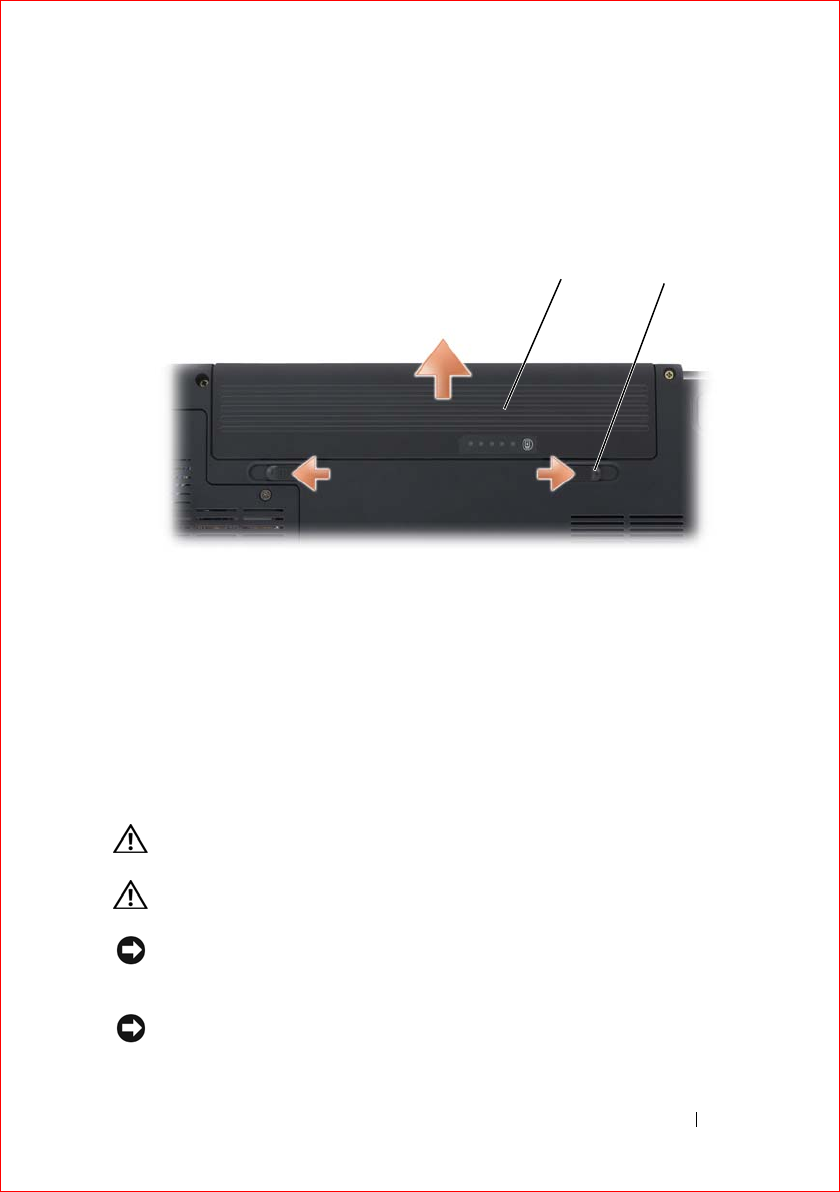
Adding and Replacing Parts 139
FILE LOCATION: S:\systems\Sapporo_Yebisu\Sapporo\OM\A00\EN\parts.fm
DELL CONFIDENTIAL – PRELIMINARY 2/14/07 - FOR PROOF ONLY
5
Turn the computer over.
6
Slide and click the battery release latches.
7
Slide the battery out of the battery bay.
8
Turn the computer top-side up, open the display, and press the power button
to ground the system board.
9
Remove any installed cards from the ExpressCard slot (see "Removing an
ExpressCard or Blank" on page 81) and the 8-in-1 memory card reader (see
"Removing a Memory Card or Blank" on page 84).
Hard Drive
CAUTION: If you remove the hard drive from the computer when the drive is hot,
do not touch the metal housing of the hard drive.
CAUTION: Before you begin any of the procedures in this section, follow the
safety instructions in the Product Information Guide.
NOTICE: To prevent data loss, turn off your computer (see "Turning Off Your
Computer" on page 137) before removing the hard drive. Do not remove the hard
drive while the computer is on or in Sleep state.
NOTICE: Hard drives are extremely fragile. Exercise care when handling the hard
drive.
1 battery 2 battery release latch (2)
2
1
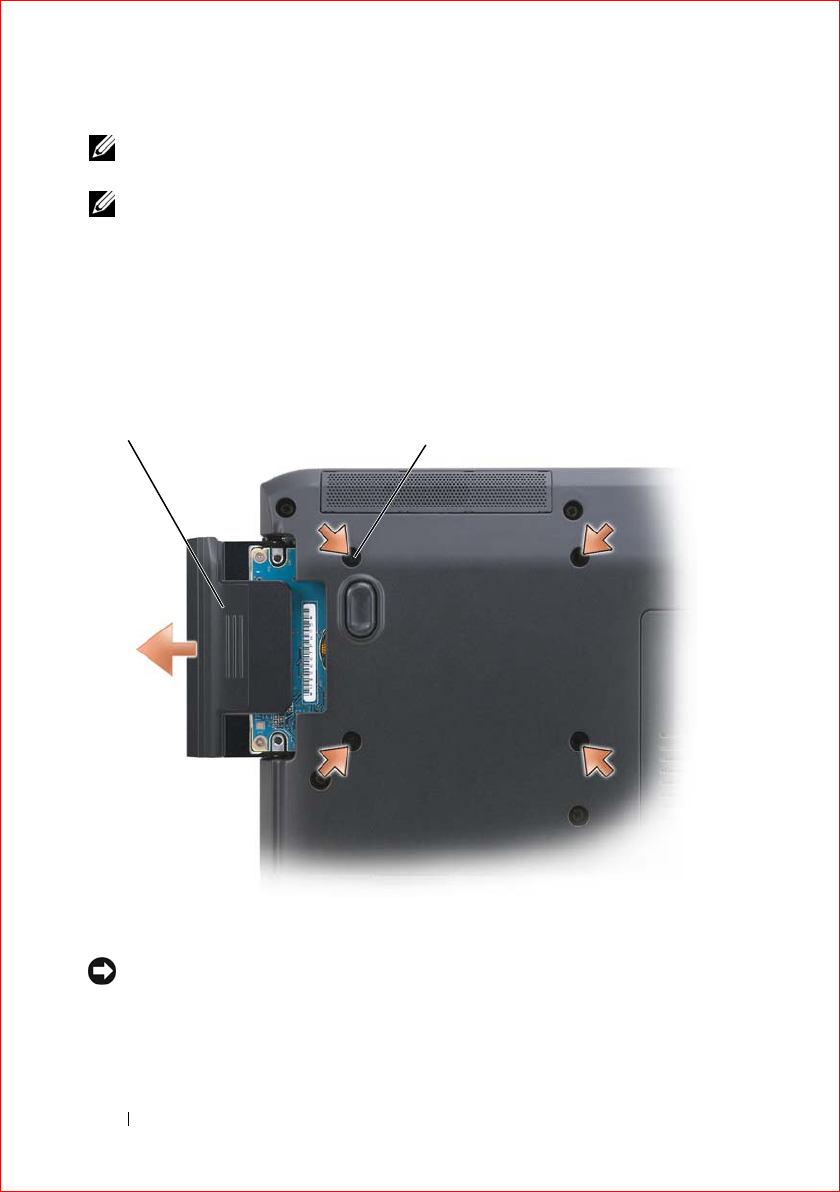
140 Adding and Replacing Parts
FILE LOCATION: S:\systems\Sapporo_Yebisu\Sapporo\OM\A00\EN\parts.fm
DELL CONFIDENTIAL – PRELIMINARY 2/14/07 - FOR PROOF ONLY
NOTE: Dell does not guarantee compatibility or provide support for hard drives
from sources other than Dell.
NOTE: If you are installing a hard drive from a source other than Dell, you need to
install an operating system, drivers, and utilities on the new hard drive (see
"Restoring Your Operating System" on page 131 and "Reinstalling Drivers and
Utilities" on page 128).
Removing the Hard Drive
1
Follow the procedures in "Before You Begin" on page 137.
2
Turn the computer over and remove the hard drive screws.
NOTICE: When the hard drive is not in the computer, store it in protective antistatic
packaging (see "Protecting Against Electrostatic Discharge" in the Product
Information Guide).
3
Slide the hard drive out of the computer.
1 hard drive 2 screws (4)
2
1
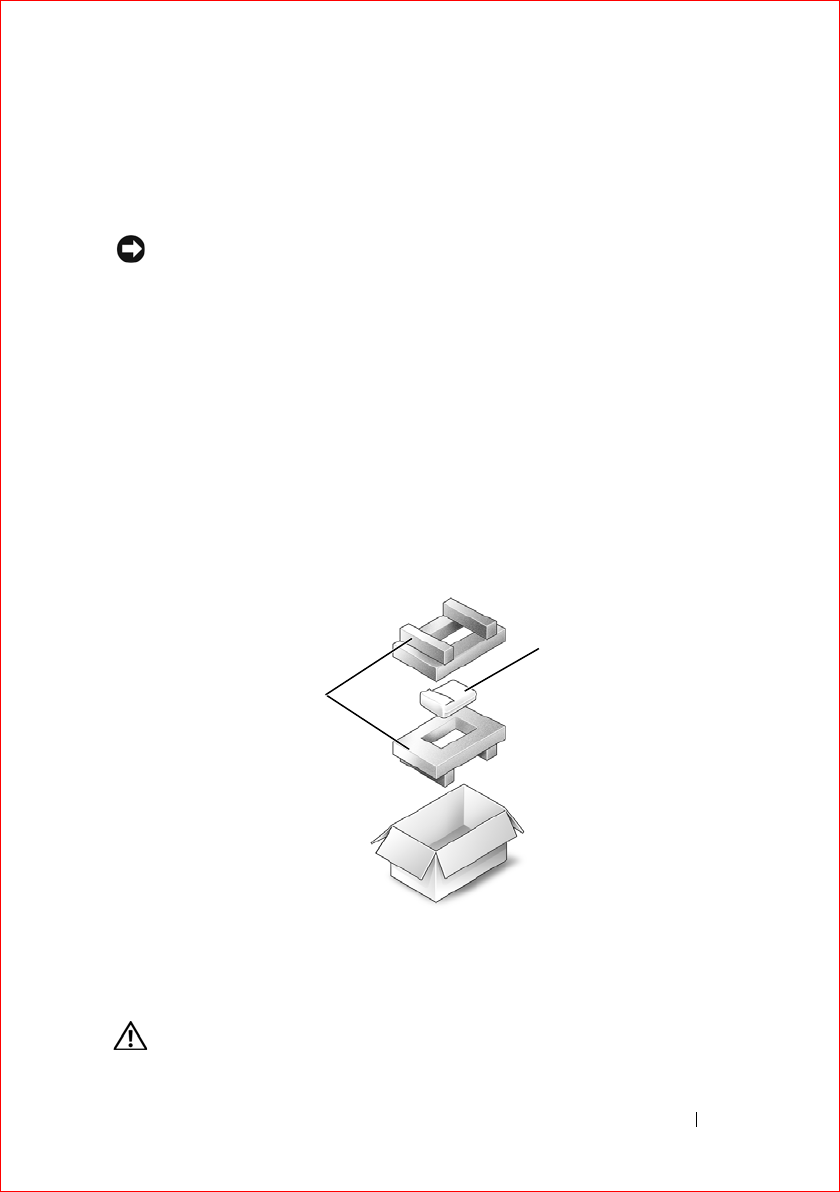
Adding and Replacing Parts 141
FILE LOCATION: S:\systems\Sapporo_Yebisu\Sapporo\OM\A00\EN\parts.fm
DELL CONFIDENTIAL – PRELIMINARY 2/14/07 - FOR PROOF ONLY
Replacing the Hard Drive
1
Remove the new drive from its packaging.
Save the original packaging for storing or shipping the hard drive.
NOTICE: Use firm and even pressure to slide the drive into place. If you use
excessive force, you may damage the connector.
2
Slide the hard drive into the bay until it is fully seated.
3
Replace and tighten the screws.
4
Install the operating system for your computer, as needed (see "Restoring
Your Operating System" on page 131).
5
Install the drivers and utilities for your computer, as needed (see
"Reinstalling Drivers and Utilities" on page 128).
Returning a Hard Drive to Dell
Return your old hard drive to Dell in its original, or comparable, foam
packaging. Otherwise, the hard drive may be damaged in transit.
Optical Drive
CAUTION: Before you begin any of the procedures in this section, follow the
safety instructions in the Product Information Guide.
1 foam packaging 2 hard drive
2
1
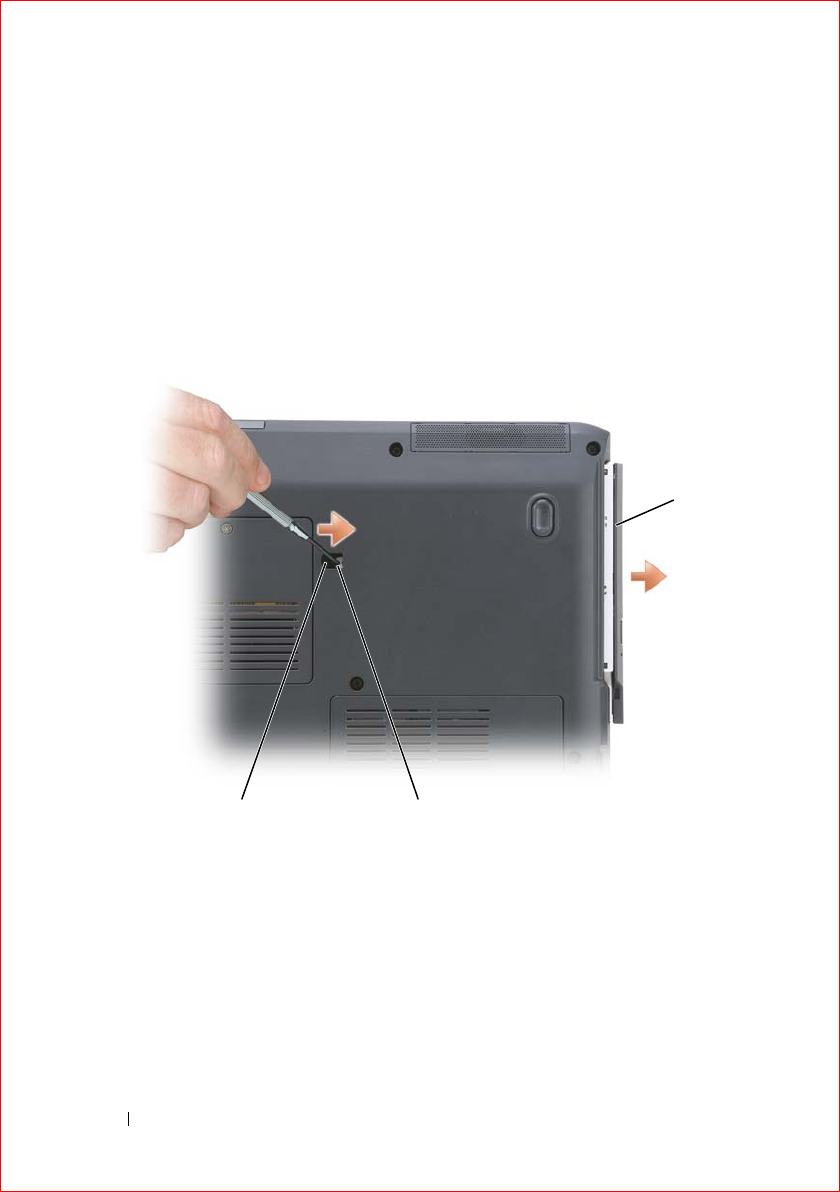
142 Adding and Replacing Parts
FILE LOCATION: S:\systems\Sapporo_Yebisu\Sapporo\OM\A00\EN\parts.fm
DELL CONFIDENTIAL – PRELIMINARY 2/14/07 - FOR PROOF ONLY
Removing the Optical Drive
1
Follow the procedures in "Before You Begin" on page 137.
2
Turn the computer over.
3
Remove the locking screw from the optical drive.
4
Using a plastic scribe, push the notch to release the optical drive from the
bay.
5
Slide the optical drive out of the bay.
Replacing the Optical Drive
1
Slide the optical drive into the bay.
2
Replace and tighten the locking screw.
1 optical drive 2 notch
3 locking screw
2
1
3

Adding and Replacing Parts 143
FILE LOCATION: S:\systems\Sapporo_Yebisu\Sapporo\OM\A00\EN\parts.fm
DELL CONFIDENTIAL – PRELIMINARY 2/14/07 - FOR PROOF ONLY
Hinge Cover
CAUTION: Before you begin any of the procedures in this section, follow the
safety instructions in the Product Information Guide.
NOTICE: To avoid electrostatic discharge, ground yourself by using a wrist
grounding strap or by periodically touching an unpainted metal surface (such as a
connector on the back of the computer).
NOTICE: To help prevent damage to the system board, you must remove the battery
from the battery bay before you begin working inside the computer.
Removing the Hinge Cover
1
Follow the procedures in "Before You Begin" on page 137.
2
Open the display as far as it will open.
NOTICE: To avoid damage to the hinge cover, do not lift the cover on both sides
simultaneously.
3
Insert a plastic scribe into the indent to lift the hinge cover on the right side.
4
Ease the hinge cover up, moving from right to left, and remove it.
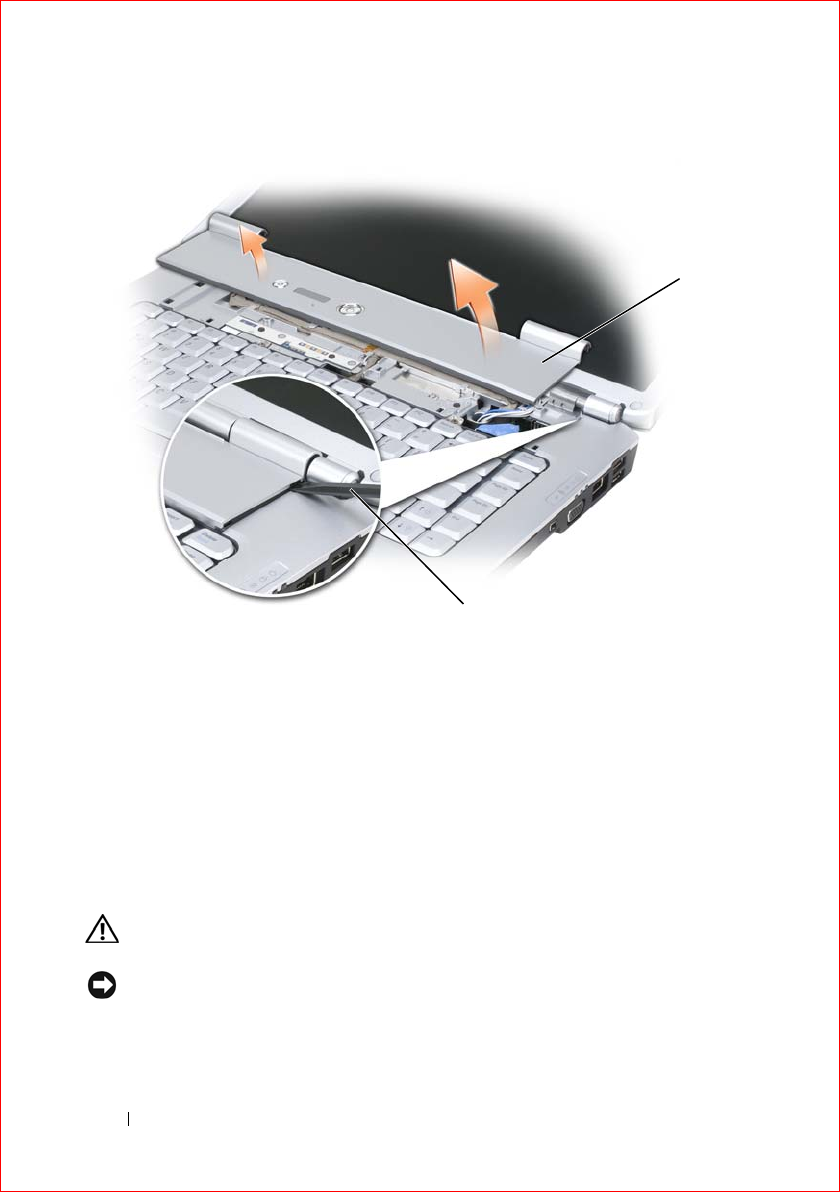
144 Adding and Replacing Parts
FILE LOCATION: S:\systems\Sapporo_Yebisu\Sapporo\OM\A00\EN\parts.fm
DELL CONFIDENTIAL – PRELIMINARY 2/14/07 - FOR PROOF ONLY
Replacing the Hinge Cover
1
Insert the left edge of the hinge cover.
2
Press from left to right until the cover snaps into place.
Keyboard
For more information about the keyboard, see "Using the Keyboard and
Touchpad" on page 41.
CAUTION: Before you begin any of the procedures in this section, follow the
safety instructions in the Product Information Guide.
NOTICE: To avoid electrostatic discharge, ground yourself by using a wrist
grounding strap or by periodically touching an unpainted metal surface (such as a
connector on the back of the computer).
1 hinge cover 2 scribe
1
2
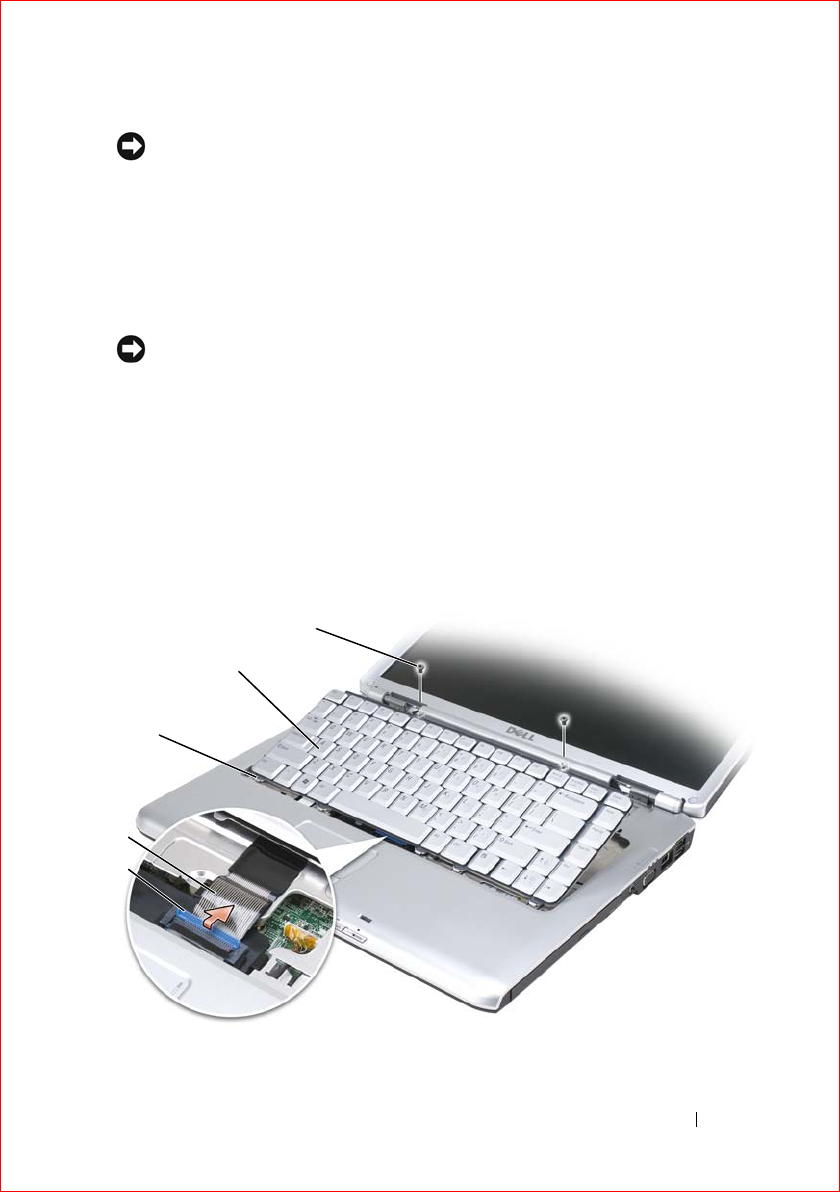
Adding and Replacing Parts 145
FILE LOCATION: S:\systems\Sapporo_Yebisu\Sapporo\OM\A00\EN\parts.fm
DELL CONFIDENTIAL – PRELIMINARY 2/14/07 - FOR PROOF ONLY
NOTICE: To help prevent damage to the system board, you must remove the battery
from the battery bay before you begin working inside the computer.
Removing the Keyboard
1
Follow the procedures in "Before You Begin" on page 137.
2
Remove the hinge cover (see "Hinge Cover" on page 143).
3
Remove the two screws at the top of the keyboard.
NOTICE: The key caps on the keyboard are fragile, easily dislodged, and time-
consuming to replace. Be careful when removing and handling the keyboard.
4
Lift the keyboard and hold it up and slightly forward to access to the
keyboard connector.
5
To disconnect the keyboard cable from the keyboard connector on the system
board, rotate the keyboard connector latch toward the front of the computer.
6
Slide the keyboard cable out of the keyboard connector on the DIMM A
memory module cover.
1
2
4
5
3

146 Adding and Replacing Parts
FILE LOCATION: S:\systems\Sapporo_Yebisu\Sapporo\OM\A00\EN\parts.fm
DELL CONFIDENTIAL – PRELIMINARY 2/14/07 - FOR PROOF ONLY
Replacing the Keyboard
1
Slide the keyboard cable into the keyboard connector on the DIMM A
memory module cover.
2
Rotate the keyboard connector latch to secure the cable.
3
Hook the tabs along the front edge of the keyboard into the palmrest.
4
Press on the right edge near the top to snap the keyboard into place.
5
Replace the two screws on the top of the keyboard.
Memory
CAUTION: Before you begin any of the procedures in this section, follow the
safety instructions in the Product Information Guide.
You can increase your computer memory by installing memory modules on the
system board. See "Specifications" on page 179 for information on the memory
supported by your computer. Install only memory modules that are intended for
your computer.
NOTE: Memory modules purchased from Dell are covered under your computer
warranty.
Your computer has two user-accessible SODIMM sockets, one accessed from
beneath the keyboard (DIMM A), and the other accessed from the bottom of the
computer (DIMM B).
NOTICE: If your computer has only one memory module, install the memory module
in the connector labeled “DIMMA.”
NOTICE: If you need to install memory modules in two connectors, install a
memory module in the connector labeled “DIMMA” before you install a module in
the connector labeled “DIMMB.”
1 screws (2) 2 keyboard
3 tabs (5) 4 keyboard cable
5 cable release lever

Adding and Replacing Parts 147
FILE LOCATION: S:\systems\Sapporo_Yebisu\Sapporo\OM\A00\EN\parts.fm
DELL CONFIDENTIAL – PRELIMINARY 2/14/07 - FOR PROOF ONLY
Removing the DIMM A Memory Module
NOTICE: To avoid electrostatic discharge, ground yourself by using a wrist
grounding strap or by periodically touching an unpainted metal surface (such as a
connector on the back of the computer).
The DIMM A memory module is located under the keyboard.
1
Follow the procedures in "Before You Begin" on page 137.
2
Remove the hinge cover (see "Hinge Cover" on page 143).
3
Remove the keyboard (see "Keyboard" on page 144).
NOTE: It is not necessary to disconnect the keyboard cable from the memory
module cover.
4
Lift the memory module cover but do not remove it.
NOTICE: To prevent damage to the memory module connector, do not use tools to
spread the memory module securing clips.
5
Use your fingertips to carefully spread apart the securing clips on each end of
the memory module connector until the module pops up.
6
Remove the module from the connector.
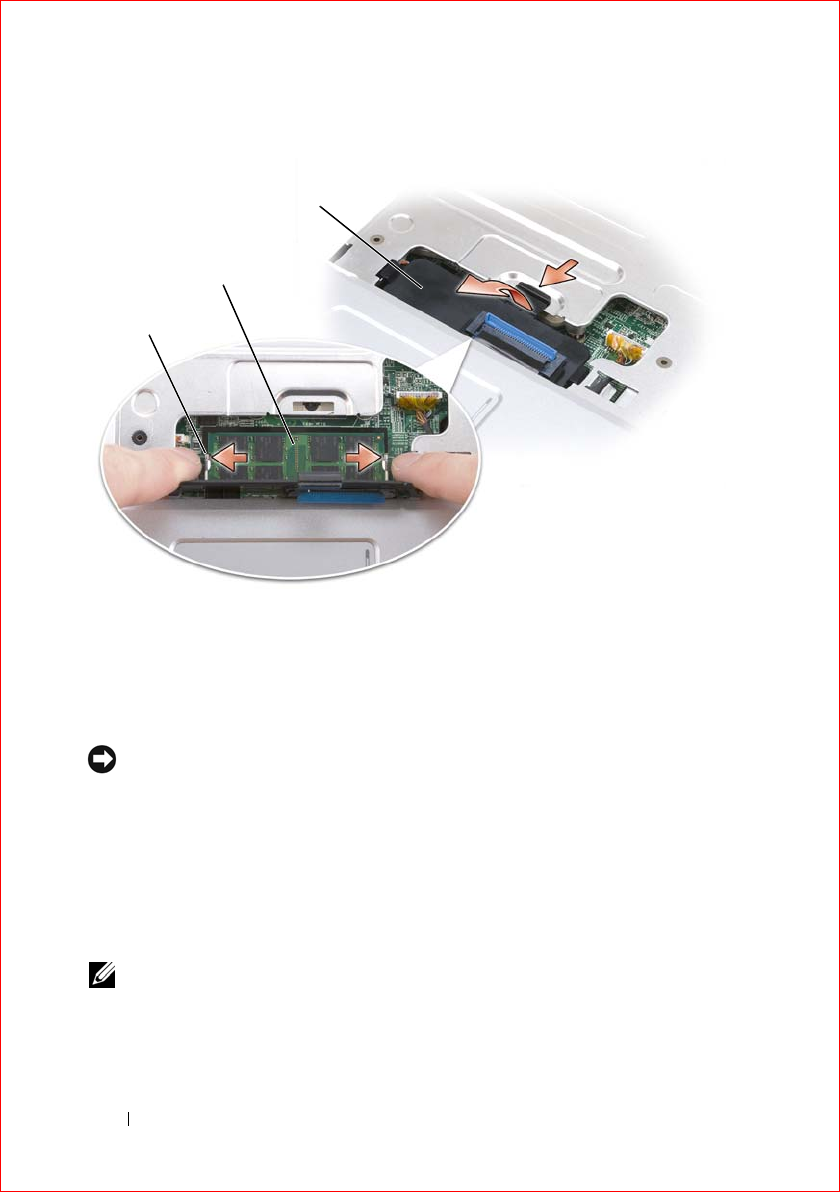
148 Adding and Replacing Parts
FILE LOCATION: S:\systems\Sapporo_Yebisu\Sapporo\OM\A00\EN\parts.fm
DELL CONFIDENTIAL – PRELIMINARY 2/14/07 - FOR PROOF ONLY
Replacing the DIMM A Memory Module
NOTICE: To avoid electrostatic discharge, ground yourself by using a wrist
grounding strap or by periodically touching an unpainted metal surface (such as a
connector on the back of the computer).
1
Align the notch in the module edge connector with the tab in the connector
slot.
2
Slide the module firmly into the slot at a 45-degree angle, and rotate the
module down until it clicks into place. If you do not feel the click, remove the
module and reinstall it.
NOTE: If the memory module is not installed properly, the computer may not boot.
No error message indicates this failure.
1 memory module cover 2 memory module (DIMM A)
3 securing clips (2)
1
2
3
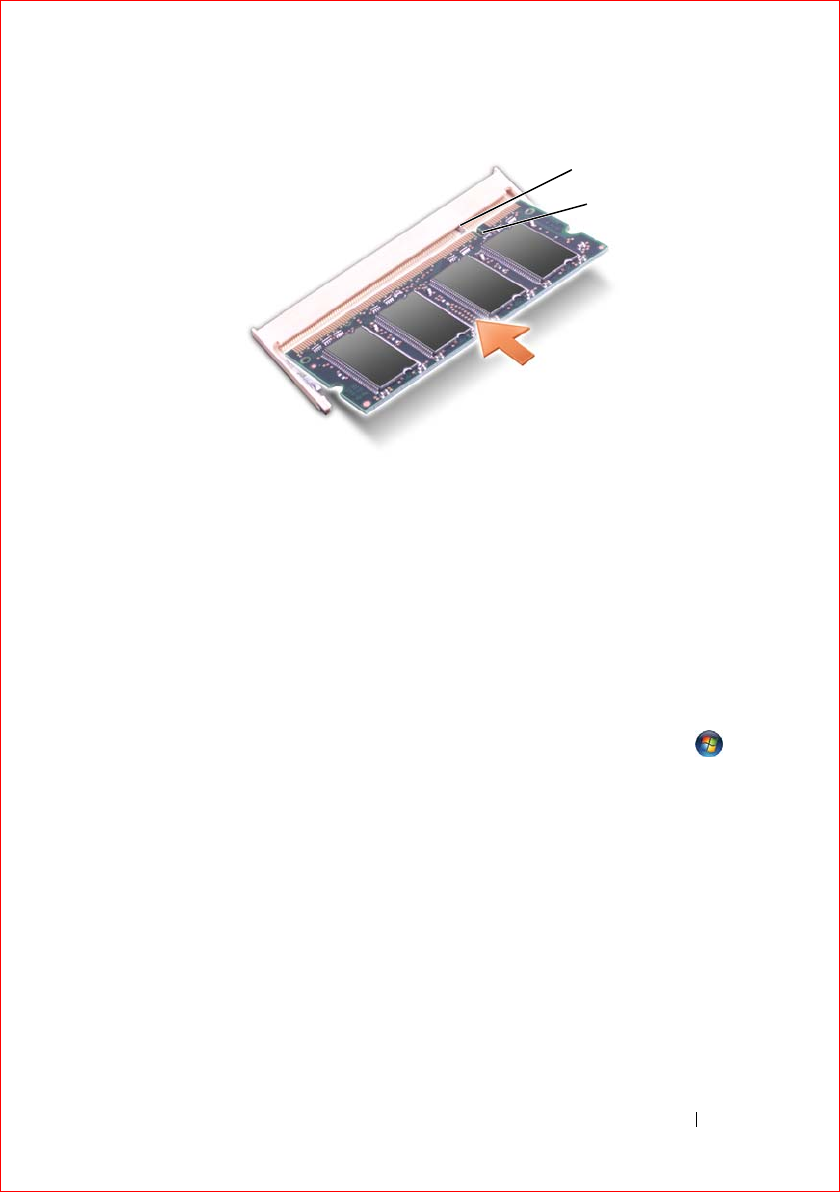
Adding and Replacing Parts 149
FILE LOCATION: S:\systems\Sapporo_Yebisu\Sapporo\OM\A00\EN\parts.fm
DELL CONFIDENTIAL – PRELIMINARY 2/14/07 - FOR PROOF ONLY
3
Replace the memory module cover.
4
Replace the keyboard and hinge cover.
5
Insert the battery into the battery bay, or connect the AC adapter to your
computer and an electrical outlet.
6
Turn on the computer.
As the computer boots, it detects the additional memory and automatically
updates the system configuration information.
To confirm the amount of memory installed in the computer, click Start
→
Help and Support
→
Dell System Information.
Removing the DIMM B Memory Module
The DIMM B memory module is located under the memory module cover on
the bottom of the computer.
1
Follow the procedures in "Before You Begin" on page 137.
2
Turn the computer upside-down, loosen the captive screw on the memory
module cover (see "Bottom View" on page 30), and remove the cover.
1 tab 2 notch
1
2
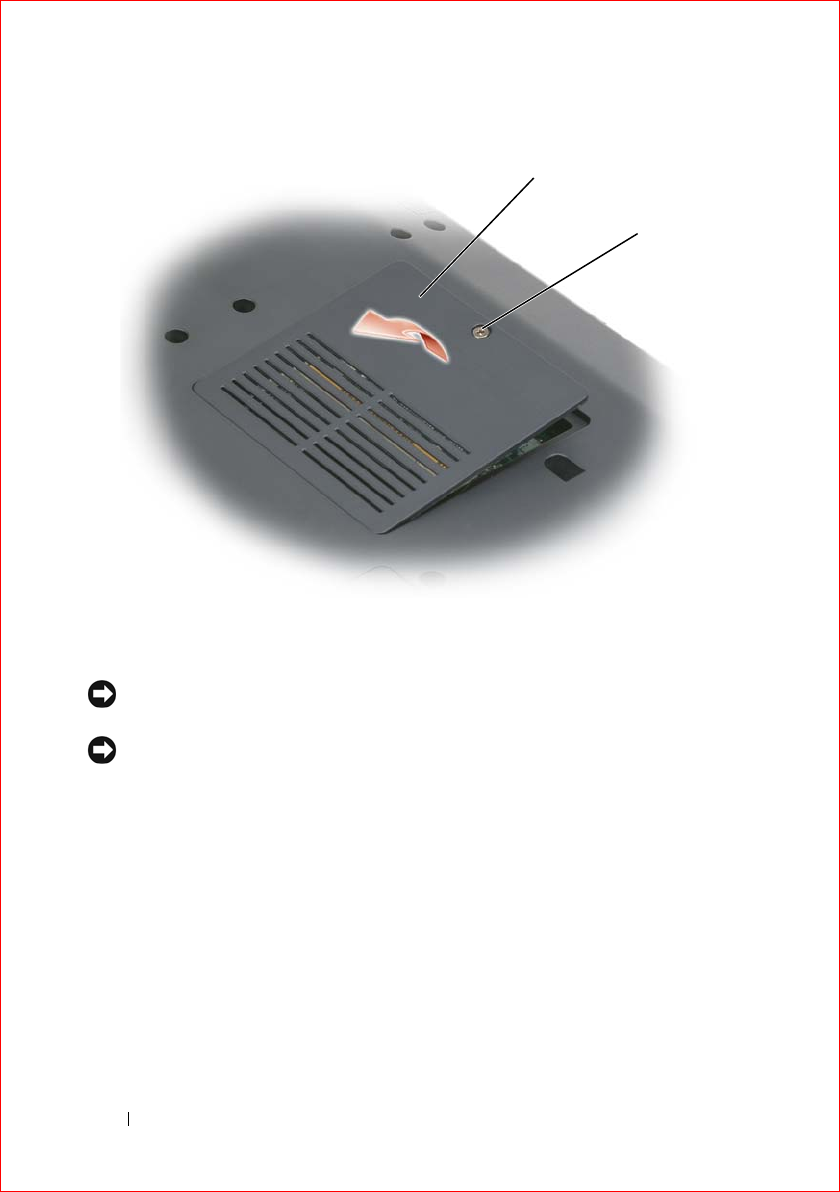
150 Adding and Replacing Parts
FILE LOCATION: S:\systems\Sapporo_Yebisu\Sapporo\OM\A00\EN\parts.fm
DELL CONFIDENTIAL – PRELIMINARY 2/14/07 - FOR PROOF ONLY
NOTICE: To prevent damage to the memory module connector, do not use tools to
spread the memory module securing clips.
NOTICE: To avoid electrostatic discharge, ground yourself by using a wrist
grounding strap or by periodically touching an unpainted metal surface (such as a
connector on the back of the computer).
3
Use your fingertips to carefully spread apart the securing clips on each end of
the memory module connector until the module pops up.
4
Remove the module from the connector.
1 memory module/coin-cell battery
compartment
2 captive screw
1
2
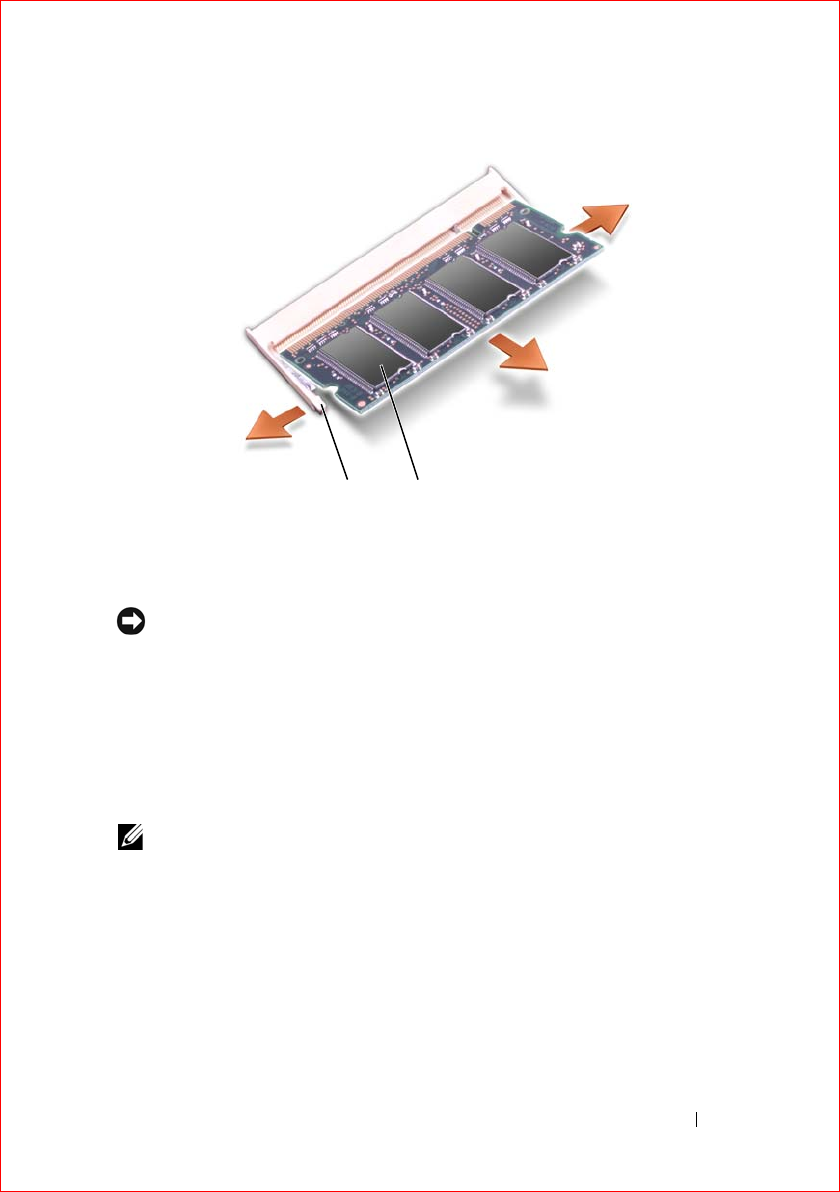
Adding and Replacing Parts 151
FILE LOCATION: S:\systems\Sapporo_Yebisu\Sapporo\OM\A00\EN\parts.fm
DELL CONFIDENTIAL – PRELIMINARY 2/14/07 - FOR PROOF ONLY
Replacing the DIMM B Memory Module
NOTICE: To avoid electrostatic discharge, ground yourself by using a wrist
grounding strap or by periodically touching an unpainted metal surface (such as a
connector on the back of the computer).
1
Align the notch in the module edge connector with the tab in the connector
slot.
2
Slide the module firmly into the slot at a 45-degree angle, and rotate the
module down until it clicks into place. If you do not feel the click, remove the
module and reinstall it.
NOTE: If the memory module is not installed properly, the computer may not boot.
No error message indicates this failure.
1 securing clips (2) 2 memory module
1 2
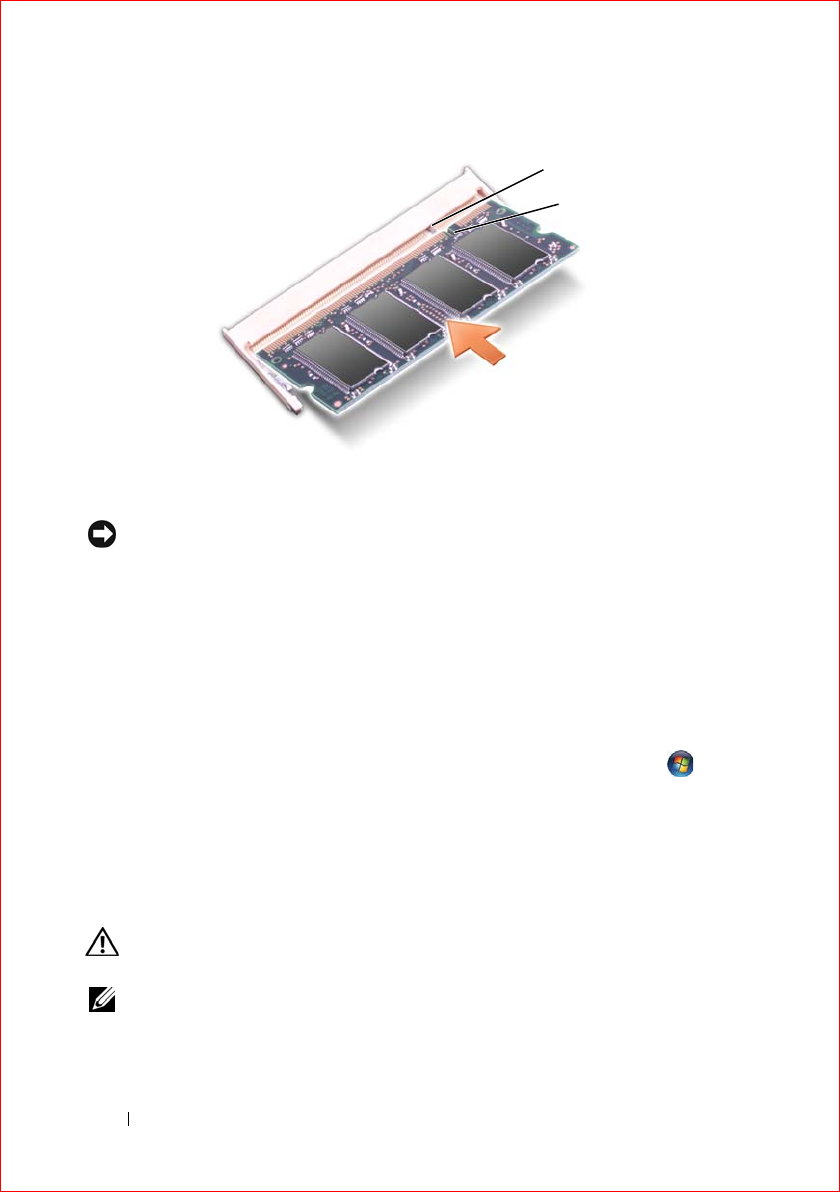
152 Adding and Replacing Parts
FILE LOCATION: S:\systems\Sapporo_Yebisu\Sapporo\OM\A00\EN\parts.fm
DELL CONFIDENTIAL – PRELIMINARY 2/14/07 - FOR PROOF ONLY
NOTICE: If the cover is difficult to close, remove the module and reinstall it. Forcing
the cover to close may damage your computer.
3
Replace the memory module cover.
4
Insert the battery into the battery bay, or connect the AC adapter to your
computer and an electrical outlet.
5
Turn on the computer.
As the computer boots, it detects the additional memory and automatically
updates the system configuration information.
To confirm the amount of memory installed in the computer, click Start
→
Help and Support
→
Dell System Information.
Subscriber Identity Module
Subscriber Identity Modules (SIM) identify users uniquely through an
International Mobile Subscriber Identity.
CAUTION: Before you begin any of the procedures in this section, follow the
safety instructions in the Product Information Guide.
NOTE: Only Cingular and Vodafone need a SIM. Verizon, Sprint, and Telus do not
use SIMs.
1
Follow the procedures in "Before You Begin" on page 137.
1 tab 2 notch
1
2
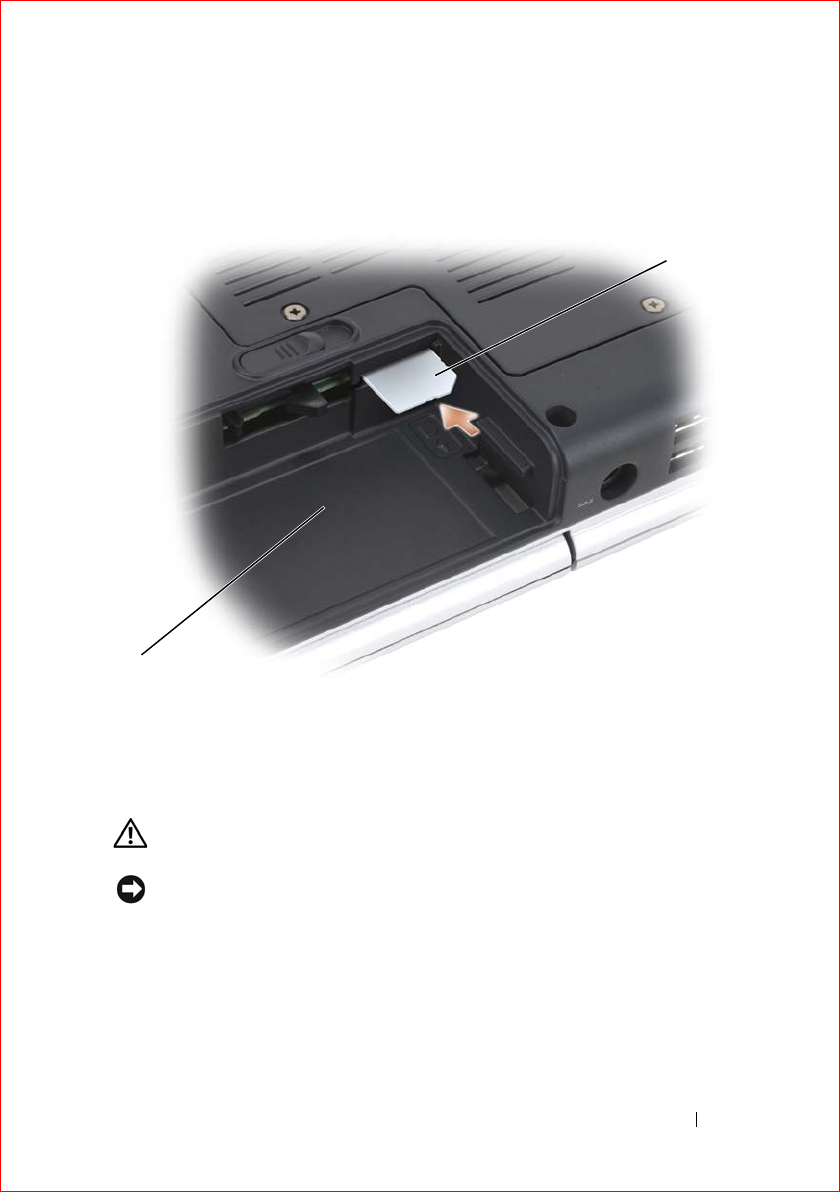
Adding and Replacing Parts 153
FILE LOCATION: S:\systems\Sapporo_Yebisu\Sapporo\OM\A00\EN\parts.fm
DELL CONFIDENTIAL – PRELIMINARY 2/14/07 - FOR PROOF ONLY
2
In the battery bay, slide the SIM into the compartment with the cut-off corner
of the card facing away from the compartment.
Wireless Mini Cards
CAUTION: Before you begin any of the procedures in this section, follow the
safety instructions in the Product Information Guide.
NOTICE: To help prevent damage to the system board, you must remove the battery
from the battery bay before you begin working inside the computer.
If you ordered a wireless Mini Card with your computer, the card is already
installed. Your computer supports three types of wireless Mini Cards:
• Wireless Local Area Network (WLAN)
• Mobile Broadband or Wireless Wide Area Network (WWAN)
• Wireless Personal Area Network (WPAN)
1 battery bay 2 SIM
1
2
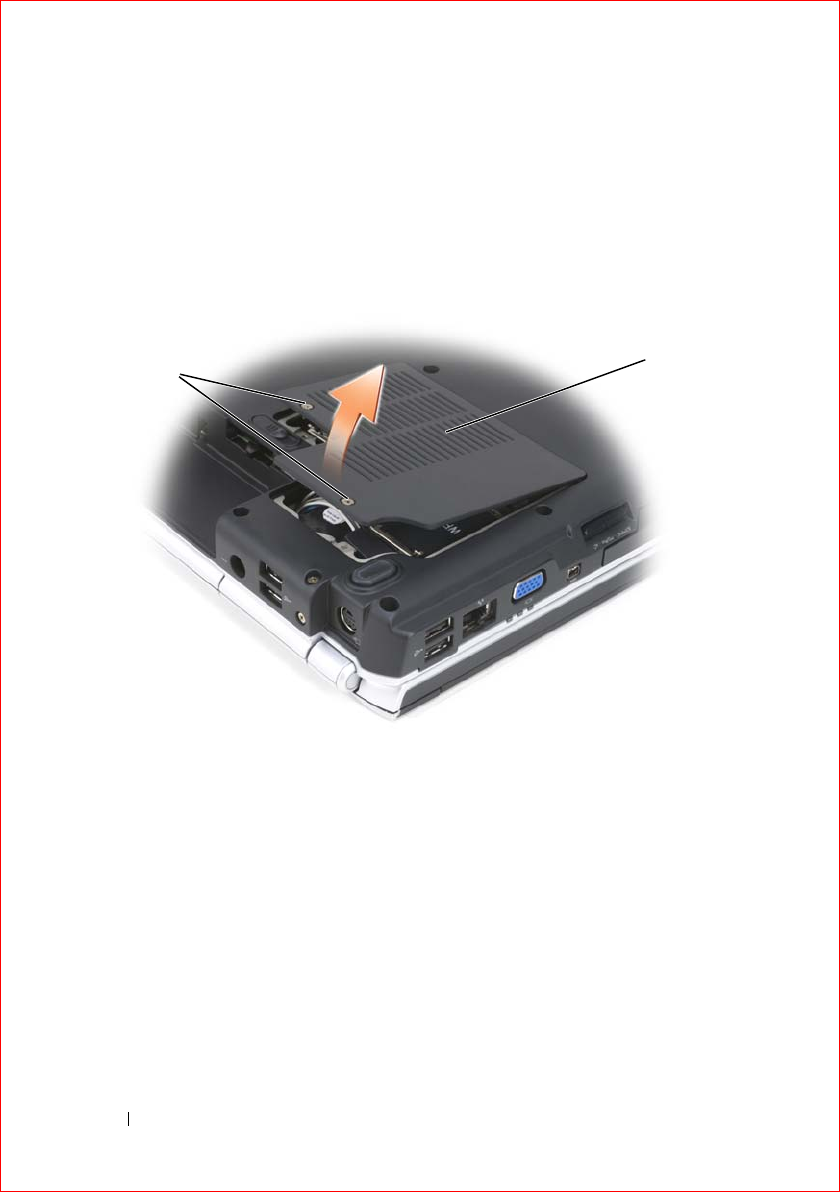
154 Adding and Replacing Parts
FILE LOCATION: S:\systems\Sapporo_Yebisu\Sapporo\OM\A00\EN\parts.fm
DELL CONFIDENTIAL – PRELIMINARY 2/14/07 - FOR PROOF ONLY
Removing a WLAN Card
1
Follow the procedures in "Before You Begin" on page 137.
2
Turn the computer over.
3
Loosen the captive screws on the cover of the Mini Card compartment and
remove the cover.
4
Disconnect the antenna cables from the
WLAN
card.
1 captive screws (2) 2 cover
1
2
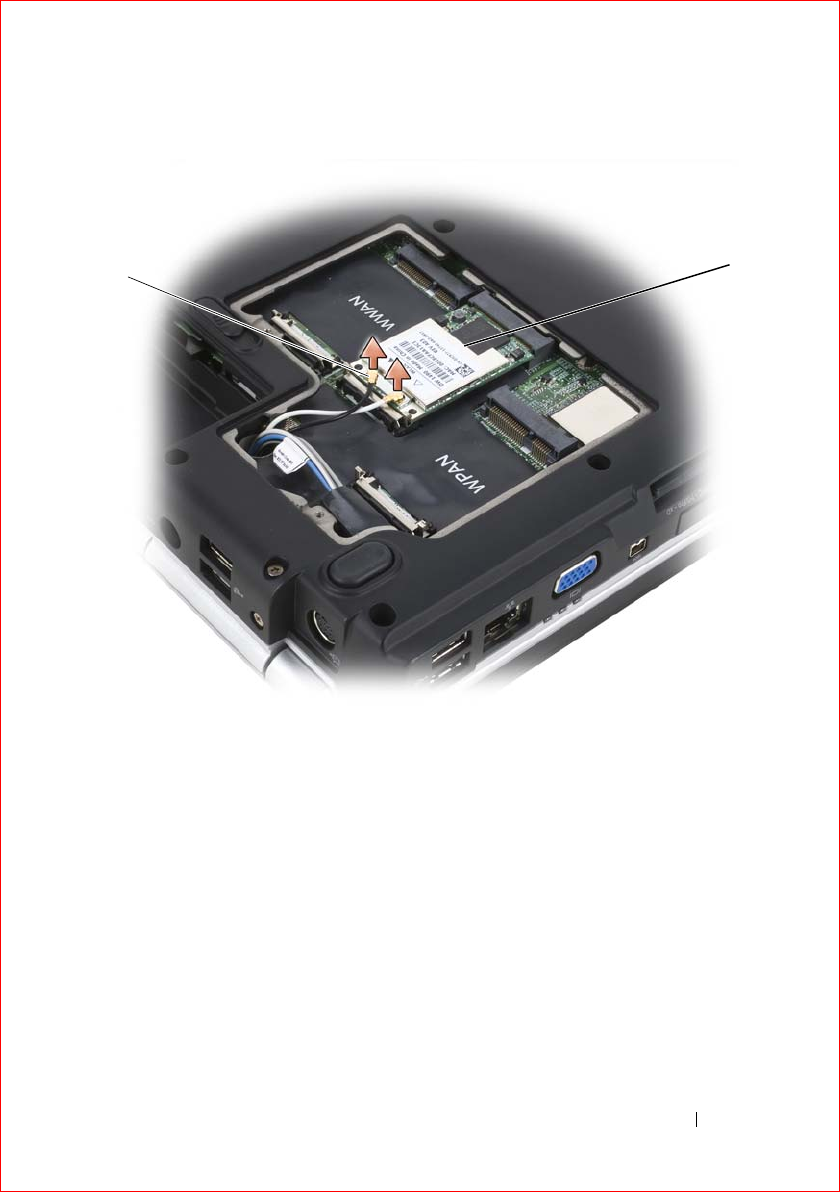
Adding and Replacing Parts 155
FILE LOCATION: S:\systems\Sapporo_Yebisu\Sapporo\OM\A00\EN\parts.fm
DELL CONFIDENTIAL – PRELIMINARY 2/14/07 - FOR PROOF ONLY
5
Release the
WLAN
card by pushing the metal securing tabs toward the back
of the computer until the card pops up slightly.
6
Lift the
WLAN card
out of its system board connector.
1 antenna cable connectors (2) 2 WLAN card
12
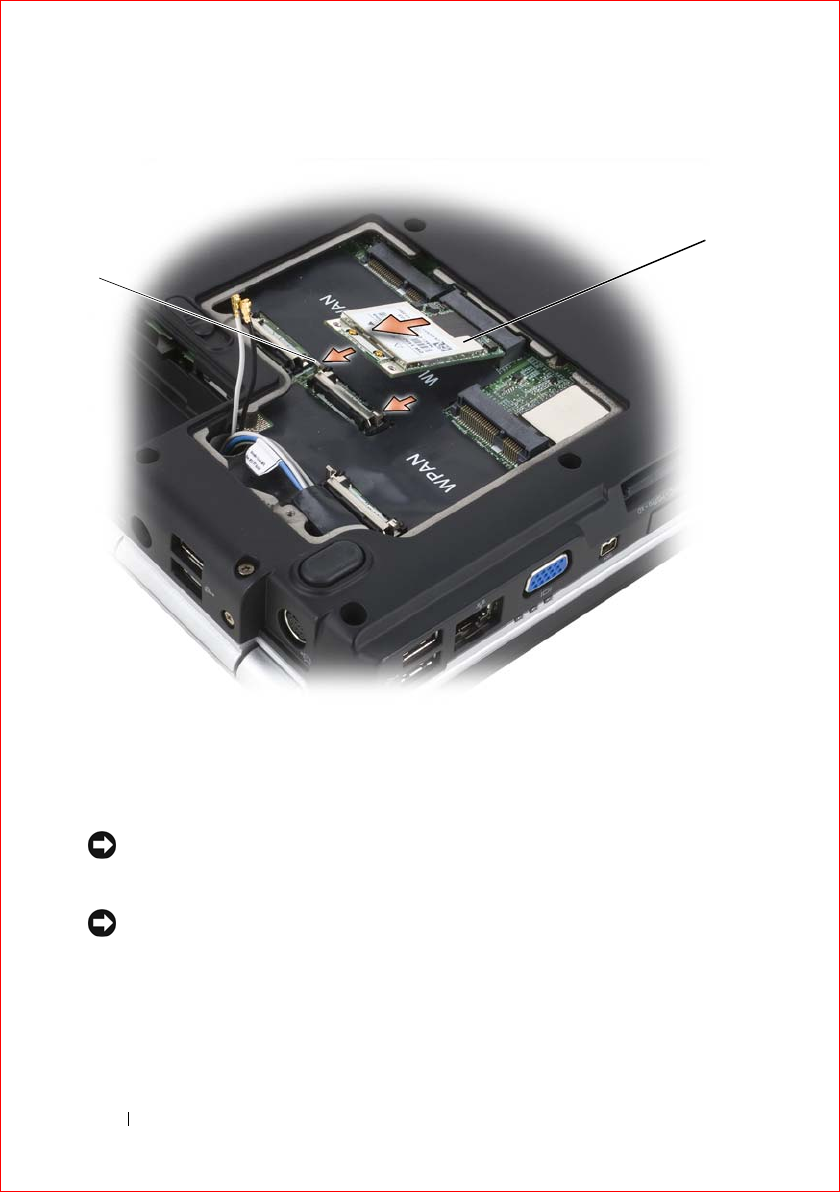
156 Adding and Replacing Parts
FILE LOCATION: S:\systems\Sapporo_Yebisu\Sapporo\OM\A00\EN\parts.fm
DELL CONFIDENTIAL – PRELIMINARY 2/14/07 - FOR PROOF ONLY
Replacing a WLAN Card
NOTICE: The connectors are keyed to ensure correct insertion. If you feel
resistance, check the connectors on the card and on the system board, and realign
the card.
NOTICE: To avoid damage to the WLAN card, never place cables under the card.
1
Insert the
WLAN
card connector into the system board connector labeled
"WLAN" at a 45-degree angle.
2
Press the other end of the
WLAN
card down into the securing tabs until the
card clicks into place.
1 metal securing tabs (2) 2 WLAN card
1
2

Adding and Replacing Parts 157
FILE LOCATION: S:\systems\Sapporo_Yebisu\Sapporo\OM\A00\EN\parts.fm
DELL CONFIDENTIAL – PRELIMINARY 2/14/07 - FOR PROOF ONLY
3
Connect the appropriate antenna cables to the
WLAN
card you are installing:
If the WLAN card has two triangles on the label (white and black), connect
the white antenna cable to the connector labeled "main" (white triangle), and
connect the black antenna cable to the connector labeled "aux" (black
triangle).
If the WLAN card has three triangles on the label (white, black, and gray),
connect the white antenna cable to the white triangle, connect the black
antenna cable to the black triangle, and connect the gray antenna cable to the
gray triangle.
4
Secure unused antenna cables in the protective mylar sleeve.
5
Replace the cover and tighten the captive screws.
Removing a Mobile Broadband or WWAN Card
NOTE: WWAN is also available on an ExpressCard (see "Using ExpressCards" on
page 79).
1
Follow the procedures in "Before You Begin" on page 137.
2
Turn the computer over.
3
Loosen the captive screws on the cover of the Mini Card compartment and
remove the cover.
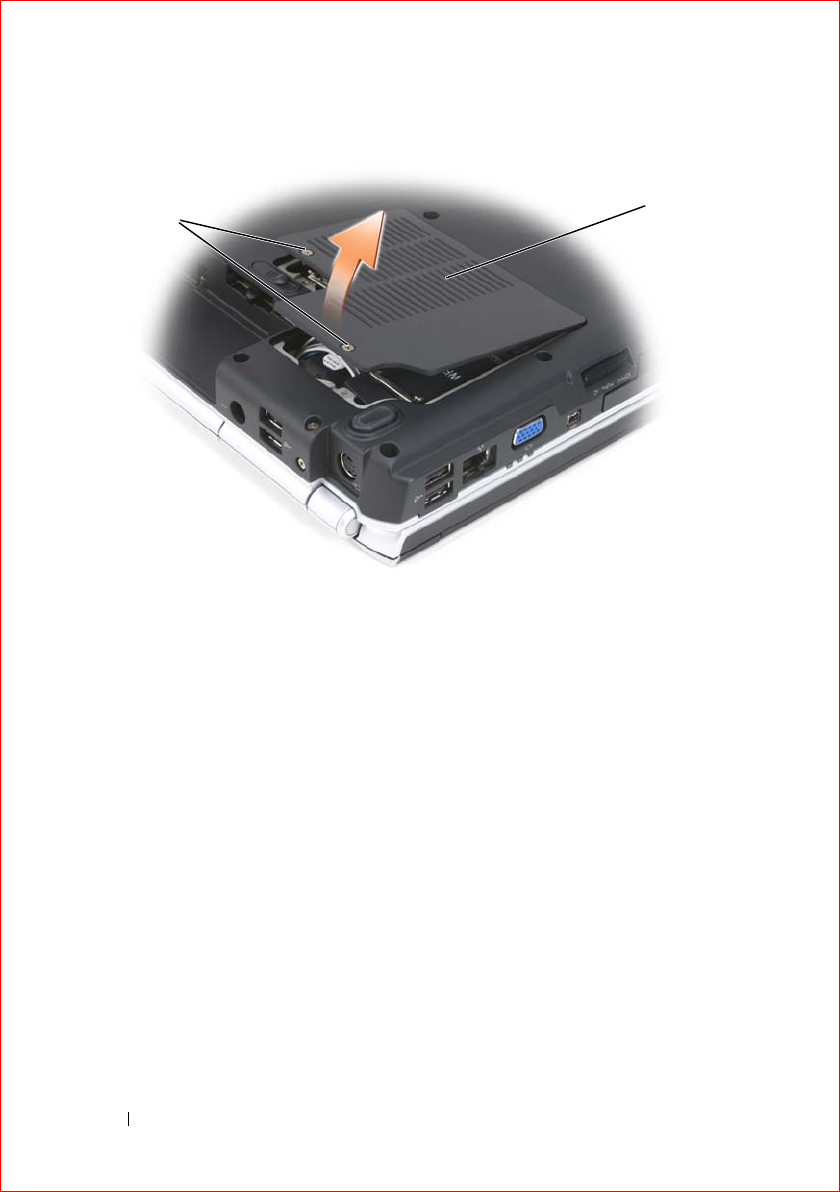
158 Adding and Replacing Parts
FILE LOCATION: S:\systems\Sapporo_Yebisu\Sapporo\OM\A00\EN\parts.fm
DELL CONFIDENTIAL – PRELIMINARY 2/14/07 - FOR PROOF ONLY
4
Disconnect the two antenna cables from the
WWAN
card.
1 captive screws (2) 2 cover
1
2
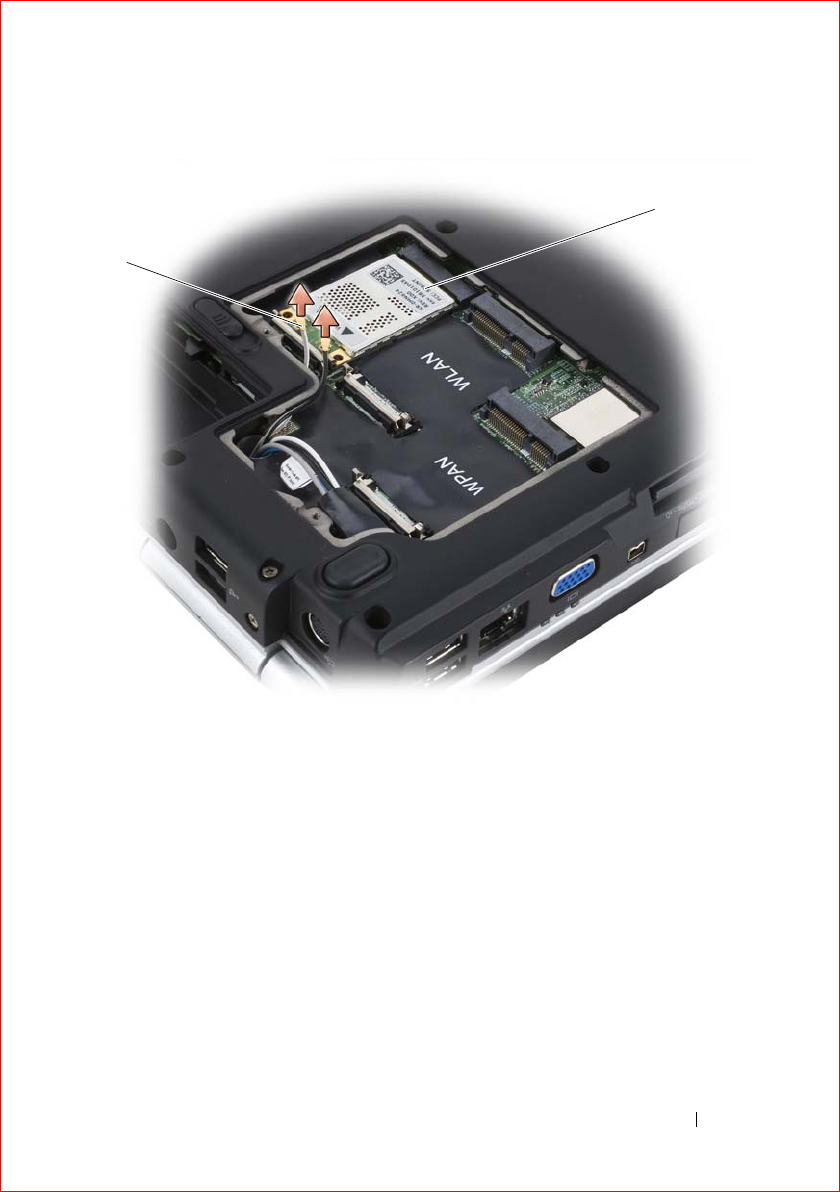
Adding and Replacing Parts 159
FILE LOCATION: S:\systems\Sapporo_Yebisu\Sapporo\OM\A00\EN\parts.fm
DELL CONFIDENTIAL – PRELIMINARY 2/14/07 - FOR PROOF ONLY
5
Release the
WWAN
card by pushing the metal securing tabs toward the back
of the computer until the card pops up slightly.
6
Lift the
WWAN card
out of its system board connector.
1 antenna cable connectors (2) 2 WWAN card
1
2
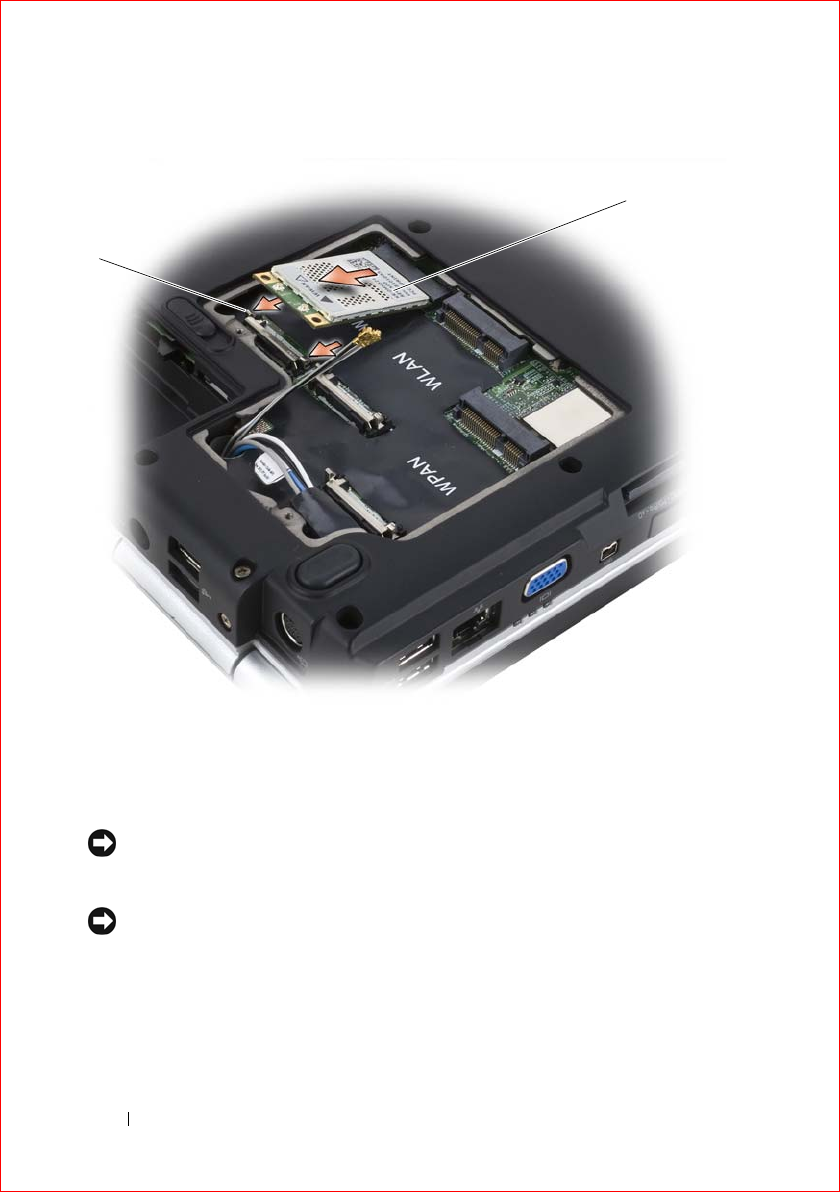
160 Adding and Replacing Parts
FILE LOCATION: S:\systems\Sapporo_Yebisu\Sapporo\OM\A00\EN\parts.fm
DELL CONFIDENTIAL – PRELIMINARY 2/14/07 - FOR PROOF ONLY
Replacing a WWAN Card
NOTICE: The connectors are keyed to ensure correct insertion. If you feel
resistance, check the connectors on the card and on the system board, and realign
the card.
NOTICE: To avoid damage to the WWAN card, never place cables under the card.
1
Insert the
WWAN
card connector into the system board connector labeled
"WWAN" at a 45-degree angle.
2
Press the other end of the
WWAN
card down into the securing tabs until the
card clicks into place.
1 metal securing tabs (2) 2 WWAN card
1
2
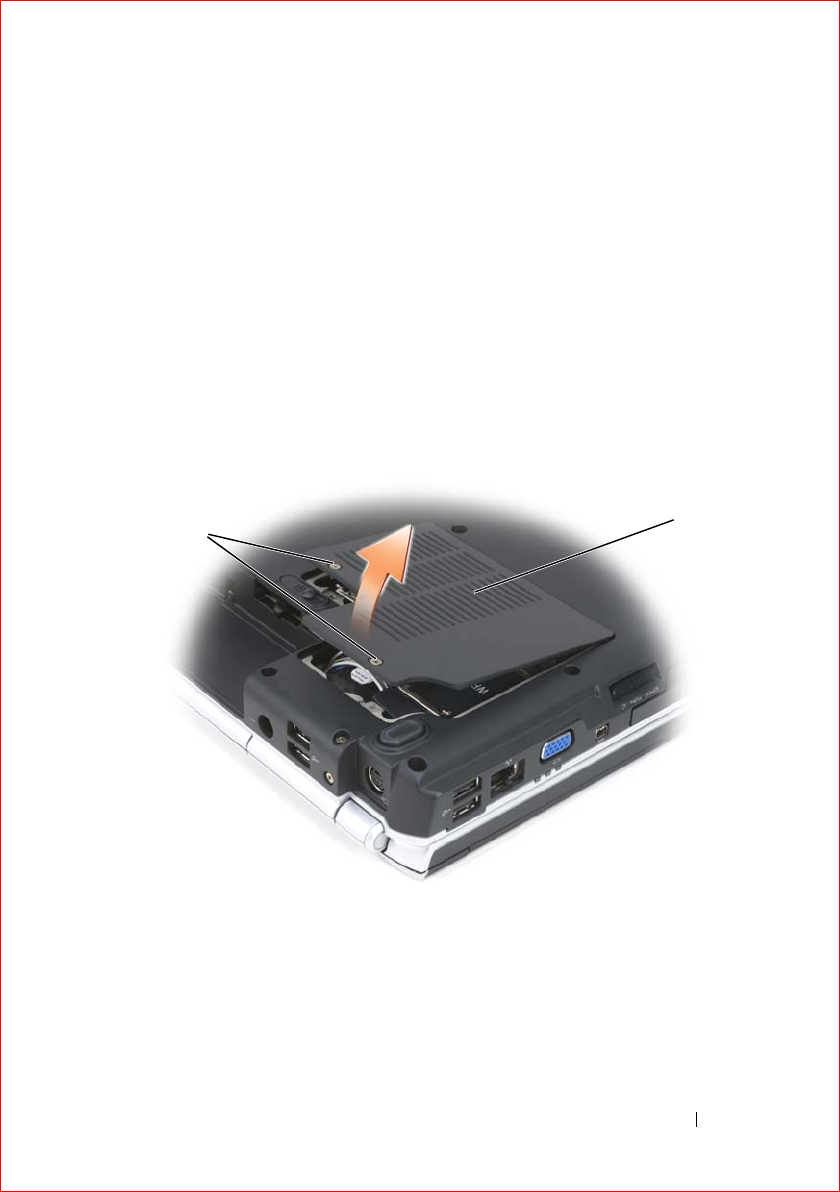
Adding and Replacing Parts 161
FILE LOCATION: S:\systems\Sapporo_Yebisu\Sapporo\OM\A00\EN\parts.fm
DELL CONFIDENTIAL – PRELIMINARY 2/14/07 - FOR PROOF ONLY
3
Connect the black antenna cable with a gray stripe to the connector labeled
"aux" (black triangle) and connect the white antenna cable with a gray stripe
to the connector labeled "main" (white triangle).
4
Secure unused antenna cables in the protective mylar sleeve.
5
Replace the cover and tighten the captive screws.
Removing a WPAN Card
1
Follow the procedures in "Before You Begin" on page 137.
2
Turn the computer over.
3
Loosen the captive screws on the cover of the Mini Card compartment and
remove the cover.
4
Disconnect the blue antenna cable from the
WPAN
card.
5
Release the
WPAN
card by pushing the metal securing tabs toward the back
of the computer until the card pops up slightly.
6
Lift the
WPAN card
out of its system board connector.
1 captive screws (2) 2 cover
1
2

162 Adding and Replacing Parts
FILE LOCATION: S:\systems\Sapporo_Yebisu\Sapporo\OM\A00\EN\parts.fm
DELL CONFIDENTIAL – PRELIMINARY 2/14/07 - FOR PROOF ONLY
Replacing a WPAN Card
NOTICE: The connectors are keyed to ensure correct insertion. If you feel
resistance, check the connectors on the card and on the system board, and realign
the card.
NOTICE: To avoid damage to the WPAN card, never place cables under the card.
1
Insert the
WPAN
card connector into the system board connector labeled
"WPAN" at a 45-degree angle.
2
Press the other end of the
WPAN
card down into the securing tabs until the
card clicks into place.
3
Connect the blue antenna cable to the
WPAN
card.
4
Secure unused antenna cables in the protective mylar sleeve.
5
Replace the cover and tighten the captive screws.
Internal Card With Bluetooth® Wireless
Technology
CAUTION: Before you begin any of the procedures in this section, follow the
safety instructions in the Product Information Guide.
NOTICE: To avoid electrostatic discharge, ground yourself by using a wrist
grounding strap or by periodically touching an unpainted metal surface (such as a
connector on the back of the computer).
NOTICE: To help prevent damage to the system board, you must remove the battery
from the battery bay before you begin working inside the computer.
If you ordered a card with Bluetooth wireless technology with your computer, it
is already installed.
Removing the Card
1
Follow the procedures in "Before You Begin" on page 137.
2
Remove the hinge cover (see "Hinge Cover" on page 143).
3
Disconnect the cable on the card.
4
Grasp the connector end of the card and slide it out from under the securing
tabs.
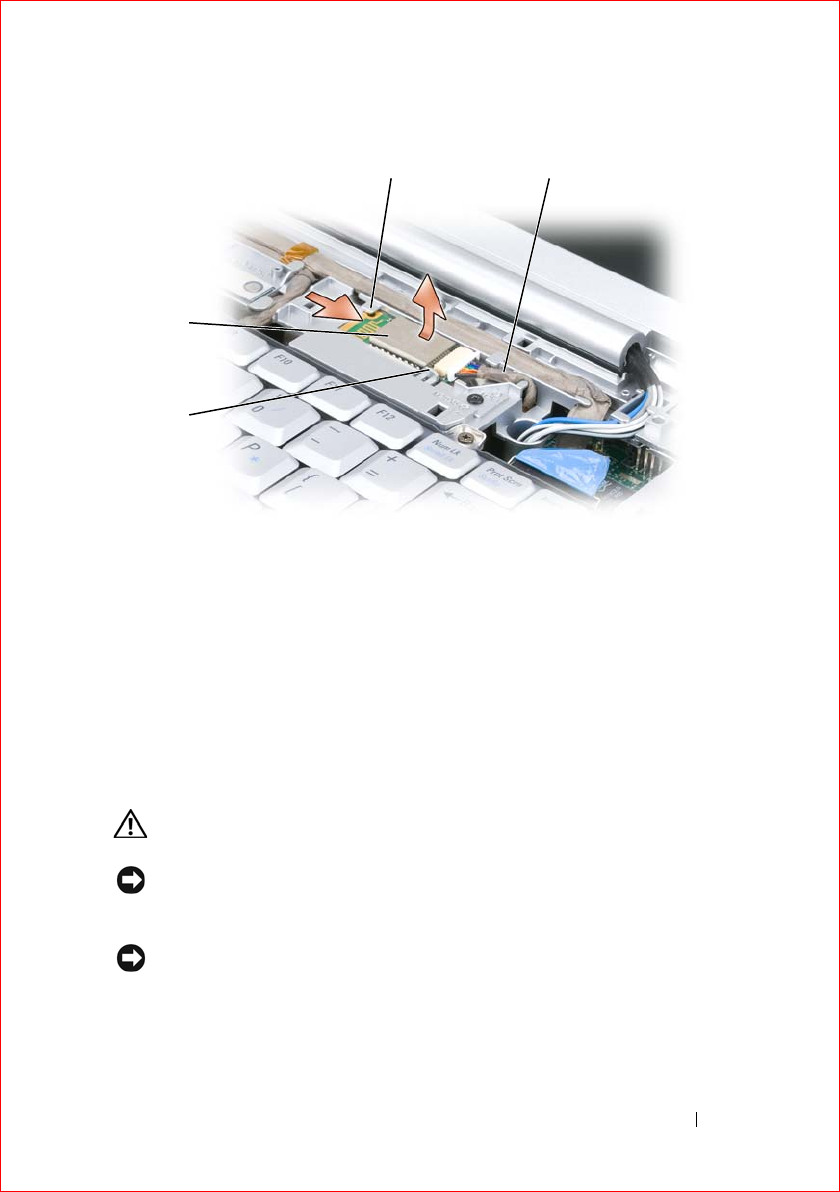
Adding and Replacing Parts 163
FILE LOCATION: S:\systems\Sapporo_Yebisu\Sapporo\OM\A00\EN\parts.fm
DELL CONFIDENTIAL – PRELIMINARY 2/14/07 - FOR PROOF ONLY
Replacing the Card
1
Replace the card at an angle to slide it under the securing tabs in the card
compartment.
2
Connect the cable to the card.
Coin-Cell Battery
CAUTION: Before you begin any of the procedures in this section, follow the
safety instructions in the Product Information Guide.
NOTICE: To avoid electrostatic discharge, ground yourself by using a wrist
grounding strap or by periodically touching an unpainted metal surface (such as a
connector on the back of the computer).
NOTICE: To help prevent damage to the system board, you must remove the battery
from the battery bay before you begin working inside the computer.
Removing the Coin-Cell Battery
1
Follow the procedures in "Before You Begin" on page 137.
1 securing tab 2 card
3 securing tab 4 cable
1
4
2
3
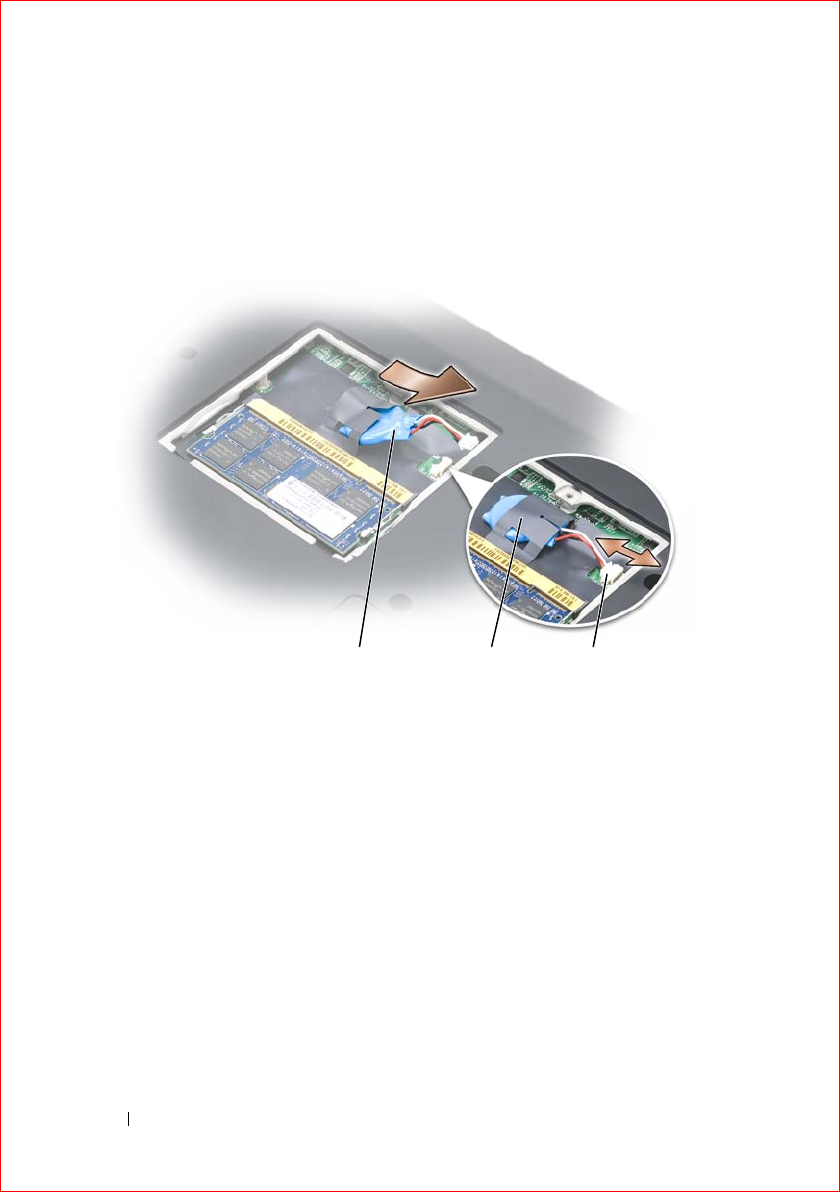
164 Adding and Replacing Parts
FILE LOCATION: S:\systems\Sapporo_Yebisu\Sapporo\OM\A00\EN\parts.fm
DELL CONFIDENTIAL – PRELIMINARY 2/14/07 - FOR PROOF ONLY
2
Turn the computer over.
3
Loosen the captive screw on the memory module/coin-cell battery cover (see
"Bottom View" on page 30), and remove the cover.
4
Disconnect the coin-cell battery cable from the system board.
5
Slide the battery out of the mylar sleeve.
Replacing the Coin-Cell Battery
1
Connect the coin-cell battery cable to the system board.
2
Slide the coin-cell battery into the mylar sleeve.
3
Replace the cover and tighten the captive screw.
1 coin-cell battery 2 mylar sleeve
3 battery cable connector
21 3

Adding and Replacing Parts 165
FILE LOCATION: S:\systems\Sapporo_Yebisu\Sapporo\OM\A00\EN\parts.fm
DELL CONFIDENTIAL – PRELIMINARY 2/14/07 - FOR PROOF ONLY

166 Adding and Replacing Parts
FILE LOCATION: S:\systems\Sapporo_Yebisu\Sapporo\OM\A00\EN\parts.fm
DELL CONFIDENTIAL – PRELIMINARY 2/14/07 - FOR PROOF ONLY

Template Last Updated - 2/7/2007 Dell™ QuickSet Features 167
DELL CONFIDENTIAL – PRELIMINARY 2/14/07 - FOR PROOF ONLY
Dell™ QuickSet Features
NOTE: This feature may not be available on your computer.
Dell QuickSet provides you with easy access to configure or view the following
types of settings:
• Network connectivity
• Power management
•Display
• System information
Depending on what you want to do in Dell QuickSet, you can start it by either
clicking, double-clicking, or right-clicking the QuickSet icon in the Microsoft®
Windows® notification area. The notification area is located in the lower-right
corner of your screen.
For more information about QuickSet, right-click the QuickSet icon and select
Help.

168 Dell™ QuickSet Features
FILE LOCATION: S:\systems\Sapporo_Yebisu\Sapporo\OM\A00\EN\quickset.fm
DELL CONFIDENTIAL – PRELIMINARY 2/14/07 - FOR PROOF ONLY

Template Last Updated - 2/7/2007 Traveling With Your Computer 169
DELL CONFIDENTIAL – PRELIMINARY 2/14/07 - FOR PROOF ONLY
Traveling With Your Computer
Identifying Your Computer
• Attach a name tag or business card to the computer.
• Write down your Service Tag and store it in a safe place away from the
computer or carrying case. Use the Service Tag if you need to report a loss or
theft to law enforcement officials and to Dell.
• Create a file on the Microsoft
®
Windows
®
desktop called
if_found
. Place
information such as your name, address, and phone number in this file.
• Contact your credit card company and ask if it offers coded identification
tags.
Packing the Computer
• Remove any external devices attached to the computer and store them in a
safe place.
• Fully charge the main battery and any spare batteries that you plan to carry
with you.
• Shut down the computer.
• Disconnect the AC adapter.
NOTICE: When the display is closed, extraneous items on the keyboard or palm
rest could damage the display.
• Remove any extraneous items, such as paper clips, pens, and paper, from the
keyboard and palm rest and close the display.
• Use the optional Dell carrying case to pack the computer and its accessories
together safely.
• Avoid packing the computer with items such as shaving cream, colognes,
perfumes, or food.
NOTICE: If the computer has been exposed to extreme temperatures, allow it to
acclimate to room temperature for 1 hour before turning it on.

170 Traveling With Your Computer
FILE LOCATION: S:\systems\Sapporo_Yebisu\Sapporo\OM\A00\EN\travel.fm
DELL CONFIDENTIAL – PRELIMINARY 2/14/07 - FOR PROOF ONLY
• Protect the computer, the batteries, and the hard drive from hazards such as
extreme temperatures and overexposure to sunlight, dirt, dust, or liquids.
• Pack the computer so that it does not slide around in the trunk of your car or
in an overhead storage compartment.
Travel Tips
NOTICE: Do not move the computer while using the optical drive to prevent loss of
data.
NOTICE: Do not check the computer as baggage.
• Consider disabling wireless activity on your computer to maximize battery
operating time. To disable wireless activity, use the wireless switch (see
"wireless switch
" on page 25).
• Consider changing your power management options to maximize battery
operating time (see "Configuring Power Management Settings" on page 50).
• If you are traveling internationally, carry proof of ownership—or of your
right to use the computer if it is company-owned—to speed your passage
through customs. Investigate the customs regulations of the countries you
plan to visit, and consider acquiring an international carnet (also known as a
merchandise passport
) from your government.
• Find out what type of electrical outlets are used in the countries you will
visit, and have appropriate power adapters.
• Check with your credit card company for information about the kinds of
emergency travel assistance it offers to users of portable computers.
Traveling by Air
NOTICE: Do not walk the computer through a metal detector. Send the computer
through an X-ray machine or have it hand-inspected.
• Ensure that you have a charged battery available in case you are asked to turn
on the computer.
• Prior to entering the airplane, verify that using a computer is permitted. Some
airlines forbid the use of electronic devices during flight. All airlines forbid
the use of electronic devices during takeoff and landing.

Template Last Updated - 2/7/2007 Getting Help 171
DELL CONFIDENTIAL – PRELIMINARY 2/14/07 - FOR PROOF ONLY
Getting Help
Obtaining Assistance
CAUTION: If you need to remove the computer cover, first disconnect the
computer power and modem cables from all electrical outlets.
If you experience a problem with your computer, you can complete the
following steps to diagnose and troubleshoot the problem:
1
See "Troubleshooting" on page 101 for information and procedures that
pertain to the problem your computer is experiencing.
2
See "Dell Diagnostics" on page 101 for procedures on how to run Dell
Diagnostics.
3
Fill out the "Diagnostics Checklist" on page 176.
4
Use Dell's extensive suite of online services available at Dell Support
(
support.dell.com
) for help with installation and troubleshooting
procedures. See "Online Services" on page 172 for a more extensive list of
Dell Support online.
5
If the preceding steps have not resolved the problem, see "Contacting Dell"
on page 177.
NOTE: Call Dell Support from a telephone near or at the computer so that the
support staff can assist you with any necessary procedures.
NOTE: Dell's Express Service Code system may not be available in all countries.
When prompted by Dell's automated telephone system, enter your Express
Service Code to route the call directly to the proper support personnel. If you do
not have an Express Service Code, open the Dell Accessories folder, double-
click the Express Service Code icon, and follow the directions.
For instructions on using the Dell Support, see "Technical Support and
Customer Service" on page 172.
NOTE: Some of the following services are not always available in all locations
outside the continental U.S. Call your local Dell representative for information on
availability.

172 Getting Help
FILE LOCATION: S:\systems\Sapporo_Yebisu\Sapporo\OM\A00\EN\contact.fm
DELL CONFIDENTIAL – PRELIMINARY 2/14/07 - FOR PROOF ONLY
Technical Support and Customer Service
Dell's support service is available to answer your questions about Dell™
hardware. Our support staff uses computer-based diagnostics to provide fast,
accurate answers.
To contact Dell's support service, see "Before You Call" on page 174, and then
see the contact information for your region or go to support.dell.com.
DellConnect
DellConnect is a simple online access tool that allows a Dell service and support
associate to access your computer through a broadband connection, diagnose
your problem and repair it all under your supervision. For more information, go
to support.dell.com and click DellConnect.
Online Services
You can learn about Dell products and services on the following websites:
www.dell.com
www.dell.com/ap
(Asian/Pacific countries only)
www.dell.com/jp
(Japan only)
www.euro.dell.com
(Europe only)
www.dell.com/la
(Latin American and Caribbean countries)
www.dell.ca
(Canada only)
You can access Dell Support through the following websites and e-mail
addresses:
• Dell Support websites
support.dell.com
support.jp.dell.com
(Japan only)
support.euro.dell.com
(Europe only)
• Dell Support e-mail addresses
mobile_support@us.dell.com
support@us.dell.com

Getting Help 173
FILE LOCATION: S:\systems\Sapporo_Yebisu\Sapporo\OM\A00\EN\contact.fm
DELL CONFIDENTIAL – PRELIMINARY 2/14/07 - FOR PROOF ONLY
la-techsupport@dell.com (Latin America and Caribbean countries only)
apsupport@dell.com
(Asian/Pacific countries only)
• Dell Marketing and Sales e-mail addresses
apmarketing@dell.com
(Asian/Pacific countries only)
sales_canada@dell.com (Canada only)
• Anonymous file transfer protocol (FTP)
ftp.dell.com
Log in as user:
anonymous
, and use your e-mail address as your password.
AutoTech Service
Dell's automated support service—AutoTech—provides recorded answers to the
questions most frequently asked by Dell customers about their portable and
desktop computers.
When you call AutoTech, use your touch-tone telephone to select the subjects
that correspond to your questions. For the telephone number to call for your
region, see "Contacting Dell" on page 177.
Automated Order-Status Service
To check on the status of any Dell products that you have ordered, you can go to
support.dell.com, or you can call the automated order-status service. A
recording prompts you for the information needed to locate and report on your
order. For the telephone number to call for your region, see "Contacting Dell" on
page 177.
Problems With Your Order
If you have a problem with your order, such as missing parts, wrong parts, or
incorrect billing, contact Dell for customer assistance. Have your invoice or
packing slip handy when you call. For the telephone number to call for your
region, see "Contacting Dell" on page 177.

174 Getting Help
FILE LOCATION: S:\systems\Sapporo_Yebisu\Sapporo\OM\A00\EN\contact.fm
DELL CONFIDENTIAL – PRELIMINARY 2/14/07 - FOR PROOF ONLY
Product Information
If you need information about additional products available from Dell, or if you
would like to place an order, visit the Dell website at www.dell.com. For the
telephone number to call for your region or to speak to a sales specialist, see the
"Contacting Dell" on page 177.
Returning Items for Warranty Repair or Credit
Prepare all items being returned, whether for repair or credit, as follows:
1
Call Dell to obtain a Return Material Authorization Number, and write it
clearly and prominently on the outside of the box.
For the telephone number to call for your region, see "Contacting Dell" on
page 177.
2
Include a copy of the invoice and a letter describing the reason for the return.
3
Include a copy of the Diagnostics Checklist (see "Diagnostics Checklist" on
page 176), indicating the tests that you have run and any error messages
reported by the Dell Diagnostics (see "Dell Diagnostics" on page 101).
4
Include any accessories that belong with the item(s) being returned (power
cables, software floppy disks, guides, and so on) if the return is for credit.
5
Pack the equipment to be returned in the original (or equivalent) packing
materials.
You are responsible for paying shipping expenses. You are also responsible for
insuring any product returned, and you assume the risk of loss during shipment
to Dell. Collect On Delivery (C.O.D.) packages are not accepted.
Returns that are missing any of the preceding requirements will be refused at
Dell’s receiving dock and returned to you.
Before You Call
NOTE: Have your Express Service Code ready when you call. The code helps Dell’s
automated-support telephone system direct your call more efficiently. You may also
be asked for your Service Tag (located on the back or bottom of your computer).
Remember to fill out the Diagnostics Checklist (see "Diagnostics Checklist" on
page 176). If possible, turn on your computer before you call Dell for assistance
and call from a telephone at or near the computer. You may be asked to type

Getting Help 175
FILE LOCATION: S:\systems\Sapporo_Yebisu\Sapporo\OM\A00\EN\contact.fm
DELL CONFIDENTIAL – PRELIMINARY 2/14/07 - FOR PROOF ONLY
some commands at the keyboard, relay detailed information during operations,
or try other troubleshooting steps possible only at the computer itself. Ensure
that the computer documentation is available.
CAUTION: Before working inside your computer, follow the safety instructions in
your Product Information Guide.

176 Getting Help
FILE LOCATION: S:\systems\Sapporo_Yebisu\Sapporo\OM\A00\EN\contact.fm
DELL CONFIDENTIAL – PRELIMINARY 2/14/07 - FOR PROOF ONLY
Diagnostics Checklist
Name:
Date:
Address:
Phone number:
Service Tag (bar code on the back or bottom of the computer):
Express Service Code:
Return Material Authorization Number (if provided by Dell support technician):
Operating system and version:
Devices:
Expansion cards:
Are you connected to a network? Yes No
Network, version, and network adapter:
Programs and versions:
See your operating system documentation to determine the contents of the system’s
start-up files. If the computer is connected to a printer, print each file. Otherwise,
record the contents of each file before calling Dell.
Error message, beep code, or diagnostic code:
Description of problem and troubleshooting procedures you performed:

Getting Help 177
FILE LOCATION: S:\systems\Sapporo_Yebisu\Sapporo\OM\A00\EN\contact.fm
DELL CONFIDENTIAL – PRELIMINARY 2/14/07 - FOR PROOF ONLY
Contacting Dell
To contact Dell for sales, support, or customer care issues:
NOTE: If you do not have an active Internet connection, you can find contact
information on your purchase invoice, packing slip, bill, or Dell product catalog.
1
Visit www.support.dell.com.
2
At the bottom of the page, verify your country or region.
3
Locate the
Browse by Category
section on the left side of the page and click
Contact Us
.
4
Follow the instructions to access the most appropriate phone number or Dell
resource link.

178 Getting Help
FILE LOCATION: S:\systems\Sapporo_Yebisu\Sapporo\OM\A00\EN\contact.fm
DELL CONFIDENTIAL – PRELIMINARY 2/14/07 - FOR PROOF ONLY

Template Last Updated - 2/7/2007 Specifications 179
DELL CONFIDENTIAL – PRELIMINARY 2/14/07 - FOR PROOF ONLY
Specifications
NOTE: Offerings may vary by region. For more information regarding the
configuration of your computer, click Start , click Help and Support, and then
select the option to view information about your computer.
Processor
Processor type AMD® Turion™ 64 X2 Dual-Core Mobile
Technology
L1 cache 256 KB (2 x 128 KB)
L2 cache 1 MB (2 x 512 KB)
External bus frequency 1600 MHz and HyperTransport
System Information
System chipset ATI 690T/SB600
Data bus width 64 bits
DRAM bus width dual-channel (2) 64-bit buses
Processor address bus width 32 bits
Flash EPROM 1 MB
Graphics bus PCI-E X16
PCI bus 32 bits
ExpressCard
NOTE: The ExpressCard slot is designed only for ExpressCards. It does NOT support
PC Cards.
NOTE: PCMCIA may not be available in some regions.
ExpressCard controller AMD RS690T
ExpressCard connector one ExpressCard slot (54 mm)

180 Specifications
FILE LOCATION: S:\systems\Sapporo_Yebisu\Sapporo\OM\A00\EN\specs.fm
DELL CONFIDENTIAL – PRELIMINARY 2/14/07 - FOR PROOF ONLY
Cards supported ExpressCard/34 (34 mm)
ExpressCard/54 (54 mm)
1.5 V and 3.3 V
ExpressCard connector size 26 pins
8-in-1 Memory Card Reader
8-in-1 memory card controller Ricoh R5C833
8-in-1 memory card connector 8-in-1 combo card connector
Cards supported
• Secure Digital (SD)
•SDIO
• MultiMediaCard (MMC)
• Memory Stick
• Memory Stick PRO
• xD-Picture Card
• Hi Speed-SD
• Hi Capacity-SD
Memory
Memory module connector two SODIMM connectors
Memory module capacities 512 MB, 1 GB, 2 GB
Memory type 667 MHz SoDIMM DDR2
Minimum memory 1 GB
Maximum memory 4 GB
NOTE: In order to take advantage of the dual channel bandwidth capability, both
memory slots must be populated and must match in size.
NOTE: The available memory displayed does not reflect the complete maximum
memory installed because some memory is reserved for system files.
Ports and Connectors
Audio microphone connector, stereo
headphone/speakers connector
IEEE 1394 4-pin serial connector
ExpressCard (continued)

Specifications 181
FILE LOCATION: S:\systems\Sapporo_Yebisu\Sapporo\OM\A00\EN\specs.fm
DELL CONFIDENTIAL – PRELIMINARY 2/14/07 - FOR PROOF ONLY
Consumer IR sensor compatible with Philips RC6 (receive
only)
Mini Card three Type IIIA Mini-Card slots
Modem RJ-11 port
Network adapter RJ-45 port
S-video TV-out 7-pin mini-DIN connector (optional S-video
to composite video adapter cable)
USB four 4-pin USB 2.0-compliant connector
Video 15-hole connector
Communications
Modem:
Type
v.92 56K MDC
Controller
softmodem
Interface
Intel High-Definition Audio
Network adapter 10/100 Ethernet LAN on system board
Wireless internal WLAN, WWAN, WPAN Mini Cards
WWAN ExpressCard
Bluetooth® wireless technology
Video
Video type: integrated ATI graphics with 64 MB local
frame buffer
Video controller
ATI Radeon® Xpress 1270
Video memory
Up to 256 MB of shared memory (64 MB
dedicated local frame buffer)
LCD interface
LVDS
TV support
NTSC or PAL in S-video, composite, and
component modes
Ports and Connectors (continued)

182 Specifications
FILE LOCATION: S:\systems\Sapporo_Yebisu\Sapporo\OM\A00\EN\specs.fm
DELL CONFIDENTIAL – PRELIMINARY 2/14/07 - FOR PROOF ONLY
Audio
Audio type two-channel high-definition audio codec
Audio controller Sigmatel STAC9205 Codec
Stereo conversion 24-bit (analog-to-digital and digital-to-
analog)
Interfaces:
Internal
Intel High Definition Audio
External
microphone-in connector, stereo
headphones/speakers connector
Speaker two 4-ohm speakers
Internal speaker amplifier 2 Watts per channel into 4 ohms
Volume controls keyboard shortcuts, program menus, media
control buttons
Display
Type (active-matrix TFT) 15.4-inch WXGA
15.4-inch WXGA with TrueLife
15.4-inch WXGA+ with TrueLife
15.4-inch WSXGA+ with TrueLife
Dimensions:
Height
222.5 mm (8.8 in)
Width
344.5 mm (13.6 in)
Diagonal
391.2 mm (15.4 in)
Maximum resolutions:
WXGA
1280 x 800 at 16.7 million colors
WXGA+ with TrueLife
1440 x 900 at 16.7 million colors
WSXGA+
1680 x 1050 at 16.7 million colors
Refresh rate 60 Hz
Operating angle 0° (closed) to 155°
Viewing angles:

Specifications 183
FILE LOCATION: S:\systems\Sapporo_Yebisu\Sapporo\OM\A00\EN\specs.fm
DELL CONFIDENTIAL – PRELIMINARY 2/14/07 - FOR PROOF ONLY
Horizontal
±40° (WXGA) typical
±65° (WSXGA+)
Vertical
+15°/–30° (WXGA)
±50° (WSXGA+)
Pixel pitch:
WXGA
0.258 mm
WXGA+
0.23 mm
WSXGA+
0.197 mm
Controls brightness can be controlled through keyboard
shortcuts (see "Display Functions" on
page 42)
Keyboard
Number of keys 87 (U.S. and Canada); 88 (Europe); 91
(Japan)
Layout QWERTY/AZERTY/Kanji
Touch Pad
X/Y position resolution (graphics table
mode) 240 cpi
Size:
Width
71.7-mm (2.8-in) sensor-active area
Height
34.0-mm (1.3-in) rectangle
Battery
Type 9-cell "smart" lithium ion
6-cell "smart" lithium ion
Dimensions:
Depth
67.6 mm (2.66 in) (9 cell)
47.5 mm (1.87 in) (6 cell)
Height
20.4 mm (0.8 in)
Display (continued)

184 Specifications
FILE LOCATION: S:\systems\Sapporo_Yebisu\Sapporo\OM\A00\EN\specs.fm
DELL CONFIDENTIAL – PRELIMINARY 2/14/07 - FOR PROOF ONLY
Width
209.9 mm (8.26 in)
Weight 0.48 kg (1.06 lb) (9 cell)
0.32 kg (0.7 lb) (6 cell)
Voltage 11.1 VDC
Charge time (approximate):
Computer off
4 hours
Operating time Battery operating time varies depending on
operating conditions and can be significantly
reduced under certain power-intensive
conditions (see "Power Problems" on
page 121).
See "Using a Battery" on page 47 for more
information on battery life.
Life span (approximate) 300 discharge/charge cycles
Battery (continued)

Specifications 185
FILE LOCATION: S:\systems\Sapporo_Yebisu\Sapporo\OM\A00\EN\specs.fm
DELL CONFIDENTIAL – PRELIMINARY 2/14/07 - FOR PROOF ONLY
Temperature range:
Operating
0° to 35°C (32° to 95°F)
Storage
–40° to 65°C (–40° to 149°F)
Coin-cell battery CR-2032
AC Adapter
Input voltage 90–264 VAC
Input current (maximum) 1.5 A
Input frequency 47–63 Hz
Output current (65 W) 4.34 A (maximum at 4-second pulse)
3.34 A (65 W) (continuous)
Output current (90 W) 5.62 A (maximum at 4-second pulse)
4.62 A (90 W) (continuous)
Output power 65 W, 90 W
Rated output voltage 19.5 +/– 1.0 VDC
Dimensions (65 W):
Height
28.2 mm (1.11 in)
Width
57.9 mm (2.28 in)
Depth
137.2 mm (5.4 in)
Weight (with cables)
0.4 kg (0.9 lb)
Dimensions (90 W):
Height
34.2 mm (1.34 in)
Width
60.8 mm (2.39 in)
Depth
153.4 mm (6.0 in)
Weight (with cables)
0.46 kg (1.01 lb)
Temperature range:
Operating
0° to 35°C (32° to 95°F)
Storage
–40° to 65°C (–40° to 149°F)
Battery (continued)

186 Specifications
FILE LOCATION: S:\systems\Sapporo_Yebisu\Sapporo\OM\A00\EN\specs.fm
DELL CONFIDENTIAL – PRELIMINARY 2/14/07 - FOR PROOF ONLY
Physical
Height 42 mm (1.65 in)
Width 358.7 mm (14.12 in)
Depth 269 mm (10.59 in)
Weight (with 6-cell battery):
Configurable to less than
3.0 kg (6.61 lb)
Environmental
Temperature range:
Operating
0° to 35°C (32° to 95°F)
Storage
–40° to 65°C (–40° to 149°F)
Relative humidity (maximum):
Operating
10% to 90% (noncondensing)
Storage
5% to 95% (noncondensing)
Maximum vibration (using a random
vibration spectrum that simulates user
environment):
Operating
0.66 GRMS
Storage
1.3 GRMS
Maximum shock (Measured with hard
drive in operating status and a 2-ms
half-sine pulse for operating. Also
measured with hard drive in head-
parked position and a 2-ms halfsine
pluse for storage):
Operating
142 G
Storage
163 G
Altitude (maximum):
Operating
–15.2 to 3048 m (–50 to 10,000 ft)
Storage
–15.2 to 10,668 m (–50 to 35,000 ft)

Template Last Updated - 2/7/2007 Appendix 187
DELL CONFIDENTIAL – PRELIMINARY 2/14/07 - FOR PROOF ONLY
Appendix
Using the System Setup Program
NOTE: Your operating system may automatically configure most of the options
available in system setup, thus overriding options that you set through system setup.
An exception is the External Hot Key option, which you can disable or enable only
through system setup. For more information on configuring features for your
operating system, see Windows Help and Support (click Start , and then click
Help and Support).
You can use system setup as follows:
• To set or change user-selectable features such as your computer password
• To verify information about the computer's current configuration such as the
amount of system memory
After you set up the computer, run system setup to familiarize yourself with
your system configuration information and optional settings. You may want to
write down the information for future reference.
The system setup screens display the current setup information and settings for
your computer, such as:
• System configuration
• Boot order
• Boot (start-up) configuration
• Basic device configuration settings
• System security and hard drive password settings
NOTE: Unless you are an expert computer user or are directed to do so by Dell
technical support, do not change the system setup settings. Certain changes might
make your computer work incorrectly.
Viewing the System Setup Screen
1
Turn on (or restart) your computer.
2
When the DELL logo appears, press <F2> immediately.

188 Appendix
FILE LOCATION: S:\systems\Sapporo_Yebisu\Sapporo\OM\A00\EN\appendix.fm
DELL CONFIDENTIAL – PRELIMINARY 2/14/07 - FOR PROOF ONLY
If you wait too long and the Microsoft Windows logo appears, continue to
wait until you see the Windows desktop, then shut down your computer and
try again.
System Setup Screen
NOTE: For information about a specific item on a system setup screen, highlight the
item and see the Help area on the screen.
On each screen, the system setup options are listed at the left. To the right of
each option is the setting or value for that option. You can change settings that
appear as white type on the screen. Options or values that you cannot change
(because they are determined by the computer) appear less bright.
The upper-right corner of the screen displays help information for the currently
highlighted option; the lower-right corner displays information about the
computer. System setup key functions are listed across the bottom of the screen.
Commonly Used Options
Certain options require that you reboot the computer for new settings to take
effect.
Changing the Boot Sequence
The boot sequence, or boot order, tells the computer where to look to find the
software needed to start the operating system. You can control the boot sequence
and enable/disable devices using the Boot Order page of the system setup
program.
NOTE: To change the boot sequence on a one-time-only basis, see "Performing a
One-Time Boot" on page 189.
The Boot Order page displays a general list of the bootable devices that may be
installed in your computer, including but not limited to the following:
• Diskette Drive
• Internal HDD
• USB Storage Device
• CD/DVD/CD-RW drive
• Modular bay HDD
NOTE: Only devices that are preceded by a number are bootable.

Appendix 189
FILE LOCATION: S:\systems\Sapporo_Yebisu\Sapporo\OM\A00\EN\appendix.fm
DELL CONFIDENTIAL – PRELIMINARY 2/14/07 - FOR PROOF ONLY
During the boot routine, the computer starts at the top of the list and scans each
enabled device for the operating system start-up files. When the computer finds
the files, it stops searching and starts the operating system.
To control the boot devices, select (highlight) a device by pressing the down-
arrow or up-arrow key, and then enable or disable the device or change its order
in the list.
• To enable or disable a device, highlight the item and press the space bar.
Enabled items are preceded by a number; disabled items are not preceded by
a number.
• To reorder a device in the list, highlight the device and press <u> to move the
device up the list or <d> to move a device down the list.
Boot sequence changes take effect as soon as you save the changes and exit the
system setup program.
Performing a One-Time Boot
You can set a one-time-only boot sequence without entering the system setup
program (you can also use this procedure to boot the Dell Diagnostics on the
diagnostics utility partition on your hard drive).
1
Shut down the computer through the
Start
menu.
2
Connect the computer to an electrical outlet.
3
Turn on the computer. When the DELL logo appears, press <F12>
immediately.
If you wait too long and the Windows logo appears, continue to wait until
you see the Windows desktop, then shut down your computer and try again.
4
When the boot device list appears, highlight the device from which you want
to boot and press <Enter>.
The computer boots to the selected device.
The next time you reboot the computer, the previous boot order is restored.
Cleaning Your Computer
CAUTION: Before you begin any of the procedures in this section, follow the
safety instructions located in the Product Information Guide.

190 Appendix
FILE LOCATION: S:\systems\Sapporo_Yebisu\Sapporo\OM\A00\EN\appendix.fm
DELL CONFIDENTIAL – PRELIMINARY 2/14/07 - FOR PROOF ONLY
Computer, Keyboard, and Display
CAUTION: Before you clean your computer, disconnect the computer from the
electrical outlet and remove any installed batteries. Clean your computer with a
soft cloth dampened with water. Do not use liquid or aerosol cleaners, which may
contain flammable substances.
• Use a can of compressed air to remove dust from between the keys on the
keyboard and to remove any dirt or lint from the display.
NOTICE: To help prevent damage to the computer or display, do not spray cleaning
solution directly onto the display. Only use products specifically designed for
cleaning displays, and follow the instructions that are included with the product.
• Moisten a soft, lint-free cloth with either water or a display cleaner. Do not
use alcohol or an ammonia-based cleaner. Wipe the display gently working
from the center to the edges until it is clean and any fingerprints are removed.
Do not use excessive pressure.
NOTICE: To prevent damage to the antiglare coating, do not wipe the display with
soap or alcohol.
• Moisten a soft, lint-free cloth with water and wipe the computer and
keyboard. Do not allow water from the cloth to seep between the touch pad
and the surrounding palm rest.
• To clean your monitor screen, lightly dampen a soft, clean cloth with water.
You can also use a special screen-cleaning tissue or solution suitable for the
monitor’s antistatic coating.
• Wipe the keyboard, computer, and monitor plastics with a soft cleaning cloth
moistened with a solution of three parts water and one part dishwashing
detergent.
Do not soak the cloth or let water drip inside your computer or keyboard.
Touch Pad
1
Shut down and turn off your computer (see "Turning Off Your Computer" on
page 137).
2
Disconnect any attached devices from the computer and from their electrical
outlets.
3
Remove any installed batteries (see "Battery Performance" on page 47).

Appendix 191
FILE LOCATION: S:\systems\Sapporo_Yebisu\Sapporo\OM\A00\EN\appendix.fm
DELL CONFIDENTIAL – PRELIMINARY 2/14/07 - FOR PROOF ONLY
4
Moisten a soft, lint-free cloth with water, and wipe it gently across the
surface of the touch pad. Do not allow water from the cloth to seep between
the touch pad and the surrounding palm rest.
Mouse
NOTICE: Disconnect the mouse from the computer before cleaning the mouse
If your screen cursor skips or moves abnormally, clean the mouse.
Cleaning a Non-Optical Mouse
1
Clean the outside casing of the mouse with a cloth moistened with a mild
cleaning solution.
2
Turn the retainer ring on the underside of your mouse counterclockwise, and
then remove the ball.
3
Wipe the ball with a clean, lint-free cloth.
4
Blow carefully into the ball cage or use a can of compressed air to dislodge
dust and lint.
5
If the rollers inside the ball cage are dirty, clean the rollers with a cotton swab
moistened lightly with isopropyl alcohol.
6
Recenter the rollers in their channels if they are misaligned. Ensure that fluff
from the swab is not left on the rollers.
7
Replace the ball and retainer ring, and turn the retainer ring clockwise until it
clicks into place.
Cleaning an Optical Mouse
8
Clean the outside casing of the mouse with a cloth moistened with a mild
cleaning solution.
Media
NOTICE: Always use compressed air to clean the lens in the optical drive, and
follow the instructions that come with the compressed air product. Never touch the
lens in the drive.
If you notice problems, such as skipping, with the playback quality of your
media, try cleaning the discs.

192 Appendix
FILE LOCATION: S:\systems\Sapporo_Yebisu\Sapporo\OM\A00\EN\appendix.fm
DELL CONFIDENTIAL – PRELIMINARY 2/14/07 - FOR PROOF ONLY
1
Hold the disc by its outer edge. You can also touch the inside edge of the
center hole.
NOTICE: To help prevent damage to the surface, do not wipe in a circular motion
around the disc.
2
With a soft, lint-free cloth, gently wipe the bottom of the disc (the unlabeled
side) in a straight line from the center to the outer edge of the disc.
For stubborn dirt, try using water or a diluted solution of water and mild
soap. You can also purchase commercial products that clean discs and
provide some protection from dust, fingerprints, and scratches. Cleaning
products for CDs are also safe to use on DVDs.
Dell Technical Support Policy (U.S. Only)
Technician assisted technical support requires the cooperation and participation
of the customer in the troubleshooting process and provides for restoration of
the operating system, software programs, and hardware drivers to the original
default configuration as shipped from Dell, as well as the verification of
appropriate functionality of the computer and all Dell-installed hardware. In
addition to this technician assisted technical support, online technical support is
available at support.dell.com. Additional technical support options may be
available for purchase.
Dell provides limited technical support for the computer and any "Dell-
installed" software and peripherals1. Support for third-party software and
peripherals is provided by the original manufacturer, including those purchased
and/or installed through Dell Software and Peripherals, Readyware, and Custom
Factory Integration2.
1 Repair services are provided pursuant to the terms and conditions of your limited
warranty and any optional support service contract purchased with the computer.
2 All Dell-standard components included in a Custom Factory Integration (CFI) project
are covered by the standard Dell limited warranty for your computer. However, Dell
also extends a parts replacement program to cover all nonstandard, third-party hard-
ware components integrated through CFI for the duration of the computer’s service
contract.

Appendix 193
FILE LOCATION: S:\systems\Sapporo_Yebisu\Sapporo\OM\A00\EN\appendix.fm
DELL CONFIDENTIAL – PRELIMINARY 2/14/07 - FOR PROOF ONLY
Definition of "Dell-Installed" Software and Peripherals
Dell-installed software includes the operating system and some of the software
programs that are installed on the computer during the manufacturing process
(Microsoft Office, Norton Antivirus, etc).
Dell-installed peripherals include any internal expansion cards, or Dell-branded
module bay or ExpressCard accessories. In addition, any Dell-branded monitors,
keyboards, mice, speakers, microphones for telephonic modems, docking
stations/port replicators, networking products, and all associated cabling are
included.
Definition of "Third-Party" Software and Peripherals
Third-party software and peripherals include any peripheral, accessory, or
software program sold by Dell not under the Dell brand (printers, scanners,
cameras, games, etc). Support for all third-party software and peripherals is
provided by the original manufacturer of the product.
FCC Notice (U.S. Only)
FCC Class B
This equipment generates, uses, and can radiate radio frequency energy and, if
not installed and used in accordance with the manufacturer’s instruction manual,
may cause interference with radio and television reception. This equipment has
been tested and found to comply with the limits for a Class B digital device
pursuant to Part 15 of the FCC Rules.
This device complies with Part 15 of the FCC Rules. Operation is subject to the
following two conditions:
• This device may not cause harmful interference.
• This device must accept any interference received, including interference that
may cause undesired operation.
NOTICE: The FCC regulations provide that changes or modifications not expressly
approved by Dell Inc. could void your authority to operate this equipment.
These limits are designed to provide reasonable protection against harmful
interference in a residential installation. However, there is no guarantee that
interference will not occur in a particular installation. If this equipment does

194 Appendix
FILE LOCATION: S:\systems\Sapporo_Yebisu\Sapporo\OM\A00\EN\appendix.fm
DELL CONFIDENTIAL – PRELIMINARY 2/14/07 - FOR PROOF ONLY
cause harmful interference with radio or television reception, which can be
determined by turning the equipment off and on, you are encouraged to try to
correct the interference by one or more of the following measures:
• Reorient the receiving antenna.
• Relocate the system with respect to the receiver.
• Move the system away from the receiver.
• Plug the system into a different outlet so that the system and the receiver are
on different branch circuits.
If necessary, consult a representative of Dell Inc. or an experienced
radio/television technician for additional suggestions.
The following information is provided on the device or devices covered in this
document in compliance with the FCC regulations:
Macrovision Product Notice
This product incorporates copyright protection technology that is protected by
U.S. patents and other intellectual property rights. Use of this copyright
protection technology must be authorized by Macrovision, and is intended for
home and other limited viewing uses only unless otherwise authorized by
Macrovision. Reverse engineering or disassembly is prohibited.
Product name: Dell™ Inspiron™ 1521
Model number: PP22L
Company name: Dell Inc.
Worldwide Regulatory Compliance & Environmental Affairs
One Dell Way
Round Rock, TX 78682 USA
512-338-4400

FILE LOCATION: S:\systems\Sapporo_Yebisu\Sapporo\OM\A00\EN\glossary.fm
DELL CONFIDENTIAL – PRELIMINARY 2/14/07
FOR PROOF ONLY
Glossary 195
Glossary
Terms in this Glossary are provided for informational purposes only and may or
may not describe features included with your particular computer.
A
AC — alternating current — The form of electricity that powers your computer when
you plug the AC adapter power cable in to an electrical outlet.
ACPI — advanced configuration and power interface — A power management
specification that enables Microsoft® Windows® operating systems to put a computer in
standby or hibernate mode to conserve the amount of electrical power allocated to each
device attached to the computer.
AGP — accelerated graphics port — A dedicated graphics port that allows system
memory to be used for video-related tasks. AGP delivers a smooth, true-color video
image because of the faster interface between the video circuitry and the computer
memory.
AHCI — Advanced Host Controller Interface — An interface for a SATA hard drive
Host Controller which allows the storage driver to enable technologies such as Native
Command Queuing (NCQ) and hot plug.
ALS — ambient light sensor — A feature that helps to control display brightness.
antivirus software — A program designed to identify, quarantine, and/or delete viruses
from your computer.
ASF — alert standards format — A standard to define a mechanism for reporting
hardware and software alerts to a management console. ASF is designed to be platform-
and operating system-independent.
B
battery life span — The length of time (years) during which a portable computer battery
is able to be depleted and recharged.
battery operating time — The length of time (minutes or hours) that a portable
computer battery powers the computer.
BIOS — basic input/output system — A program (or utility) that serves as an interface
between the computer hardware and the operating system. Unless you understand what

FILE LOCATION: S:\systems\Sapporo_Yebisu\Sapporo\OM\A00\EN\glossary.fm
DELL CONFIDENTIAL – PRELIMINARY 2/14/07
FOR PROOF ONLY
196 Glossary
effect these settings have on the computer, do not change them. Also referred to as system
setup.
bit — The smallest unit of data interpreted by your computer.
Bluetooth® wireless technology — A wireless technology standard for short-range (9 m
[29 feet]) networking devices that allows for enabled devices to automatically recognize
each other.
boot sequence — Specifies the order of the devices from which the computer attempts to
boot.
bootable CD — A CD that you can use to start your computer. In case your hard drive is
damaged or your computer has a virus, ensure that you always have a bootable CD or
floppy disk available. Your Drivers and Utilities media is a bootable CD.
bootable disk — A disk that you can use to start your computer. In case your hard drive
is damaged or your computer has a virus, ensure that you always have a bootable CD or
floppy disk available.
bps — bits per second — The standard unit for measuring data transmission speed.
BTU — British thermal unit — A measurement of heat output.
bus — A communication pathway between the components in your computer.
bus speed — The speed, given in MHz, that indicates how fast a bus can transfer
information.
byte — The basic data unit used by your computer. A byte is usually equal to 8 bits.
C
C — Celsius — A temperature measurement scale where 0° is the freezing point and
100° is the boiling point of water.
cache — A special high-speed storage mechanism which can be either a reserved section
of main memory or an independent high-speed storage device. The cache enhances the
efficiency of many processor operations.
L1 cache — Primary cache stored inside the processor.
L2 cache — Secondary cache which can either be external to the processor or
incorporated into the processor architecture.
carnet — An international customs document that facilitates temporary imports into
foreign countries. Also known as a merchandise passport.
CD-R — CD recordable — A recordable version of a CD. Data can be recorded only
once onto a CD-R. Once recorded, the data cannot be erased or written over.
CD-RW — CD rewritable — A rewritable version of a CD. Data can be written to a CD-

FILE LOCATION: S:\systems\Sapporo_Yebisu\Sapporo\OM\A00\EN\glossary.fm
DELL CONFIDENTIAL – PRELIMINARY 2/14/07
FOR PROOF ONLY
Glossary 197
RW disc, and then erased and written over (rewritten).
CD-RW drive — A drive that can read CDs and write to CD-RW (rewritable CDs) and
CD-R (recordable CDs) discs. You can write to CD-RW discs multiple times, but you can
write to CD-R discs only once.
CD-RW/DVD drive — A drive, sometimes referred to as a combo drive, that can read
CDs and DVDs and write to CD-RW (rewritable CDs) and CD-R (recordable CDs) discs.
You can write to CD-RW discs multiple times, but you can write to CD-R discs only
once.
clock speed — The speed, given in MHz, that indicates how fast computer components
that are connected to the system bus operate.
CMOS — A type of electronic circuit. Computers use a small amount of battery-
powered CMOS memory to hold date, time, and system setup options.
COA — Certificate of Authenticity — The Windows alpha-numeric code located on a
sticker on your computer. Also referred to as the Product Key or
Product ID.
Consumer IR — A port that allows you to transfer data between the computer and
infrared-compatible devices without using a cable connection.
Control Panel — A Windows utility that allows you to modify operating system and
hardware settings, such as display settings.
controller — A chip that controls the transfer of data between the processor and memory
or between the processor and devices.
CRIMM — continuity rambus in-line memory module — A special module that has no
memory chips and is used to fill unused RIMM slots.
cursor — The marker on a display or screen that shows where the next keyboard, touch
pad, or mouse action will occur. It often is a blinking solid line, an underline character, or
a small arrow.
D
DDR SDRAM — double-data-rate SDRAM — A type of SDRAM that doubles the data
burst cycle, improving system performance.
DDR2 SDRAM — double-data-rate 2 SDRAM — A type of DDR SDRAM that uses a
4-bit prefetch and other architectural changes to boost memory speed to over 400 MHz.
device — Hardware such as a disk drive, printer, or keyboard that is installed in or
connected to your computer.
device driver — See driver.
DIMM — dual in-line memory module — A circuit board with memory chips that

FILE LOCATION: S:\systems\Sapporo_Yebisu\Sapporo\OM\A00\EN\glossary.fm
DELL CONFIDENTIAL – PRELIMINARY 2/14/07
FOR PROOF ONLY
198 Glossary
connects to a memory module on the system board.
DIN connector — A round, six-pin connector that conforms to DIN (Deutsche Industrie-
Norm) standards; it is typically used to connect PS/2 keyboard or mouse cable
connectors.
disk striping — A technique for spreading data over multiple disk drives. Disk striping
can speed up operations that retrieve data from disk storage. Computers that use disk
striping generally allow the user to select the data unit size or stripe width.
DMA — direct memory access — A channel that allows certain types of data transfer
between RAM and a device to bypass the processor.
DMTF — Distributed Management Task Force — A consortium of hardware and
software companies who develop management standards for distributed desktop,
network, enterprise, and Internet environments.
domain — A group of computers, programs, and devices on a network that are
administered as a unit with common rules and procedures for use by a specific group of
users. A user logs on to the domain to gain access to the resources.
DRAM — dynamic random-access memory — Memory that stores information in
integrated circuits containing capacitors.
driver — Software that allows the operating system to control a device such as a printer.
Many devices do not work properly if the correct driver is not installed in the computer.
DSL — Digital Subscriber Line — A technology that provides a constant, high-speed
Internet connection through an analog telephone line.
dual-core — An Intel® technology in which two physical computational units exist
inside a single processor package, thereby increasing computing efficiency and multi-
tasking ability.
dual display mode — A display setting that allows you to use a second monitor as an
extension of your display. Also referred to as extended display mode.
DVD-R — DVD recordable — A recordable version of a DVD. Data can be recorded
only once onto a DVD-R. Once recorded, the data cannot be erased or written over.
DVD+RW — DVD rewritable — A rewritable version of a DVD. Data can be written to
a DVD+RW disc, and then erased and written over (rewritten). (DVD+RW technology is
different from DVD-RW technology.)
DVD+RW drive — drive that can read DVDs and most CD media and write to
DVD+RW (rewritable DVDs) discs.
DVI — digital video interface — A standard for digital transmission between a computer
and a digital video display.

FILE LOCATION: S:\systems\Sapporo_Yebisu\Sapporo\OM\A00\EN\glossary.fm
DELL CONFIDENTIAL – PRELIMINARY 2/14/07
FOR PROOF ONLY
Glossary 199
E
ECC — error checking and correction — A type of memory that includes special
circuitry for testing the accuracy of data as it passes in and out of memory.
ECP — extended capabilities port — A parallel connector design that provides improved
bidirectional data transmission. Similar to EPP, ECP uses direct memory access to
transfer data and often improves performance.
EIDE — enhanced integrated device electronics — An improved version of the IDE
interface for hard drives and CD drives.
EMI — electromagnetic interference — Electrical interference caused by
electromagnetic radiation.
ENERGY STAR® — Environmental Protection Agency requirements that decrease the
overall consumption of electricity.
EPP — enhanced parallel port — A parallel connector design that provides bidirectional
data transmission.
ESD — electrostatic discharge — A rapid discharge of static electricity. ESD can damage
integrated circuits found in computer and communications equipment.
expansion card — A circuit board that installs in an expansion slot on the system board
in some computers, expanding the capabilities of the computer. Examples include video,
modem, and sound cards.
expansion slot — A connector on the system board (in some computers) where you
insert an expansion card, connecting it to the system bus.
ExpressCard — A removable I/O card adhering to the PCMCIA standard. Modems and
network adapters are common types of ExpressCards. ExpressCards support both the PCI
Express and USB 2.0 standard.
Express Service Code — A numeric code located on a sticker on your Dell™ computer.
Use the Express Service Code when contacting Dell for assistance. Express Service Code
service may not be available in some countries.
extended display mode — A display setting that allows you to use a second monitor as
an extension of your display. Also referred to as dual display mode.
extended PC Card — A PC Card that extends beyond the edge of the PC Card slot when
installed.
F
Fahrenheit — A temperature measurement scale where 32° is the freezing point and
212° is the boiling point of water.

FILE LOCATION: S:\systems\Sapporo_Yebisu\Sapporo\OM\A00\EN\glossary.fm
DELL CONFIDENTIAL – PRELIMINARY 2/14/07
FOR PROOF ONLY
200 Glossary
FBD — fully-buffered DIMM — A DIMM with DDR2 DRAM chips and an Advanced
Memory Buffer (AMB) that speeds communication between the DDR2 SDRAM chips
and the system.
FCC — Federal Communications Commission — A U.S. agency responsible for
enforcing communications-related regulations that state how much radiation computers
and other electronic equipment can emit.
fingerprint reader — A strip sensor that uses your unique fingerprint to authenticate
your user identity to help secure your computer.
folder — A term used to describe space on a disk or drive where files are organized and
grouped. Files in a folder can be viewed and ordered in various ways, such as
alphabetically, by date, and by size.
format — The process that prepares a drive or disk for file storage. When a drive or disk
is formatted, the existing information on it is lost.
FSB — front side bus — The data path and physical interface between the processor and
RAM.
FTP — file transfer protocol — A standard Internet protocol used to exchange files
between computers connected to the Internet.
G
G — gravity — A measurement of weight and force.
GB — gigabyte — A measurement of data storage that equals 1024 MB (1,073,741,824
bytes). When used to refer to hard drive storage, the term is often rounded to
1,000,000,000 bytes.
GHz — gigahertz — A measurement of frequency that equals one thousand million Hz,
or one thousand MHz. The speeds for computer processors, buses, and interfaces are
often measured in GHz.
graphics mode — A video mode that can be defined as x horizontal pixels by y vertical
pixels by z colors. Graphics modes can display an unlimited variety of shapes and fonts.
GUI — graphical user interface — Software that interacts with the user by means of
menus, windows, and icons. Most programs that operate on the Windows operating
systems are GUIs.
H
hard drive — A drive that reads and writes data on a hard disk. The terms hard drive and
hard disk are often used interchangeably.

FILE LOCATION: S:\systems\Sapporo_Yebisu\Sapporo\OM\A00\EN\glossary.fm
DELL CONFIDENTIAL – PRELIMINARY 2/14/07
FOR PROOF ONLY
Glossary 201
heat sink — A metal plate on some processors that helps dissipate heat.
hibernate mode — A power management mode that saves everything in memory to a
reserved space on the hard drive and then turns off the computer. When you restart the
computer, the memory information that was saved to the hard drive is automatically
restored.
HTTP — hypertext transfer protocol — A protocol for exchanging files between
computers connected to the Internet.
Hyper-Threading — Hyper-Threading is an Intel technology that can enhance overall
computer performance by allowing one physical processor to function as two logical
processors, capable of performing certain tasks simultaneously.
Hz — hertz — A unit of frequency measurement that equals 1 cycle per second.
Computers and electronic devices are often measured in kilohertz (kHz), megahertz
(MHz), gigahertz (GHz), or terahertz (THz).
I
IC — integrated circuit — A semiconductor wafer, or chip, on which thousands or
millions of tiny electronic components are fabricated for use in computer, audio, and
video equipment.
IDE — integrated device electronics — An interface for mass storage devices in which
the controller is integrated into the hard drive or CD drive.
IEEE 1394 — Institute of Electrical and Electronics Engineers, Inc. — A high-
performance serial bus used to connect IEEE 1394-compatible devices, such as digital
cameras and DVD players, to the computer.
infrared sensor — A port that allows you to transfer data between the computer and
infrared-compatible devices without using a cable connection.
integrated — Usually refers to components that are physically located on the computer’s
system board. Also referred to as built-in.
I/O — input/output — An operation or device that enters and extracts data from your
computer. Keyboards and printers are I/O devices.
I/O address — An address in RAM that is associated with a specific device (such as a
serial connector, parallel connector, or expansion slot) and allows the processor to
communicate with that device.
IrDA — Infrared Data Association — The organization that creates international
standards for infrared communications.
IRQ — interrupt request — An electronic pathway assigned to a specific device so that
the device can communicate with the processor. Each device connection must be

FILE LOCATION: S:\systems\Sapporo_Yebisu\Sapporo\OM\A00\EN\glossary.fm
DELL CONFIDENTIAL – PRELIMINARY 2/14/07
FOR PROOF ONLY
202 Glossary
assigned an IRQ. Although two devices can share the same IRQ assignment, you cannot
operate both devices simultaneously.
ISP — Internet service provider — A company that allows you to access its host server
to connect directly to the Internet, send and receive e-mail, and access websites. The ISP
typically provides you with a software package, user name, and access phone numbers
for a fee.
K
Kb — kilobit — A unit of data that equals 1024 bits. A measurement of the capacity of
memory integrated circuits.
KB — kilobyte — A unit of data that equals 1024 bytes but is often referred to as 1000
bytes.
key combination — A command requiring you to press multiple keys at the same time.
kHz — kilohertz — A measurement of frequency that equals 1000 Hz.
L
LAN — local area network — A computer network covering a small area. A LAN
usually is confined to a building or a few nearby buildings. A LAN can be connected to
another LAN over any distance through telephone lines and radio waves to form a wide
area network (WAN).
LCD — liquid crystal display — The technology used by portable computer and flat-
panel displays.
LED — light-emitting diode — An electronic component that emits light to indicate the
status of the computer.
local bus — A data bus that provides a fast throughput for devices to the processor.
LPT — line print terminal — The designation for a parallel connection to a printer or
other parallel device.
M
Mb — megabit — A measurement of memory chip capacity that equals 1024 Kb.
Mbps — megabits per second — One million bits per second. This measurement is
typically used for transmission speeds for networks and modems.
MB — megabyte — A measurement of data storage that equals 1,048,576 bytes. 1 MB
equals 1024 KB. When used to refer to hard drive storage, the term is often rounded to

FILE LOCATION: S:\systems\Sapporo_Yebisu\Sapporo\OM\A00\EN\glossary.fm
DELL CONFIDENTIAL – PRELIMINARY 2/14/07
FOR PROOF ONLY
Glossary 203
1,000,000 bytes.
MB/sec — megabytes per second — One million bytes per second. This measurement is
typically used for data transfer ratings.
media bay — A bay that supports devices such as optical drives, a second battery, or a
Dell TravelLite™ module.
memory — A temporary data storage area inside your computer. Because the data in
memory is not permanent, it is recommended that you frequently save your files while
you are working on them, and always save your files before you shut down the computer.
Your computer can contain several different forms of memory, such as RAM, ROM, and
video memory. Frequently, the word memory is used as a synonym for RAM.
memory address — A specific location where data is temporarily stored in RAM.
memory mapping — The process by which the computer assigns memory addresses to
physical locations at start-up. Devices and software can then identify information that the
processor can access.
memory module — A small circuit board containing memory chips, which connects to
the system board.
MHz — megahertz — A measure of frequency that equals 1 million cycles per second.
The speeds for computer processors, buses, and interfaces are often measured in MHz.
Mini PCI — A standard for integrated peripheral devices with an emphasis on
communications such as modems and NICs. A Mini PCI card is a small external card that
is functionally equivalent to a standard PCI expansion card.
Mini-Card — A small card designed for integrated peripherals, such as communication
NICs. The Mini-Card is functionally equivalent to a standard PCI expansion card.
Mobile Broadband network — (also known as a WWAN) is a series of interconnected
computers that communicate with each other through wireless cellular technology and
provides Internet access in the same varied locations from which cellular telephone
service is available. Your computer can maintain the Mobile Broadband network
connection regardless of its physical location, as long as the computer remains in the
service area of your cellular service provider.
modem — A device that allows your computer to communicate with other computers
over analog telephone lines. Three types of modems include: external, PC Card, and
internal. You typically use your modem to connect to the Internet and exchange e-mail.
module bay — See media bay.
MP — megapixel — A measure of image resolution used for digital cameras.
ms — millisecond — A measure of time that equals one thousandth of a second. Access
times of storage devices are often measured in ms.

FILE LOCATION: S:\systems\Sapporo_Yebisu\Sapporo\OM\A00\EN\glossary.fm
DELL CONFIDENTIAL – PRELIMINARY 2/14/07
FOR PROOF ONLY
204 Glossary
N
network adapter — A chip that provides network capabilities. A computer may include
a network adapter on its system board, or it may contain a PC Card with an adapter on it.
A network adapter is also referred to as a NIC (network interface controller).
NIC — See network adapter.
notification area — The section of the Windows taskbar that contains icons for
providing quick access to programs and computer functions, such as the clock, volume
control, and print status. Also referred to as system tray.
ns — nanosecond — A measure of time that equals one billionth of a second.
NVRAM — nonvolatile random access memory — A type of memory that stores data
when the computer is turned off or loses its external power source. NVRAM is used for
maintaining computer configuration information such as date, time, and other system
setup options that you can set.
O
optical drive — A drive that uses optical technology to read or write data from CDs,
DVDs, or DVD+RWs. Example of optical drives include CD drives, DVD drives, CD-
RW drives, and CD-RW/DVD combo drives.
P
parallel connector — An I/O port often used to connect a parallel printer to your
computer. Also referred to as an LPT port.
partition — A physical storage area on a hard drive that is assigned to one or more
logical storage areas known as logical drives. Each partition can contain multiple logical
drives.
PC Card — A removable I/O card adhering to the PCMCIA standard. Modems and
network adapters are common types of PC Cards.
PCI — peripheral component interconnect — PCI is a local bus that supports 32-and 64-
bit data paths, providing a high-speed data path between the processor and devices such
as video, drives, and networks.
PCI Express — A modification to the PCI interface that boosts the data transfer rate
between the processor and the devices attached to it. PCI Express can transfer data at
speeds from 250 MB/sec to 4 GB/sec. If the PCI Express chip set and the device are
capable of different speeds, they will operate at the slower speed.
PCMCIA — Personal Computer Memory Card International Association — The

FILE LOCATION: S:\systems\Sapporo_Yebisu\Sapporo\OM\A00\EN\glossary.fm
DELL CONFIDENTIAL – PRELIMINARY 2/14/07
FOR PROOF ONLY
Glossary 205
organization that establishes standards for PC Cards.
PIO — programmed input/output — A method of transferring data between two devices
through the processor as part of the data path.
pixel — A single point on a display screen. Pixels are arranged in rows and columns to
create an image. A video resolution, such as 800 x 600, is expressed as the number of
pixels across by the number of pixels up and down.
Plug-and-Play — The ability of the computer to automatically configure devices. Plug
and Play provides automatic installation, configuration, and compatibility with existing
hardware if the BIOS, operating system, and all devices are Plug and Play compliant.
POST — power-on self-test — Diagnostics programs, loaded automatically by the
BIOS, that perform basic tests on the major computer components, such as memory, hard
drives, and video. If no problems are detected during POST, the computer continues the
start-up.
processor — A computer chip that interprets and executes program instructions.
Sometimes the processor is referred to as the CPU (central processing unit).
PS/2 — personal system/2 — A type of connector for attaching a PS/2-compatible
keyboard, mouse, or keypad.
PXE — pre-boot execution environment — A WfM (Wired for Management) standard
that allows networked computers that do not have an operating system to be configured
and started remotely.
R
RAID — redundant array of independent disks — A method of providing data
redundancy. Some common implementations of RAID include RAID 0, RAID 1,
RAID 5, RAID 10, and RAID 50.
RAM — random-access memory — The primary temporary storage area for program
instructions and data. Any information stored in RAM is lost when you shut down your
computer.
readme file — A text file included with a software package or hardware product.
Typically, readme files provide installation information and describe new product
enhancements or corrections that have not yet been documented.
read-only — Data and/or files you can view but cannot edit or delete. A file can have
read-only status if:
• It resides on a physically write-protected floppy disk, CD, or DVD.
• It is located on a network in a directory and the system administrator has assigned
rights only to specific individuals.

FILE LOCATION: S:\systems\Sapporo_Yebisu\Sapporo\OM\A00\EN\glossary.fm
DELL CONFIDENTIAL – PRELIMINARY 2/14/07
FOR PROOF ONLY
206 Glossary
refresh rate — The frequency, measured in Hz, at which your screen's horizontal lines
are recharged (sometimes also referred to as its vertical frequency). The higher the
refresh rate, the less video flicker can be seen by the human eye.
resolution — The sharpness and clarity of an image produced by a printer or displayed
on a monitor. The higher the resolution, the sharper the image.
RFI — radio frequency interference — Interference that is generated at typical radio
frequencies, in the range of 10 kHz to 100,000 MHz. Radio frequencies are at the lower
end of the electromagnetic frequency spectrum and are more likely to have interference
than the higher frequency radiations, such as infrared and light.
ROM — read-only memory — Memory that stores data and programs that cannot be
deleted or written to by the computer. ROM, unlike RAM, retains its contents after you
shut down your computer. Some programs essential to the operation of your computer
reside in ROM.
RPM — revolutions per minute — The number of rotations that occur per minute. Hard
drive speed is often measured in rpm.
RTC — real time clock — Battery-powered clock on the system board that keeps the
date and time after you shut down the computer.
RTCRST — real-time clock reset — A jumper on the system board of some computers
that can often be used for troubleshooting problems.
S
SAS — serial attached SCSI — A faster, serial version of the SCSI interface (as opposed
to the original SCSI parallel architecture).
SATA — serial ATA — A faster, serial version of the ATA (IDE) interface.
ScanDisk — A Microsoft utility that checks files, folders, and the hard disk’s surface for
errors. ScanDisk often runs when you restart the computer after it has stopped
responding.
SCSI — small computer system interface — A high-speed interface used to connect
devices to a computer, such as hard drives, CD drives, printers, and scanners. The SCSI
can connect many devices using a single controller. Each device is accessed by an
individual identification number on the SCSI controller bus.
SDRAM — synchronous dynamic random-access memory — A type of DRAM that is
synchronized with the optimal clock speed of the processor.
serial connector — An I/O port often used to connect devices such as a handheld digital
device or digital camera to your computer.
Service Tag — A bar code label on your computer that identifies your computer when

FILE LOCATION: S:\systems\Sapporo_Yebisu\Sapporo\OM\A00\EN\glossary.fm
DELL CONFIDENTIAL – PRELIMINARY 2/14/07
FOR PROOF ONLY
Glossary 207
you access Dell Support at support.dell.com or when you call Dell for customer service
or technical support.
setup program — A program that is used to install and configure hardware and
software. The setup.exe or install.exe program comes with most Windows software
packages. Setup program differs from system setup.
shortcut — An icon that provides quick access to frequently used programs, files,
folders, and drives. When you place a shortcut on your Windows desktop and double-
click the icon, you can open its corresponding folder or file without having to find it first.
Shortcut icons do not change the location of files. If you delete a shortcut, the original file
is not affected. Also, you can rename a shortcut icon.
SIM — Subscriber Identity Module — A SIM card contains a microchip that encrypts
voice and data transmissions. SIM cards can be used in phones or portable computers.
smart card — A card that is embedded with a processor and a memory chip. Smart cards
can be used to authenticate a user on computers equipped for smart cards.
S/PDIF — Sony/Philips Digital Interface — An audio transfer file format that allows the
transfer of audio from one file to another without converting it to and from an analog
format, which could degrade the quality of the file.
standby mode — A power management mode that shuts down all unnecessary computer
operations to save energy.
Strike Zone™ — Reinforced area of the platform base that protects the hard drive by
acting as a dampening device when a computer experiences resonating shock or is
dropped (whether the computer is on or off).
surge protectors — Prevent voltage spikes, such as those that may occur during an
electrical storm, from entering the computer through the electrical outlet. Surge
protectors do not protect against lightning strikes or against brownouts, which occur
when the voltage drops more than 20 percent below the normal AC-line voltage level.
Network connections cannot be protected by surge protectors. Always disconnect the
network cable from the network connector during electrical storms.
SVGA — super-video graphics array — A video standard for video cards and
controllers. Typical SVGA resolutions are 800 x 600 and 1024 x 768.
The number of colors and resolution that a program displays depends on the capabilities
of the monitor, the video controller and its drivers, and the amount of video memory
installed in the computer.
S-video TV-out — A connector used to attach a TV or digital audio device to the
computer.
SXGA — super-extended graphics array — A video standard for video cards and
controllers that supports resolutions up to 1280 x 1024.

FILE LOCATION: S:\systems\Sapporo_Yebisu\Sapporo\OM\A00\EN\glossary.fm
DELL CONFIDENTIAL – PRELIMINARY 2/14/07
FOR PROOF ONLY
208 Glossary
SXGA+ — super-extended graphics array plus — A video standard for video cards and
controllers that supports resolutions up to 1400 x 1050.
system board — The main circuit board in your computer. Also known as the
motherboard.
system setup — A utility that serves as an interface between the computer hardware and
the operating system. System setup allows you to configure user-selectable options in the
BIOS, such as date and time or system password. Unless you understand what effect the
settings have on the computer, do not change the settings for this program.
T
TAPI — telephony application programming interface — Enables Windows programs to
operate with a wide variety of telephony devices, including voice, data, fax, and video.
text editor — A program used to create and edit files that contain only text; for example,
Windows Notepad uses a text editor. Text editors do not usually provide word wrap or
formatting functionality (the option to underline, change fonts, and so on).
TPM — trusted platform module — A hardware-based security feature that when
combined with security software enhances network and computer security by enabling
features such as file and e-mail protection.
travel module — A plastic device designed to fit inside the module bay of a portable
computer to reduce the weight of the computer.
U
UAC — user account control— Microsoft Windows® Vista™ security feature that, when
enabled, provides an added layer of security between user accounts and access to
operating system settings.
UMA — unified memory allocation — System memory dynamically allocated to video.
UPS — uninterruptible power supply — A backup power source used when the electrical
power fails or drops to an unacceptable voltage level. A UPS keeps a computer running
for a limited amount of time when there is no electrical power. UPS systems typically
provide surge suppression and may also provide voltage regulation. Small UPS systems
provide battery power for a few minutes to enable you to shut down your computer.
USB — universal serial bus — A hardware interface for a low-speed device such as a
USB-compatible keyboard, mouse, joystick, scanner, set of speakers, printer, broadband
devices (DSL and cable modems), imaging devices, or storage devices. Devices are
plugged directly in to a 4-pin socket on your computer or in to a multi-port hub that plugs
in to your computer. USB devices can be connected and disconnected while the computer

FILE LOCATION: S:\systems\Sapporo_Yebisu\Sapporo\OM\A00\EN\glossary.fm
DELL CONFIDENTIAL – PRELIMINARY 2/14/07
FOR PROOF ONLY
Glossary 209
is turned on, and they can also be daisy-chained together.
UTP — unshielded twisted pair — Describes a type of cable used in most telephone
networks and some computer networks. Pairs of unshielded wires are twisted to protect
against electromagnetic interference, rather than relying on a metal sheath around each
pair of wires to protect against interference.
UXGA — ultra extended graphics array — A video standard for video cards and
controllers that supports resolutions up to 1600 x 1200.
V
video controller — The circuitry on a video card or on the system board (in computers
with an integrated video controller) that provides the video capabilities—in combination
with the monitor—for your computer.
video memory — Memory that consists of memory chips dedicated to video functions.
Video memory is usually faster than system memory. The amount of video memory
installed primarily influences the number of colors that a program can display.
video mode — A mode that describes how text and graphics are displayed on a monitor.
Graphics-based software, such as Windows operating systems, displays in video modes
that can be defined as x horizontal pixels by y vertical pixels by z colors. Character-based
software, such as text editors, displays in video modes that can be defined as x columns
by y rows of characters.
video resolution — See resolution.
virus — A program that is designed to inconvenience you or to destroy data stored on
your computer. A virus program moves from one computer to another through an
infected disk, software downloaded from the Internet, or e-mail attachments. When an
infected program starts, its embedded virus also starts.
A common type of virus is a boot virus, which is stored in the boot sectors of a floppy
disk. If the floppy disk is left in the drive when the computer is shut down and then turned
on, the computer is infected when it reads the boot sectors of the floppy disk expecting to
find the operating system. If the computer is infected, the boot virus may replicate itself
onto all the floppy disks that are read or written in that computer until the virus is
eradicated.
V — volt — The measurement of electric potential or electromotive force. One V
appears across a resistance of 1 ohm when a current of 1 ampere flows through that
resistance.

FILE LOCATION: S:\systems\Sapporo_Yebisu\Sapporo\OM\A00\EN\glossary.fm
DELL CONFIDENTIAL – PRELIMINARY 2/14/07
FOR PROOF ONLY
210 Glossary
W
W — watt — The measurement of electrical power. One W is 1 ampere of current
flowing at 1 volt.
WHr — watt-hour — A unit of measure commonly used to indicate the approximate
capacity of a battery. For example, a 66-WHr battery can supply 66 W of power for 1
hour or 33 W for 2 hours.
wallpaper — The background pattern or picture on the Windows desktop. Change your
wallpaper through the Windows Control Panel. You can also scan in your favorite picture
and make it wallpaper.
WLAN — wireless local area network. A series of interconnected computers that
communicate with each other over the air waves using access points or wireless routers to
provide Internet access.
write-protected — Files or media that cannot be changed. Use write-protection when
you want to protect data from being changed or destroyed. To write-protect a 3.5-inch
floppy disk, slide its write-protect tab to the open position.
WPAN — wireless personal area network. A computer network used for communication
among computer devices (including telephones and personal digital assistants) close to
one person.
WWAN — wireless wide area network. A wireless high-speed data network using
cellular technology and covering a much larger geographic area than WLAN.
WXGA — wide-aspect extended graphics array — A video standard for video cards and
controllers that supports resolutions up to 1280 x 800."
X
XGA — extended graphics array — A video standard for video cards and controllers that
supports resolutions up to 1024 x 768.
Z
ZIF — zero insertion force — A type of socket or connector that allows a computer chip
to be installed or removed with no stress applied to either the chip or its socket.
Zip — A popular data compression format. Files that have been compressed with the Zip
format are called Zip files and usually have a filename extension of .zip. A special kind
of zipped file is a self-extracting file, which has a filename extension of .exe. You can
unzip a self-extracting file by double-clicking it.
Zip drive — A high-capacity floppy drive developed by Iomega Corporation that uses

FILE LOCATION: S:\systems\Sapporo_Yebisu\Sapporo\OM\A00\EN\glossary.fm
DELL CONFIDENTIAL – PRELIMINARY 2/14/07
FOR PROOF ONLY
Glossary 211
3.5-inch removable disks called Zip disks. Zip disks are slightly larger than regular
floppy disks, about twice as thick, and hold up to 100 MB of data.

FILE LOCATION: S:\systems\Sapporo_Yebisu\Sapporo\OM\A00\EN\glossary.fm
DELL CONFIDENTIAL – PRELIMINARY 2/14/07
FOR PROOF ONLY
212 Glossary

FILE LOCATION: S:\systems\Sapporo_Yebisu\Sapporo\OM\A00\EN\bookIX.fm
DELL CONFIDENTIAL – PRELIMINARY 2/14/07
FOR PROOF ONLY
Index 213
Numerics
8-in-1 memory card reader, 83
A
audio device
connecting, 61
enabling, 74
audio. See sound
B
battery
charge gauge, 49
charging, 51
checking the charge, 48
performance, 47
power meter, 49
removing, 52
replacing coin-cell battery, 165
storing, 53
blank cards
ExpressCards, 79
memory card, 83
removing, 81, 84
Bluetooth wireless technology
card
device status light, 23
installing, 164
boot sequence, 188
brightness
adjusting, 39
C
camera, 21
carnet, 170
CD
about, 57
blank, 57
CD-RW drive problems, 107
drive problems, 106
Check Disk, 107
cleaning
touch pad, 190
coin-cell battery
replacing, 165
computer
crashes, 117-118
restore to previous operating
state, 131
slow performance, 109, 119
specifications, 179
stops responding, 117
connecting
audio device, 61
Mobile Broadband network, 93
TV, 61
contacting Dell, 177
copying CDs
general information, 57
helpful tips, 58
how to, 57
copying DVDs
general information, 57
helpful tips, 58

FILE LOCATION: S:\systems\Sapporo_Yebisu\Sapporo\OM\A00\EN\bookIX.fm
DELL CONFIDENTIAL – PRELIMINARY 2/14/07
FOR PROOF ONLY
214 Index
how to, 57
D
Dell
contacting, 177
Dell Diagnostics
about, 101
starting from the Drivers and
Utilities media, 102
starting from your hard drive, 101
Dell MediaDirect
about, 24
problems, 118
Dell support site, 16
DellConnect, 172
Device Driver Rollback, 128
device latch release
description, 32
device status lights
description, 22
diagnostics
Dell, 101
digital array microphones, 24
display
adjusting brightness, 39
adjusting the size of icons, 167
adjusting the size of toolbars, 167
description, 21
resolution, 39
switching the video image, 39
documentation
End User License Agreement, 14
ergonomics, 14
online, 16
Product Information Guide, 14
regulatory, 14
safety, 14
warranty, 14
Dolby headphones, setting up, 75
drivers
about, 127
identifying, 128
reinstalling, 128
Drivers and Utilities CD
Dell Diagnostics, 101
Drivers and Utilities media, 13
about, 129
drives
problems, 106
See also hard drive
See also optical drive
DVD
about, 57
blank, 57
drive problems, 106
E
End User License Agreement, 14
ergonomics information, 14
error messages, 109
ExpressCard slot
description, 27

FILE LOCATION: S:\systems\Sapporo_Yebisu\Sapporo\OM\A00\EN\bookIX.fm
DELL CONFIDENTIAL – PRELIMINARY 2/14/07
FOR PROOF ONLY
Index 215
ExpressCards, 79
blanks, 79, 81
installing, 80
removing, 81
F
fan
description, 32
FCM. See Flash Cache Module
Flash Cache Module, 162
H
hard drive
description, 32
problems, 107
replacing, 139
returning to Dell, 141
hardware
Dell Diagnostics, 101
Hardware Troubleshooter, 130
hinge cover
removing, 143
I
icons
adjusting the size, 167
IEEE 1394 connector
description, 27
problems, 115
infrared sensor
description, 32
installing, 154
Internet connection
about, 33
options, 33
setting up, 33
K
keyboard
numeric keypad, 41
problems, 115
removing, 144
shortcuts, 42
keyboard status lights
description, 24
keypad
numeric, 41
L
labels
Microsoft Windows, 15
Service Tag, 15
lost computer, 98
M
media
playing, 55
media control buttons

FILE LOCATION: S:\systems\Sapporo_Yebisu\Sapporo\OM\A00\EN\bookIX.fm
DELL CONFIDENTIAL – PRELIMINARY 2/14/07
FOR PROOF ONLY
216 Index
Dell MediaDirect button, 60
description, 23
media memory cards, 83
installing, 83
reader, 27
types, 83
memory
DIMM A, 148
DIMM B, 149
installing, 146
removing, 147, 150
memory card
blanks, 83
memory card reader, 83
memory cards
blanks, 84
removing, 84
memory module cover
description, 32
messages
error, 109
Mini Card
installing, 153
WLAN, 153
WPAN, 153
WWAN, 153
Mobile Broadband
network connections, 93
See also wireless switch
Mobile Broadband (WWAN)
problems, 120
modem connector
description, 29
monitor. See display
N
network
installing WLAN Mini Card, 153
Mobile Broadband (WWAN), 120
problems, 120
QuickSet, 167
network connector
description, 28
O
operating system
reinstalling Windows Vista, 131
P
PC Restore, 132
phone numbers, 177
power
line conditioners, 37
problems, 121
protection devices, 37
surge protectors, 37
UPS, 37
power button
description, 21
power light
conditions, 121

FILE LOCATION: S:\systems\Sapporo_Yebisu\Sapporo\OM\A00\EN\bookIX.fm
DELL CONFIDENTIAL – PRELIMINARY 2/14/07
FOR PROOF ONLY
Index 217
power management
adjusting settings, 167
QuickSet, 167
printer
cable, 35
connecting, 35
problems, 122
setting up, 35
USB, 35
problems
blue screen, 118
CD drive, 106
CD-RW drive, 107
computer crashes, 117-118
computer does not start up, 117
computer stops responding, 117
Dell Diagnostics, 101
Dell MediaDirect, 118
drives, 106
DVD drive, 106
error messages, 109
hard drive, 107
IEEE 1394 connector, 115
keyboard, 115
lockups, 116
network, 120
power, 121
power light conditions, 121
printer, 122
program crashes repeatedly, 117
program stops responding, 117
programs and Windows
compatibility, 117
restore computer to previous
operating state, 131
restore operating system to
previous state, 131
scanner, 123
slow computer performance, 109,
119
software, 116-118
sound and speakers, 123
speakers, 123
spyware, 109, 119
Product Information Guide, 14
Q
QuickSet, 167
QuickSet Help, 17
R
RAM. See memory
regulatory information, 14
reinstalling
Windows Vista, 131
resolution
setting, 39
S
S/PDIF digital audio
enabling, 74
Safely Remove Hardware
icon, 114
safety instructions, 14

FILE LOCATION: S:\systems\Sapporo_Yebisu\Sapporo\OM\A00\EN\bookIX.fm
DELL CONFIDENTIAL – PRELIMINARY 2/14/07
FOR PROOF ONLY
218 Index
scanner
problems, 123
screen. See display
security cable slot
description, 25
Service Tag, 15
SIM. See Subscriber Identity
Module
software
problems, 117-118
software and hardware
incompatibilities, 130
sound
problems, 123
volume, 123
speakers
description, 32
problems, 123
volume, 123
specifications, 179
spyware, 109, 119
stolen computer, 98
Subscriber Identity Module, 152
support
contacting Dell, 177
support website, 16
S-video TV-out connector
description, 29
System Restore, 131
system setup program
commonly used options, 188
screens, 188
viewing, 187
T
taskbar
Dell Mobile Broadband Card
Utility, 120
Dell Support Utility, 17
QuickSet icon, 167
Safely Remove Hardware, 114
wireless activity indicator, 92
telephone numbers, 177
toolbars
adjusting the size, 167
touch pad, 43
cleaning, 190
customizing, 44
touch pad buttons
description, 23
track stick/touch pad buttons
description, 23
transferring information to a new
computer, 34
traveling with the computer
by air, 170
identification tag, 169
packing, 169
tips, 170
troubleshooting
Dell Diagnostics, 101
Hardware Troubleshooter, 130

FILE LOCATION: S:\systems\Sapporo_Yebisu\Sapporo\OM\A00\EN\bookIX.fm
DELL CONFIDENTIAL – PRELIMINARY 2/14/07
FOR PROOF ONLY
Index 219
restore computer to previous
operating state, 131
TV
connecting, 61
U
uninterruptible power supply. See
UPS
UPS, 37
USB connector
description, 29
V
video
problems, 125
video controller
determining configuration, 19
video controller configuration
determining what controller is
installed, 19
volume
adjusting, 124
W
warranty information, 14
Windows Easy Transfer
wizard, 34
Windows Vista
Device Driver Rollback, 128
Program Compatibility
wizard, 117
reinstalling, 131
System Restore, 131
Windows Easy Transfer wizard, 34
wireless
turning activity on and off, 167
wizards
Program Compatibility
wizard, 117
Windows Easy Transfer, 34
WLAN, 154
installing Mini Card, 153
WPAN
installing, 161
WWAN
installing, 157
See also Mobile Broadband

FILE LOCATION: S:\systems\Sapporo_Yebisu\Sapporo\OM\A00\EN\bookIX.fm
DELL CONFIDENTIAL – PRELIMINARY 2/14/07
FOR PROOF ONLY
220 Index
